Australian
and international
exploratory
performance and
media arts
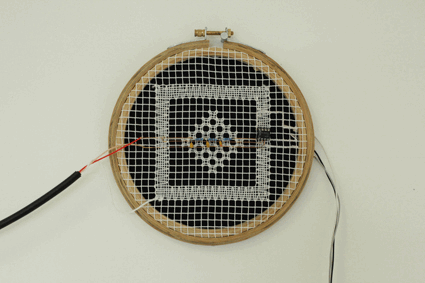
Emily Morandini, filet électronique
photo Kusum Normoyle
Emily Morandini, filet électronique
ON THE LEAFY FRINGE OF CAMPERDOWN PARK, I.C.A.N.’S (INSTITUTE OF CONTEMPORARY ART NEWTOWN) NEWEST SHOW ADDS A LAYER OF ANACHRONISM TO THEIR TRADEMARK INCONGRUITY. FILET ÉLECTRONIQUE/ISLAND IS A GENTEEL COLLECTION OF POST-SUBURBAN ARTEFACTS IN THE VERY URBAN FRINGE. A CONTEMPORARY SALON APOCALYPTICISM, OR SOME FUTURE ARCHAEOLOGICAL RECONSTRUCTION UNSTUCK IN TIME—WHATEVER… THIS SHOPFRONT STANDS OUT FROM THE BROWN AND IMPERTURBABLE LINE-UP OF DECENT LIFE LIKE MAD MAX IN CRINOLINE.
Emily Morandini’s piece is the filet électronique and has the virtue of a completely self-descriptive name. Round filet lace nets are threaded with copper needlework, punctuated at the ends by batteries and speakers, emitting a treble whine. Yep, networks, right angles, minute interconnected fibres—craft had ’em before mass electronics. Check, check and check. You remember the Hyperbolic Crochet Reef (created by Christine and Margaret Wertheim, http://crochetcoralreef.org) where dainty handicraft recalls raw nature? This is the yang to that yin, a stitched homage to circuitry over coral, courtly handicraft for the post-technological parlour.
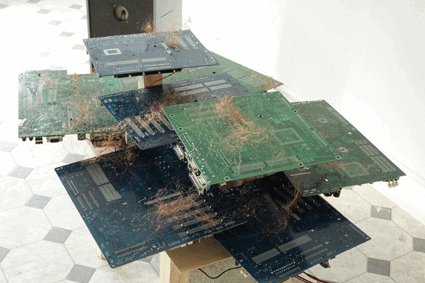
Peter Blamey, Island
photo Kusum Normoyle
Peter Blamey, Island
Two octaves below, Peter Blamey’s Island also hums, and occasionally squeals. This originates in a different future, long after the Anthropocene. It’s not needlepoint, or anything else from CRAFT magazine. Blamey liberates himself from the conventions of traditional handicraft by participating in the plastic, evolving genre of repurposing illegally dumped crap off the street.
A bouquet of found circuit boards opens leaf-wise, with machine-drilled pores and copper-etched capillaries. This is one part robotic Ikebana to two spontaneously generated silicon organisms. The surface is dusted with a faint fuzz of copper floss, moving in the air currents, and it squeals as you brush it, like an electric touch-me-not.
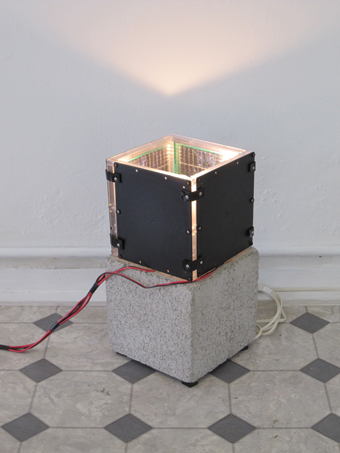
Peter Blamey, Island
photo Kusum Normoyle
Peter Blamey, Island
The piece itself is embedded in the flows of that neo-ecology—mineral waste digesting in the urban metabolism—its body scrap accretions of once-were appliances. This assemblage of motherboards and speakers is powered parodically and circuitously: electricity is derived from a solar panel lampshade which wraps around an incandescent light bulb, a ‘detrivore’ feeding off oil in a travesty of photosynthesis. Conductive cilia wave in the ambient radio fields, recycling electromagnetic waste into mindless warbling.
Where the connectivity in Morandini’s piece is punning, verbal and personal, Blamey’s work is direct, physical and inhuman, the waste fields of a million appliances made audible. The sound from those speakers is the unfiltered interference from the ad hoc antennae of the circuit-boards, performed it seems, for ears other than ours: the secret life of circuits, played out on an Earth after us.
Here are two sardonic takes on the DIY resurgence. Post-consumerist transposed into post-consumer in a world where DIY has been associated as often with fertiliser bombs as with handicraft; where survivalism and tree changing vie for fertile land; where going back to the land may lead you to an open-cut pit, or a strip mall, but you decide to stay there and till it yet.
Emily Morandini & Peter Blamey – filet électronique/island, ICAN, Sydney; July 22-Aug 7; http://interlaps-overlaces.tumblr.com/; http://icanart.wordpress.com/2011/07/19/july-2011-electronique-filet-island/
RealTime issue #104 Aug-Sept 2011 pg. web
© Dan MacKinlay; for permission to reproduce apply to realtime@realtimearts.net
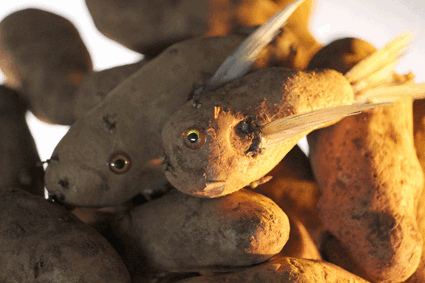
Samantha Scott, Man Made Hybrid
courtesy the artist
Samantha Scott, Man Made Hybrid
we are what we eat
In Samantha Scott’s Man Made Hybrid, potatoes have eyes, actual eyes, and, uhhh… fins. Scott’s delicate and sometimes whimsical assemblages offer wry speculations on the possible ramifications of genetically modifying biology, exploring “the natural imperative of genetic information; the instructions that control how living things grow, develop and carry out life processes and survive (press release).” Scott’s exhibition is part of Craft Victoria’s Craft Cubed Festival 2011 themed HYBRID, offering a month long series of activities including exhibitions, professional development workshops, open studios, a market and an online portal. While you might have missed Adele Varcoe’s iFOLD technique in which she shapes human skin (still attached) into temporary garments, there’s still time to appreciate Tessa Blazey and Alexi Freeman’s Interstellar Gown made from 600 metres of gold plated chain. Man Made Hybrid, Samantha Scott, Aug 23-Sept 3, Heronswood, 105 Latrobe Parade, Dromana, Melbourne; http://craftvic.org.au/craft-cubed/satellite-events/exhibitions/man-made-hybrid; Craft Cubed Festival 2011, various venues across Melbourne, Aug 4-Sept 3; http://craftvic.org.au/craft-cubed
action fashion
public fitting, Mark Titmarsh, Todd Robinson. See Vimeo for full credits
Keeping up the fashion theme is Public Fitting at MOP Projects in Sydney, a collaboration between painter and video artist Mark Titmarsh and former fashion designer now artist Todd Robinson. In a live performance on the opening night, fashion and painting will literally collide in an action painting fashion catwalk free-for-all. The results will be exhibited as garments, videos and paintings exploring the intersection of the artists’ practices. Public Fitting, Mark Titmarsh, Todd Robinson, MOP Projects, Aug 18-Sept Chippendale, Sydney; www.mop.org.au/
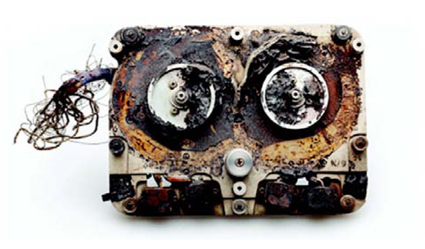
Phoography, Max Lyandvert, George Poonkhin Khut & NIDA Production Students
courtesy the artist
Phoography, Max Lyandvert, George Poonkhin Khut & NIDA Production Students
brainwaves, soundwaves
Max Lyandvert, well known for his dark and haunting soundscapes for theatre, is currently artist-in-residence at NIDA courtesy of the Seaborn, Broughton & Walford Foundation. Collaborating with second year Properties, Costume and Production students Lyandvert has dreamt up the sound installation Phonography, which will inhabit the evocative environment of the Paddington Reservoirs with a “forest of hanging, waterlogged garments fed by currents that turn the clothes into speakers (press release).” The sounds of adjoining Oxford Street will also be fed into the caverns to “make it seem as though the audience is hearing the street sounds above from underwater.” The installation will also feature the work of George Poonkhin Khut further developing his investigations into biofeedback audio installations as he captures people’s brainwaves to create a score for musicians to play. (Read about Khut’s Cardiomorphologies here and here) Phonography, August 24-25, 5-7pm, Paddington Reservoir Gardens, Paddington, Sydney
a room of one’s own
In response to the thriving independent theatre scene in Sydney, The New Theatre has instigated The Spare Room initiative presenting the work of four new-ish local companies. The season kicked off earlier in the year with Dirtyland, a new Australian play by Elise Hearst, and the Australian premiere of UK writer Philip Ridley’s Piranha Heights. The final two shows are coming up starting with Katie Pollock’s A Quiet Night in Rangoon, presented by subtlenuance, telling the story of an Australian journalist in Burma in 2007 during the Saffron Revolution. The final work is Lucky, a physical theatre piece poetically exploring the issue of human trafficking, by Dutch writer Ferenc Alexander Zavaros and presented by IPAN International Performing Arts Network. The New Theatre is currently calling for submissions for its 2012 The Spare Room program with a deadline of September 30. The Spare Room: A Quiet Night in Rangoon, subtlenuance, Aug 18-Sept 10; Lucky, IPAN International Performing Arts Network, Oct 6-22; The New Theatre, Newtown, Sydney; www.newtheatre.org.au
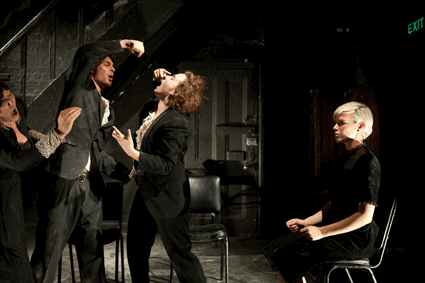
The Hamlet Apocalypse, The Danger Ensemble (Melbourne production)
photo Morgan Roberts
The Hamlet Apocalypse, The Danger Ensemble (Melbourne production)
the end of the world as we know it
La Boite has also been showcasing the Brisbane independent theatre scene through its Indie Series. The final installment is by The Danger Ensemble presenting The Hamlet Apocalypse (to be reviewed in RT105): a group of six actors performing Shakespeare’s Hamlet on the eve of the end of the world. The Danger Ensemble is made up of artists from diverse performance backgrounds including Butoh, physical theatre and experimental cabaret. Director Steven Mitchell Wright writes: “We have gone down the path that leaves the work the most open, where time is broken and glimpses of truth and experience can be accessed by the audience in a non-literal and anti-theatrical way (director’s notes).” While Mitchell believes the work “will polarise audiences,” the production was very well received at the Melbourne Fringe Festival in 2010. La Boite Indie, The Hamlet Apocalypse, The Danger Ensemble, Aug 26-Sept 11, La Boite Theatre, Brisbane; www.laboite.com.au; www.dangerensemble.com
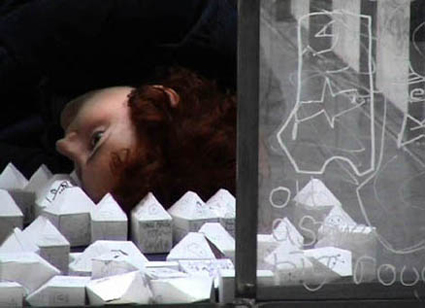
Quiet Time workshop with Reckless Sleepers
courtesy the company
Quiet Time workshop with Reckless Sleepers
a bit of shush
CIA Studios in Perth is calling for participants for Quiet Time, a workshop with Mole Wetherell from the UK/Belgium group Reckless Sleepers. Quiet Time will bring together 10 artists from a range of artform areas to explore the “the city as a basis for research and stimulus(media release).” Reckless Sleepers formed in 1988 and often work with a research and residency model to create cross-disciplinary, site-specific works that are “installed rather than presented (company website).” The workshop will take place in December, with applications closing August 29. Participant stipends and interstate travel allowances are available to assist artists to attend the Lab. For more information or to be sent an application form email kate@pvicollective.com; www.ciastudios.com.au/
RealTime issue #104 Aug-Sept 2011 pg. web
© RealTime ; for permission to reproduce apply to realtime@realtimearts.net
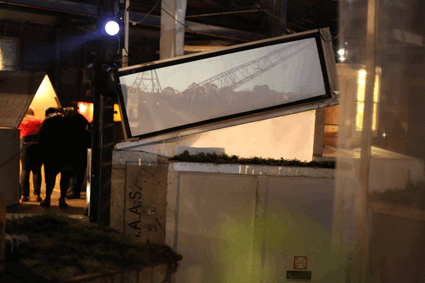
Case Study
photos Justin Harvey
Case Study
WHEN UNDERBELLY FESTIVAL DIRECTOR IMOGEN SEMMLER CASUALLY QUIPPED IN RT103, “PEOPLE LIKE GOING OUT TO COCKATOO ISLAND,” I’M NOT SURE SHE REALISED JUST HOW MUCH: AUDIENCES FOR THE FINAL FESTIVAL DAY—THE CULMINATION OF A 16-DAY DEVELOPMENT LAB—FAR EXCEEDED EXPECTATIONS, REACHING 2,200 PEOPLE.
Extra ferries had to be scheduled as the normal service became taxed, people were turned away at the entrance at times as the festival reached capacity and queues grew to Depression era proportions. Throngs of people across a broad demographic seem to be interested in the alternative arts, as long as they’re in a fascinating location.
Of course the downside was that many of the performance works were designed for a limited audience (some one or four at a time) and even the centerpiece, OJO by Strings Attached with a capacity of 500, was fully booked by the time I arrived at 4pm, so I have to admit, I failed the Underbelly challenge. However I tracked down some esteemed colleagues, Teik-Kim Pok and Sarah Miller, who had much better time management skills, to comment on some of these works. For my part, I spent my time queuing (to no avail) and taking in the installation works that inhabited the nooks and crannies of Cockatoo Island.
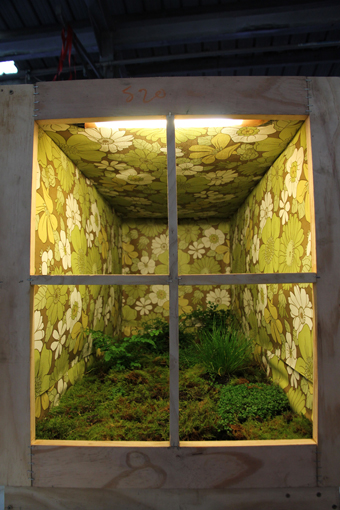
Case Study
photo Justin Harvey
Case Study
case study, [xuan] spring, pattern machine
The most impressive installation, and perhaps the most intensive process in Underbelly was Case Study in which six artists—Perran Costi, Jesse Cox, Emily McDaniel, Adam Parsons, Damian Martin and Justin Harvey—moved to the island for the 16-day lab, taking with them only a suitcase. If there were any Survivor-style power plays during the development the final installation was a picture of harmonious communal living. A series of makeshift huts and lean-tos were scattered around an old workshop, each with bedding, curtains, found objects and text curios. Some hummed with quiet sound installations and most glowed hauntingly with projected stills and videos. Plant and moss specimens from around the island adorned surfaces like miniature gardens and small assemblages were to be found in nearly every crevice. Exploring issues of inhabitation, colonisation and migration, Case Study offered a wabi-sabi micro-environment of wonderful intricacy.
![[Xuan] Spring, Ngoc Nguyen](https://www.realtime.org.au/wp-content/uploads/art/48/4854_priest_spring.gif)
[Xuan] Spring, Ngoc Nguyen
courtesy the artist
[Xuan] Spring, Ngoc Nguyen
Ngoc Nguyen also worked with ideas of domesticity in her installation, [Xuan] Spring. During the Lab she photographed the interiors of several of the abandoned houses on the island adorned with objects and elements associated with the Vietnamese Spring Festival. For the final installation the photographs were displayed in a small office/workshop, accompanied by rows of spring plants and flowers. The beautiful simplicity and intimacy of the work was reinforced by the presence of family members serving sweets and tea to visitors. Nguyen’s Spring was impressive for its subtle, yet no less integrated, use of the site
Pattern Machine was an intriguing audiovisual environment and performance by James Nichols, Dan MacKinlay, Jean Poole and Sarah Harvie. A giant inflatable wormlike object occupied one end of a vast workshop while video projections adorned the far end, glancing across a magnificent piece of old machinery. As was the case with most things in Underbelly, I didn’t catch the whole performance (I had to run to catch the ferry home), but the 20 minutes I experienced offered a rich soundscape of field recordings—flocking seagulls, machine rumbles—underpinned by sweet synthesiser tones delivered quadrophonically, with some great use of video masking to create projections that worked specifically with the architectural features.
Gail Priest
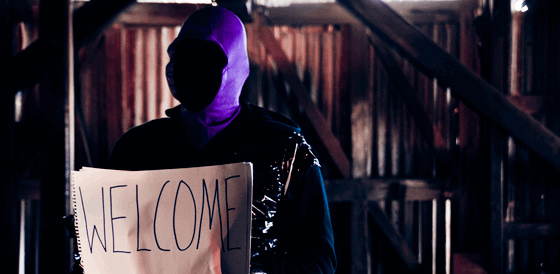
Fetish Frequency, Inflection
photos Dylan Tonkin
Fetish Frequency, Inflection
inflection, all you can stand buffet, awful literature is still literature I guess
The island’s colourful past evokes treasure hunt sensibilities and attempting to live up to this promise of adventure, some of the artists responded with works exploring audience interaction. Inflection, an “interactive theatre game,” asks us to imagine an alternate version of Cockatoo Island. Stumbling into the middle of the story, I meet a troupe of ‘facilitators’ in a low-ceilinged room in the Naval Store, black stockings masking their faces. In the centre is a mannequin torso sitting upright amongst black garbage material surrounded by photos of various sites on the island laid out in an ominous looking ring. Above this is a clue played on video loop, prompting us to carry out one of five major rituals. A few audience members hesitantly step forward to fulfill one of these tasks: “build a lover from these objects.” Unfortunately, given the nature of the event, I have to move on and fail to witness the conclusion of this action, but Fetish Frequency’s haunting mix of audience-driven storytelling and installation building/intervening is something I hope to experience in their next outing.
Next door our Underbelly experience was becoming more rumble-belly as we anticipated a feast of sorts in Butterfries’ All You Can Stand Buffet. Billed as ‘’the disfigured love child of Dante’s Inferno and Sizzler,” we are ushered in by a performer who lays out the ground rules (replete with end-of-days metaphors) for moving through the rooms—each a different buffet ‘course’—the changes signaled by the loud clanging of a steel salad bowl.
Beginning our first course we are surrounded by mounds of strewn rubbish and encouraged to sift through black garbage bags for barely edible items, among them heads of iceberg lettuce left in various states of defoliation by previous audiences. Accompanying this is a diatribe on Third World famine and an exhortation to overcome our privileged First World disgust. This prompted some in my audience, already familiar with the practice of dumpster-diving and the earnest activist tenor of the work, to respond in one-upmanship from then on, to which the Butterfries team struggled to respond. Subsequent courses included being force-fed bread rolls, served minestrone soup out of a cling-wrap lined toilet, a makeshift abattoir with a row of raw chickens impaled on a wall overlooking a blood-soaked floor and a dinner party where two performers’ strained exchange invited my restless audience group to weigh in, escalating the action into a food fight. While Butterfries’ audience-wrangling strategies need bolstering, their efforts to visually reference the aesthetic of disgust is a worthwhile achievement for their first collaborative effort.
I choose to decompress from the gastronomic challenge by visiting the Festival Bar for some mulled wine while taking in one of the more relaxed offerings, Applespiel’s Awful Literature is Still Literature I Guess. At this point, surrounded by towers of books, they regale us with a series of abject confessionals which segue into an ironic promotion of books considered obscure and questionable in literary merit completing the bar’s role as a sensory pit-stop for the traumatised, exhilarated and perplexed among us island-hopping conceptual treasure hunters.
Teik-Kim Pok
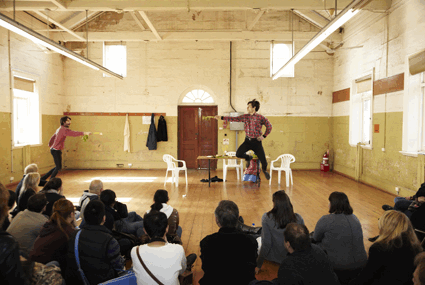
Whale Chorus, Rhapsody, Paul Blenheim, James Brown, Janie Gibson
photos Josh Morris
Whale Chorus, Rhapsody, Paul Blenheim, James Brown, Janie Gibson
rhapsody, ojo, v
Whale Chorus took the idea of the musical and broke it right across their collective hootenanny kneecaps in Rhapsody. Even at this early stage of development, this short work-in-progress was performed with panache by Matt Prest, Janie Gibson and Paul Blenheim. It was silly, smart, kitsch and funny.
Referencing everything yet nothing I could quite put my finger on, Rhapsody evoked moments of Oklahoma but also Deliverance, Seven Brides for Seven Brothers and Psycho, not to mention various high school musicals, segueing from popular culture to irreligious cult. The costuming for Paul Blenheim and Matt Prest—red checked shirts and tight black pants—was inspired while Janie Gibson’s deadpan Doris Day provided a great counterpoint to boyish petulance, blokey bravado and dang-crazy angst.
Whale Chorus “aims to borrow techniques used for creating music to create theatre” and the effect of translating musical concepts such as polyphony and dissonance into theatrical manoeuvres leads them into some hilariously unlikely places. Matt Prest’s delivery of the Beatles’ “Taxman,” and Janie Gibson’s attempts to get two reluctant lads to sing the Judy Garland standard “Good Morning” reminded me of classic comedy—think Marx Brothers or Laurel and Hardy without the pratfalls. Kazoo, celery, song, story and hypnotism were brought together in an absurd narrative to create something utterly idiosyncratic and funny.
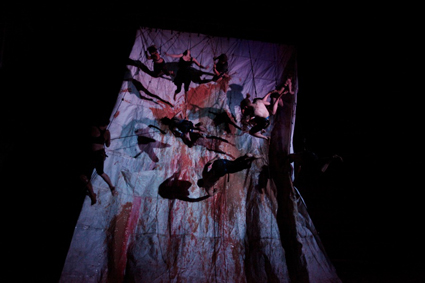
OJO, Strings Attached & Younes Bachir, Underbelly
photo Catherine McElhone
OJO, Strings Attached & Younes Bachir, Underbelly
At the other end of the emotional spectrum was OJO created by Strings Attached and Younes Bachir, previously a collaborator with La Fura dels Baus. Brought to Australia by Deborah Leiser-Moore, Artistic Director of Tashmadada (Melbourne), Bachir worked with a large group of highly skilled physical theatre performers as well as emerging practitioners.
Performed at one end of the cavernous Turbine Hall, the work begins before the audience enters the space, with a single performer hoisted high in the air, flailing and spitting words at the gods. On the other side of a large curtain, the audience stumbles across bodies sprawled or curled foetus-like on muddy, wet concrete floors amidst the wreckage and detritus of modern industrial society. The imagery is apocalyptic, the performers intense, edgy and focused. I’m reminded of Nietzche’s dark “primordial unity” that seeks to awaken our Dionysian nature through an evocation of the primal, ritual, extreme physicality and chaos as a means of bringing us to harmony.
Anyone old enough to experience the 1989 production of La Fura dels Baus’ Suz/o/Suz at the Hordern Pavilion will remember the massive spectacle and ritualistic nature of the work: blinding lights, cacophonous noise, water and mud, sex, birth, festival, sacrifice and death, combined with a fantastic physicality and extraordinary aerial work. Audience members ran for their lives as huge machines and implacable performers bore down on them.
OJO worked with similar materials and themes, albeit stripped back, and without elaborate or expensive sets, but the experience was no less intense. One of the most thrilling moments occurred when the performers manually dragged the huge machinery high in the ceiling of the Turbine Hall from one end of the performance area to the other. The horrifying yet compelling momentum of the industrial machine—Blake’s “dark satanic mills”—and its devastating impact on the natural world was powerfully evoked.
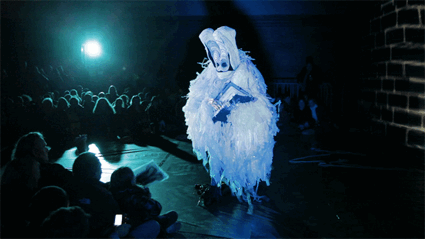
Justin Shoulder, V
video stills Sam James
Justin Shoulder, V
From darkness into light, the strangely weird and fantastical creature that is V emerges from an old, sandstone house in the convict courtyard, one of the oldest sites on the island. White gridlines shimmer and pulsate like visible electricity as this urban demon appears swaying from side to side, carrying a large book with the word V on its cover. An apparition, alien or the ancient ancestor-spirit of Cockatoo island—I have no idea—but that doesn’t stand in the way of my enjoyment of this work. An audiovisual spectacle, this is a huge collaborative effort devised and performed by Justin Shoulder, directed and produced by Jeff Stein in collaboration with composer Nick Wales, a founding member of Coda, video and lighting designer Toby Knyvett working with Sydney Bouhaniche, Cheryle Moore of Frumpus fame and that wizard of theatre spectacle, design and contraption-making, Joey Ruigrok. It was a great end to my Underbelly day.
Sarah Miller
lab work
With the culmination of activities in one big bonanza there is a danger of losing perspective on the developmental status of many of the works in Underbelly, some of which began a mere 16 days before. However audiences could visit the island in the weeks prior to watch the artists right in the midst of the thorny business of artmaking. I regret that I didn’t take up this opportunity, as I may have been able to make a one-on-one appointment with J Dark in Joan of Arc is Alive and Well and Living on Cockatoo Island by Triage Live Art Collective or have the drive-in experience of Julie Vulcan, Ashley Scott and Friends with Deficits’ Spotlight Bunny.
After a smaller-scale festival in the streets of Chippendale last year, the 2011 Underbelly, thanks to its site and more rigorous programming, reached a whole new scale and level of engagement with audiences and artists. If the event continues on Cockatoo Island, it feels as though it would be best to expand to a two-day final event in order to satisfy its eager audience. GP
Underbelly Arts 2011; Case Study, Perran Costi, artists Jesse Cox, Emily McDaniel, Adam Parsons, Damian Martin, Justin Harvey; (Xuan) Spring, artist Ngoc Nguyen; Pattern Machine, artists James Nichols, Dan MacKinlay, Jean Poole, Sarah Harvie; Fetish Frequency, Inflection, artists Jimmy Dalton, Lucy Parakhina, James Peter Brown, Skye Kunstelj, Aimee Horne and Amelia Evans; Butterfries, All You Can Stand Buffet, artists Damien Dunstan, Jennifer Medway, Kirby Medway, Tessa Musskett; Applespiel, Awful Literature is Still Literature I Guess, artists Simon Binns, Nathan Harrison, Nikki Kennedy, Emma McManus, Joseph Parro, Troy Reid, Rachel Roberts, Mark Rogers; Whale Chorus, Rhapsody, artists Matt Prest, Janie Gibson, Paul Blenheim, James Brown; Strings Attached & Younes Bachir, OJO, Younnes Bachir, artists Alejandro Rolandi, LeeAnne Litton, Dean Cross, Kathryn Puie, Angela Goh, Matt Cornell, Mark Hill, Kate Sherman, Carolyn Eccles, Gideon PG, Robbie Ho, Matt Rochford, Elisa Bryant, Charlie Shelly, Julia Landery, Victoria Waghorn, Cameron Lam, Craig Hull, Leanne Kelly; V, artists Justin Shoulder, Jeff Stein, Toby Knyvett, Sydney Bouhaniche, Nick Wales, Cheryle Moore, Joey Ruigrok; Underbelly artistic director Imogen Semmler, executive director Clare Holland; Cockatoo Island, Sydney; Lab July 3-12, Festival July 16; http://underbellyarts.com.au/
This article first appeared in RT e-dition august 23.
RealTime issue #105 Oct-Nov 2011 pg. 5
© Gail Priest & Teik-Kim Pok & Sarah Miller; for permission to reproduce apply to realtime@realtimearts.net
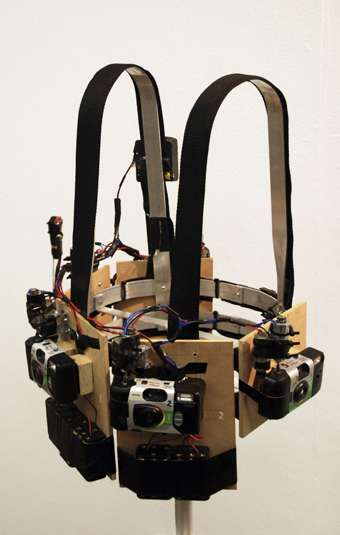
Alakazam, 2010 (detail), Adam Adelpour included in HATCHED National Graduate Show 2011, PICA
courtesy of the artist
Alakazam, 2010 (detail), Adam Adelpour included in HATCHED National Graduate Show 2011, PICA
Will artists tread ever so softly and self-censor under the weight of a growing number of protocols, impending new classification legislation and, not least for the training and education of young artists, the nervous reactions of university ethics committees? This is the Burning Issue in RealTime 104, aptly illustrated on this page by Adam Adelpour’s Alakazam. Adelpour is a student from Sydney College of the Arts [SCA], University of Sydney, one of the young artists selected for this year’s Hatched National Graduate Show at PICA. What at first glance looks like a bomb-cradling terrorist rig turns out to be a bizarre 360-degree surveillance device which the artist boldly activated, ie flashed, in the security-sensitive Sydney Opera House precinct. You can read a detailed account of the device and the action on the artist’s blog: adamadelpour.wordpress.com. The other dimension of our annual arts education feature is a survey of Australian content in university curricula and syllabuses. It’s quite revealing, indicating a passionate desire to bring together students and local artists, to attempt to make national connections and to find Australia’s place in a global art context. The ideal consistently appears to be a desire to bring these three dimensions together, avoiding ghettoisation and imbuing students with a sense of history (not least of recent contemporary art practices) and the greater world to which they as artists will contribute.
RealTime issue #104 Aug-Sept 2011 pg. 2
© RealTime ; for permission to reproduce apply to realtime@realtimearts.net
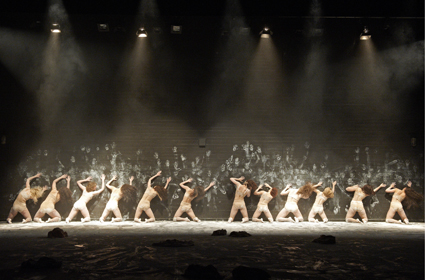
Over and Out, 2010, LINK Dance Company, WAAPA
photo Jon Green
Over and Out, 2010, LINK Dance Company, WAAPA
SCAN THE LANDSCAPE OF AUSTRALIAN TERTIARY DANCE COURSES FOR EVIDENCE OF “AUSTRALIAN CONTENT” AND IMMEDIATELY WHAT IS REVEALED IS THAT ITS INCLUSION IS FAR LESS ABOUT PRIORITISING A PARTICULAR AMOUNT IN ORDER TO SATISFY A PERCENTAGE OF NATIONAL INTEREST, BUT IS FAR MORE ABOUT THE PARTICULAR VALUES THAT DIFFERENT COURSES ASCRIBE TO AUSTRALIAN DANCE AS AN ARTFORM.
An important priority within curricula, Australian dance content is defined by various combinations of acknowledgment and celebration of Australian dance works; cultivating an understanding of a lineage of dance artists who have contributed to the development of what we see as current Australian contemporary dance; of utilising and maximising the expertise of current dance artists and transferring those benefits to the students; and possibly of patriotic or nationalistic pride.
working from the local
Dr Sally Gardner, Lecturer in the School of Communication and Creative Arts at Deakin University, says that upon starting their undergraduate degree many dance students “have little knowledge of contemporary dance art either locally or globally, currently or historically.” Given that this is their starting point she asks “why invoke the nation?” suggesting that “perhaps it would be better to think in terms of the local. Making connections with or referring to local dancers has a pragmatic, potentially vocational value.” At Melbourne University’s Victorian College of the Arts (VCA) a strategy to feature the work of Australian dance artists both in performance and in the curriculum has been pursued over the past 10 years. This integrated approach to dance education and training aims for VCA students to become conversant with the work of Australian choreographers and dance companies in a variety of contexts at and beyond the VCA.
A combined pragmatic and referential approach comes from Michael Whaites, Artistic Director of Western Australian Academy of Performing Arts’ (WAAPA) postgraduate pre-professional program LINK. Providing networking and employment opportunities are highlighted goals and the choice of national dance artists and companies is geared towards assisting the graduates from LINK to gain work within the profession: “Australian dance artists are very important…helping the students connect to the landscape and east coast, and helping to familiarise them intimately with some of the current people working in the industry.”
dance artists as teachers
Australian tertiary dance courses value and employ currently practising Australian artists as teachers for their currency of knowledge, their particular artistic practices and the professional networking information and opportunities that can benefit their students. Deakin University’s dance course includes comprehensive representation of local dance artists throughout the many aspects of students’ studies including as teachers, occasional additional visits by guest dancers, unit readings, reference or mention during technique, composition or other workshops and announcements on unit website pages.
The VCA’s current focus on Australian work is described by Associate Professor Jenny Kinder, VCA Dance Undergraduate Coordinator, as “underpinned by the involvement of practising dance artists in curriculum delivery. Participation by practising artists in three of six subjects on offer represents significant exposure to Australian work and practices.”
resource: god bless youtube
At Macquarie University Dr Pauline Manley, Lecturer in Dance Studies, says that Australian dance content is comprehensively included within the Macquarie dance course, “ranging from watching artists on YouTube to setting research tasks to seek out and attend live performances in unfamiliar venues and settings.” The inclusion of Australian content is considered vital in providing students with information about the content and location of what is currently occurring in the Australian dance environment and she praises the ability to access it via the internet: “God bless YouTube and the artists who release their work for the world to see. Thanks to YouTube we can watch Australian contact improvisation, performance artists, improvisations, contemporary dance …”
While Pauline Manley applauds YouTube, Dr Erin Brannigan, Lecturer in Dance at the University of NSW places the onus of releasing more Australian dance information into the wider public domain on the works’ creators. Although documentation of dance exists she says “it is very difficult to obtain. Choreographers and dance companies need to take responsibility for this.”
resource: dance as written word
It is generally agreed that currently there isn’t a broad enough body of written text and reference material regarding Australian dance, although resources in areas such as dance film are increasing. Performing arts journals, magazines and publications such as Brolga, the Writings on Dance archive, RealTime and the RealTimeDance portal are quoted as valuable sources of written material, although in total they are few. Key resources that relate to Australian dance are available in other formats—some in the form of living, practising senior artists. Jenny Kinder makes the point that “the issue is not access to information but whether Australian researchers will capitalise on existing primary sources and documents (such as the National Library’s Oral Histories) to produce the kind of dance texts and documentation that have emerged from the United States, Britain, Europe and more recently Asia.”
networks & shared learning
Another challenge is getting students to access information and material about dance artists and practices that occurred before the digitised age, and not to confuse accessibility of information with ease of access to information or the only available information. However, consideration does need to be given to how the current generation of students consumes information, says Associate Professor Cheryl Stock from Queensland University of Technology’s Creative Industries and former dancer, choreographer and artistic director. By students sharing information via blogs, YouTube and social networks, she observes that teaching and learning processes have changed to incorporate more dynamic peer-to-peer exchanges of information: “It’s about the conversations that are being held in whichever format they’re occurring. This has many advantages in engaging students and providing access to work that cannot be seen live but it does not replace the experiential. Learning about dance and learning through dancing provide an essential praxis of theory and practice.”
embodied learning
Critically, dance students need to understand that some information can only be accessed by direct interaction with practising artists. Cheryl Stock says that “to acquire deep knowledge of dance, students need to be in the studio often to directly engage with their learning for a more complete understanding of the ideas they access—and most importantly, that information becomes EMBODIED; it is a type of knowledge that is experienced and transferred personally and these kinaesthetic understandings cannot be acquired through digital platforms. Students need to engage with our contemporary artists and their ideas on a number of levels and where at all possible learn directly from them through classes, secondments and choreographic opportunities.”
learning lineage
Acknowledgement of the history and legacy of Australian dance is the aspect of Australian dance content unanimously considered of utmost importance and relevance for today’s dance students. The knowledge of national and international dance practices and histories is symbiotic and provides a perspective of how Australian dance and seminal Australian dance artists developed, progressed and impacted on current generations of Australian dance artists within local and global contexts. Cheryl Stock says that “there is a tendency for many students to think that various (contemporary dance) practices are new. They need to have access to the lineage of dance artists that have contributed to what exists now. And we also need dance scholars to write those histories.”
In 2012 the VCA will introduce a new subject Dance Lineages which will focus on the development of contemporary dance in Australia in order to contextualise the international contemporary dance trends and influences studied. Jenny Kinder underscores the value that it will be “acknowledged through the prism of Australian dance artists and their various overseas encounters”. Macquarie Dance also shares this view and has a research project underway to establish an audio-visual database of Australian dancing from the 1960s to the present day.
While the principle of prioritising Australia’s dance heritage is a shared theme, the selection of artists focused on reflects each course’s specific aesthetic values, geographical location and the individual experiences of staff. The artists highlighted by different tertiary dance courses and the reasons for their inclusion and prioritisation, are therefore important indicators of the particular character, artistic approaches and aesthetics of the course and what it can offer.
thinking globally, dancing locally
On the issue of inclusion of Australian dance content in tertiary dance courses there is an overarching agreement that it is a fundamental necessity for dance students to experience information and dance work that is excellent and which reaches beyond national definitions, histories and borders; but to be able do this their perspective must be informed by knowledge that is local in order to understand and appreciate the global.
As Cheryl Stock comments: “We live and work in a global world but we need to foreground past and current Australian dance practices and histories for an appreciation and understanding of how what is happening now came to be and why. That is, we need to contextualise the information historically and with an understanding of how the different genres have developed. Australian contemporary dance—and indeed all contemporary dance—didn’t just happen.”
additional resources
The Australian National Library’s Australia Dancing (www.australiadancing.org); Alan Brissenden and Keith Glennon’s Australia Dances, Creating Australian Dance 1945-1965, Wakefield Press, Adelaide, 2010 (RT 100); and Erin Brannigan’s Platform Paper for Currency House, Moving Across Disciplines: Dance in the 21st Century, 2010. Ausdance National and Routledge’s book on Australian dance with interviews and articles by and with Australian dance artists, academics and critics is due for publication in 2011. The Australian company Contemporary Arts Media’s Artfilms provides DVDs (at individual, educational and other institutional rates) of Bangarra Dance Theatre, Lucy Guerin Co. and Chunky Move (www.artfilms.com.au). Erin Brannigan and RealTime are editing a collection of essays and interviews on specific works by 12 Australian choreographers for publication in 2012 (the choreographers are profiled with articles and video clips in RealTimeDance: www.realtimearts.net/realtimedance). Eds.
RealTime issue #104 Aug-Sept 2011 pg. 3
© Linda Sastradipradja; for permission to reproduce apply to realtime@realtimearts.net
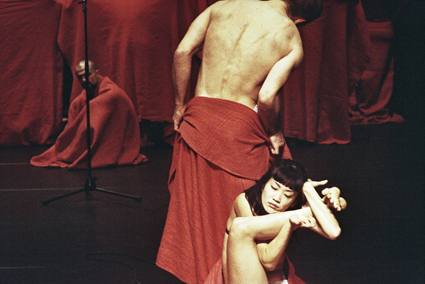
For Pina, les ballets C de la B
photo Chris Van der Burght
For Pina, les ballets C de la B
FORMER SYDNEY OPERA HOUSE HEAD OF THEATRE AND DANCE, AND SPRING DANCE CURATOR, WENDY MARTIN IS NOW HEAD OF PERFORMANCE AND DANCE AT LONDON’S SOUTHBANK CENTRE WHERE SHE SAYS SHE’S ADJUSTING AFTER SEVERAL MONTHS TO A NEW WAY OF LIFE, INCLUDING ENCOUNTERING MORE DANCE THAN SHE’S EVER SEEN. SHE’S PARTICULARLY PROUD OF THIS HER THIRD SPRING DANCE FOR THE SYDNEY OPERA HOUSE, A PROGRAM OF DISTINCTIVE INTERNATIONAL WORKS AND, FROM AUSTRALIA, ROS WARBY’S MONUMENTAL AND CHUNKY MOVE’S I LIKE THIS.
dv8: can we talk about this?
Martin describes Lloyd Newson’s new work, Can we talk about this?—with its international premiere in Spring Dance—as fusing dance and verbatim theatre to deal with the issues that arise from the 1989 fatwah placed on Salman Rushdie, the threats to the life of a Danish cartoonist for his representation of Muhammad, and the murder of Theo Van Gogh for his criticisms of Islamic culture. It seems that the work will focus particularly on the oppression of women and children in a work rich in interview-based dialogue and inventive choreography. Martin reveals that the cost of presenting Can we talk about this? “was almost beyond us, but the Opera House made the commitment.” She was intrigued that the work was co-produced (with European partners) by The National Theatre of Great Britain “rather than with London’s Sadlers Wells.” This is further evidence that there are works and audiences that crossover and hybridise, as in the programming in Australia of works by Lucy Guerin in Malthouse and Belvoir subscription seasons. Given its subject matter and, apparently, the manner in which it’s played direct to its audience, Can we talk about this? is bound to be as provocative as it is inventive.
les ballets c de la b: out of context, for pina
Coming close on the heels of the sell-out screening of Wim Wenders’ 3D film tribute to the late Pina Bausch at the Sydney Opera House, comes Alain Platel’s tribute. Like DV8’s Lloyd Newson, says Martin, Platel believes that without Bausch his own work would not exist. Platel was taken by the way that Bausch’s creations would “step out of the everyday” and give so much creative responsibility to her dancers (among whom have been a number of Australians). Platel’s tribute pays homage to Bausch’s unique approach but, says Martin, uses the popular music and dance moves of our own time, as well as Bach, to make the connection with his own work for les ballets C de la B. Jana Perkovic wrote, on seeing For Pina at Sadler’s Wells in 2010: “The piece defies description by virtue of sheer over-accumulation: 90 minutes of startlingly original movement with virtually no repetition, on nine different physiques that, even when amassed into synchronicity, preserve individual differences…Not having any narrative frame allows the audience to experience this decontextualised mass of movement on the level of affect, not cognition, free-associating stage images to deep memories. The result is emotionally penetrating and deliriously enjoyable.” (RT98)
pina: a celebration
Further acknowledgment of the Bausch legacy comes on screen over two days in the form of Anne Linsel’s Pina Bausch, a film, and Linsel and Rainer Hoffman’s documentary about the creation of one of the greatest of the choreographer’s works, Kontakthof. (The program will also include Life in Movement, the documentary about the late Tanja Liedtke.) Speakers in the accompanying discussions about Bausch will include Meryl Tankard, Michael Whaites, Kate Champion, Shaun Parker and Lutz Forester who all performed with Bausch’s company.
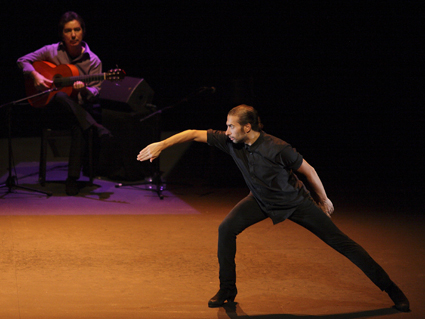
Israel Galván
photo Felix Vazquez
Israel Galván
israel galván: la edad de oro
When at the Lyon Biennale de Danse in 2007, I saw a gypsy flamenco ensemble perform, unadorned by frills and garish lighting, it was one of those revelatory experiences that put you in touch again with a form that had come to mean little. Martin has seen three works over the years by Israel Galván, a “flamenco revisionist” who brings together traditional form with contemporary dance. In Rome she witnessed him “dance barefoot, kicking up whirls of white dust while accompanied by a pianist.” She was also intrigued by the way “he blurred the masculine and feminine in his form” and accentuated the shape of his dance by largely performing in profile so that every movement detail could be relished. RealTime contributor Erin Brannigan told me she thought Galván’s performance in this year’s Montepellier Danse the best in the program.
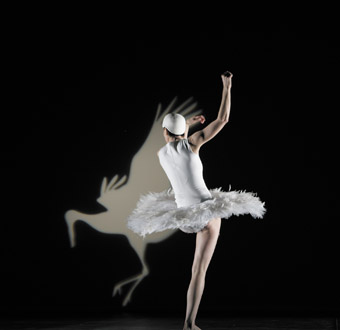
Ros Warby, Monumental
photo Jeff Busby
Ros Warby, Monumental
ros warby: monumental
Although previously enjoyed by Sydney dance audiences courtesy of Performance Space at CarriageWorks in 2009, Martin hopes that Warby’s Spring Dance presentation of Monumental will bring her the much larger audience this truly idiosyncratic Australian dancer deserves. There’s much about Warby to be found in RealTimeDance, including my review of Monumental (RT90). I wrote (and it’s not an easy work to put into words, believe me): “The anti-gravitational appeal of dance is, of course, like our dream of flight and winged selves, but here the embodied connection goes deeper. The audience become birdwatchers who, by way of Warby-Medlin [film]-Mountford [cello] alchemy, suddenly sense not only the dancer’s ‘birdness,’ but also their own, and, as they cast their minds back to Monumental’s opening image, the birdness (and not just of swans) of ballet.” Monumental is visually magical, sometimes funny and has some very interesting things to say about dance…and nature.”
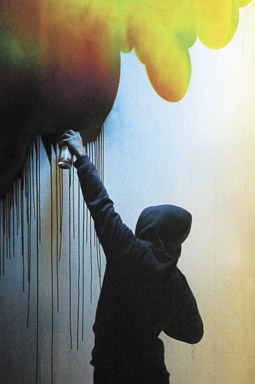
Blazeblue Oneline
photo Byron Perry
Blazeblue Oneline
chunky move: antony hamilton & byron perry’s i like this
Dancers Antony Hamilton and Byron Perry have contributed significantly to the works of Melbourne choreographers, so it’s wonderful to see them step out as a duo with their own creation about the magic of ‘thingness’ as they manipulate themselves and objects about the stage. RealTime reviewer Carl Nilsson-Polias had been impressed with Hamilton’s Blazeblue Online (RT85); he noted “a subtle recurrence of two-dimensional objects, such as cardboard, being given three-dimensional life and movement by the dancers. It is as though the flatness of visual art’s canvas is itself being reconstructed and reconfigured into the dynamic physical nature of dance.” John Bailey wrote of I Like This: “[Perry and Hamilton’s] visual design for the work deserves particular mention, becoming a character almost in itself, with hundreds of perfectly executed changes whose sometimes stroboscopic effect makes lighting operation appear a form of choreography in its own right. It’s self-reflexive dance, certainly, but by incorporating technology in such a sophisticated way it becomes something much more…the result approaches the sublime” (RT89). You can read Sophie Travers’ interview with Antony Hamilton in RT93. For Wendy Martin, I Like This is indicative of the work of a new generation of Australian choreographers, in this case designing, making and controlling an environment before us.
fevered sleep: the forest
UK group Fevered Sleep’s The Forest became part of the Spring Dance program, says Martin, on the recommendation of Brisbane Festival artistic director Noel Jordan. Aimed at young people and families in particular, but not at all exclusively, this maze-like, glass and mirror installation brings together dance, sound and light to create what Martin describes as “interactive dance theatre.”
placing spring dance
The contrast between Melbourne’s Dance Massive and Sydney’s Spring Dance is palpable given the largely national content of the former and the international purview of the latter. Martin is impressed by Dance Massive and sees the two dance events as equally important. Part of her inspiration for Spring Dance came from witnessing large-scale dance events in Germany in 2007-08 “with so much audience and performance engagement, so much conversation—a story going beyond one show—and asking huge audiences to take risks.” A single show at the Opera House might draw 1,500-2,500 ticket sales, she says—unless it’s Akram Kahn pulling 6,000 or so sales. But the 2010 Spring Dance attracted 20,000 people including 13,500 ticket buyers. Martin believes that Spring Dance is a sustainable model for audience development. It’s certainly what Australian dance needs. Of course, should Spring Dance continue now that Wendy Martin has left the Opera House, the event could be what Sydney dance artists also consistently need, greater exposure to local audiences in an international context as enjoyed by the Spring Dance production of Meryl Tankard’s The Oracle in 2009 and Narelle Benjamin’s In Glass in 2010.
–
Spring Dance, curator Wendy Martin, Sydney Opera House, Aug 23-Sept 4
RealTime issue #104 Aug-Sept 2011 pg. 4
© Keith Gallasch; for permission to reproduce apply to realtime@realtimearts.net
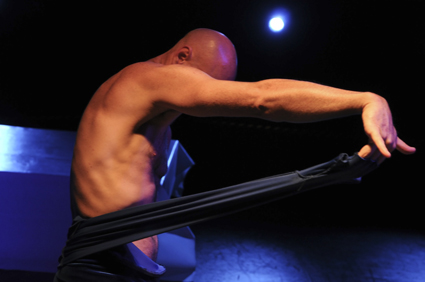
Dean Walsh, Fathom
photo Heidrun Löhr
Dean Walsh, Fathom
LAST YEAR, INDEPENDENT CHOREOGRAPHER DEAN WALSH WAS AWARDED AN AUSTRALIA COUNCIL FELLOWSHIP. THE TIMING COULDN’T HAVE BEEN BETTER. THE AWARD PRACTICALLY COINCIDED WITH WALSH’S 20-YEAR ANNIVERSARY AS A PERFORMANCE MAKER. ACHIEVING PROFESSIONAL LONGEVITY IS NO SMALL FEAT FOR AN INDEPENDENT ARTIST. TO BE OFFICIALLY RECOGNISED FOR IT IS ALL THE SWEETER. AND AS THE FELLOWSHIP ALLOWS WALSH TO FURTHER RESEARCH AND DEVELOP HIS CHOREOGRAPHIC PRACTICE, IT ALSO PROVIDES A TIMELY OPPORTUNITY TO TAKE STOCK.
So, how did it all start? Walsh recalls: “I presented my first piece at Performance Space’s Open Season. That was in June 1991. It was a group piece with eleven dancers. I was performing as well.” Walsh is under no illusions about the quality of the work: “Transcendent Nights, it was called. It was very ‘dancey’. I was just out of dance school. Naïve, you know.” The work didn’t go unnoticed however. Walsh laughs: “Sarah Miller [then director of Performance Space] pulled me aside afterwards and said: Come back with a solo next year. I think you’ve got more to say.” And sure enough, Walsh followed her advice. He became, in fact, something of a regular at Performance Space’s short works nights over the next few years – first at Open Season, then, from 1995, at queer cabaret programs such as cLUB bENT and Taboo Parlour. It was here he excelled with highly physical dance performances, exemplifying the spirit of nineties queer politics. The works were often inspired by Walsh’s personal experiences of homophobia and domestic violence—artistic manifestations of standing up for himself.
Around that time, in addition to his pursuits as a solo artist, Walsh also became a sought after performer in works by leading directors and choreographers such as Nikki Heywood, Nigel Kellaway and Garry Stewart. In 2002 he was awarded a Robert Helpmann Scholarship and left Australia to work with Paul Selwyn Norton and Company in Amsterdam and DV8 Physical Theatre in London. Upon his return three years later, Walsh’s choreographic interest had shifted away from the solo format towards choreographing group works. His first ensemble piece, Back From Front, premiered at Performance Space in 2008. Since then Walsh’s work has undergone a continuous evolution both in content and form.
This brings us to Walsh’s Fellowship and the program of activities he has proposed to undertake in the next two years. Walsh: “One of the leading questions for me is: What is the body of the history of my practice and how can I distil it into a system that I feel has integrity in terms of where I want to take my practice now, which is into a whole new content base, I guess, reflecting on the notion of environment, habitat destruction, genetic memory, our social connection and disconnection to the idea of climate change and major social human change.”
The first major thematic shift in Walsh’s work occurred when transitioning from creating solos to making group pieces. Looking at the long-term impact of wartime experience on soldiers and their families, “Back From Front was kind of like the bigger version of everything my solos were,” says Walsh. It was me going away from my own family to listen to other families and other histories but it was still the older way of working. And it was still an earlier concern in terms of domestic violence and where it comes from.”
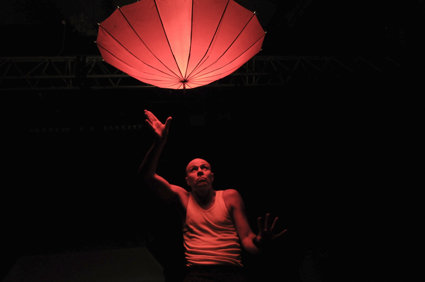
Dean Walsh, Fathom
photo Heidrun Löhr
Dean Walsh, Fathom
Now with environmental change and extinction issues increasingly the target of his thematic exploration, Walsh’s focus is currently on research into marine habitats and their bio-diversity. He cites taking up scuba diving in 2008 as the event that kick-started his new found interest. It exposed him, he says, to a previously unknown world and ignited a passion that soon resulted in genuine concern for the future of marine habitats and the survival of marine species, to a point where he seriously considered giving up dance: “I could almost give up art to move into conservation,” he says. And then, after a pause: “But I don’t want to. I’m really interested in how to take my dance practice into this new fascination I have with the need to conserve our marine bio-diversity.”
In addition to the exploration of new thematic and conceptual content, a large section of Walsh’s fellowship is dedicated to the choreographic scoring system he has been developing over the last years. It is called Foreign Language, complete with a “grammar” of its own and rules that distinguish it from any other physio-linguistic systems. Walsh explains: “The system is made up of five primary scores that divide into various sub-scores which then further break down into a series of modulations.” Could we have an example? “One of the primary scores is animality,” he says. “The sub-scores are various vertebrate and invertebrate animals. The cephalopods [octopuses, squids], for example, are among them.” What about the modulations? “The modulations relate to the specific physical and textural qualities of a certain species. In the case of the cephalopods, it’s their alacrity. Apart from a soft cartilage skull and a beak, they practically consist entirely of muscle.”
And how is the system used to choreographic purposes, how does it operate in action? “The various scores, sub-scores and modulations can be fused with each other, creating near-infinite possibilities.” Further complexity is added by the fact that some of the animality scores are anatomically impossible to execute for humans. “Some interesting movement gets produced that way,” says Walsh. An example would be one of the cephalopod modules, which is inspired by the Pacific Red Octopus’ ability to fit through spaces a tenth of their size by executing two complex physiological manoeuvres simultaneously—reducing muscular density while extending forward.
Walsh’s Fellowship is primarily dedicated to choreographic and conceptual research, both experiential and practical as well as theoretical. Apart from engaging in studio-based activities, he also regularly attends seminars, lectures and conferences and consults with marine biologists and conservationists. In order to try out some of his ideas in front of an audience, Walsh further conducts work-in-progress showings and recently presented the first instalment, in a series of what he calls ‘touch-down performances’. Entitled Fathom, the event took place in Track 8 at CarriageWorks. Walsh found the experience invaluable: “It gave me the opportunity to interface with an audience and get their feedback. That definitely upped the ante and got me away from the loneliness in the studio. It also helped me to become clearer. I had to put it out there to understand what it is I’m doing. I’m a physical realiser.”
So far Dean Walsh has completed a quarter of the program he is scheduled to undertake as part of his Fellowship. His passion for the project is palpable and his eloquence in describing its various components impressive. And yet, there is a sense that the ambition and sheer scale of his undertaking has just started to dawn on him. Walsh readily admits that at times he finds it rather overwhelming. Tongue in cheek, he states: “I feel like I have a whole ecology of ideas that will last me 10 or more years. I just can’t scope it all yet and I do feel like, I’m not drowning by any means, it’s absolutely not that. In fact, I’m breathing under water but the water is just so immense, I can’t scope it all.”
RealTime issue #104 Aug-Sept 2011 pg. 6
© Martin del Amo; for permission to reproduce apply to realtime@realtimearts.net
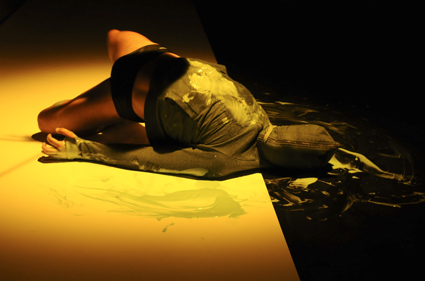
Dean Walsh, Fathom
photo Heidrun Löhr
Dean Walsh, Fathom
DEAN WALSH HOLDS THE AUSTRALIA COUNCIL DANCE FELLOWSHIP FOR 2011-2012, HIS ARTISTIC TENACITY REWARDED WITH INSTITUTIONAL SUPPORT. IN WALSH’S OWN WORDS, FATHOM IS AN EXPERIMENT AND A SMORGASBORD OF IDEAS: A REFLECTIVE MOMENT IN A TWO-YEAR PROCESS.
Walsh is an artist with important things to say. Dance can have a timid political voice but in Fathom Walsh seeks to connect movement theatre with the wider world and a political hot potato: the health of our natural environment. The relationship is not always comfortable or even clear, but the motivations are intense and passionate.
The black box stage is strung with striped tape, cordoned off like a scene of violence. Hanging hooks hold bags of green liquid horror. Implicit in this pre-set image is the thematic destruction that feeds Fathom: “not only was the bush gone, but the entire creek and swimming hole had been filled in. In its place is street after street and house after identical house: suburbia. No gum trees in sight” (program note).
Sitting to one side is a yellow man in a large blue bucket. He has no face. He fishes as a watery soundscore floats. His fishing pole creates a gentle arc against the lines of striped tape. As he stands his upper back leans, curving like the fishing pole. He dips as sound flutters.
This opening scene is intensely aesthetic: shape, colour and line dominate action. While it does become more alive with movement, what remains resilient in Fathom is image. In a series of episodes that fluctuate in tone, intensity and personality, it is be colour, lighting, costume, screen and apparatus that provide the performative punch. In this way Fathom does not cast itself so much as movement theatre or a reflection of the underwater world, but as a series of aesthetic events.
Walsh sits in a spotlight, his hands cast the colour of lobster. He pulls at the featureless face of the masked fisherman, trying to breathe, gulping for air. He twists and pulls and strips away the yellow face. A nightmare vision, this stretchy striptease is impacting, but we are rushing on with no time to linger on matters of strangulating angst.
Liquid lounge music elicits a more fluid dance. Walsh’s body has a signature written in his open joints, raised chest and extreme flexibility. Blown by undercurrents, his soft release is pleasure felt and pleasure communicated, but this oceanic movement moment is fleeting. He continues to strip away the costume. Fingers wave, wiggling his body into violent convulsions as his skin is lit lobster red again. An umbrella turns man into mollusc. He strips again. Silence and breathing become vocal snorts, rasps, sighs and grunts. Now in black he walks tortured down a white runway. He strips again.
Whale sounds herald a comic turn. As he searches for the lost beasts a baffling simian comedy briefly unfolds. He strips again. Now down to his underwear. Text moves down the screen, making this dense journey lecture-like: sometimes spelling out that which is not apparent, but sometimes too complex to grasp, sometimes interfering.
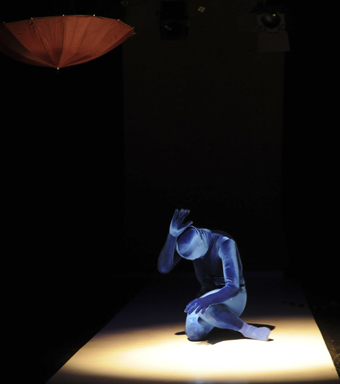
Dean Walsh, Fathom
photo Heidrun Löhr
Dean Walsh, Fathom
Driving trance music catches Walsh in a net before silence once more heralds a return to comedy. With a netted head atop a lurid green dress he dances a camply distorted ballet. I no longer know where I am. The screen image tells me I am at a beach polluted with plastic shopping bags. He caresses himself and strips again.
Colour again. Spinning bags of slimy sputum drip lines of gunk into artistic shapes on the floor. Underneath Walsh sits whimpering amongst the freshly fetid smell. He wails as he flails and slides to escape the glossy mess. He gasps into a surface made beautifully smooth, slides into glides made possible by oily ground. These lines of putrid green become luminescent. The stage is smeared with the muck of humanity and, from this defiled space, the performer leaves, opening a door of light, to enter a cleaner world.
Fathom is baffling. It is crowded with ideas and images: some patently clear, some obtuse. This must be forgiven in an ‘experiment.’ The aesthetics of light, colour and form are the work’s most vital assets. The choreography, only momentarily liquid, seems to reside outside the rhythms of the environment it seeks to embody, with the visual art emphasis yielding flatness rather than depth. But Fathom, in this incarnation, is definitely the promised smorgasbord of ideas.
Fathom, devisor, choreographer, performer Dean Walsh, advisor Paul Selwyn Norton, lighting Clytie Smith, costumes Rebecca Bethan Jones, sound editor Kingsley Reeve, video Martin Fox; Performance Space, Carriageworks, Sydney, May 19-22
RealTime issue #104 Aug-Sept 2011 pg. 7
© Pauline Manley; for permission to reproduce apply to realtime@realtimearts.net
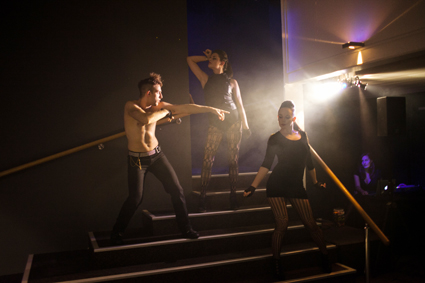
University of Queensland (Australian Drama) students perform Harvest by Manjula Padmanabhan
courtesy University of Queensland
University of Queensland (Australian Drama) students perform Harvest by Manjula Padmanabhan
AUSTRALIAN CONTENT IN THE CURRICULA AND SYLLABUSES OF COURSES IN AUSTRALIAN THEATRE HAS BEEN CONSIDERABLY ADVANTAGED BY THE AVAILABILITY OF PLAY SCRIPTS (THROUGH CURRENCY PRESS, ESPECIALLY, AND PLAYLAB) AND DISADVANTAGED BY THE ABSENCE OF A NATIONAL THEATRE MAGAZINE—LONG SOMETHING OF A MYSTERY. CONTEMPORARY PERFORMANCE AND CUTTING EDGE THEATRE HAVE BENEFITED FROM THE PRESENCE OF REALTIME SINCE 1994 (BUT FOR THE MOMENT ONLY ARCHIVED ONLINE 2001-PRESENT). THERE ARE KEY ONLINE SOURCES LIKE AUSSTAGE, SEVERAL SIGNIFICANT BLOGS (BY ALISON CROGGAN AND JAMES WAITES) AND JOURNALS AND, BEYOND THAT, EVERYWHERE I ASKED, A CONSIDERABLE HUNGER AMONG LECTURERS, RESEARCHERS AND STUDENTS FOR A MORE PALPABLE SENSE OF THE PERFORMING ARTS ACROSS THE NATION—IN WORD AND ON SCREEN.
Opportunities to see theatre and contemporary performance, both current and past, on DVD and online look set to improve, and that includes digital broadcasts to regional cinemas, as the Sydney Theatre Company did recently with Andrew Upton’s adaptation of Bulgakov’s The White Guard. Of course, the Australia Council and various State Government touring schemes have already improved access—a glance at Melbourne’s Arts House current program on our back page is a sure indication of improvement, with its inclusion of a number of Sydney-based artists. The rise of small, innovative live art festivals and the likes of Brisbane Festival’s Under the Radar program have yielded cross-border opportunities only dreamt of a decade ago. Accessibility on a variety of platforms is on the increase—so important for regional universities, but often no less so for students in our huge, sprawling cities with the added impediment of escalating ticket prices.
At the same time, it’s the face-to-face, body-to-body engagement between students and practising Australian artist lecturers and guest directors and teachers that is a top priority, of course more so in training than history or theory courses, but even there you will see increasing emphasis not only on seeing the work but also engaging with it, for example as observers, documenters, reporters and trainee dramaturgs (as in Performance Studies at the University of Sydney; see RT105). In both kinds of courses you’ll find opportunities offered for playwriting and group devising, so that students gain some sense of being ‘inside the artist’ as their own capacities and skills evolve.
For our 2011 survey, I’ve approached teachers (where available—it was that time of the year) from a range of schools and departments asking them where Australian work fits in their courses. Inevitably it’s regarded as important in itself but, more critically, in an international context—a mix of treasuring and exploiting the local scene, attempting to gauge a national perspective and finding our place in the global picture—mighty tasks but ones often tackled with verve and invention.
university of wollongong
Staff members (including practitioners Tim Maddock, Chris Ryan and Janys Hayes) in the Faculty of Creative Arts, University of Wollongong told me that students enrolled in both the Bachelor of Performance or in the Bachelor of Creative Arts (Theatre) “work with contemporary Australian performance practitioners to devise performance works, write and perform their own texts, as well as presenting productions by both Australian and international playwrights. There is a strong emphasis on contemporary Australian artists in both the practical and history/theory program. Students are encouraged to see festivals and site-specific performance, by both independent and major theatre companies, as well as live art, contemporary performance and post-dramatic theatre.” However, it is felt that “the lack of available performance and theatre documentation is an issue.” Keeping up with even recent work can be a challenge making it potentially “redundant, unless properly recorded and readily available.
“Our reading lists include a number of titles from the Rodopi Series on Australian theatre and performance, as well as Currency publications on Australian artists and practices. However, publications on playwrights dominate the field and significantly more DVD documentation is required. At present many recordings are limited to either personal collections or theatre company archives, and can be difficult or impossible to access. This impacts on the ability of staff to teach across a broader range of contemporary performance work. We address this issue predominately by engaging guest practitioners who teach strategies of contemporary performance by example. This intersects with the theory program, which studies the history of these artists and provides the opportunity for such artists to screen and discuss examples of their work.” Guest artists who have directed and/or devised work with students since 2007 include Geordie Brookman, Kate Gaul, Carlos Gomes, Regina Heilmann, Deborah Pollard and from Korea, Park Younghee.
university of ballarat
Ross Hall, Lecturer In Acting in the regional University of Ballarat says that its Arts Academy runs two practice-based Degree Programs one focusing on acting, the other on musical theatre. “Most of the art that’s created here is done so under the broad umbrella of pedagogy and intensive performance training. Over the past 10 or so years, we’ve performed Australian content on a fairly regular basis—mainly text-based works, covering many genres from full-length plays to new Australian musicals. We run scene classes on specifically Australian content—again, mainly contemporary plays. We also run devising strands in the early parts of our courses; [these] map developments in Australian drama and musicals [and can explore] pre-existing Australian stories in a dramatic way. Our students devise work that travels out into the community. We’ve taken part in the evolution of new work, co-producing these with freelance writers and artists. We’ve co-produced issue-based community theatre. We’ve commissioned new Australian works, both dramatic plays and musicals. We have visiting artists and current practitioners give lectures and workshops. We engage practicing directors to work on many of our performance projects.”
flinders university
Jonathan Bollen, Senior Lecturer in the Department of Drama, School of Humanities, Flinders University (and a regular contributor to RealTime), focuses on the fact that “students go on to become the colleagues and spectators of the artists they learn about at university, so it is crucial they learn about who is making work now.” He teaches a course titled Live Arts and Performance that introduces third year students to performance art, post-dramatic theatre and contemporary performance. “It focuses on selected artists and companies within an international field, and traces connections with recent developments and current practice in Australia. It is designed to equip students with the knowledge to navigate international arts festivals and the field of contemporary performance in Australia. The OzAsia Festival in Adelaide provides a focus for the study of intercultural performance in Australia.”
This placement of local performance in an international context is reflected in course structure: first year students focus on three contemporary Australian works in substantial detail; second years “studying the history of modern theatre learn about the New Wave, Australian Performing Group, Nimrod and the Black Theatre movement. At fourth year, I teach topics on Contemporary Australian Drama that explore the production history and dramaturgy of recent works from Australian playwrights, including Wesley Enoch, Jane Harrison, Andrew Bovell, Katherine Thomson, Hannie Rayson, Daniel Keene, Patricia Cornelius, Tom Holloway and Noelle Janaczewska. Australian plays from the 70s to the present are regularly produced as part of the department’s activities.”
Bollen would like to see “more books that focus on the work of particular Australian companies and artists—books that combine documentation of product and process, with analysis and critical reflections. It would be great to have books on Australian Dance Theatre, Bangarra, Back to Back, The Border Project, Chunky Move, Urban Theatre Projects, Version 1.0 and more. Performing the Unnameable (Currency Press with RealTime, 1999, editors Karen Pearlman and Richard Allen) was great when it was published. We need another collection on contemporary performance for the last decade.”
As for magazines and online publications, “RealTime is a crucial resource. I couldn’t teach Live Arts and Performance without it. It is required reading for students. It is the only resource that provides national coverage and international context for contemporary performance in Australia. The other online resources that are crucial for teaching are AusStage and AustLit. I also rely on the websites of companies and artists. The scholarly journals About Performance, Performance Paradigm and Australasian Drama Studies are valuable for in-depth studies, but their coverage is not so extensive.” A vital component of the department’s approach is that “four of the six permanent lecturers in Drama at Flinders are practising artists. Their work as artists forms a core part of their teaching. It is also visible to students in work on productions on campus.” In his reply to my queries, Bollen appended an extensive and impressive list of the websites for artists, companies, festivals and venues in Australia and around the world that are part of the syllabus for his Live Arts and Performance course.
university of queensland
Playwright Stephen Carleton is responsible for Australian Drama at the University of Queensland: “We offer an Australian Drama course that spans the entire 20th and early 21st century from Federation to the present.” The final weeks of the course focus on contemporary practice through a thematic approach, for example “Engagement with the Asia-Pacific Rim” is projected for 2012. “Additionally, we feature the work of Urban Theatre Projects in Sydney and Tracks Dance Theatre in Darwin within the ‘post-national theatre’ rubric of our Contemporary Theatre course…We also offer a third year course in Dramaturgy and Play Writing in which students learn contemporary dramaturgical practices and theory and apply this to each others’ new writing projects.”
“As a practicing playwright and convenor of the Drama Major,” writes Carleton, “I have a substantial investment in the centrality of an Australian focus in our program, and all staff at UQ Drama are committed to encouraging students to place the Australian cultural and industrial theatre experience in an historical and international theatre context. As well, UQ Drama produces Australian works one semester in every four. Most recently that has been work by Van Badham. We encourage students to experiment with the short plays they write in Dramaturgy and Playwriting in terms of form and content.These are frequently produced by the University’s theatre group Underground as part of their annual Bugfest Program.”
As for books, “we set Maryrose Casey’s Creating Frames, about Indigenous theatre practice, alongside broader Australian survey texts such as those by John McCallum and Geoffrey Milne as required reading.” A particular challenge, says Carleton, is the absence of “texts placing contemporary Australian theatre practice within an international context.” However, Carleton claims that “UQ Drama’s emphasis on Theatre Through Time and Space represents the most comprehensive canonical approach to Western European and International theatre (including Chinese, Indian and Pacific theatre traditions) from Antiquity to the Present of any tertiary theatre program in Australia. Placing contemporary Australian theatre practice within this broad spatial and temporal history is a central tenet of our approach.”
However, he adds, “It is incredibly difficult to get information about what’s happening in the regions and the capital cities beyond Sydney and Melbourne. A dedicated national theatre magazine would be a wonderful thing—a specialised theatre magazine that augments RealTime’s focus on multi-form and genred performance, dance, film review and analysis—that would be an excellent resource to have.” He is appreciative of AusStage and AustLit for providing increasing online documentation.
The observations made in Part 1 of this survey add up to a strongly felt need to be able to understand and teach Australian performance on its own terms but within the framework of the national and international perspectives that this country has struggled so long to attain. The work is there, books, journals, archives, new media tools, touring networks, but something’s missing or, better, something’s growing—but how well formed will it be for the performers and performance scholars of today and tomorrow?
Part 2 of this survey will appear in RealTime 105, October-November, and will include observations from Peter Eckersall, Associate Professor of Theatre Studies in the School of Culture and Communication, University of Melbourne; Laura Ginters, Lecturer in the Department of Performance Studies at the University of Sydney; Clare Grant Lecturer in the School English, Performing Arts and Media the University of New South Wales; and Helena Grehan, Senior Lecturer in the English and Creative Arts program at Murdoch University, Western Australia.
RealTime issue #104 Aug-Sept 2011 pg. 8
© Keith Gallasch; for permission to reproduce apply to realtime@realtimearts.net
{$slideshow} THE LAST CO-PRODUCTION BETWEEN QUEENSLAND THEATRE COMPANY AND BELL SHAKESPEARE I’D SEEN WAS HEINER MULLER’S ANATOMY TITUS FALL OF ROME: A SHAKESPEARE COMMENTARY WHICH WAS AN IMMENSELY POWERFUL, MEMORABLE AND RELEVANT PIECE OF CONTEMPORARY THEATRE, A BLOODY AND INESCAPABLE DISSECTION BY MICHAEL GOW AND JOHN BELL THROUGH THE LENS OF SHAKESPEARE AND MULLER OF THE COLLUSIVE NATURE OF CONTEMPORARY POWER AND VIOLENCE.
Their latest collaboration, Faustus, albeit providing solid, rambunctious entertainment that scarcely flagged, appeared at the outset to lack the same intensity of focus. There was ample scope, I thought, for this production to put itself more on the line. Instead what at first seemed to be a confusion of eclectic irony and disparate references was ultimately made clear in this new recounting of the legendary Faust, the scholar who sells his soul in exchange for knowledge of the universe and worldly powers.
The western world, especially as it presents the face of modernity, has long been characterised as Faustian, and non-westerners, from the most powerful to the poorest, appear to be ready to make any bargain with the devil to gain access to what is perceived as a cornucopia. This perception is taking us all to hell, or at least to a fiery end to the planet. And, leading us there, climate change sceptic Rupert Murdoch who in recent media appearances eerily resembles John Bell’s seedy portrayal of Mephistophilis as an Ocker small time, seen-it-all gangster. Bell’s was a peculiarly soulless portrayal, I thought, until the penny dropped…Mephistophilis has no soul.
Jonathon Oxlade’s set was living hell. That is to say, it grandly facilitated what in essence was a very racy production. The conceit was that its denizens were performing a show within a show, all for the mystification and damnation of Faustus. It harked back to travelling players, puppet shows, Piscator and the Weimar Republic, and used a plethora of means from documentary film footage (although this might have been updated to the 21st century) to tacky life-size mannequins as multiple framing devices. Musical references ranged from Mahler and Liszt to kraut rock. Part necessity, part Gow’s aesthetic choice, the acting style was hard, straightforward, unsentimental. Nevertheless, individuals shone through: Jason Klarwein as a Brian Ferry Lucifer, or hunched over disguised in a Richard Nixon mask; Vanessa Downing remorseless as Hecate; Catherine Terracini exhibiting the raunchy aplomb of a 1950s movie star as Beelzebub.
In his writer’s notes, Gow indicates that he has based his adaptation primarily on Christopher Marlowe’s Dr Faustus (at least, the lines regarded purely as Marlowe’s) and JW Goethe’s treatment of the same theme in his Urfaust that preceded Faust; the Tragedy Parts I and II. Gow points out that Marlowe’s collaborators padded out the drama with farcical knockabout, and Goethe introduced the story of the young girl Gretchen. The Marlowe version presented a series of ‘shows’ or plays within plays, so Gow decided to include the episode of Gretchen as another of these ‘shows.’
Even so, as movingly played by Ben Winspear and Kathryn Marquet, it is the most human episode in what otherwise might have seemed a relentlessly cynical piece, and speaks directly to Gow’s vision of love, love carnal and love exalted in the words of Marlowe’s own, The Passionate Shepherd to his Mistress. Throughout I warmed to Gow’s love of the English language of the period which performed a particularly nostalgic threnody at this juncture for our own lost innocence and experience, of the half-familiar, half remembered words from school poetry text books, addressed to the schoolgirl Gretchen. The revelation of the heat of Gretchen’s adolescent desire was searing and poignant and personal in this production. The outcome of this disproportionate love affair has Gretchen mistakenly poisoning her mother with a drug given to her by Faustus so they can meet at night. Faustus, much to the disgust of Mephistophilis, has genuinely fallen in love with Gretchen, but cannot save her from execution, nor does she want him to, putting her faith instead in the merciful nature of divine, not human, justice.
Writing in the 18th century when the conflict of science and faith was less literally incendiary than in the 16th, Goethe was free as a natural scientist as well as a poet to express his fellow-feeling for Faust’s ambition to unlock the secrets of the universe, and so in the end assigns him a less dastardly fate than the one designated him by Marlowe. For Goethe, the love of a good woman was Faust’s salvation. Faust: the Tragedy Part II, declares that, “The Eternal Feminine leads us on.” Marlowe’s Faustus tries to strike a bargain with God by promising to burn his books, only to be condemned for his double apostasy by God’s silence, and Faustus is dragged screaming to Hell. Gow for the 21st century interrupts the narrative precisely at the point where God is silent, the actors explaining that this has all been theatre, that Heaven and Hell are merely stage props, and condemning Faustus to the freedom of his own conscience as he makes a swift exit through an audience that now stands similarly condemned.
At first I spontaneously cheered a gesture that seemed politically apt in the light of the world-wide revival of rampant religious fundamentalism, and so in accord with Marlowe’s avowed atheism as if he were finally free to speak his mind. Over time, however, Gow’s interruption appeared richer, more resonant. In his Thesis on History, Walter Benjamin explains the power of dialectical thinking as opposed to historicism: “Thinking involves not only the flow of thoughts, but their arrest as well. When thinking suddenly stops in a configuration pregnant with tensions, it gives that configuration a shock.” In a highly pertinent essay, “Interruption and the Last Part,” Gabriel Josipovici points out that it was the ability to arrest thoughts that Benjamin cherished above all in the theatre of Brecht. Epic theatre, says Benjamin, breaks up the stream of continuity and allows us to see that events could be other than they are. If post modernism, so-called, has made a fetishism of interruption, the task of the modern artist, Josipovici concludes, is to make something that will catch both the power of continuity and at the same time, through interruption, to break its hold over us. On both counts, Michael Gow’s Faustus delivered.
Queensland Theatre Company and Bell Shakespeare: Faustus, after Doctor Faustus by Christopher Marlowe, adapted and directed by Michael Gow, writer, performers John Bell, Vanessa Downing, Jason Klarwein, Kathryn Marquet, Catherine Terracini, Ben Winspear, designer Jonathon Oxlade, lighting designer Jason Glenwright, composer Phil Slade; Brisbane Powerhouse Theatre, May 30 – June 25,
RealTime issue #104 Aug-Sept 2011 pg. 10
© Douglas Leonard; for permission to reproduce apply to realtime@realtimearts.net
{$slideshow} IN 2010 GEELONG’S BACK TO BACK THEATRE UNDERTOOK THREE INTERNATIONAL TOURS PERFORMING FOUR SEPARATE WORKS, HOLDING CREATIVE DEVELOPMENTS FOR ANOTHER FOUR ALONG THE WAY. YET ARTISTIC DIRECTOR BRUCE GLADWIN STILL DESCRIBES THE COMPANY AS A SMALL ONE. “IT’S NOT AS IF WE’RE OUT THERE MAKING A SEASON BROCHURE WHERE WE DO EIGHT SHOWS A YEAR. WE SPEND A LOT OF TIME HERE WHEN WE’RE NOT TOURING, MAKING NEW WORK OR DOING A COMMUNITY PROJECT IN GEELONG THAT DOESN’T HAVE A HUGE PROFILE.”
While the company may see itself as small, its immense strides in the Australian performance world can best be understood by contextualising its very existence. When touring abroad, the company has often been asked about the social and political climate that has allowed it to come into being. It may seem an odd question—in our liberal society, the emergence of an artist might seem the simple result of an individual’s desire. But a professional and highly regarded theatre company employing performers with disabilities isn’t the norm the world over. In the minds of those asking these questions, says Gladwin, “people with disabilities don’t exist within the cultural landscape of their own countries.”
In the 1980s Australia underwent a process of de-institutionalisation. Concerted efforts were made to provide people with disabilities stable roles within the wider community, with residential, employment and support options expanded. People with disabilities were afforded the opportunity to be more visibly engaged with other sectors of society. This hasn’t occurred everywhere. “In Austria,” says Gladwin, “until recently, they didn’t have to have a government policy dealing with people with disabilities in aged care—because at the end of World War II there weren’t any people with disabilities left.”
To mainstream audiences in Australia, Back to Back has emerged as a fully-fledged company producing complex and artfully realised works in the space of a few years. But such ‘overnight successes’ rarely occur overnight—the company has been operating since 1987, and its recent entry into the international spotlight is the culmination of decades of development and self-scrutiny. That a suite of productions—Soft, Small Metal Objects, Food Court—have enjoyed unwavering critical acclaim is an outcome of this carefully judged and quietly considered approach to the question of what the company wants to be.
At a festival in Spain many years ago, Gladwin saw a company of performers with disabilities from Portugal producing a farce. “Everyone said ‘you’ve got to see this company,’ and they were great, they were really amazing. But what they were performing was this traditional farce. You couldn’t watch it without thinking that in their own country they are performing this alongside other companies performing this type of material and they’re always going to just be this variation of that.”
what theatre can be
Back to Back isn’t interested in reproducing traditional forms of theatre. Rather, says Gladwin, the company “has always been about forging what we think theatre could be. We create our own stories.” “Theatre’s very empowering,” says ensemble member Scott Price. “Anyone with a disability can act, and people with disabilities need that empowerment.” Price became a full-time member of the company in 2008 and appeared in the disturbing Food Court, which premiered at the Melbourne International Arts Festival in 2009.
Performance can be empowering, but many people also find the prospect of exposing themselves to public attention a threatening one. “Do they?” asks Price. “I feel very comfortable in my own skin. I have been nervous occasionally but I’m generally really comfortable. Of course before opening night you’ll be shit-scared but as the shows go by I’m fine.” Though only 24, Price is the ensemble’s most vocal interrogator of the politics and ethics of representing disability in a theatrical environment. “Some of the moral and ethical standards I have,” he says, “well, I’m open to a lot of stuff but what I’m not open to is discrimination towards people with disabilities. Some language is pathetic.”
“Scott is the person in the company where if there was some representation of people with disabilities or if someone uses the word ‘retard’ or something, Scott will stand up and make a statement about it,” says Gladwin. “Well, for example, your use of the R-word,” says Price. “I just don’t think we should use that in a show.”
Back to Back is no stranger to controversy; indeed, the company’s works consciously challenge perceptions of disability, often turning the gaze of the audience back on itself. Soft featured a narrative in which a couple debate the termination of a pregnancy after the foetus is diagnosed with Down’s Syndrome, arguing that the child will never be able to secure proper education or decent employment. Food Court—a collaboration with improvisational jazz group The Necks—centred on a pair of bullies victimising a disabled woman, leading her to a gloomy forest and subjecting her to a barrage of physical and emotional abuse. That these scenarios are played out by performers who themselves might face such discrimination adds a profoundly unsettling edge to each production.
ganesh versus the third reich
The company’s next work is Ganesh Versus the Third Reich, appearing in this year’s Melbourne Festival. “In some ways this work is made in response to some of the feedback we had from Food Court,” says Gladwin. “Some of the questions we had were whether the actors were in charge of what they were doing, and who was the author of the work. How comfortable were the actors with what they were doing? In a way, making a work that’s about the making of a work gave us the vehicle to explore that.”
Again, Price has acted as the ethical barometer of the piece. “You know, you’re portraying Nazis and people were actually killed,” he points out. “This is something that should be discussed but, gee whiz.”
The way the company has handled the dilemma of representation is to incorporate these questions into the production itself. The work features two strands: one is an epic hero’s journey—the Hindu god Ganesh travelling through Nazi Germany to reclaim the mystical symbol of the swastika appropriated by Hitler. The other explores the frame of a theatre company attempting to explore the politics of such cultural appropriation by appropriating cultural symbols itself: “the actual makers of the work in moral and ethical conflict with each other over the making of the piece,” says Gladwin.
It’s impossible to say, yet, what the final performance will be. It’s an ambitious undertaking—a number of scenes are performed in German, and Ganesh features the largest amount of text the company has ever taken on. The work is both a costume drama and a post-dramatic exploration of theatremaking. But Back to Back’s mandate is one of risk-taking, and the incorporation of unexpected elements occurs not just throughout development but during productions themselves.
ensemble and authority
Back to Back is driven by its ensemble. In response to those who questioned the authority of its performers in Food Court, one anecdote may suffice. During the development of that production, one of its devisers and performers, Rita Halabarec, insisted on the inclusion of several monologues that others weren’t so sold on. “There was a lot of conflict between Rita and I in the making of that work, in terms of the editing of it,” says Gladwin. “What went in and what went out.
“She would exercise her authority as a writer in the performance. There were two points at which she would deliver a monologue that wasn’t in the script. It was an issue for us because all the language was projected as well as spoken. So after realising that we couldn’t stop her, we built a palette of phrases that we thought she was likely to say and the AV operator would have to look at a screen and try to click on what was said. I kind of liked that, and came to really love what she offered. It went against my judgement but in the end…I mean, we’ve got The Necks there who are these improvising jazz impresarios and she’s doing the same thing.”
Malthouse Theatre & Melbourne Festival: Back to Back Theatre, Ganesh versus the Third Reich, Merlyn Theatre, Malthouse, Sept 29-Oct 9; www.malthousetheatre.com.au; Melbourne Festival, Oct 6-22
Read reviews of other Back to Back productions in our Art & Disability Archive Highlight
RealTime issue #104 Aug-Sept 2011 pg. 12
© John Bailey; for permission to reproduce apply to realtime@realtimearts.net
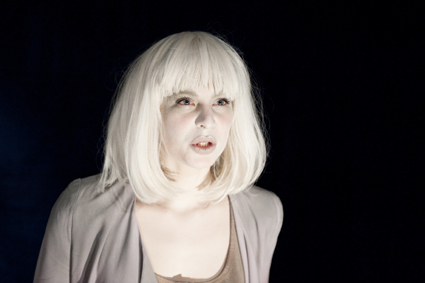
Cate Wolswinkel, J.A.T.O.
photo Sarah Walker
Cate Wolswinkel, J.A.T.O.
FOR SOME TIME AUSTRALIAN THEATRE HAS BEEN SUBJECT TO A SIMMERING YET PERSISTENT ANXIETY SURROUNDING THE FUTURE OF THE PLAYWRIGHT. THE ARGUMENT HAS BEEN REHASHED AGAIN AND AGAIN—THAT AN EMPHASIS ON COLLABORATIVE DEVISED WORKS, NON-TEXT-BASED PERFORMANCE AND CROSS-DISCIPLINARY HYBRIDITY DEVALUES THE ART AND CRAFT OF GOOD OL’ FASHIONED THEATRE WRITING. BUT FOR A GLISTERING MOMENT IN MELBOURNE RECENTLY, ALL DEBATE SEEMED QUELLED AS A RATHER ASTONISHING NUMBER OF NEW AUSTRALIAN WORKS PREMIERED ACROSS THE CITY. YOU COULD WITNESS A DIFFERENT PRODUCTION BY A LOCAL WRITER EVERY NIGHT OF THE WEEK AND STILL BE LEFT WITH MORE UNSEEN.
mka: for playwrights
One company heralding a writer’s renaissance is MKA, a fledgling enterprise whose emergence was anything but simple. Originally based in a converted warehouse apartment in Richmond, MKA’s inaugural season was delayed after the local council ordered the closure of the venue due to complaints from neighbours. An interim space was quickly found in the CBD where a series of 25 play readings introduced Melburnians to the company’s precis—theatremaking that focuses on the development and presentation of original works that put writing first. A third venue in Prahran was host to MKA’s first season proper, comprising four plays of radically different tone and genre, while no less than the Melbourne Theatre Company has come on board to present another short series of readings produced by the group.
The four productions that made up this primer were of varying success. Nathaniel Moncrieff’s Sleepyhead proved a less-than-stellar opener, in part due to missteps in the writing. Positioning itself as an entry in the Australian Gothic genre, it both gestured towards familiar tropes and well-worn themes while not quite grasping the innate ambivalences which underscore the gothic.
A pair of sisters live in a rural shack with a drunk dad grieving the loss of their mother. His benign admonitions, intended to protect them from the harsh realities of life, force them to seek out other ways of escaping this stifling existence, from fantasy and a patchwork spirituality to a dangerous encounter with a stranger who may or may not be a serial killer. Along the way, the ghost of their mother frequently drops by to ratchet up their sense of guilt a notch, while the recurring disappearance of local girls adds a sinister foreboding to proceedings.
Once these elements are assembled however, it’s not quite clear how they are to interact, or what we can really take from them. The standards of the genre are all there: the imperilled young girl, the monstrous male, the fusing of psychology and environment, the return of the repressed, the descent into hysteria. Yet it’s a passive engagement with these notions that eventually plays out, neither problematising their historical meanings nor tapping into their enduring appeal.
Of a radically different order is MKA’s follow-up, 22 Short Plays, which is so self-mocking as to amount to an ideal snapshot of postmodern theory in theatrical form. Delivering precisely what it promises—22 tiny comic vignettes, often a mere minute or two in length, ‘Plays’ may be a misnomer; there’s little approaching character or plot here. But as scenes that quickly establish a recognisable theatrical mode before immediately dismantling it, the production works. The undergraduate atmosphere doesn’t really detract, indeed seeming entirely appropriate to a production that steadfastly refuses to take anything—least of all itself—with any seriousness. There’s no subtext here, but there’s almost no sur-text either; scenes are over before they have the chance to develop into something that might approach a critical comment on, well, anything. It’s very funny and deliberately pointless.
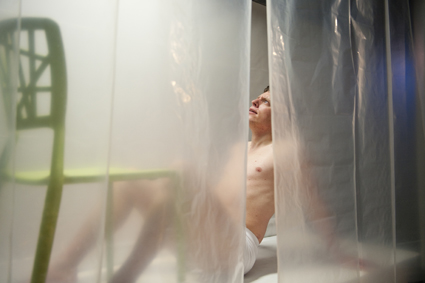
Matt Young, The Horror Face
photo Sarah Walker
Matt Young, The Horror Face
Somewhere between these two works is The Horror Face, a triptych of shorter works by MKA general manager Glyn Roberts. Though set in a dystopian future of clones and corporate control, the work doesn’t sit comfortably in strict science fiction mode. The scientists and company drones of each scenario are linked by the deadly spirit of a spectral lion; the significance of this is left teasingly open. Another return of the repressed, certainly, but is it the animal nature of the subjugated human or the vanquished spectre of nature itself? The other theme that connects the suite is that of the philosophical poverty of self-help and motivational speaking; again, there’s little direct statement made but plenty upon which to ruminate. The production itself suffered from some awkward staging, directing attention away from the writing’s more contemplative aspects, but it certainly came closer to matching MKA’s stated brief.
If The Horror Face hinted at the company’s promise, the final entry in its first season made good that vow. J.A.T.O. by Croatian writer Vedrana Klepica married marvellous design and strong performances brimming with intriguing possibility. A three-piece band arrive in Zagreb a tangle of mid-tour conflict and disappointment; a pair of half-hearted security guards are given the absurd task of protecting a politician’s decoy; a lonely woman drowning her sorrows searches for a man to fill her evening. Hovering around all of this is an imminent act of terrorism, though its exact nature is never quite certain.
Setting the action in an expansive sandpit makes for some wonderful moments of theatre; in one particularly effective scene a trickle of sand stands in for blood, and the liquidity of the stuff at times suggests that the entire production is occurring on a slowly shifting sea. There’s also the playfulness of sand itself and this is nothing if not a playful work. Politics and poetry weave their way through the writing, but the ever-present artifice of playmaking prevents the potential for polemic or a naïve form of realism. It’s proof that astute writing isn’t incompatible with the form of post-dramatic theatre and is an encouraging cap for MKA’s first official turn.
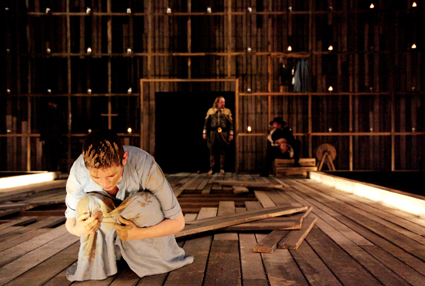
Yael Stone, A Golem Story, writer Lally Katz
photo Pia Johnson
Yael Stone, A Golem Story, writer Lally Katz
malthouse: a golem story
It would be remiss to discuss theatrical writing in Melbourne of late without mention of Lally Katz’s sterling A Golem Story at Malthouse Theatre. Katz has been one of the leading lights in playwriting for a decade, but Golem is a departure from her usual mode. It’s a work of restraint and austerity, invoking the uncanny rather than the fantastic. Based on the Jewish fable of the Rabbi of Prague, the writer has stayed unexpectedly true to her source.
The legend of the golem is a fascinating contradiction—steeped in history and tradition, it is also a quintessentially modern figure, a powerful repository of contemporary concerns. In the most well known of golem stories, it is a man created from mud by a Jewish mystic in order to defend his people from violent outsiders. As such, the golem has been harnessed by storytellers for different ends, as a symbol of both hope and solidarity in times of duress and, by less sympathetic revisionists as a kind of secret weapon that deserves suspicion. That ambiguous duality is well represented in Katz’ retelling, where the golem’s meaning is never confirmed.
Katz’ script opens with a brilliantly spare piece of scene setting as a young woman confronts a man:
AHAVA. Is this Prague?
RABBI. Yes. It is Prague.
AHAVA. What year is it?
RABBI. It is 1580.
AHAVA. Am I Jewish?
RABBI. Yes.
AHAVA. And you are the Rabbi?
RABBI. Yes.
To me Ahava seems to be Katz herself, setting forth to engage with a Jewish heritage to which she is in some ways still a stranger. But what results, especially under Michael Kantor’s direction, is not a work of meta-theatrical self-reference such as the playwright’s Goodbye Vaudeville, Charlie Mudd or Lally Katz and the Terrible Mysteries of the Volcano. A Golem Story is a solemn exploration of the role of the sacred in the modern world, in which Katz and Kantor attempt not to represent the spiritual experience but to reproduce it as immediate experience. Anna Cordingley’s design is a superbly judged mediation of the earthy and the transcendent; the live songs accomplish something similar, as well as reminding the viewer of the connection between voice and the invisible foundations of life (indeed, the word ‘animate’ is from a Latin root that signifies both ‘soul’ and ‘breath,’ as if the two cannot be divorced).
While Katz’ script is a compelling one on paper, the Malthouse production illustrates that a play’s meaning likewise cannot be shorn from its performance, its breath. The art of playwriting doesn’t truly seem in danger of disappearing any time soon, but it takes a lot more than a playwright to make a piece of theatre that truly lives, however brief its time on earth.
MKA: Sleepyhead, writer Nathaniel Moncrieff, director Yvonne Virsik, set & lighting design David Samuel, May 10-28; 22 Short Plays, writer David Finnigan, director Tobias Manderson-Galvin, May 31-June 18; The Horror Face, writer Glyn Roberts, director Felix Ching Ching Ho, June 23-July 9; J.A.T.O., writer Vedrana Klepica, dramaturg Declan Greene, director Tanya Dickson; MKA Theatre, July 14-30; Malthouse: A Golem Story, writer Lally Katz, director Michael Kantor, performers Nicholas DeRossos, Joshua Gordon, Mark Jones, Michel Laloum, Brian Lipson, Dan Spielman, Greg Stone, Yael Stone set & costumes Anna Cordingley, lighting Paul Jackson, musical direction Mark Jones; CUB Malthouse, Melbourne, June 10-July 2
RealTime issue #104 Aug-Sept 2011 pg. 16
© John Bailey; for permission to reproduce apply to realtime@realtimearts.net
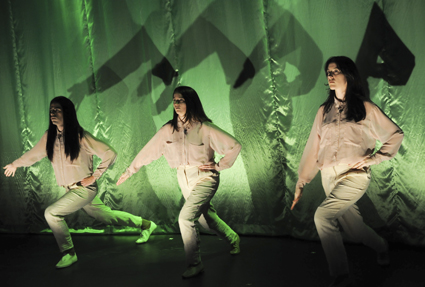
Eden Falk, Zoe Coombs Marr, Mish Grigor, Who’s the Best?
TWO PRODUCTIONS WITH COMPLETELY DIFFERENT PERFORMATIVE IDIOMS FOCUS ON THE PREVALENT ETHOS OF SELF-CENTREDNESS IN CONTEMPORARY SOCIETY WITH SATIRICAL VIGOUR AND RAW HUMOUR. NEOLIBERALISM’S NEO-DARWINIST RALLYING CALL, GORDON GECKO’S “GREED IS GOOD” (WALL STREET, 1987), REMAINS LARGELY UNDISCREDITED DESPITE THE LESSONS OF THE GFC, SO EMBEDDED IS THE ETHOS OF SELFISHNESS IN EVERYTHING FROM TV ADVERTISEMENTS WHERE PEOPLE PINCH FOOD, BOYFRIENDS AND CARS FROM FAMILY OR FRIENDS, TO REALITY TV’S CRUDE AND CRUEL ELEVATION OF SOLE SURVIVAL OVER COOPERATION, TO THE PERSONAL PRONOUN-ISM OF SELFHOOD INITIATED BY MYSPACE AND CONFIRMED BY MYBUS, MYSCHOOL, IPHONE AND THEIR SUNDRY IMITATORS.
stc next stage: post, who’s the best?
I was seduced and wowed by Post’s infectiously delirious Who’s the Best?, commissioned by Sydney Theatre Company’s Wharf 2 Next Stages program. Once again Post raise daggy amateurism to sublime artform—and with more professional verve than ever (see RT101). This experiment to determine which of the three collaborators and friends is the best performer employs a range of tests from Dolly quizzes and Enneagram tests to talent assessments and rating who’s the ‘hottest.’ These are constantly complicated or sidetracked by hilariously mind bending battles of the Abbot and Costello “Who’s on first” variety over the semantics of labelling that frame the tests or even incidental everyday expressions. These are adroitly woven through the script, recurring as running gags and providing an immersive, accelerating pulse to the work.
The performers’ casual delivery (always played directly to the audience while they freely insult each other) yields intimacy and immediacy on a stage which wickedly threatens to subvert the show as curtains and lighting go about their own business regardless—inevitably thwarting attempts to be the ‘best.’ Trio member and co-devisor Natalie Rose, who has recently had a child, is replaced for the premiere season by a wigged Eden Falk who slips easily into the Post mode while bringing his own wide-eyed innocence to Who’s the Best? alongside the well-honed comic personae of Mish Grigor and Zoe Coombs Marr. What adds bite and fun to the show is the sense that the performers are playing themselves with quite a few home truths aimed at demolishing self-centredness despite the final, chanted declaration “we are the best!”
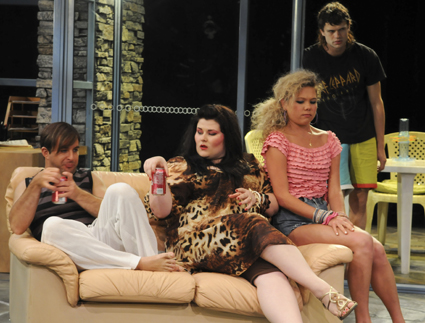
John Leary, Samantha Young, Jody Kennedy, Thomas Henning, The Business
photo Heidrun Löhr
John Leary, Samantha Young, Jody Kennedy, Thomas Henning, The Business
belvoir: the business
Belvoir’s production of Jonathan Gavin’s bitterly funny The Business is set in the 1980s, the very period in which the ‘greed is good’ ethos was getting into its public stride—and we still march to its insistent step in 2011. The world of The Business feels quite like home.
Grossly self-obsessed behaviour is central to Gavin’s bitter-black comedy of bad manners and inheritance snatching, with director Cristabel Sved and costume designer Stephen Curtis wickedly ramping up the rude behaviour and appalling dress sense of the characters to the edge of grotesquerie, but somehow without losing the sense of these people as real, thwarted and, at times, oddly innocent and certainly pathetic—such is their tunnel-vision of the world.
Gavin and Sved took their cue for The Business from Russian writer Maxim Gorky’s grim, sometimes comic play Vassa Zheleznova, which premiered in 1911 and was later a favourite of Stalin who saw it many times, presumably enjoying the agonies of a bourgeois family in their act of self-destruction (and enforced changes to the play in 1935 to suit his tastes). Gavin’s play is based on Gorky’s; it is not an adaptation. But in both there is a shared, strong focus on the female characters.
In Gorky’s original, Vassa, wife to a shipping agent, Zheleznova, is relieved when her husband dies at the end of Act 1 as opposed to the wrenching, protracted and off-stage decline in Gavin’s play which ups the suspense and complications of the mother and her disaffected daughter’s machinations to secure the inheritance the household patriarch would have denied them. Zheleznova’s death is also a relief because the charge of raping a 12-year-old servant girl will now not go to court. Vassa battles on alone, corralling daughters and servants, bribing dockworkers and police and bickering with her estranged socialist daughter (torn between motherhood and the life of a revolutionary) over possession of the latter’s child. The pressure is such that Vassa dies at the play’s end, an exhausted manipulator. Gorky’s empathy for her is limited, but he makes it clear that as well as being a nasty bourgeois she is to varying degrees a victim, though always a fighter.
The Business’ 1980s family is immigrant in origin (no coffee, just a steady flow of tea), wealthy, the adult Australian-raised offspring and their spouses child-like and spoilt. The runaway daughter Anna (Kate Box) returns home, apparently more principled than the rest but, like her mother, Van (Sarah Peirse) embittered by her father’s mistreatment and ready to conspire with Van to seize the inheritance from the ne’er-do-well siblings who would promptly sell-off the family business.
The plays by Gorky and Gavin share the same spirited assault on the bourgeoisie—but what at first seems grimly frantic and comic slips into dispirited horror. Gorky’s Vassa demands that her husband suicide (he dies without resort to that but there is no grieving); Gavin’s Ronald (Van’s crippled second son; Thomas Henning) kills his wife’s lover Gary (Russell Kiefel) and the family dutifully manages the cover-up. Not least because the principal mother-daughter relationship is more nuanced and the two women win out, The Business comes off as more complex than Gorky’s Vassa Zheleznova. The Business might represent a victory for women but not necessarily for integrity or compassion, as if to say the legacy of the 80s is a greedy, self-serving culture, whose children live in luxury and surly disaffection, emasculated by their parents who completely control the business. In this world Van, unlike Vassa, must live on, the legacy doubtless intended for a daughter who will become like her mother, or already has.
If The Business is not strong on 80s Australian politics and culture (Belvoir’s Wild Duck, RT102, similarly kept its distance from contemporary social realities) the specificities of time and place are largely left to design (Victoria Lamb)—an aptly tackily furnished, expensive modernist home with Californian bungalow exposed stone walls, a lounge room replete with board games for children who will never grow up, and a sunny porch that becomes a site for unexpected violence. Costumes (Stephen Curtis) and hairstyling are comically acute, viciously accentuating character traits and some of the fashion follies of the period. Van’s power-dressed shoulders and daughter Anna’s great height pushed up by heels and hairstyle immediately suggest competing forces. The casual wear and pronounced body shapes of the other brattish siblings, Simon (John Leary) and Natalie (Samantha Young), amplify their laziness while the hunching, lank-haired, bare-chested wild-child Ronald (Henning) lurches about like a purposeless Iggy Popp. A persistent soundtrack of 80s pop ranging from the execrable to the arty further compounds the period sense. The family lives inside this bubble. The business is not loved—it’s simply what it means in terms of survival or sustained leisure.
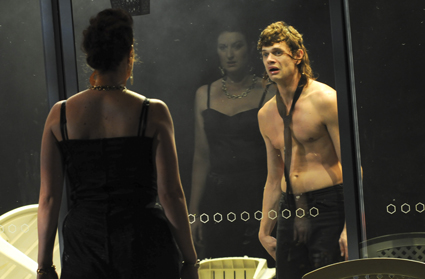
Kate Box in reflection and Thomas Henning, The Business
photo Heidrun Löhr
Kate Box in reflection and Thomas Henning, The Business
The one aspect of the family business that is focused on is a legal suit against it for the death of a worker who refused to wear a protective mask (“What is OH&S anyway?”). Van simply doesn’t want the company to accept responsibility—the victim was, after all, a chronic smoker. This is the world of The Business—a selfish society that doesn’t care enough for itself let alone others.
Inevitably, a limited range of concerns and character traits generates grotesques, utterly without empathy for the dying father (who clearly showed none to them) and locked in a bitter fight for an inheritance that Van has worked so hard for but that others simply feel they deserve. Emotions run to extremes but in Van we can see the fluctuating degrees of frustration, anger, near defeat and the need for reconciliation with Anna, even if it entails compromise. Van shows some compassion for the adulterous daughter-in-law Jennifer (Jody Kennedy)—even, as in Gorky’s original, working with her in the garden. The rest is misunderstanding, confusion, blindness and occasional insights that can’t be explored—Jennifer: “We’re all unhappy; none of us know how to love anything.” The best she can sadly come up with is: “I’m a human mix tape.” Van herself can barely live up to what she expects of her children: “These young people. ‘Duty,’ ‘consideration’—foreign concepts. I keep hoping one day they’ll grow up.” Her relationship with her husband is just as muddy: “So what? Maybe he was violent and drunk and yes he cheated on me, but it’s men like this who made this country what it is.”
What makes The Business potent is its emotional cruelty presented in the guise of comedy, sometimes bordering on farce, rich in gags (the business over a dead parrot, the nouveau riche ‘luxury’ of croissants stuffed with Fruit Loops), in explosive tensions and, not least, suspense (who will get the inheritance?)—and then shock. Director Cristabel Sved and her cast are endlessly inventive, keeping these monsters believable. If you were hoping for empathy and compassion and felt short changed then The Business was not for you—like Gorky’s original, this is tough social satire, even if Gavin is a tad more forgiving. And sometimes tougher: a communal sing-along in the Gorky is replaced with the dissolute Simon and Natalie’s faithful rendering of a ‘Tab Cola’ jingle, followed by Simon’s “Want a root?” It’s that kind of play, that kind of world. In the current political climate we’re hardly in a position to deny it.
Performances in The Business were uniformly excellent, underpinned by a strong sense of ensemble. Sarah Peirse’s Van rarely allows her bitterness to defeat her purpose or her anger to overrule the requisite moments of compassion or opportunism. Peirse plays out Van’s considerable contradictions without doubt or hesitancy. [Appraisal of the other performances can be found in the full review.] In working from Gorky’s Vassa Zheleznova, Jonathan Gavin has created a play that is his own, one finely realised by his collaborators and, sadly (if wickedly funny), a play for and of our times.
–
Post, Who’s the Best?, creator-performers Zoe Coombs Marr, Mish Grigor, Eden Falk, devisor Natalie Rose, lighting Matthew Marshall, consultants Emma Saunders, Hallie Shellam, Clare Grant; Wharf 2, Sydney Theatre Company, Next stage 2011, June 17-July 2; Belvoir: The Business, writer Jonathan Gavin, based on Maxim Gorky’s Vassa Zheleznova, director Cristabel Sved, performers Kate Box, Grant Dodwell, Thomas Henning, Jody Kennedy, Russell Kiefel, John Leary, Sarah Pierse, Samantha Young, set design Victoria Lamb, costumes Stephen Curtis, lighting Verity Hampson, composer/sound Max Lyandvert; Belvoir St Theatre, Sydney, April 27-May 29
Because of illness, the writer’s reviews of Belvoir’s The Seagull and PACT’s Bully Beef Stew will appear in RealTime 105, October-November.
RealTime issue #104 Aug-Sept 2011 pg. 18
© Keith Gallasch; for permission to reproduce apply to realtime@realtimearts.net
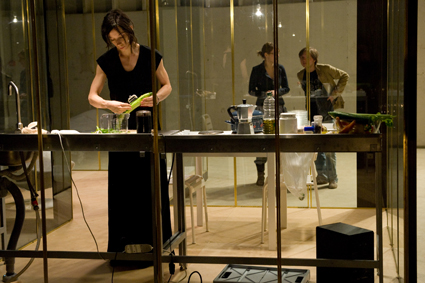
Sanja Mitrovic, Daydream House
photo Anna van Kooij
Sanja Mitrovic, Daydream House
LOGGING ON TO BUY TICKETS TO FESTIVAL A/D WERF, I AM INVITED TO PERUSE THE PROGRAM ACCORDING TO TIMETABLE, PRICE AND GENRE. THE TIMETABLE INDICATES THAT THE FESTIVAL IS ON FROM MAY 17 TO 26 IN UTRECHT (ABOUT AN HOUR OUT FROM AMSTERDAM) AND THE PRICES SEEM TO RANGE FROM €2.50-20 (AUD$4.60-26) PER TICKET—SO FAR, SO GOOD. HOWEVER, IT IS THE GENRE MENU THAT TRULY ASTOUNDS, LISTING THE FOLLOWING OPTIONS: “TEXT(THEATRE), VISUAL ARTS/INSTALLATION, DANCE(THEATRE), FILM-/VISUAL THEATRE, PHYSICAL THEATRE, LECTURE PERFORMANCE, SITE-SPECIFIC THEATRE, MUSIC (THEATRE), PERFORMANCE AND PERFORMANCE/INSTALLATION.” NOT JUST GENRES BUT SUB-GENRES OF THEATRE AND PERFORMANCE—THIS MIGHT JUST BE MY KIND OF FESTIVAL!
Of course, the exciting thing about festivals is that even when accompanied by such rigorous and exhaustive taxonomies, the work itself often falls between and across categories. In doing so, it rewrites the classification system for the next festival, sometimes even the next generation. On the basis of this year’s showing, I’d suggest that Festival a/d Werf consider a new category called “machinic performance.”
laurent liefooghe, woonmachine
One of my favourite works functions as both an installation in its own right and as the set for another performance (more on which later). Laurent Liefooghe’s Woonmachine (Living machine) first appears to me as a small glass island stranded in a sea of concrete—a glimpse of fragility in a heavy-duty, post-industrial space. Inside the installation there is what looks like a tiny motel room, complete with bed, armchair, shower, kitchen and table. When you step inside, you can hear a series of noises, conversations and instructions. If you choose to stand and listen, as I did, you can hear “living tak[ing] place without inhabitants” (program). Or, you can choose to obey the instructions and sit on the bed, pull up the duvet and thus become a performer yourself. Over the course of 37 minutes, an entire day and night pass, the lights changing their colour and the walls their opacity. The overall effect is deeply unheimlich, commonly translated as “uncanny” but also, appropriately in this instance, “unhomely.” This is indeed an “unhome”: not quite life-size, not quite life-like, but near enough to unsettle. The program states that it can be read as both a “modernist glass house and a black box” but it also seems like a postmodernist merging of Apple and Ikea, where both your books and your being have been reduced to a “pod.”
james beckett, blinds
Situated in a similar space to Woonmachine, both literally and conceptually, is James Beckett’s Blinds. Within the same converted warehouse, Beckett has created a tiny cinema of 16 seats. Up the front, a black roller door rises to reveal a white venetian blind. This blind then rises to reveal another white blind, which—after a pause—reveals yet another just like it. This continues, at varying paces, for approximately 30 minutes and 50 blinds, though it is hard to keep track of either. During this time I find myself marvelling at the different shades of white, cream, pearl and alabaster, the different widths of the slats, and the fact that none of the blinds ever tangle, snag or lift in a lopsided fan. More significantly, I think of Malevich’s minimalism and the older theatrical tradition of the reveal, whereby the curtains peel back and we finally see. In the case of Blinds, I keep expecting to see a mirror, which would reflect our own desire to see back at us, but Beckett refuses us even this, choosing instead to force us to reflect on reflection itself, in every sense of the word.
kris verdonck
The relationship between machine, performer and spectator also comes into play in Kris Verdonck’s work. I miss the “live” version of Verdonck’s Actor#1 but later see him in conversation with his collaborator dramaturg Marianne van Kerkhoven and Melbourne academic Peter Eckersall (the festival coincided with the Performance Studies international conference at Utrecht University). Both the work and the discussion are wide-ranging, drawing on the vocabularies of theatre, visual art and architecture. In one work, Dancer#1 (2003), an L-shaped steel beam spins and lurches as it attempts to recover its balance, but since it never can it begins to read as a dance of death—completely improbable given it’s a machine (http://vimeo.com/5436267). In another work, In [www.margaritaproduction.be/_ENG/KRIS_VERDONCK/IN/FILM.html] (2003), a human performer is immersed in a sensory deprivation tank for an hour—at first glance she looks like a robot, but then she blinks and we hear the amplified sounds of her breath and heartbeat. In I/II/III/IIII [www.youtube.com/watch?v=fNo4xeizMf0] (2007), dancers are suspended like marionettes in a life-size mobile; though they seek to maintain unity in their choreography, the tiny physical differences between them eventually send them into ever so slightly different spirals. Each of these works, as well as the more theatrical END [www.youtube.com/watch?v=jbtwrPjuc0U] (2008), is mesmerising and the sooner someone brings them to Australia, the better.
sanja mitrovic, daydream house
Enter sandman, or sandwoman as the case may be in Sanja Mitrovic’s Daydream House, which is set in Liefooghe’s Woonmachine, lending the installation yet another layer of meaning and vice versa. Mitrovic is an elegant hostess, sweeping about in a long black dress offering wine, food and entertainment. The show starts with her peeling and chopping carrots, cucumbers and celery in silence before finally saying, “Boring, uh?” She lists a series of vaguely depressing statistics about how many hours we spend during our lifetimes preparing meals, watching television etc. “But,” she exclaims, “they are such deliciously unproductive hours!” She has a brief conversation about her day with an invisible interlocutor before speech disappears and the segment is repeated as a physical phrase. She then steps out of the house and tells us the story of Chekhov’s mother, who lost the family home twice over. These events apparently inspired The Cherry Orchard and Mitrovic recites a passage from the play’s final act, the phrase “What these walls have seen!” taking on a new complexion. This might be the end, but instead the performer drags out the furniture piece by piece, herding some spectators into the room while others remain outside looking in. She sits on a couch and speaks into a microphone, telling us of life in Belgrade in 1999—of what it is to sit in the dark, or the day for that matter, waiting for a bomb to drop. “Even fireworks get boring,” she says, and “everyone moves away.” Subtle and understated, Daydream House brings together numerous cultural inheritances from Chekhov to cinéma vérité to installation art. Not so much a narrative as a mood, it left me profoundly nostalgic for a place I never knew.
the economics of performance
Such theoretical musings on the mechanics of performance are cut short when confronted by the economics of performance. Not long after I arrive home, I receive an email imploring me to sign a petition against the Dutch government’s drastic budget cuts. The recently elected right-wing coalition plans to cut €200 million—approximately 25% of current expenditure—from the arts budget by 2013. While the “top institutions” (museums, opera and ballet) will survive relatively unscathed, 21 production houses working in contemporary visual and performing arts are facing closure, including Utrecht’s Huis a/d Werf. It is hard to imagine the past few decades of theatre, performance and dance without the Dutch influence and it would be an immense shame to see it disappear now. They have not only helped to pioneer contemporary performance, they have helped to make and remake its very categories.
Festival a/d Werf, Utrecht, May 17-26; www.festivalaandewerf.nl
RealTime issue #104 Aug-Sept 2011 pg. 22
© Caroline Wake; for permission to reproduce apply to realtime@realtimearts.net
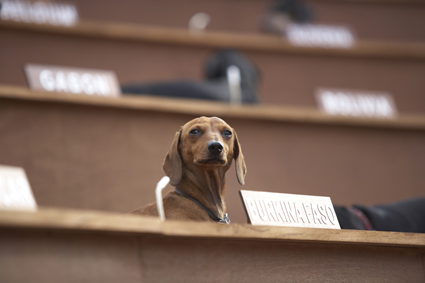
Bennett Miller, Dachshund UN
image courtesy the artist
Bennett Miller, Dachshund UN
ON JULY 6, IN RADIO NATIONAL’S AUSTRALIA TALKS, THE QUESTION UNDER DISCUSSION WAS WHETHER THE VISUAL ARTS SHOULD BE CLASSIFIED THE SAME WAY AS FILMS AND VIDEO GAMES. THE TOPICALITY OF THIS THEME COMES IN THE WAKE OF A SENATE COMMITTEE INQUIRY, WHICH HAS RECOMMENDED THAT THE VISUAL ARTS SHOULD BE SUBJECT TO THE PRINCIPLES OF THE NATIONAL CLASSIFICATION SCHEME, WITH A DISSENTING REPORT FROM GOVERNMENT MEMBERS OF THE COMMITTEE PREFERRING TO AWAIT THE OUTCOME OF A CONCURRENT AUSTRALIAN LAW REFORM COMMISSION REVIEW OF THE SCHEME.
As one of its recommendations, the Senate Committee proposed a self-assessment scheme under which breaches of the classification code would be met with sanctions. More importantly it recommended the appointment of community advisory panels with the authority to advise and guide the National Classification Board in its deliberations. In recommending this, the chairperson of the Senate Committee, the Tasmanian Liberal Party senator Guy Barnett, indicated that decisions of the Board should reflect community standards and attitudes of the day.
In his introduction to Australia Talks, Paul Barclay asked the following questions: How would this affect Australian artists and galleries? Could it restrict artistic freedom? Is it appropriate for art to reflect community standards and attitudes? Not surprisingly, given the focus of the Senate Inquiry, the conversation focused on sexualised imagery of children and the photographic work of Bill Henson. In 2008, the Henson debate reawakened and questioned the long-standing claim that artistic freedom excuses behaviours that may be unacceptable in other realms. This claim, often referred to as the aesthetic alibi, asserts a special case for art that might otherwise be unlawful if part of everyday life.
the aesthetic alibi under fire
Martin Jay described the aesthetic alibi as a “special case of freedom of speech,” one that provides dispensation to otherwise offensive material if it takes place “within the protective shield of an aesthetic frame” (Jay, 1998). The aesthetic alibi has given rise to legislative defences that protect works of artistic merit which would otherwise be deemed illegal (for reasons of obscenity, pornographic content or racial and religious vilification) and is implicitly invoked when contributors to public debate argue for the sanctity of a work on the basis that it is ‘art.’ Bill Henson actually sought classification of his work—it was after all available for viewing on the internet and a postcard which would have brought it into the realm of the classification system—receiving a “Parental Guidance” rating. Nonetheless, the ensuing controversy around the Henson photographs of children reflected prevailing community attitudes and responses to risk and all too often unsubstantiated claims took precedence over critical debate around aesthetics and ethics. The current proposal for community advisory panels raises the question that, where the ethics of practice are negotiated to reflect community standards and attitudes, artistic freedom and the aesthetic alibi come under fire.
The Senate Committee Inquiry and the Australian Law Reform Commission review of the National Classification Scheme question the aesthetic alibi and the assumption that art should have “special” dispensation. The Senate Committee Inquiry argues that artistic merit is not a defence, particularly when it comes to child pornography. While the exploitation of children holds centrestage, the recommendations go beyond this specific question to focus on the distribution and public viewing of art that is deemed to be outside or at the edge of accepted community standards. In essence the Inquiry is concerned with broader issues of censorship. However, the discussion around classification needs to be put in a broader context of the ethical regulation of art both in the public realm and now, more specifically, in the academy. Increasing regulation of the creative arts impacts on not only what we are able to view and experience, but more specifically on what artists can actually do. Thus a pressing question for artists working across the disciplines is: how does ethical regulation affect the creative process?
artists & protocols & ethics
The Australia Council responded to the debate around Bill Henson’s work by introducing its Protocols for Working with Children in Art (2009), linking them directly to the funding of artistic activity. In short, non-compliance or failure to sign up to or act in the spirit of the protocols may result in the denial or withdrawal of funding. Less well known is the impact of ethical regulation of art in the academy. As a result of the 1990s Dawkins’ educational reforms, creative arts education was integrated into the university sector. In the university context, art was reframed as research and artists became researchers. Under this rubric artists, like all researchers in the academy, are answerable to the National Statement on Ethical Conduct in Human Research (NHMRC et al, 2007) and its equivalent for research involving animals, the Australian Code of Practice for the Care and Use of Animals for Scientific Purposes (NHMRC, 2004). With a focus on researcher integrity, justice and beneficence, the decision-making processes of university ethics committees tend towards risk aversion rather than management of risk.
risk aversion & self-censorship
The risk-averse environment inside and outside of the academy has had two major consequences:either risky art projects may not be funded or else (in the case of art in the university) denied approval. More worryingly, as Robert Nelson observed on air, artists self-censor and steer away from projects that are likely to create bother. Thus the impact of ethical regulation, including codes of practice and ethical protocols, have shifted attention away from the circulation of the work among audiences and have refocused it on the production of the artwork itself. When art or art as research is in conflict with established protocols, artistic freedom and the aesthetic alibi are no longer a valid defence.
at the boundaries of art & life
The view that there is something unique about artistic activity that sets it apart from ‘everyday life’ can no longer be taken for granted. Many contemporary art practices sit precariously on the boundary of art and life, and it is these areas of artistic practice that are particularly vulnerable to assertions of unethical conduct within the educational and professional sector. Common themes include the use of animals in art; concerns relating to artworks that utilise surveillance techniques and appear to impinge on personal freedom and/or privacy; instances of self-harm on the part of artists; and, as already mentioned, creative practices that involve children. In 1975 for example, the Australian artist Ivan Durrant draped a cow carcass across the entry of the National Gallery of Victoria and was filmed shooting a cow in front of the Monash Gallery of Art. In 2000 at the Trapholt Art Museum in Denmark, Marco Evaristti challenged viewers to activate food blenders containing goldfish, resulting in animal cruelty charges against the Museum Director. Melbourne’s 2010 Next Wave Festival contained a work by the Australian artist Bennett Miller, Dachshund UN, consisting of 47 dachshunds representing member states of the United Nations, a work that also provoked debate around perceived animal cruelty. SymbioticA has collaborated with the Australian artist Stelarc to grow an ear from cells (Zurr and Catts, 2004). When exhibited, the National Gallery of Victoria, in response to ethical concerns, displayed a notice assuring visitors that no human tissue was used.
The work of renowned French artist Sophie Calle directly engages with the blurred boundaries of the public and private self. In Suite Vénitienne (1980), Calle observed a stranger, following him across Europe and filming his movements. In another work, shown at the Venice Biennale 2007, she displayed an email from an ex-boyfriend, making it the central motif of the work accompanied by over 50 interpretations of the email text, some of which purported to analyse its author. When Marina Abramovic visited Melbourne as part of the 1998 Melbourne International Arts Festival she presented a work which required the audience to be physically restrained within a holding cell of the Old Melbourne Goal. In a separate work Abramovic invited an audience to take up knives and other weapons against her—incurring actual physical harm. Vito Acconci’s Claim (1971) challenged audiences to approach the artist, who was fiercely guarding a stairwell entry, and physically threatening anyone who approached. The Australian artist Mike Parr has long maintained a practice of self-mutilation, burning his skin and sewing his lips together. Bill Henson’s focus on children in the process of artistic creation, and the controversy it produced, can be seen as part of a continuum of artistic activities which challenge conventional and popular concerns about potential harm to self and others.
ethical constraint vs artistic freedom
Contemporary artists and those in the academy who are both influenced by and aspire to emulate many of these avant-garde practices are faced with a contradiction. While individual freedom and unrestrained creativity are at the heart of art training, the legal and institutional frameworks within the profession and educational institutions are likely to be just as concerned with risk management and compliance. The Statement on Ethical Conduct specifies that all research involving humans must be conducted in accord with the following principles: the research must have merit and integrity, be designed and conducted according the principle of beneficence (maximise benefits, minimise risks to participants) and be in accord with principles of justice and demonstrate respect for human beings and animals. Research involving human subjects and animals is submitted to a university ethics committee before a researcher is given the authority to proceed with a project. These committees may require changes to a project’s methodology or reject it altogether if they feel it conflicts with ethical protocols. The notion of the aesthetic alibi is not considered a valid rationale for an art practice that tests these protocols.
A recent survey undertaken at the University of Melbourne suggests a level of anxiety on the part of artists-as-researchers. From the responses, particularly from amongst practice-led researchers, it emerged that researchers believe that the ethics protocols, processes and procedures in universities operate as a silent regulator of conduct and a subtle determinant of content in creative arts research. One respondent expressed concern that the actual training of artists might lose its open inquiry should ethics processes determine modes of inquiry: “The training of a professional artist within academe, even as it includes research training must also acknowledge the serendipitous, convulsive, errant and imperious actions of the imagination in its moments of discovery.” Further, it was revealed that some students self-censored merely because they thought their project would not get through the ethics process: “The mere mention of these considerations [the ethics guidelines] is often enough for the student to self censor.” From these observations it could be argued that through its very stringent processes of ethical regulation, the university ethics procedure introduces limitations that work against ‘cutting edge’ research and mitigates experimentation at the heart of practice.
A 2003 study by Throsby and Hollister found that 91% of visual artists had undertaken some formal training and that 67% identified this as being their most important training and formative influence on their artistic practice. It is not surprising then that there is concern that what happens in the academy may flow through into and impact on the nature of practice once these are professional practicing artists. This in combination with the development of artistic protocols and classification offers a fundamental challenge to artistic freedom and the artistic alibi.
colliding benefits
Many artist academics hold the conviction that art should maintain its social critical role at the ‘edge’ and continue to test and trouble society’s ethical and moral boundaries, a role that stands in conflict with the fundamental precept of beneficence that underpins the Statement on Ethical Conduct. Research protocols could then be seen to be in tension with the fundamental tenet of avant-garde art, a tenet still held dear by many contemporary artists: art acts as a provocation; it operates as the conscience of a society, it produces discomfort and brings its audience into crisis (Bolt et al, 2010). For artists this discomfort and crisis represents precisely art’s benefit, both to the participants and to the wider community, while for an ethics committee such discomfort may be deemed an unacceptable risk. Here, two notions of beneficence collide. A comparable conflict can be observed more broadly as the government moves to limit the protections available to artists in a range of legislation, such as the anti-terrorism laws, representing a further fundamental challenge to the aesthetic alibi.
transgression for the good
The realm of the aesthetic is now meeting that of the ethical, not only in the academy but increasingly in the art world with no considered examination of the implications of this accord. Jacques Rancière (2009; 2010) asserts a distinction between aesthetic practice and ethical practice, and proposes that an ethical practice demands that individuals be treated according to the dominant ethos of the community in which they live. Consequently, the avant-gardism of artistic activity and its challenge to dominant social mores could be considered to be in opposition to ethical regulation. Susan Best encapsulated this tension when she referred to art “being seen as transgressive and lawless rather than being governed by the pursuit of the good” (Best, 2004). In his discussion of the animosity that art can create in a community, Leo Steinberg observes that the “animistic charge of artworks—the vitality imputed to them by the receiver” is what sets art apart (Steinberg, 1986). This vitality, this discomfort and crisis is precisely art’s benefit, both to the participants and to the wider community. The danger however, as Steinberg cautions, is that this discomfort might also allow iconoclasm to find fertile soil.
art circumscribed
A legacy of avant-garde conceptions of art as a necessary challenge to the status quo runs through contemporary practice and theory, perhaps nowhere moreso than in the early experimental stages of artists’ practices. Hence, many contemporary artists and art students pursue practices intended to be in direct tension with society’s norms. These art practices involve activities that may not be condoned in everyday contexts. In the past the concept of the aesthetic alibi, the suggestion that the imaginaries of art are inappropriate targets of generic legislative sanction, has been seen to be inviolate. Increasingly, as we outline here, it is not just the law that seeks to circumscribe artistic activity, but the ethical codes of practice within which art education institutions operate and the professional protocols for artists’ conduct. The combination of these various interventions could in some environments and risk-averse institutions lead to the stifling of creative development. What is called for is an environment that encourages a situated ethics of practice, one that responds to the particularities of each individual artistic activity and interpersonal negotiation, rather than regulating artistic activity through the external imposition of codes and protocols.
additional resources
Best, Sue (2004), Editorial, ANZJA, Vol 4 No 2, Vol 5 No 1; Bolt, B, Vincs, R, Alsop, R, Sierra, M, and Kett, G, (2010) Research Ethics and the Creative Arts, Melbourne, Australia: Melbourne Research Office; Jay, M, (1998), “The Aesthetic Alibi” in Cultural Semantics: Keywords of Our Time. Amherst: University of Massachusetts Press; Rancière, J (2009), “The aesthetic dimension: aesthetics, politics, knowledge,” Critical Inquiry, Vol 36 No 1; Rancière, J (2010), “The aesthetic heterotopia,” Philosophy Today, 54; Throsby, D and Hollister, V (2003), Don’t Give Up Your Day Job, An Economic Study of Professional Artists in Australia. Sydney: Australia Council; Steinberg, L (1986), “Art and Science: Do they need to be yoked?”, Daedalus, Vol 115 No 3, Art and Science (Summer 1986); Zurr, I and Catts, O (2004), “The ethical claims of bio-art.” ANZJA, Vol 4 No 2, Vol 5 No 1
RealTime issue #104 Aug-Sept 2011 pg. 26-27
© Kate MacNeill & Barbara Bolt; for permission to reproduce apply to realtime@realtimearts.net
ASSOCIATE PROFESSOR LISA FRENCH HAS BEEN TEACHING A COURSE IN AUSTRALIAN FILM AT RMIT FOR 10 YEARS, AS PART OF THE CINEMA STUDIES MAJOR IN THE SCHOOL OF COMMUNICATIONS AND MEDIA. WHILE THE COURSE ALWAYS LOOKS AT AUSTRALIAN CINEMA HISTORY, THE LOCAL FILM INDUSTRY AND THE CONCEPT OF A NATIONAL CINEMA, ITS STRUCTURE AND THEMES CHANGE FROM YEAR TO YEAR, TO KEEP IT FRESH AND INTERESTING, NOT ONLY FOR THE STUDENTS BUT FOR FRENCH HERSELF.
Australian Cinema is a 12-week course taught to undergraduates as part of the major or as an elective, with usually around 100 students. Films are selected in relation to the story the course is telling in any particular year, but are drawn from all periods of Australian cinema history and include shorts, features, docos, animations and experimental films.
an indigenous dimension
Whereas last year’s course looked at the themes, resonances and deep storylines throughout Australian culture that built Australian national cinema, this year there will be a stronger focus on Indigenous filmmaking, which will also make the course more contemporary. It’s been designed around films that are made by, or connect with, issues or representation of Aboriginal and Torres Strait Islanders, providing an integrated look at the artistic practice of Australian Indigenous filmmakers, examining how Aboriginal traditions have been cinematically or visually translated by filmmakers through innovative, imaginative and culturally specific approaches; films by non-Aboriginal filmmakers are examined in relation to how they contribute to the representational history and debates. “I’ve been able to hire a young Indigenous academic, filmmaker and activist, Simon Rose, to work with me on this course,” Lisa French explains, “and his ideas are different to mine. He’s particularly interested in humour as a critical aspect of Indigenous filmmaking and we’ll be screening films to illustrate that, such as Stone Bros and Bran Nue Dae.”
The course is built around a two-hour screening, a lecture and a one hour tutorial, with some of this time spent at ACMI; “the mediatheque at ACMI has such a rich resource of Indigenous material that it will be invaluable,” says French. Most of the students are doing a Bachelor of Communication, mostly majoring in Media. “The students are spoilt because they see the films at Hoyts, on 35mm; in a cinema, not on DVD,’ she explains, “although of course they do watch lots of other films on DVD, or through other sources, even YouTube.”
She also has a large number of exchange students; “this is fantastic, as they see our cinema completely differently. They think Muriel’s Wedding is a tragedy; with its elements of cancer and suicide they don’t think it is at all funny.”
australia beyond the mainstream
Margot Nash has just embarked on a new course in Arts and Social Sciences at UTS (University of Technology Sydney), part of a sub-major open to students from anywhere in the faculty, made up of three strands: Reading Australia; Past and Places; and Australian Film. “When it came to designing the course I felt quite daunted at first, but coming to it as a filmmaker rather than a film historian, I felt I wanted to approach it not through the accepted film canon, but rather through an underground, oppositional film history, a non-mainstream film history.”
So while the course provides the study of key moments in Australia’s film history such as the revival of the Australian feature film industry in the 1970s, it also looks at the new wave of avant garde, documentary and feminist film practice in the 70s and 80s and the latest wave of Indigenous and transnational filmmakers in the 90s through to the present. There will be a particular focus on independent and oppositional film practice through the study of recurring themes and issues such as Crime and Punishment, Indigenous stories, Migration, Working Lives, Alternative Lives and Women Make Waves.
This year’s course was over 13 three-hour sessions, although Nash is hoping to increase this to four-hour sessions next year, allowing for the screening of more complete films. This year films that were shown in their entirety included Wrong Side of the Road (1983), with one of the filmmakers, Ned Lander, in attendance, and Rocking’ the Foundations (1986), with producer-director Pat Fiske, screened in the session on activist documentary. But the course started with clips from The Story of the Kelly Gang (1906) and the 2004 three-part Film Australia History of Australian Film from 1896 to 1940, all of which gave students some understanding of the early years of the industry.
“The students had no idea about any of this. They only knew about the big mainstream films and not even much about them. It was a revelation for them,” Margot Nash says.
At the completion of this subject, students are expected to be able to explain the importance of a pivotal figure or figures in Australia’s film history, critique a film produced at a key moment which challenged ideas and conventions and reimagined Australia in some way, or create an imaginative and critical response to the imaginary produced in a recurring key theme or issue. Their responses came in the form of blogs, essays or films: “There were some really creative responses to the films in the strand, and they had reached such an understanding of the richness and diversity there,” Nash said. “One girl embroidered an evening bag as a tribute to the McDonagh Sisters and their witty, worldly silent features from the 20s, filling it with copies of contemporary reviews of their films.”
documentaries: resurgence & diversity
Associate Professor Dugald Williamson at the University of New England (UNE) School of Arts teaches Documentary studies, with a particular emphasis on Australian documentary. He is co-author, with Trish FitzSimons and Pat Laughren, of Australian Documentary: History, Practices and Genres (Cambridge University Press, 2011), a most timely and substantial look at documentary in Australia. He recalls that “when we did ‘market research’ for the book, two or three years ago, at least 29 higher education institutions in Australia had some practical and/or theoretical work on documentary, though the word ‘documentary’ wasn’t necessarily always present in course/subject titles. This range included some 70 individual subjects (units), across both undergraduate and postgraduate level.” As he says, “the diversity of offerings suggested a critical mass in recognition of the relevance of documentary for several kinds of educational purpose— production education and training, media skills and literacies in a changing technological environment, discipline knowledge of media/communications/screen and interdisciplinary interests including history, cultural studies, ethnography etc.”
Williamson believes there’s a resurgent interest in documentary, partly because of the development of infotainment, “but I find that students are often also interested in the discussions (occurring in industry and academia) about whether and how doco can engage with real people and wider situations not just constructed for the show. This goes to students’ own experience of media and what they value. It’s important and rewarding to see what students’ own conceptions of documentary are and to offer ways of widening these, exposing them to a variety of forms and voices with which they may not already be familiar—independent work, experimental, animated and digital doco, as well as the many appealing forms of observational and essay documentary.”
As he says, Australian documentary in its diverse forms has had a role comparable to other arts in interpreting and influencing national culture: “Thanks to our heritage institutions there’s a rich archive of such work, giving a window onto history, engaging with the changing ‘imagined community,’ while documentary continues to evolve and show different perspectives, such as the Indigenous retelling in First Australians: The Untold Story of Australia (2008; Blackfella Films, directors Rachel Perkins and Beck Cole).”
He believes that using documentary in higher education “provides the opportunity to look at how it ties into a range of disciplinary knowledges and social purposes, especially as resources increase online. Studying or making docos can help students see there have been changing forms of independent and community filmmaking as well as mainstream industry and institutions, so there are multiple points of access to making/using media.”
resource riches
The already rich and growing digital resources available to students online are obviously important in these courses and include Australianscreen Online (ASO, http://aso.gov.au/), the ABC’s A Place to Think and Screenrights’ EnhanceTV, while Dugald Williamson says his students have also been using Channel 4 and BBC sites—”it’s amazing what they find.”
ASO, operated by the National Film and Sound Archive, is a promotional and educational resource providing worldwide online access to information about the Australian film and television industry. Audio-visual material is sourced from the NFSA’s archives as well as those of its collection partners, the National Archives of Australia, public broadcasters ABC and SBS, and the Australian Institute of Aboriginal and Torres Strait Islander Studies—all the major audio-visual collections in Australia.
ASO contains information about and excerpts from a wide selection of Australian production from the early days to the present, in a digital resource which encourages the exploration of Australia’s screen heritage. The collection currently has almost 1,500 titles covering a wide range of formats and genres, from professional productions (feature films, television programs, shorts and advertisements) to factual programmes (documentaries, newsreels, corporate films and other historical footage) and non-commercial content (home movies). The website also has a separate section that draws together Indigenous content from the general format categories and profiles of Australian filmmakers in its “People” section. Information available for each of the audio-visual titles in the collection includes a list of the main credits and other production information, synopsis, curator’s notes, filmmaker comments and up to three three-minute clips from the original material. In some cases, as with advertisements and newsreels, items can be viewed in their entirety directly from the website. For other titles there are links to information about how to access a copy of the complete film.
Targeted at a wide and diverse audience including primary and secondary schools, tertiary researchers and students, screen industry practitioners, screen organisations and the general public, ASO receives around 90,000 visits per month, of which around 25% come from outside Australia. Around a third are from the education sector.
film research app
Australian Teachers of Media (ATOM), who have been making their well-respected study guides for over 20 years, have now launched what they believe to be a world first, an interactive film study guide app to be distributed initially through the iTunes App Store; this interactive study guide incorporates clips, animation and web functions. It was launched last month with two major productions, the Jim Loach Australian-UK co-production Oranges and Sunshine (2010) and the documentary Kapyong (Dennis K Smith, 2011).
hidden treasures
Of course, there is much valuable material that is not yet available as a digital resource. I was editor of Filmnews from the late 1970s to the mid 90s; over the same period, Cinema Papers was also going strong. Both publications have a wealth of interviews, production stories, reviews and debates on much of the local filmmaking and filmmakers of the period, as well as articles on the issues, often contentious and hotly fought over, that were important, to do with government policy and practice and the policies and performance of the various institutions within the film community. And there are other publications, both earlier and later, whose valuable contents are rarely accessed now; as online resources they could provide much invaluable support to the students looking at Australian film in various courses. Let’s hope they can soon become available.
additional film resources
AFTRS film journal, Lumina, now in its 7th edition (it can be purchased through www.aftrs.edu.au/explore/lumina.aspx); Dreaming in Motion, Celebrating Australian Indigenous Filmmakers (edited and produced by RealTime for the Australian Film Commission, 2007; the PDF of the book can be downloaded from www.screenaustralia.gov.au/documents/SA_publications/DreaminginMotion.pdf); RealTime has online Archive Highlights on Australian animation and Indigenous film can be found at; ATOM’s Metro Magazine with its enormous archive can be accessed at www.metromagazine.com.au; and there’s the OzDox site www.ozdox.org providing articles, interviews and news focused on Australian documentaries. Eds
RealTime issue #104 Aug-Sept 2011 pg. 29
© Tina Kaufman; for permission to reproduce apply to realtime@realtimearts.net
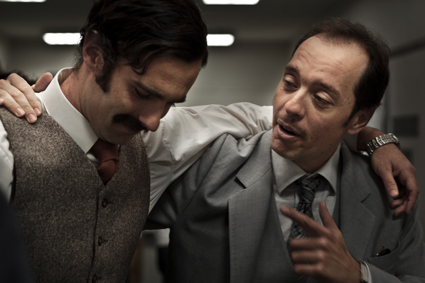
Cop Hard
OSCAR REDDING AND JONATHAN AUF DER HEIDE ARE ADAMANT. THE ONLY SOCIAL VALUE OF THEIR WORK IS AS A USEFUL CORRECTIVE. “AS FAR AS MAINSTREAM CONTENT GOES,” REDDING SAYS, “IT SEEMS THAT THERE’S A LOT OF THOUGHT GIVEN TO PRESENTING MATERIAL WHICH ISN’T OFFENSIVE. BUT I’D RATHER STAB MYSELF IN THE COCK WITH A SHARP FORK THAN SIT THROUGH ANOTHER PLAY BY JOANNA MURRAY-SMITH OR TONY MCNAMARA.”
Fresh from displaying his unstabbed member in Simon Stone’s production of Baal (RT103, p35), which made rather more headlines for the nudity of its cast than for its engagement with Brecht or the mastery of its stagecraft, Redding is playing down the suggestion that there is anything more to Cop Hard than bad accents and vulva jokes. He insists the 13-part web series he has co-produced with auf der Heide and starring a line-up of some of Australia’s most talented and psychologically unhinged young actors is actually less distasteful than a lot of what passes for entertainment in some other, more conservative circles.
“There’s actually a very large group of people who are fundamentally offended by this kind of ‘inoffensive’ theatre,” he continues. “Theatre, film and television that acts as some kind of counselling session, so that an audience can switch off or walk away from what they have witnessed with the comforting knowledge that they are living to the best of their ability and there’s no need for greater understanding or change, is offensive to a lot of people. So maybe producing an idiotic series like Cop Hard, where penises are allowed to float freely, kids are shot in the head and girlfriends make out with mothers, goes a little way to redressing the balance.”
While less vitriolic than his co-conspirator, auf der Heide nevertheless agrees. “I think we’re just producing work that we would want to see and wish there was more of,” he says. “We’re taking this opportunity to provoke our audience and have fun doing so.”
While Cop Hard is certainly provocative, it is arguable that the less perverse among us may find its producers’ sense of fun somewhat baffling. The series tells the story—and I use the world loosely—of mustachioed American detective Larry Hard who finds himself on the trail of a cop-killing clown after a number of his partners are murdered. In the meantime, he sleeps with everyone from a one-legged prostitute to the department’s resident shrink, watches approvingly as his parents copulate on the table during Christmas dinner and shows off his presumably fabled nipple to a group of cowboys sitting around a campfire. It is the last thing one would have expected from the pair whose last collaboration was Van Diemen’s Land (2009), the deadly serious feature film about Australia’s cannibalistic convict, Alexander Pearce, which was warmly received by critics even as it failed to make much of a showing at the box office.
“I felt that we told the story of Alexander Pearce the way it needed to be told,” says auf der Heide, who co-wrote and directed Van Diemen’s Land. “But just because I felt that the style we chose for that film was the best way to go doesn’t mean that I solely want to make contemplative art house films. Cop Hard was a reaction to that and probably an exaggerated one.”
“When you’re working on something like Van Diemen’s Land there’s such a serious nature to the story that the seriousness becomes a side effect of the way you approach the work,” Redding says. “We certainly had a great time making Van Diemen’s Land—a lot of good whiskey was put down in the evenings—but there was no escaping the challenge we faced and how hard we had to work to bring truth to the world and the story being told. Cop Hard seemed like a great opportunity to have a good laugh at ourselves.”
Consisting of 13 three- to seven-minute episodes, at least half of which bear no connection whatsoever to the series’ overarching narrative, the result is not only a pitch-perfect parody of 1970s police procedurals—Spike Jonze’s video for the Beastie Boys “Sabotage”, with its bad stick-on moustaches and I-have-come-to-clean-zee-pool swagger, is its closest relative—but also a masterpiece of ‘non-sequitural’ absurdity.
“Yeah, the series does seem to grab its influences from all over the shop,” Redding says. “One minute it’s Hill Street Blues or Dirty Harry,” auf der Heide continues, “and then it’s something from left field like Twin Peaks. It’s also a journey into a kind of American culture without boundaries, where ego and self-righteousness are without limits, much like Larry himself.”
“But the show digs its heels into Australian culture as well,” he says. “Our entertainment is so saturated by US content that I honestly believe Australians don’t like hearing their own accents on cinema screens. An Australian show shot in Melbourne with American accents is a great way to give the finger to the Americanisation of our culture.” “Although at the end of the day,” Redding adds, “it isn’t really making any cultural comment at all. Although cloaked in the stars and stripes, it’s much more preoccupied with provocation, using very familiar archetypes of pop culture and fucking with our expectations.”
While the pair is quick to dismiss any suggestion that the series might have some deeper meaning, or any thematic connection to their previous work, these dismissals nevertheless strike one as slightly disingenuous. If nothing else, Alexander Pearce and Larry Hard share a fairly obvious fascination with flesh and all things carnal. This obsession is one shared by many of the theatrical productions with which Redding and a number of the pair’s other collaborators have been involved with, as is the series’ depiction of sexuality and its fluid interpretation of masculinity. If James Bond is a man that men want to be and women want to be with, Larry Hard is a man that men want to be with, too.
In one particularly memorable scene, Larry goes undercover in prison where he has violent sex with a talkative inmate in order to uncover his next clue. The inmate in question is played by Thomas M Wright, who not only appeared in Van Diemen’s Land but also alongside Redding in Baal, as the pansexual titular character. Both Wright and Mark Winter, who plays Larry in Cop Hard, are Black Lung Theatre and Whaling Firm alumni.
Redding nevertheless believes that the similarities have little to do with a genuine thematic preoccupation and more to do with the nature of collaboration and the creative environment that these groups are working in. “It’s chicken-and-the-egg-type stuff,” he says. Auf der Heide is a little less circumspect. “I haven’t had any involvement with any of those theatre productions, but there’s definitely similarity in all those works and what was going on with Cop Hard,” he says. “But it’s probably just the result of a bunch of like-minded people banding together and fighting the good fight against conservative entertainment.”
“That said,” he adds, correcting me, “I don’t think Larry Hard and Alexander Pearce could be any more different. Pearce never drives the story of Van Diemen’s Land. I wanted him to be a victim of circumstance. Larry, on the other hand, has free rein to do whatever he wants. He drives the story to unpredictable places because he can do anything without consequence.”
As for the consequences of releasing the series online, with the audience free to donate via PayPal if they like what they see, the pair has found the break from feature film distribution enlightening. “We’d been financially crippled making Van Diemen’s Land,” auf der Heide says. “We wanted to cut out the middle-men—the distributors and exhibitors—by giving something directly to the audience.”
“We loved the freedom of doing a web series where you don’t have to cater for a mass demographic or satisfy a third party. With Cop Hard we could take risks because our aim was to purely indulge a niche audience who we know would love it. The donation system is working well and hopefully, as the show grows in popularity, it will cover its costs. Which is something we’ll never be able to say about Van Diemen’s Land.”
“We’re getting a lot random views out of places like Mexico, Brazil and Turkey,” Redding says, “though most of the interest is coming out of the States. A project like this will always start by finding its feet in and around the friends you have and any industry connections who might be interested, but your core fan base is always going to come from somewhere else. That’s the great thing about the web. As a distribution platform, it isn’t really the future anymore. It’s the present.”
NOTE: Footballer-turned-filmmaker Charles C Custer, the series’ US-based director, was hunting numerous species of animal at the time of this interview and was unavailable for comment. On the basis of his unprofessional, borderline-offensive interviews in other publications, this strikes the author as no real loss.
Cop Hard: http://cophard.tv/
RealTime issue #104 Aug-Sept 2011 pg. 30
© Matthew Clayfield; for permission to reproduce apply to realtime@realtimearts.net
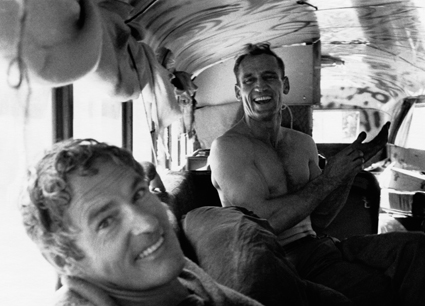
Magic Trip: Ken Kesey’s Search for a Kool Place
ALL TOO OFTEN IN AUSTRALIA DOCUMENTARY IS FORCED INTO THE STRAITJACKET OF BROADCASTER NEEDS, SLIMMED DOWN TO TV HALF-HOURS BEREFT OF CINEMATIC INNOVATION. YET THE SOLD-OUT SESSIONS FOR DOCUMENTARY FEATURES AT FILM FESTIVALS AROUND THE COUNTRY INDICATE A HUNGER FOR MORE IN OUR SCREEN CULTURE—A HUNGER DAVID ROKACH IS LOOKING TO SATISFY THIS OCTOBER WITH THE INAUGURAL ANTENNA INTERNATIONAL DOCUMENTARY FILM FESTIVAL.
“When I came to Australia I realised there was no documentary festival,” comments Rokach, an Israeli film and philosophy graduate who relocated to Sydney in 2008. “So I decided to create one. I saw the impact that Doc-Aviv had not just on the development of new audiences for documentary but also on the quality of the films being produced,” he adds, referring to five years of experience he clocked up working for Israel’s Doc-Aviv International Documentary Festival.
While Rokach acknowledges the international presence of local films like Molly and Mobarak (2003), Forbidden Lies (2007) and the recent Shut Up Little Man (2011), he believes there is a need in Australia for “more financial support for documentary filmmakers interested in developing work that is more cinematic and challenging, and whose approach intends to work beyond the frames of broadcasting.” Alongside support for production is the need for a film culture that can screen and appreciate challenging documentary work—which is where Antenna comes in.
“Antenna’s main objectives are to promote and support documentary film culture in Australia, providing screenings of documentaries that most likely will not be released in local cinemas,” explains Rokach. “The program will reflect what’s happening in the contemporary documentary cinema in Australia and around the world.”
For the inaugural festival, Rokach and his co-director Alejandra Canales, along with Julia Scott Stevenson, have assembled an ambitious program comprising more than two-dozen titles from nations as diverse as Russia, Mexico, Sweden and Japan. Rokach says that the long list of themes covered includes “politics, the environment, gender issues, music and art,” with an emphasis on films with “a very strong directorial approach.”
The festival’s breadth is evident in the range of sample titles RealTime was able to preview. Magic Trip: Ken Kesey’s Search for a Kool Place (directors Alex Gibney and Alison Ellwood) reconstructs Kesey’s legendary road trip across the US with his “merry pranksters” on a psychedelic bus in 1964, drawing on the many hours of colour footage shot by Kesey and others during the journey. Narration is provided by Kesey and the other pranksters via interviews from various periods, although some audio parts are reconstructed by actors from transcripts. Through these images from the time and the assemblage of audio testimony, Magic Trip pulls apart the legend from the inside, laying bare all the wonder, experimentation, naivety and foolishness of a crucial moment in modern American culture.
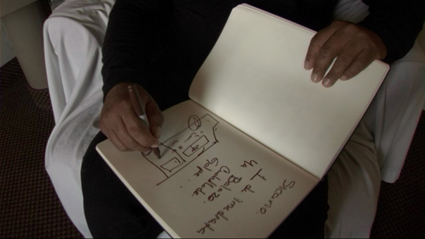
El Sicario, Room 164
At the other end of the spectrum, El Sicario, Room 164 (director Gianfranco Rosi) heads south of the border to contemporary Mexico, where the brutal slaughter of the Mexican drug wars is recounted in unsettling detail by a former “sicario”—one of the elite killers and torturers of the “cartel” that presides over Mexico’s cross-border drug trade. Hooded to protect his identity, the former hit man recounts a litany of horrors in a hotel room where he claims to have once tortured a victim. The power and reach of the organisation he describes is truly terrifying, involving the highest levels of the Mexican government, military and police force, as well as the US police and FBI. Rosi’s film is a model of simplicity that holds viewers in the grip of a claustrophobic horror, made all too real by the regular headlines detailing mass killings in Mexico’s border towns.
Into Eternity (director Michael Madsen) is a very different kind of horror film, taking us into the murky world of Onkalo, a vast underground city dug five kilometres into the Earth’s crust and designed to hold Finland’s nuclear waste for the next 100,000 years. The sheer scale and hubris behind the world’s first “permanent solution” to the nuclear waste issue is dissected with a cool, clinical tone that throws the utter irrationality of our ‘civilisation’ into sharp relief. Director Michael Madsen will be a guest at this year’s festival.
Alongside a strong international program are several Australian features and short documentaries, including an intriguing new 15-minute work from Dennis Tupicoff entitled The First Interview. Featuring a narration by the legendary Agnès Varda, this short brings to life an interview from 1886 between the Parisian photographer Nadar and the French scientist Chevreul.
Antenna will also feature a screening targeted specifically at high school students, a student film competition and various panels. There will be cash prizes for the best international, Australian and student titles. Clearly this is an event underpinned by an ambitious vision looking to carve a permanent place for Antenna in Australia’s festival calendar. Rokach says his team is already working on next year’s program, although he believes “we need to strengthen and grow in Sydney before we initiate a presence in other capital cities.”
It remains to be seen if Rokach and his team can realise their aspirations over the longer-term, but the 2011 program suggests a promising start. Since the demise of Real: Life on Film, Australia has been without a dedicated documentary festival, and the increasing conservatism of our broadcasters and film distributors means an event like Antenna is sorely needed (SBS is to be commended for participating as a major sponsor of the festival). For local documentarians it will be a chance to engage with global currents, be inspired and measure their work against the best other countries have to offer. For Sydney audiences it’s an opportunity to become immersed in all the wonder, joy, horror and provocation the best documentaries can offer.
Antenna International Documentary Festival, directors David Rokach, Alejandra Canales, Chauvel Cinema, Sydney, Oct 5-9, www.antennafestival.org
RealTime issue #104 Aug-Sept 2011 pg. 32
© Daniel Edwards; for permission to reproduce apply to realtime@realtimearts.net
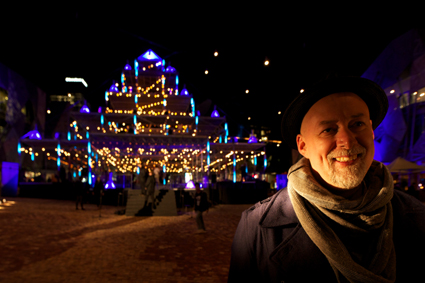
Bruce Ramus, Light Hearts, Light in Winter Festival
photo Jason South
Bruce Ramus, Light Hearts, Light in Winter Festival
NOW IN ITS FOURTH YEAR, MELBOURNE’S ROBYN ARCHER-DIRECTED ANNUAL LIGHT IN WINTER FESTIVAL HELD AT FEDERATION SQUARE HAS GROWN INTO A MULTI-FACETED EVENT IN WHICH LARGE-SCALE PUBLIC ART COMMISSIONS SHARE THE STAGE WITH A PLETHORA OF COMMUNITY-BASED INITIATIVES. FOLLOWING THE WORLD PREMIERE OF RAFAEL LOZANO-HEMMER’S SOLAR EQUATION IN 2010 (RT97, P23), THE CENTRAL WORK THIS YEAR WAS LIGHT HEARTS BY FELLOW CANADIAN, NOW MELBOURNE RESIDENT, BRUCE RAMUS.
Ramus is best known for his pioneering work as a lighting director for leading rock bands, including a 15-year stint with U2. More recently, he has turned his talents to urban design projects, including art installations. Light Hearts is a 13-metre-high pyramid-shaped platform, festooned with more than 2,000 bulbs, video screens and multi-hued strip lights. But its most notable feature is its open invitation to other artists and members of the public to contribute to the work. I spoke to Bruce Ramus a few days after Light Hearts opened.
How did you begin working with light?
My mum was an amateur actress, so I spent a lot of my youth hanging around community theatres and just kind of watching that process of how light affects how I feel about what I’m watching. The process is, I think, really visceral, really in our bodies. That’s where we really get it…it’s not something that happens cerebrally.
It seems to me that there was a big change in the music industry through the early and mid-90s with the integration of video into the stadium rock event in tours like the Rolling Stones’ Wheels of Steel and U2’s Zoo TV.
For me, certainly, the tour was Zoo TV. Prior to that, video had been a peripheral part of large-scale rock concerts. It largely sat on the outskirts of the stage. Zoo TV is when we took the screens and the imagery and moved it all to the centre of the stage. We made five large video walls and had about 200 televisions dotted around the set in groups of twos and threes, making one large, albeit fractured, canvas. The whole idea was a media barrage.
What difference did it make to your role as the lighting director with so much ambient light coming off a large bank of screens?
It allowed the lighting system to do less, so that I could turn it off and let the screens run. I learned to lay back and let the video do the work. And that was really beautiful, because when I did join in, it had a much stronger effect. As it is in any medium, the less you use it, the more powerful it is.
It would have been a few years after ZooTV, I guess, that LED started to become a viable video format?
In 1996, we wanted to develop a new type of video system. At the time, there existed a red and a light green LED, like we see on little power switches on our amps and our microwaves. So we asked Saco in Montreal if they could build blue and a full spectrum green LEDs, which they did. We then took that to Innovative Designs in Belgium and they made the prototype module which became the first ever LED video screen. Then we toured it in 1996-97 on the PopMart tour, which was the largest video screen yet built. It was about 70 metres wide and about 25 metres tall.
On that tour we did 130 shows for over two years, all outdoors. And I watched every audience walk out of there slack-jawed and stunned. Which was not my experience on Zoo TV, where they were vibrant, engaged. It really made me think about why this was happening. I noticed myself that I was watching the screen more than the band. So, there was a problem there.
Since then I have learned that when there is a higher resolution, there’s very little gap in the pixels, so the brain of the viewer does nothing to understand the image. The image just floods in. It’s a very passive experience. But when you start to separate the pixels, the brain automatically has to make up the gap. So it becomes a much more active experience for the viewer. Where on PopMart it was a bit like a music video. You know, we’re cutting to this, cutting to that on the beat, on the guitar solo, you see the strings of the guitar…no energy, a bit numbing.
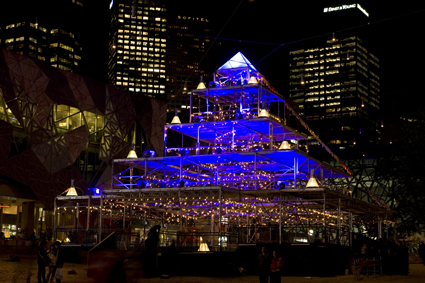
Light Hearts, Light in Winter Festival
photo Fred Kroh
Light Hearts, Light in Winter Festival
Walking through Light Hearts just now I was struck by a strong sense of ritual. That seems like a connection for me to the rock shows, which are a ritual event for a lot of people.
That’s great. Yeah, you get it. The ritual for me is indeed a part of how I design anything…in terms of the history of theatre and how that began as a ritual of transformation. For me, those ceremonies and rituals are why we attend these events, because we all somewhere believe that there’s a potential, however small, for personal transformation. So, that’s how I began thinking about this.
I was asked to come up with an idea to unify the festival. I did want to build a framework for activities and for people to gather in the day, so that it just wasn’t something that sat there and came alive at night and had no role in the day. And so I started to consider a structure and immediately the pyramid came to mind.
You know, the word ‘pyramid’ has many translations, but the one that resonated for me was from the Greek ‘pyra,’ as in pyre, meaning a measurement of fire or light. And then I started to look deeper into why the pyramids were built, the great pyramids in Egypt, and found a lot of consensus on the building of them as an energetic healing symbol. This just kept deepening my connection to this shape and this structure. And a further aim was to make it light-hearted so that anybody could come and respond to this. Anyone could come and build a lantern or tie a piece of fabric on it or, there are so many ways to address it.
Every Saturday we build lanterns with children. It’s just fantastic to see. And then you start to see the other side of light, the light in the child’s eyes when they get to create something, leave their mark on an urban landscape, become part of something bigger.
How would you compare the work here with the way in which an audience participates in a rock event?
In a large stadium or in any show, you know, the audience is very controlled. They aren’t necessarily aware of that, but as the ones who push the buttons with the lights and the video, we have a level of influence on where everyone looks, how they will feel at any given time. With this, it’s much less controlled and it feels really interesting to have that…You know I’ve contacted artists like the Yarn Bombers. Today, I’ve spoken with a graffiti artist who’s coming tomorrow to begin painting some of the bits. And I don’t really know what they are doing and I’m just letting that happen.
How does that work for you? Because as a lighting director you’ve usually got to be really in control.
Yeah, it’s true. There are elements of this that I have controlled quite tightly. There is a lighting system installed on the pyramid, and we programmed it so it has a set of scenes or cues that it runs every night. And it runs through those from 5pm to midnight and then goes into its resting state, its breathing state, which is just one breathing cue that goes to 6am. So that part of it is quite strictly controlled. But then there is this whole interactive element to it. And the one thing that I’m finding more and more important in all of my installations is this interactive element. People do it with their bodies. It’s not something that you have to think about necessarily. You just go in, you can do something with your hands and put it on the structure. That was really important for me, to be able to let control go, give it to the people who wish to engage with it and let them do what they wish.
It will be interesting to see how people just appropriate the space themselves.
Yeah and I’ve seen that happen at night, when there’s no set agenda. The jazz festival was on and there were about 25 young people and they were all dancing around the bottom level of the pyramid…holding hands and swinging and running around the central core…magic. I just loved to see it.
Federation Square’s The Light in Winter, Melbourne, June 2-July 3
RealTime issue #104 Aug-Sept 2011 pg. 33
© Scott McQuire; for permission to reproduce apply to realtime@realtimearts.net
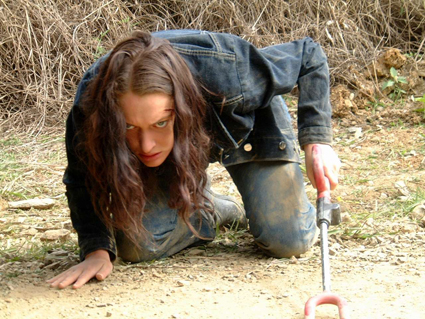
Felicity Mason, The Undead
THIS ARTICLE CONTINUES TO EXAMINE THE CHARACTER OF NOTABLE FILMS FROM AUSTRALIA’S RECENT HORROR BOOM. PART ONE, IN REALTIME 103, FOCUSED ON SAW, WOLF CREEK, BLACK WATER AND INSIDIOUS. HERE I TURN TO OTHER FILMS THAT VARIOUSLY ENGAGE WITH AUSTRALIAN CHARACTER, LANDSCAPE, ACCENT AND MUSIC WHILE COMMITTING TO OR SUBVERTING GENRE FORMULA, OR BOTH.
undead
Like Saw creators James Wan and Leigh Whannell, the Spierig brothers are a young filmmaking duo whose hard work and hands-on commitment to the horror genre has paid off in terms of international success. Brisbane twins Michael and Peter Spierig, graduates in graphic design and film respectively, made about 20 short films together before pooling their savings to make Undead (2003).
Their interestingly flawed first feature displays visual flair, an eye for detail and an obvious love of genre film. The plot is generalised horror/sci-fi—a pastiche of spoof, zombie apocalypse, alien invasion, Western and heroic fantasy. The setting, however, sleepy fishing town Berkeley, is unabashedly Australian. Much attention is devoted to the creation of bucolic local colour. “Welcome to Berkeley,” reads a sign, “Come drop a line.” Protagonist René (Felicity Mason) has recently won the “Miss Catch of the Day” beauty pageant. There are shots of kids fishing, a local cricket match, agricultural life. The local fruit shop bears the legend, “Elvis Parsley’s Grapelands. Berkeley Fruit—Fit For the King.”
The local colour is extended to colourful locals, with a distinct ocker element that’s particularly embodied in the character of Harrison, a cop. This is amusingly juxtaposed with the film’s paranormal subject matter: “When I was a kid, we fuckin’ respected our parents,” Harrison barks, “we didn’t eat ‘em!” René, with whom the audience identifies, is the only character to escape caricature.
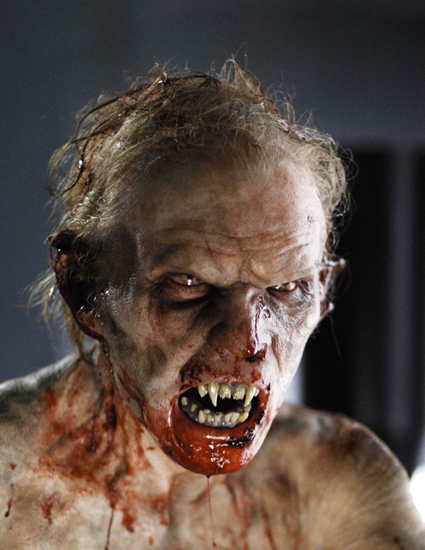
Daybreakers
courtesy Lionsgate Films
Daybreakers
daybreakers
Like Undead, Daybreakers (2009), the Spierigs’ more sophisticated (and bigger-budget) follow-up is visually adept, beginning with its introductory montage that sets the scene for a bleakly futuristic scenario. The brothers have once more turned to genre horror with a vampire film, but this one turns the tables: in the wake of an international plague, vampires have become the majority, the norm, while humans are a dwindling minority hunted down and harvested for their blood.
The vampires’ world is portrayed with elements of sci-fi noir à la Blade Runner (1982). The 1940s costume styling, moody lighting and cool blue tones contrast with the daytime world of the human survivors, whose warmth has a correspondingly bright, colour scheme that is recognisably Australian. Despite the cool stylisation, there’s some expertly timed gore, as when a vampire soldier testing a blood substitute explodes spectacularly. The film’s ultimate thrust is heroic, however, with a phoenix used to symbolise the resurgence of the human race.
Apart from Ethan Hawke and Willem Dafoe (playing an ethical vampire and human resistance fighter respectively) the cast is made up of well-known Antipodeans: Sam Neill, Claudia Karvan, Vince Colosimo, Isabel Lucas, Jay Laga’aia. But it seems that one of the vampire plague’s side effects is the acquisition of an American accent, for all that we appear to be on Australian territory. As Michael Spierig explained at a Popcorn Taxi Screening (www.popcorntaxi.tv/events/past/daybreakers-with-the-spierig-brothers/) this is the result of perceived financial necessity, where recouping a large budget means appealing to a ‘universal’ audience. Arguably, the film’s confused national identity makes its fantasy less convincing, especially to a local audience.
dying breed
Jody Dwyer’s 2008 film Dying Breed cannot be said to suffer from any such lack. Any discussion of recent Australian horror is incomplete without mention of this film, which bends over backwards to incorporate Australian history and Australian signifiers. As we follow four protagonists into the Tasmanian wilderness, we encounter spectacular scenery, Australian convict and cannibal history, meat pies (these last two not unrelated) and the tiger itself. Further Australian horror credentials are established with the casting of Saw’s Leigh Whannell and Wolf Creek’s Nathan Phillips in lead roles.
Despite the pronounced Aussie flavouring, the film follows the tenets of a certain American horror sub-genre which can roughly be described as ‘don’t mess with the locals,’ where holidaying urbanised outsiders fall prey to an insular, inbred community, as in Wes Craven’s The Hills Have Eyes (1977), Rob Zombie’s House of 1000 Corpses (2003) and the recent Resurrection County (2008). Such films often feature two young heterosexual couples driving into a natural location that is unfamiliar to them. In Dying Breed, Irish zoology student Nina (Mirrah Foulkes) is accompanied by Australian boyfriend Matt (Whannell), Matt’s crass mate Jack (Phillips) and the latter’s girlfriend Rebecca (Melanie Vallejo) in the search for the Tasmanian tiger that Nina’s sister was involved in at the time of her mysterious death. In keeping with the formula, the group encounters a ‘quaint’ community with a suspicious attitude towards outsiders. Over the course of the film, this will escalate into a bloodbath. Gender roles in this sub-genre are usually traditionally defined, with women tending towards hysteria while men take action.
Thus, Dying Breed follows a conventional overarching narrative, but remains enthusiastically Australian in its particulars. Though appearing appropriately dark and gothic, the wilderness is not imbued with menace in itself—the real threat resides in the community it harbours. The film’s horror comes out of this community’s adherence to tradition (a constantly reiterated theme) to family customs rooted in Tasmania’s dark history. Shackles and convict portraits are displayed in the primitive pub where the travellers find themselves. This community, we are about to discover, is descended from escaped convict-turned-cannibal Alexander Pearce, known as the “Pieman.” “The pies have hung on,” explains publican Harvey (Bille Brown) as the tourists dig into the local delicacy, “it’s important to us, tradition.”
Towards the end of the film, a clear analogy is drawn between the elusive Tasmanian Tiger and Pearce’s descendants: “Things have to stay hidden—to survive,” Harvey explains.
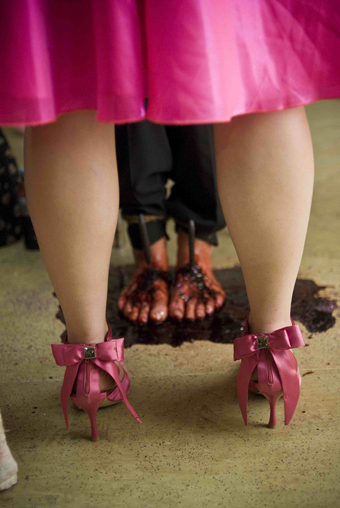
The Loved Ones
courtesy of Koch Media
The Loved Ones
the loved ones
Writer-director Sean Byrne’s first feature, The Loved Ones (2009), feels as authentically Australian as Dying Breed, but for different reasons. Despite its many American cinematic influences, notably Misery (1990), Carrie (1976) and Dazed and Confused (1993), Byrne’s approach to characterisation, his use of landscape and soundtrack all contribute to a sense of Australian identity. The film starts off in teen territory with a rejection in the lead-up to a country high-school dance. Recently bereaved Brent (Xavier Samuel) turns down quiet girl Lola’s invitation to the event. The latter, aided by her father, exacts a sadistic and prolonged revenge.
The exaggerated characters of Lola (Robin McLeavy) and ‘Daddy’ (John Brumpton) are reminiscent of the ‘quirky’ strain of well-known 90s Australian films: Strictly Ballroom (1992), Love Serenade (1996) and Priscilla: Queen of the Desert (1994). McLeavy’s impressive portrayal of Lola has affinities with Muriel in Muriel’s Wedding (1994): childishness, a girlish obsession with romance and weddings, outsider status and an exaggerated manner that’s endearing in Muriel; grotesque in Lola. The use of Kasey Chambers’ plaintive ditty “Am I Not Pretty Enough” as Lola’s theme is another Australian association. Underlining the motifs of adolescent unrequited love and the feminine fear of not measuring up physically, the song is played three times over the course of the film.
In her final scene, a bloodied Lola makes her steady, murderous way along a deserted road, singing Chambers’ song. Centre screen, she’s framed by the landscape, which accentuates her alienation and monstrosity. This image is an inversion of the similarly memorable scene from Greg McLean’s Wolf Creek (2005) where an injured Kristy attempts to escape along a deserted outback road. It’s one of The Loved Ones’ emblematic moments, encapsulating key narrative themes of loneliness, loss, warped femininity, violence and obsession.
enter the audience
While the Spierig brothers move into potential blockbuster territory with a 3D remake of The Dark Crystal (1982), two new Australian horror films are breaking ground by involving audiences in the filmmaking process via the internet. The Tunnel (2011) raised its modest 135K budget by pre-selling each of the film’s frames over the internet and on completion was released for free online. Upcoming office horror film Redd Inc. created a large online community by encouraging internet submissions of material—from performances to artwork—for inclusion onscreen. Interestingly, these two films also signal a shift away from the natural landscape towards an urbanised Australian horror, though it seems a safe bet that our open spaces will always have their place in the darker Australian cinematic consciousness.
RealTime issue #104 Aug-Sept 2011 pg. 34
© Katerina Sakkas; for permission to reproduce apply to realtime@realtimearts.net
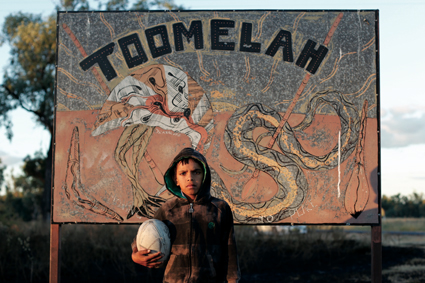
Daniel Connors, Toomelah
TOOMELAH IS A SPECK ON THE MAP BETWEEN MOREE AND GOONDIWINDI IN NORTH-WESTERN NEW SOUTH WALES. A FORMER MISSION, ITS HISTORY REFLECTS THAT OF AUSTRALIAN BLACK/WHITE RELATIONS IN EERIE SYNECDOCHE: POLICIES OF ASSIMILATION, CHURCH INTERVENTION AND THE STOLEN GENERATION; RECOGNITION OF LEGAL RIGHTS, CULTURAL AMNESIA AND THE SOCIAL CORROSION WROUGHT BY DRUGS AND ALCOHOL; POLITICAL APATHY AND INEPTITUDE, INTERRUPTED SERVICES AND DECAYING INFRASTRUCTURE.
Toomelah came to national attention in 1987 when it was visited by Marcus Einfield, then President of the Human Rights and Equal Opportunities Commission, to see first-hand its appalling living conditions, then again in 2008 when its District Nurse resigned, exhausted by 20 years of bearing witness to endemic neglect and abuse. It’s also where director Ivan Sen’s (Beneath Clouds, 2002, Dreamland, 2010) mother grew up. His third feature is a quietly gripping portrait of the community and paean to childhood. The film opens with a young boy, Daniel (Daniel Connors), waking to an empty house—and fridge. His mother spends her days in a haze of marijuana smoke, while his grandmother sits quietly in the sun, alone with her memories. Free to fend for himself, Daniel wags school, dreaming of becoming the boxer that his father (Michael Connors) was before alcohol claimed him, or a ‘gangsta’ like Linden (Christopher Edwards), the local dope dealer and default father-figure to Daniel.
The film unfolds gently, what plot there is arising from the sluggish rhythms of daily life in the settlement. Daniel’s Great-Aunt Cindy returns for a visit, decades after having been stolen from her family; Daniel valiantly pretends he doesn’t care whether 10-year-old Tanitia (Danieka Connors) likes him or not, while nursing a grudge against another child, Tupac; and Linden struggles to maintain control of the local drug trade when Bruce (Dean Daley-Jones) is released from prison and returns to town.
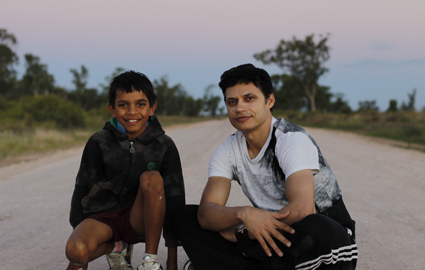
Daniel Connors, Ivan Sen, Toomelah
Connors is excellent as the mischievous Daniel, a wide-eyed observer in an adult world, discovering its limits with thoughtful curiosity. It is at times a brutal world however, and Sen is unflinching in his depiction of the community’s degraded circumstances—some may be turned off immediately by some extremely coarse language—while simultaneously showing tremendous compassion towards his subjects: the elderly, burdened with a history of dispossession and cultural destruction; their addiction-ravaged offspring; and the new generation who seemingly face a bleak future of stunted opportunities and more of the same.
Sen wrote the film after visiting for several months, his observations of daily life and transcriptions of local conversation providing the raw grist for his script. Despite the spectacular natural beauty of the surrounding country, monumental landscape shots are few and far between; Sen instead shoots his script using a handheld Panasonic 3700 in a rough and ready naturalistic style that suits the material. In this respect, the film employs techniques Sen explored in his experimental second feature film, Dreamland, allowing the story to develop to some extent as the film was shot. Although he doesn’t strive for the kind of visual poetry achieved in Beneath Clouds, Toomelah brims with unobtrusively observed visual detail: black and white photos of people in traditional garb hanging on the school library wall; late afternoon sunshine cutting across kids playing footy in the dusk; a broken exercise bike lying discarded amongst rusted car bodies.
Some may feel the film’s technical limitations detract from its overall impact, however the benefits gleaned outweigh the advantages of a full production unit. Sen’s approach is personal and direct, allowing a level of community engagement that would otherwise have been impossible. Most roles are played by local non-professional actors, their efforts bringing an immense sense of authenticity to the film. That said, the acting, although generally effective, occasionally sags, a fact not helped by Sen cramming historical information into dialogue, to the detriment of the film’s otherwise mesmerising realism. Also, at 106 minutes, it goes for a quarter hour longer than necessary, its pleasing messiness sprawling into flab.
Ivan Sen has remarked that the film should “not be seen as political finger pointing”, and indeed it stands on its artistic merits. However, once the reality represented in Toomelah is accepted, politics must inevitably intrude. “What are you going to do with yourself?” Daniel is asked. “I dunno—what can I do?” is the ingenuous reply. Answering such a question is impossible for Daniel without having any perception of the realities of his circumstance—it is to Sen and the people of Toomelah’s credit that the beginnings of such an understanding might be gleaned from this wonderfully ragged film.
Toomelah was screened at 2011 Cannes International Film Festival in the Un Certain Regard Official Selection and at the 2011 Sydney Film Festival. Australian cinema release date to be announced.
Toomelah, writer, director, Ivan Sen, producer David Jowsey/Bunya Productions, www.toomelahthemovie.com
RealTime issue #104 Aug-Sept 2011 pg. 35
© Oliver Downes; for permission to reproduce apply to realtime@realtimearts.net
RUMOUR HAS IT THAT AVANT-GARDE CINEMA CONTINUES TO THRIVE AROUND THE WORLD, BUT LOCALLY ONE MIGHT SUPPOSE THAT THE MEDIUM WAS AS DEAD AS VAUDEVILLE. SO THE AUSTRALIAN INTERNATIONAL EXPERIMENTAL FILM FESTIVAL HAS THE APPEAL OF A CONSPIRACY AGAINST THE PRESENT—CONDUCTED, FOR THE SECOND YEAR IN A ROW, AT THE BACK DOOR WAREHOUSE IN DEEPEST PRESTON, OUT ON THE FABLED 86 TRAM LINE FAR BEYOND THE BOHO HANGOUTS OF HIGH STREET, NEAR THE DECAYING INDUSTRIAL PRECINCT WHERE PHILIP BROPHY SHOT HIS DYSTOPIAN NORTHERN VOID (2007; RT 78, P27).
Best to be honest: here in Australia—at least, for those of us who aren’t regularly able to scoot off to specialist events overseas—it is hard to get more than the faintest first-hand impression of the state of play in the experimental film arena. That’s one reason AIEFF deserves celebration, even if this year’s eclectic program felt more assembled than curated and even if 90% of the “films” were screened, in accordance with their makers’ wishes, on video.
While for the individual viewer this matters or doesn’t, from a strict artisanal perspective the two media remain as distinct as pottery and robotics: one lesson to be taken from the AIEFF program is that film, at this budgetary level, is still easily the superior format for artists concerned with what are imprecisely termed the “material” qualities of light and colour. This could be observed even in works as fragile and ephemeral as Irene Proebsting’s Super-8 Harmonic Ghosts—where faintly Gothic images brush against each other like dry, blown leaves—or as unabashedly decorative and “girly” as Jodie Mack’s 16mm Posthaste Perennial Pattern. It was good to see Tony Woods, the most persistent Super-8 filmmaker in Melbourne, return with Colour, Glass and Chrome, which, as ever, seeks out redemptive beauty in fragments of the mundane: in this case, the play of light on shards of glass found in a rubbish skip.
Film transmutes, it’s still tempting to suppose, whereas video only records. In fact, festival entries in both media showed alternate impulses to demystify and remystify the image, a dialectic also evident in the two prevailing approaches to sound design: on the one hand, the crunches and rustles of ‘raw’ or deliberately distorted sound, the aural equivalent to queasy, handheld camerawork; on the other, gloopy electronica akin to passing through a New Age carwash, intended to put you in a receptive trance.
Overlapping with this was the old battle between the representational and the abstract—between the moving image as a document and the screen as an open field where unforeseen forms can emerge. On the ‘abstract’ side were fireworks displays such as Simon Payne’s Vice Versa Et Cetera and Paul O’Donoghue’s Phasing Waves—both on video, the latter oddly culturally specific in its nostalgic deployment of clunky 1980s technology. At the other end of the spectrum, Erica Scourti’s Woman Nature Alone is a performance piece not a million miles removed from the hijinks of a ‘twee’ comedian like Josie Long, with Scourti herself enacting a half-hearted charade of communing with the environment: romping across parkland, hugging trees and eventually dropping off to sleep.
The aim might be to satirise outworn romantic postures, including a need to occupy the spotlight—but Scourti, like Long, does not escape the perils of studied cuteness. By contrast, Charles Fairbanks pointedly erases himself from Wrestling With My Father, a conceptual one-shot that really works. Fairbanks Snr is filmed head-on as he (apparently) watches his son fight it out in the ring; a burly fellow in a cap, he sits with his legs wide apart, drums his fingers during lulls, and shifts back and forth on the bench to follow every detail of the unseen action. Fairbanks’ equally successful The Men is a close-up essay on a related subject, with a mini-camera attached to a wrestler as he grapples with a bearded opponent; the fragmentary images are redolent of eroticism as much as combat.
Implicitly, such ventures put quotation marks around the notion of the personal, an unavoidable problem for artists without the alibi of commercial cynicism: how far are captured images to be understood as mirrors of consciousness, as opposed to raw material manipulated from a more-or-less ironic distance? AIEFF had its share of ‘diary’ works reliant on the idea of the camera operator as a semi-domesticated flaneur—gazing out an apartment window at dawn or wandering idly round the city, offering spiritual sympathy to beggars, watching trains go by. Taking a couple of steps back, an alternate option is to dedicate yourself to re-processing old home movies, with the passage of time as part of the point, as Mike Leggett does in his beautiful Bosun’s Chair. Or you can simply borrow from the communal archive: the ultimate example of this tactic, Bob Cotton’s ZeitEYE flashes across the history of modern graphics from Futurism to the Wii, with fleeting captions suggesting a media arts version of “We Didn’t Start the Fire.”
Speaking to many of these issues, Steven Ball’s Personal Electronics is a study in paranoia composed of deranged clips lifted from video-sharing sites: the sources are mainly American, though the wry bemusement implied by these juxtapositions is British to the core. A figure slumped on a couch twitches violently, like an extra from Paranormal Activity (2008); a woman lectures us in voiceover on the esoteric import of a purple shaft of light which seems to emanate from a parked car. Acknowledging that some will perceive this “directed energy weapons ray” as visual noise, she instantly rejects the possibility: “These are very clearly lasers…Lens flares are not so concentrated, for one thing, they’re more diffuse.” In context, it’s a parody of hermeneutics: the artist striving to impose significance on ‘found’ material, the viewer labouring to decode that intention from the other side. Madness awaits us all, as we struggle to make meaning from what we see.
2011 Australian International Experimental Film Festival, The BAck doOR, Melbourne, April 29-May 1
RealTime issue #104 Aug-Sept 2011 pg. 35
© Jake Wilson; for permission to reproduce apply to realtime@realtimearts.net
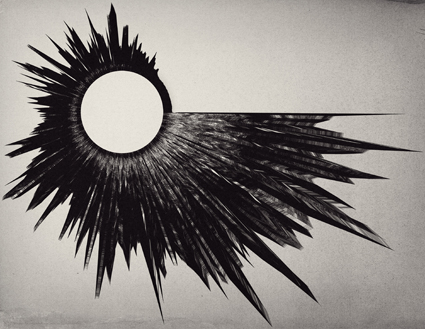
Untitled, 2010, sound generated digital still, Riley Post, ANU graduate
DARREN TOFTS ONCE DESCRIBED THE PREHISTORY OF TECHNOLOGICAL TRANSFORMATIONS OF CULTURE AS “EVERYWHERE FELT BUT NOWHERE SEEN IN THE TELEMATIC LANDSCAPE OF THE LATE 20TH CENTURY.” AS WE MOVE INTO THE SECOND DECADE OF THE 21ST CENTURY, THE AFFECTS THAT TECHNOLOGICAL TRANSFORMATIONS PRIVILEGED IN CULTURE AND ART IN THE LATE TWENTIETH CENTURY—INTERACTIVITY, INTERACTION, IMMERSION—APPEAR NOW TO US AS COMMONPLACE AND THEIR USE IN ART AND MEDIA TAKEN FOR GRANTED. IT IS EASY THEN TO FORGET JUST HOW VIBRANT THE MEDIA ARTS SCENE HAS BEEN IN AUSTRALIA SINCE THE 1980s. MEDIA ARTISTS’ ENGAGEMENT WITH THE TECHNOLOGICAL INNOVATIONS OF THAT TIME CAN, LIKE A KIND OF FORGOTTEN PREHISTORY, ALSO BE SAID NOW TO BE EVERYWHERE FELT BUT NOWHERE SEEN (WELL, RARELY).
The restructuring of the Australia Council boards in 2005, which included the replacement of the New Media Arts board with the Inter-Arts Office and the transfer of funding for a significant portion of media arts practice to the Visual Arts Board (VAB) and the Music Board, was meant to reflect the subsumption (or is it sublimation?) of media arts practices to the mainstream. According to the Media Arts Scoping Study produced in 2006, these changes did not reflect a failure by media arts to consolidate itself as a set of stand-alone practices. Rather, it was testament to the success of these artists that what was once a discrete field was now something that arts practitioners from all fields were incorporating into their practices.
Similarly, media arts as an academic discipline seems to be settling back into more established disciplines—Fine Art, Media and Communications, Design, Creative Arts and Science and Technology—no longer a monstrous hybrid struggling to find its place in the gallery or the museum. Again, whether this is indicative of subsumption or sublimation is hard to tell. Certainly, in a post-Bradley Review tertiary education environment, university managements prefer disciplines that are recognisable and established (not to mention attractive to the mainstream).
One sure outcome (for this writer at least) is that it makes the whole question of the Australianness of the media arts curriculum quite difficult to answer. Of the 10 academics that I spoke to, only two, Kathy Cleland (The University of Sydney) and Darren Tofts (Swinburne University), placed a pointed emphasis on Australian media art in their curriculum. Interestingly, both of the subjects that they teach approach media arts from a predominantly theoretical perspective and use Australian media artists as case studies. Tofts’ interest in the historical trajectory of media arts in Australia is evident in his response to the question of the importance of using Australian examples:
“In focusing on Australian artists there is an immediate context for students to ground media art practices; but more importantly it is valuable for students to be aware of the crucial contribution Australian artists have made and continue to make to the international media arts scene. For instance, cyberfeminism as an international formation, movement, arts practice and concept is impossible to think of outside the contributions made by VNS Matrix, as well as the subsequent, individual arts practices of its founding members (Francesca da Rimini, Josephine Starrs); or for that matter the crucial, pro-active curatorial/critical work and advocacy of Julianne Pierce and Virginia Barratt.”
Brogan Bunt and Lucas Ihlein (University of Wollongong) pointed out that their main engagement with local context is through regular guest lectures. “We have recently had artists like Wade Marynowsky, Deborah Kelly, Louise Curham, Lucas Abela, Mike Leggett and Lynette Wallworth give lectures to our students. We try to incorporate at least two guest lectures by local practitioners in each Media Arts studio subject each session. We also have strong commitment to contributing to local Media Arts culture. Apart from dialogue with local Wollongong artist run spaces (Project Contemporary Art Space, 5 Crown Lane, and so on), we have also been building links to relevant festivals/events/groups in the Sydney metropolitan area.”
Other practitioner academics such as Ross Harley (COFA, UNSW), Martine Corompt (RMIT), Oron Catts and Ionat Zurr (SymbioticA) and Troy Innocent (Monash University) all commented that while they would use Australian examples where appropriate and available, the necessary resources were not always available to make that possible. As Zurr noted: “…our programme focuses on art and science and furthermore, predominantly on art and the life sciences. Therefore, our teaching is focused on artists (Australian or non-Australian) who engage in working with life, living materials and biotechnology (rather than generally media art or art and technology). There is a growing number of artists within Australia who are working within this field but publication wise—the majority of books (scholarly or not) magazines, journals etc are produced overseas without emphasis on the ‘Australian’ aspects.”
The question of access to resources certainly recurred in many of the responses. The accessibility of the artworks themselves and the scarcity of critical responses to the art, as well as the lack of documentation and poor archiving of media artworks have presented challenges to academics working in the field.
Kathy Cleland noted that as a result of her experience as a curator over the last 10 years, she has a lot of documentation of Australian media art works which she uses in her course. She also pointed out, however, that there are not that many books specifically focusing on Australian new media art (Darren Tofts’ Interzone: Media Arts in Australia is one of the exceptions) and that “books published internationally don’t tend to mention many Australian artists with the exception of Stelarc who is in everything!”
Darren Tofts pointed to John Conomos’ Mutant Media which examines the convergence of media arts, film and video art as a key text. “Stephen Jones’ recent Synthetics is also an important contribution to the field, evidencing the robust longevity of Australia’s contribution to the international scene.” Both Cleland and Tofts pointed to RealTime as “invaluable” with Tofts’ noting that “the Australian media arts scene is unthinkable beyond the support and stewardship of Keith Gallasch and Virginia Baxter.” All of the respondents agreed that more online magazine/journal resources focused on media arts would be welcome.
Norie Neumark, in her role as Director of the new Centre for Creative Arts at La Trobe University argued that “it would be useful to have more and varied material and critical analysis of Australian media arts, including online resources, DVDs and CDs. However it is also vital to see Australian media artists included in broader publications, both about contemporary Australian art and about international media and contemporary art. In my own recent publication, my co-editors and I were particularly keen to include Australian media artists in a routine way in an international publication.” (Norie Neumark, Ross Gibson, and Theo van Leeuwen eds,Voice: vocal aesthetics in digital arts and media. MIT Press 2010; reviewed in RT103)
As Martine Corompt noted, the difficulty of accessing artworks continues to plague media arts: “I used to have a great collection of early interactive works, on CD and floppy disk, but of course they are all unplayable now due to changes in operating systems. Even some of my own old work also can’t be played.” The platform-specific nature of many media artworks is compounded by the difficulties they present to collections managers and archivists. This is not, of course, specific to Australian media artworks. However, more needs to be done to preserve what is left if the impact of Australian artists is to continue to influence the local curriculum. Paul Thomas (COFA and Curtin University) has been instrumental in drawing attention to this pressing issue through his involvement in the Media Arts Scoping Study (MASS) and the National Organisation of Media Arts Database (NOMAD). Similarly, the ARC funded research project, Reconsidering Australian Media Art History in an International Context, led by Ross Harley, Anna Munster, Sean Cubitt, Michele Barker, Paul Thomas, Darren Tofts and Oliver Grau aims to create a foundational online resource which will “provide future artists and curators with a cohesive overview of Australian media arts’ recent milestones and developments, crucial to making significantly innovative new work.” (See http://bit.ly/pu9f6z)
As a discrete discipline, the sound arts continue to have only a tenuous hold in academia. Their public profile, in contrast, is maintained by a robust (and youthful) underground of practitioners (see Julian Knowles, “Sound art and the extended university,” RT80). As Knowles points out, “it is clear that, despite its fragility, the contemporary sound and experimental music performance scene is significantly intertwined with the small network of university departments who embrace this area of practice and that the best students have developed into exceptional practitioners through this informal collaborative network.” It is in this context that he argues for the importance of the practitioner/teacher in universities: “Staff who work at these institutions, though now small in numbers, are often highly active as practitioners in the field with substantial profiles. They are also active as organisers of events and festivals that provide both a modest infrastructure for established and emerging practitioners and an opportunity for students to immerse themselves in the exceptionally rich and diverse sound culture in Australia.”
This probably explains why all of those whom I tried to interview for this article were unavailable. But the point is well made and supported by Norie Neumark: “The role of the Australian artist who is also an educator is crucial. In the current climate, where creative practice as research has been recognised through ERA [the Excellence in Research for Australia initiative], artist educators are particularly well placed to contribute both to the research environment and to provide direct inspiration and models to students. And working with students, from undergraduate to postgraduate, is energising and stimulating for the artist educators themselves. I see artist educators as vital in bringing theory and practice together in a vibrant way, both in their own teaching and in collaboration with others.”
Australian media arts may not be as discretely visible inside and outside the academy as they seemed to be during the 1990s but there is room for cautious optimism about its future. The new centre at La Trobe is particularly promising and the work being done to preserve a history of Australian media arts is invaluable. But vigilance is required to ensure that the sublimation of media arts practices to the mainstream does not result in their subjugation.
RealTime issue #104 Aug-Sept 2011 pg. 36
© Lisa Gye; for permission to reproduce apply to realtime@realtimearts.net
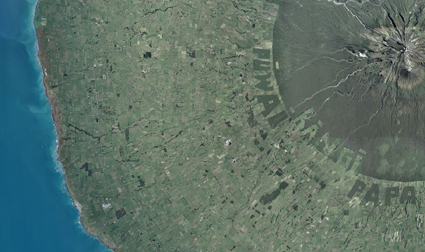
Starrs & Cmielewski, Incompatible Elements at Moving Image Centre, MIC Toi Rerehiko, Auckland
AS GOVERNMENTS RELUCTANTLY ADMIT TO THE EXISTENCE OF A CLIMATE CRISIS BUT DO LITTLE ABOUT IT, MANY MEDIA ARTISTS ARE RESPONDING TO THE EVIDENCE OF THE ECOLOGICAL DISASTER THAT IS CLEARLY ALREADY HAPPENING. JOSEPHINE STARRS AND LEON CMIELEWSKI’S PROJECT INCOMPATIBLE ELEMENTS (2010-2011) PRESENTS THE INTENSE VISUALITY OF REGIONS OF THE ASIA-PACIFIC THAT HAVE BEEN HIT BY EXTREME WEATHER. WHILE HUMAN ACTIVITY IS ABSENT IN THE DIGITAL SATELLITE-SCAPES, THE HUMAN MIGRATION FORCED BY WEATHER EVENTS IS IMPLIED IN THE POETRY, LYRICS AND ORATORY THAT INSCRIBE THE VIDEO WORKS.
The work’s fusion of text and topographical landscape presents a challenge to the separated or incompatible categories of ‘nature,’ ‘environment’ and ‘culture.’ Incompatible Elements was first exhibited at Performance Space in Sydney in 2010 followed by MIC Toi Rerehiko in Auckland in March 2011.
An ‘incompatible element’ is a term in geochemisty used to describe mineral properties in rare earth and in the oil industry. ‘The elements’ also refers to weather forces producing effects that are becoming more and more incompatible with human life. Starrs and Cmielewski tell stories on behalf of future “climate refugees” as part of their ongoing concern with migration stories. They used data maps in earlier work such as the interactive screen-based work Seeker (2008) to reveal the politics of forced migration due to conflict over resources such as diamonds, titanium and oil. Incompatible Elements also recognises the largely unquantified human migration resulting from climate change—of people often seen as incompatible with national immigration policies. As philosopher Bruno Latour urges, the artists recognise that ecological issues include the social, political and cultural as opposed to perpetuating the Modernist ‘human/nature’ divide.
The four video landscapes presented at MIC are composited satellite images of the flooded planes of the Ganges, the former dust bowl of Australia’s Murray-Darling basin, the dry banks of the Coorong in South Australia and the erosion of Mount Taranaki in New Zealand. Accompanying light boxes provide the micrographic complement to the remote satellite pictures as detailed photographs of the dry earth. The artists present the polar extremes of drought and deluge: the predicted and increasingly manifesting extremes of weather-induced disaster in regions of Australasia. By encouraging us to examine their finely stitched topographical images closely in the defamiliarised context, even the normally detached gaze of the Google-Earth browser is politicised.
In Incompatible Elements, the leisurely paced pan of the fly-over satellite map is incrementally modified by lines of text that grow out of features of the landscape itself. After a while, streams or fields become words that slowly creep into the frame, inviting comparison to the relentless anthropogenic expansion across the Earth. The sources of the animated words include the environmentalist poetry of Australian Judith Wright, her line “And the River was Dust” curls out of the Murray-Darling basin’s tributary streams while the lyric “days like these” from the John Lennon song “Nobody told me” emerges from the watery arteries of the Ganges. A phrase in the Ngarringjerri language, “A Living Body,” creeps out of the dusty banks of the Coorong and “Puwai Rangi-Papa,” the words of a Maori elder encircle Mount Taranaki.
Starrs and Cmielewski direct attention to Maori and Aboriginal people and the fate of migrants through their use of their language. The perspective of the satellite drifting through space is often described as an omniscient view of a detached observer, but this perspective is also a familiar way of charting territory in traditional aboriginal cultures. Theorist Lisa Parks notes that Aboriginal people have incorporated “satellite dreaming” into their symbolic narratives of cultural identity in artwork and in independent television programming. Both indigenous citizens and migrants occupy a border zone where they are particularly vulnerable to extreme weather events. Maori are traditionally ‘people of the land’, often living in coastal regions, while migrants living in temporary structures are prone to weather-borne disaster.
For the MIC version of Incompatible Elements Starrs and Cmielewski added a video element to the suite of works called Puwai Rangi-Papa. This phrase was translated for the artists as “waters of the radiant sun and earth mother” by Taranaki kaumatua (elder) Dr Te Huirangi e Waikerepuru. Te Huirangi introduced this term to the artists on their SCANZ digital art residency that began at the Owae marae (meeting house) on the West coast of New Zealand in January 2011. Taranaki locals themselves suggested to the artists that they make a work around the erosion of the dramatic peak of Mount Taranaki. The ‘Fuji’ shaped mountain dominates the geography and weather system of New Zealand’s North Island. Rock fall and erosion have increased since violent storms have intensified on the west coast to the extent that local inhabitants are now threatened with the loss of their homes. Analysing aerial photographs of water and soil shifts on Taranaki and its waterways, scientists estimate that more than 14 million cubic metres of the mountain have collapsed since the late 1990s. Huge rock falls and debris have caused blockages in waterways, along with floods that send more boulders down the river, widening the banks. The soundtrack of Puwai Rangi-Papa includes the tumbling of stones that keeps residents who live on the edge of Taranaki awake at night. In Maori terms the ‘mauri’ (life-force) of the mountain is being eroded by the changing climate along with its iconic physical form.
The video images for Puwai Rangi-Papa are created from four Land Information New Zealand satellite images that are seamlessly brought together. The viewing position tracks around the uncannily perfect circle of the satellite map of the mountain and after several minutes the words “Puwai Rangi-Papa” emerge from the fields around Taranaki’s perimeter. According to the artists, this is nature and culture “collapsing into each other.” Using the ubiquitous format of Google Earth and GPS applications on iPhones and cars that has changed our relationship to maps in only a few years, Starrs and Cmielewski are trying to slow down the way we view this satellite imagery to give pause for reflection on the implications of a landscape transfigured by weather.
Many pakeha (white) artists in Aotearoa-New Zealand avoid the use of Maori concepts as the conceptual underpinnings of their work because of the sensitivity around the appropriateness for citizens who are not tangata whenua (people of the land). However when permission is granted by an elder of the region for a story to be told and te reo (Maori language) to be used, the artists are provided with a place from which to transmit important messages across cultures. If settler cultures can shift from conceiving landscape or weatherscape as inert matter ‘to-be-looked-at’ to living bodies encompassed in Maori terms such as ‘mauri’ then we come closer to ecological reconciliation. Puwai Rangi-Papa could signal an important shift in articulating a reconfigured political ecology where Western environmentalism and indigenous cosmologies might join in restoration and care of the land.
An artwork like Incompatible Elements is not propaganda or politics, yet the artists are unwilling to leave socio-political questions to designated experts. The cumulative effect of Incompatible Elements is not alarmist, rather human responsibility is implicated in the large-scale geo-physical changes to our world that the artists represent. The work encourages reflection on the impact of cumulative weather events that are difficult to conceptualise as statistical data or scientific warnings.
Incompatible Elements, MIC I Toi Rerehiko, Auckland, New Zealand, March 4-25
Australian media arts watchers will be interested to know that “MIC Toi Rerehiko promotes a dynamic and growing culture of interdisciplinary media-arts practice in Auckland and New Zealand, supporting an environment of innovation, in which fusion of art and technology is developed and nurtured. Based in the heart of Auckland, MIC Toi Rerehiko has a new art gallery on Karangahape Road, and a live performance/screening venue at Galatos. We exhibit a continuous program of international and New Zealand artists working across contemporary film, video, digital media, installation, music and live performance.” www.mic.org.nz. Eds.
RealTime issue #104 Aug-Sept 2011 pg. 39
© Janine Randerson; for permission to reproduce apply to realtime@realtimearts.net
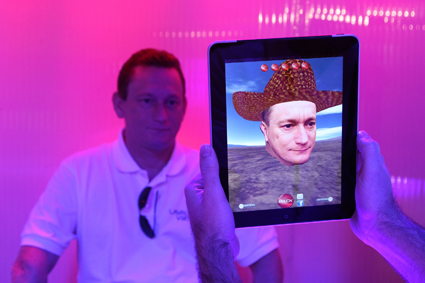
DigitEYEzer, Laval Virtual 2011
photo Jean-Charles
DigitEYEzer, Laval Virtual 2011
THE LAVAL VIRTUAL INTERNATIONAL CONFERENCE AND EXHIBITION ON VIRTUAL REALITY AND CONVERGING TECHNOLOGIES IN FRANCE, IS ONE OF EUROPE’S LARGEST GATHERINGS OF VIRTUAL REALITY AND NEW TECHNOLOGY ENTHUSIASTS. THIS YEAR, OF THE 85 EXHIBITS PRESENTED AROUND 30% WERE FROM PLACES OTHER THAN FRANCE, INCLUDING AFRICA, JAPAN AND NORTH AND SOUTH AMERICA. THIS GLOBAL SPREAD DELIVERED AN ECLECTIC MIX OF INTERNATIONAL AND TRANSNATIONAL EXHIBITS.
I had never been to such an extensive industry convention before, especially one with a dedicated stream on virtual art. Not knowing what to expect, I armed myself with a detailed presentation, designed for those who could not speak English (lots of big images) and one that contextualised the Australian media art scene in more detail than I would present at home.
It was with great surprise then I discovered that all conference delegates had to present and were mostly conversant in English (also my second language) and that Australia’s contribution to media arts internationally was well known and understood by many present at the event.
Setting the context for the conference was renowned media arts theorist Erkki Huhtamo, Professor of Media History and Theory at UCLA. In his keynote titled “Hand Screens, Wrist Watches and iPads: an Archaeology of Wearable Media,” Huthamo asked the numerous artists, technologists and engineers at the conference to reflect for a moment on the history of mobile and immersive media.
This reflection illuminated a fascinating history of wearable and portable media devices, with objects such as pocket watches, cameras and hand-held personal fans seen as precursors to modern day hand-helds. In particular, fans were not only used for cooling, but also as symbols of social status and as print mediums for portable artwork and maps.
With evolving genres such as Device Art (think Bitman by Ryota Kuwakubo and Maywa Denki, 1998), this convergence of technology, art and design can be seen as an extension of those historical origins of portable media. By understanding the origins and symbolic meanings of these devices, Huhtamo suggested, contemporary artists and technologists are in a much better position to tap into their cultural legacy, and therefore be more successful in deploying them artistically and commercially.
Commercialisation was certainly the main driver for most exhibitors at Laval. The three projects I look at in this article—IFace 3D, Haption Exoskeleton and Invoked Computing—were all commercial with no particular focus on media arts, but like many of the exhibitors at Laval, were keen to harness the creative energy of users, including artists, for their inventions.
iface 3D— digitizer (france)
DigitEYEzer exhibited their recently released smartphone application iFace 3D, the first 3D face scanner available for mobile phones. With iFace 3D, users create 3D, lifelike models of themselves or their friends or anything close at hand, by shooting moving images on their phones and sending them to a 3D reconstruction server online. After a few minutes the user is then sent back the 3D model, ready for printing or publishing on the net. These 3D representations can be downloaded into virtual games or sculpted into physical 3D models with 3D printers. Staff at the booth displayed an arresting 3D generated, colour sculpture of their Sales and Marketing Manager, Didier Sy-Cholet, something that’s possible for all users to do once they have their own scanned data (and access to a 3D printer).
The interest in photo-realistic self-representation in virtual games and social media is certainly there, so it will be interesting to see how artistic engagement with this application evolves. I wonder for instance, how Australian augmented reality projects such as Warren Armstrong’s (Un)seen Sculptures (2011) or Thea Bauman’s Digital Culture Fund project Metaverse Makeovers (2011) might engage audiences with these new tools in times to come.
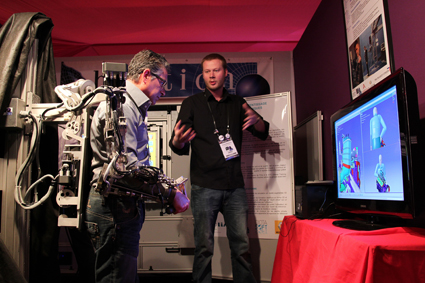
Haption, Exoskeleton Demonstration Booth, Laval Virtual 2011
photo Jean-Charles
Haption, Exoskeleton Demonstration Booth, Laval Virtual 2011
haption exoskeleton (france)
Haption’s force-feedback exoskeleton was one of the more intriguing exhibits to play with at Laval. Established in 2001, the company develops high performance haptic [touch-based] instruments and programs involving force-feedback in virtual reality, for both industrial and academic purposes.
Stepping into the exoskeleton at the booth, I felt a bit like Ellen Ripley from Aliens (without the sweat and the attitude), but instead of killing an acid-spitting critter, I had to put a virtual peg in a virtual hole.
The feedback system in the exoskeleton was fantastic, as it provided force-feedback on all six degrees of freedom (translations and rotations), which is essential for a realistic interaction with 3D objects. I was so mesmerised by the actual physical feedback that I never got the peg near the hole.
In terms of haptic feedback systems and Australian arts practice, I could imagine artists such as Keith Armstrong (Intimate Transactions, 2008), Jonathan Duckworth (Embracelet, 2007), Margie Medlin (Personal Space, 2007) or Stelarc (Exoskeleton, 1998) having great fun exploring the force-feedback systems linked to virtual space.
A recent haptic focused ARC Linkage grant supported by the Australia Council, bringing together artist Paul Brown, Dr Ben Horan from Deakin University’s School of Engineering and Saeid Nahavandi, Director of Deakin’s Centre for Intelligent Systems Research, could also be situated in this context. The three-year grant aims to help visually challenged people ‘see’ artworks through haptic vibrations; force-feedback systems such as these could add a dynamic new dimension to future projects.
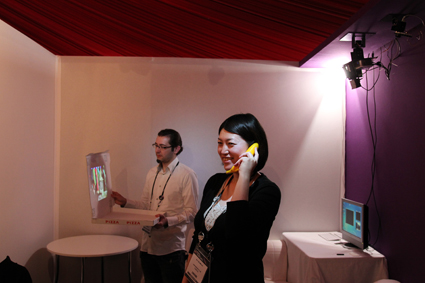
nvoked Computing, Laval Virtual 2011
photo Jean-Charles
nvoked Computing, Laval Virtual 2011
invoked computing (japan)
One of the most innovative and, to my mind, potentially game-changing projects to emerge at Laval this year was Invoked Computing. Developed by Alexis Zerroug (France/Japan), Alvaro Cassinelli (Uruguay/France/Japan) and Masatoshi Ishikawa (Japan) through the Ishikawa Komuro Laboratory at the University of Tokyo, the project explores a “ubiquitous intelligence” capable of recognising specific human actions and projecting sound and images onto objects linked to these actions.
The example shown at Laval involved taking a banana and bringing it closer to the ear, with the gesture triggering directional microphones and parametric speakers hidden in the room. These devices then made the banana function like a phone. Not only would the banana ring, but you could talk using the banana as a handset. The developers also used a pizza box with projected images that could follow the box around in space.
The potential for these tools in performance and installation based work is mindboggling. Imagine having any object in a space able to project sound or images and interact with those around it. What could PVI Collective (Transumer, 2010) do with this technology if they deployed it in public spaces? Or Back To Back Theatre (Small Metal Objects, 2005) with accidental audiences at train stations?
Not surprisingly Invoked Computing received the Grand Prix du Jury for Laval 2011.
australian developments
In Australia there is huge scope for artists working in virtual reality and converging technologies to continue their internationally recognised practice. Recently, with funding through the Digital Culture Fund, some fantastic live, digital projects were realised with work such as the Roller Derby extravaganza Bloodbath by Bump Projects (2010; RT100) and Adriaan Stellingwerff’s Windy and Winding (2010), a virtual balloon travel application for smartphones.
In September this year at ISEA in Istanbul, the Australian Centre for Virtual Arts is curating a major program of Australian virtual artists, titled Terra Virtualis. In addition, an Australian exhibition on robotics curated by Kathy Cleland and an exhibition titled The World is everything that is the case, curated by Sean Cubitt, Vince Dziekan and Paul Thomas will also be flying the flag.
But the most significant development for experimental art in Australian in 2011 is the recently announced Creative Australia fund, a $10 million initiative from the Federal Government.
This funding is targeted to support individual artists through the creation and presentation of significant new work and fellowships and will be rolled out by the Australia Council over the next five years.
All the Council’s artform boards will be delivering on this initiative, with the knowledge that digital culture and the potential of the national broadband network will no doubt be key considerations of many applications. We are all looking forward to seeing the outcomes of such a significant investment in contemporary Australian arts practice.
RealTime issue #104 Aug-Sept 2011 pg. 41
© Ricardo Peach; for permission to reproduce apply to realtime@realtimearts.net
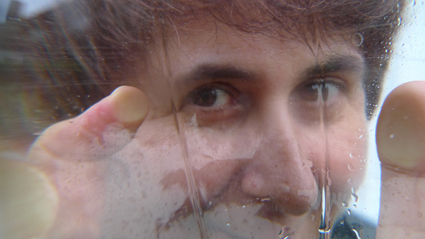
Suzon Fuks
photo Liz Scrimgeour
Suzon Fuks
SUZON FUKS IS A BRISBANE-BASED MEDIA ARTIST, CHOREOGRAPHER AND DIRECTOR WHO EXPLORES THE INTEGRATION AND INTERACTION OF DANCE AND MOVING IMAGE THROUGH PERFORMANCE, SCREEN, INSTALLATION AND ONLINE WORK. SHE IS CURRENTLY AN AUSTRALIA COUNCIL FOR THE ARTS FELLOWSHIP RECIPIENT. FUKS DESCRIBES HER NEW WORK, WATERWHEEL, AS “AN ONLINE SPACE WHERE YOU CAN INTERACT, SHARE, PERFORM AND DEBATE ABOUT WATER AS A TOPIC AND METAPHOR, WITH PEOPLE AROUND THE WORLD OR RIGHT NEXT DOOR! IT IS COST-FREE, ACCESSIBLE WITH JUST A CLICK, AND OPEN TO EVERYONE OF ALL AGES. IT FOSTERS CREATIVITY, COLLABORATION AND INTER-CULTURAL-GENERATIONAL EXCHANGE.” I ASKED FUKS ABOUT HER MOTIVATION AND AMBITIONS FOR THE WORK.
What is it about water that drove you to create Waterwheel?
I come from a country in Europe where it rains a lot and I wasn’t aware of water scarcity at all. Living in India for three years changed my perception about access to water. I had to wake up on time to fill my vessels from a tap in the street that ran only twice a day for half an hour. I had to boil it and keep it in a specific place in the house. So I built my life and time around this access to water.
When I moved to Brisbane it was a beautiful ‘garden city.’ During the drought of 2005 I worked most of the year overseas and coming back, I could see from the plane window everything was brown. Sad! It looked like a dying body. At that time I went for a walk at Wivenhoe Dam. A very striking image remains in my mind. A dried out fish caught in a small bush on the edge of the reservoir. The water level had gone down so much that the fish had been caught there, died and dried out.
I became more interested in the politics of water. I started questioning how in developed countries we have access to things and information and take so much for granted. Water is becoming a commodity. I observed that most water infrastructures are made by men, but in developing countries the collection and handling of water is usually a matter for women.
In 2008 I helped organise a networked performance with five cities around the world. We were talking about the drought in Brisbane and a group of artists in Curitiba were saying that in Brazil governments are fighting over the Guarani, one of the world’s biggest and most abundant aquifers, to own part of it for the future. It was interesting for me to see that, through the internet, people can share different perspectives on water.I’d like to share this growing awareness, and find ways to deal with water issues.
In what ways do you see water as a tangible element of your art?
Artistically, I’m interested in the contrasts and extremes of water: transparency, opacity, stillness, turbulence, the violence of water and its patterns. To me, the patterns in water hold secrets. Things are entangled there: the fluidity, stripes and rhythms make links between graphic, choreographic, musical and cinematic forms. If we could decode the patterns, we could find a writing somehow and an understanding between these disciplines.
I’m constantly collecting water samples in video and audio. With Igneous I have done two shows with actual water: Liquid Skin and Mirage (both in 2006). And before that, in 2004, Thanatonauts and Body In Question, used water in their video-scenography. I know that artists have been using water for a long time and the interest is increasing. It seems to me like a requiem for water. Before it dies.
In my memory, public water had a different presence in cities than it does now. Fountains were places of social gathering and where to get fresh water when walking from place to place. Now they are being covered. All that is left are signs saying: there once was a spring. So I thought it would be interesting to have a repository, not only of artistic works but about water in general, in order to keep a trace of our stories, cosmogonies and lifestyles, because water, cultures and cities are changing.
Did Queensland’s recent flooding influence the work?
The flood felt like a state of war. There was nothing that could be done to stop it, and it was violent. Water is not always transparent, reflecting the blue sky, but can be really dirty, smelly and sticky. The mainstream media were really making people scared, repeatedly showing the most dramatic images and playing the most dramatic commentary. Meanwhile, on social media people were infiltrating like water, in a constructive way, giving helpful tips. The water issue made discussions deeper.
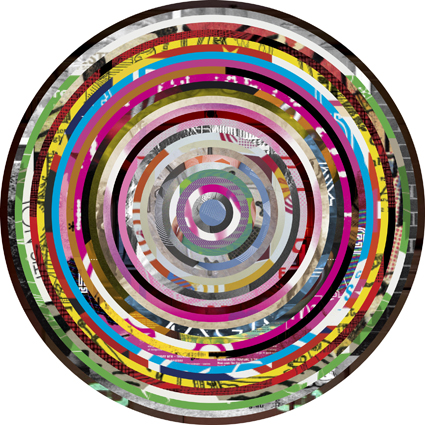
Waterwheel interface
Are you a ‘water person’?
Definitely. I’m not an excellent swimmer, but I go swimming every day if I can. It’s my way of keeping fit. I find baths and water spaces relaxing and rejuvenating. When visiting a new country, I’m interested to know about water rituals and customs, and which places they have for them. It’s a way for me to better understand the place and meet people.
What can we expect when we enter the Waterwheel site?
The main thing on the Waterwheel homepage is a wheel made up of concentric rings that represents the latest 40 uploads. Anyone can log-in and upload, access and comment on that media, and message other users. From there they can go to the “Fountains” map and the “Tap.”
Users, individually or with a “Crew,” can use the Tap for a performance or presentation with webcams, media from Waterwheel, drawing tools and text chat, all on one web page. What’s very new is that any media item placed on the Tap can be moved, resized, flipped and layered over other media. Audience can engage with each other and the Crew by simply clicking on a link without having to install anything. Years of research in networked performance allowed me to see the pros and cons of, and determine the best tools, from those I found in various online platforms I used.
There are many levels on which to engage with the site and the project. Whether you’re initiating a project individually or collaborating with others or contributing to an existing one or simply spectating. A curator could get in contact with an artist, or scientists and activists in contact with their colleagues. It’s a new mode for expression, exhibition or festival.
Who are you working with on Waterwheel?
In the first year of my Australia Council fellowship I presented the Waterwheel concept in various circumstances, conferences and in sharing sessions with peers and colleagues onsite and online. I got lots of feedback, which helped to evolve the concept and I received grants from Arts Queensland and Brisbane City Council to extend the project and the team.
Waterwheel is a really collaborative project. My main partner in building up the site is Inkahoots, a Brisbane-based studio of graphic designers, programmers and a copywriter. Artists around the world are helping with the testing of the Tap. In terms of getting feedback in order to advance the project, I asked a forum of peers to come at certain times to give oral as well as written responses.
My co-artistic director of Igneous, James Cunningham, is an external eye for the experimentation on the Tap and its integration into an on-site installation performance that will happen during residencies in October and December at the Judith Wright Centre. For that event there is an entire team: dramaturg (Doug Leonard), performer (Sofia Woods), set designer (Rozina Suliman), interactive system designer (Nathen Street), production manager/lighting designer (Felicity Organ-Moore), IT technician (Will Davis), PR person and someone taking on a new role linking ‘crew’ members online and onsite.
I’ve been networking for a long time and via the internet with fellow performers in Canada, USA, Brazil, Europe, Lebanon, Indonesia, India, New Zealand and South America. For the launch of Waterwheel on August 22, I hope that this network will present a short program of performances and presentations.
You have written that water will also be metaphorical in the work: In what way?
I tried to make the whole Waterwheel project using water vocabulary because of the theme and the parallel between this vocabulary and the Internet. The words waterwheel, fountain, tap, crew, dock also give an idea to people, to the audience, of how to use the site. Users can also take a metaphorical interpretation of water for the content of the media they upload—like a dance inspired by water’s qualities or a video of sand rippling down dunes like liquid.
Above all what do you hope to achieve with Waterwheel?
I hope to raise awareness about water issues and works, that people will generate new avenues, new works and new ways of presenting and performing, finding their own style within the venue and the tools that Waterwheel offers. I’d like the project to foster sharing and creativity, cross-cultural conversation, intergenerational exchange and debate and help people who have controversial projects, ideas, or are in conflict, to make issues more public and facilitate decision-making and practical action.
How do you feel about living so intensively with a work about water?
Every day I see the relation and relevance with the work and what is happening in the world. Like the transformative aspect of water I am trying to be open and flexible and adjusting to what is happening. It’s intense because it has lots of different aspects, it’s beautiful and sometimes it’s really terrible. The tsunami in Japan and the aftermath of the Fukushima nuclear meltdown has affected my way of apprehending the world. Knowing that we are not reaching the tipping-point but are totally in it is terrifying, but at the same time, interesting to see how we can react to that in a human and positive way.
Waterwheel: http://water-wheel.net/, launching August 22. Deadline for proposals for launch August 12
RealTime issue #104 Aug-Sept 2011 pg. 42
© Keith Gallasch; for permission to reproduce apply to realtime@realtimearts.net
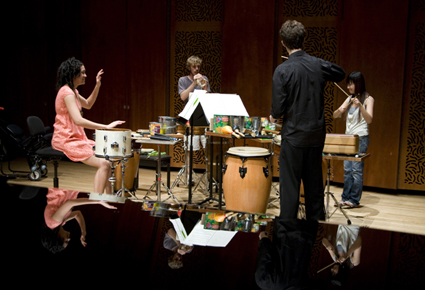
Percussion students, Queensland Conservatorium Griffith University
SENIOR LECTURER AT THE UNIVERSITY OF MELBOURNE LINDA KOUVARAS REMEMBERS “A RATHER LEAN COUPLE OF DECADES” WHERE BOOKS ON CONTEMPORARY MUSIC IN AUSTRALIA WERE THIN ON THE GROUND. A RESURGENCE OF INTEREST HAS RECENTLY GRACED LIBRARY SHELVES WITH BOOKS BY DAVID BENNETT (SOUNDING POSTMODERNISM, AUSTRALIAN MUSIC CENTRE, 2008), GORDON KERRY (NEW CLASSICAL MUSIC, UNSW, 2009), GAIL PRIEST (EXPERIMENTAL MUSIC, UNSW PRESS, 2009) AND SALLY MACARTHUR (TOWARDS A TWENTY-FIRST-CENTURY FEMINIST POLITICS OF MUSIC, ASHGATE, 2010), WITH WORKS BY OTHER AUTHORS PROJECTED FOR THE NEAR FUTURE.
Though many of those interviewed for this RealTime arts education edition identified a now healthier music book publishing industry, the same was not said of critical writing in journals, magazines and newspapers. The perceived critical vacuum in Australian musical life is seen to negatively impact on the teaching of Australian music in tertiary courses, the vibrancy of Australian musical cultures and students’ preparedness for their careers.
a critical deficit
Executive Director of Performing Arts at Monash University Peter Tregear explains how critical writing feeds into teaching: “As a teacher you don’t just want to show that music exists, you want to show how it exists in context. You want to show students a score, a recording and responses to the music.”
It is not just in the classroom that this scarcity of music writing is felt, but in the lives of practising musicians and sound artists. “Art-making thrives on verbal reflection and magazines/journals provide an essential forum for this,” Kouvaras asserts. Griffith University Lecturer Vanessa Tomlinson believes the value of critical reflection extends from local scenes to the wider musical world, warning of global negligence in the state of Australian music writing.
Forums do exist for critical writing on music in Australia, though a plurality of voices is needed as part of a reflective musical culture. Senior Lecturer at the University of Adelaide Stephen Whittington regards RealTime as “the only forum for serious critical discussion of contemporary music in Australia,” while Tomlinson regards it as “one of only a few places where people can actually critically engage with an artform.” With a focus on jazz and improvised music, Extempore initially appeared in five print editions providing reviews and feature articles. Material is still published online (www.extempore.com.au), but its print presence will be an annual print anthology from 2012, according to its website. The Music Council of Australia’s quarterly magazine Music Forum publishes album reviews and longer pieces, particularly about music education (www.musicforum.org.au). The Australian Music Centre publishes news, articles and reviews in its online magazine Resonate (www.australianmusiccentre.com.au/resonate) and its bi-annual Resonate Journal. Despite the efforts of these platforms, much of the responsibility for publishing concert reviews still falls on newspapers, something that, according to Tomlinson, they “are not doing in any way, shape or form.”
Newspapers publish both reviews and features on music, though they are rarely sufficiently in-depth to include in a tertiary reader. A comprehensive review would follow a piece through a performance, the musical life of a country and the history of Western art music, with an ear to its otherness within these very categories. This is a tall order, but it is also a formula Tregear reads behind the success of The New Yorker’s Alex Ross. “You can see how his articles easily spin out into books. Can you imagine a book of Clive O’Connell’s reviews [for The Age]?” he quips, before qualifying: “Now reviewers will say that the papers don’t give them the space to publish more in-depth reviews, and this is true, but it is a vicious circle. The paper thinks music is marginal and irrelevant and [reviewers] write as though it is marginal and irrelevant.”
Public disinterest in art music also forms part of this circle. Whittington, who writes for Adelaide’s The Advertiser, notes that “even when you do write something controversial, as I do from time to time, it is difficult to elicit a response [from readers].”
While the length of columns on the internet is not an issue, the lack of financial incentive and the disparate nature of the blogosphere may explain why this medium is yet to reinvigorate public musical opinion. Tomlinson points out the vast incongruity between the rhetoric of the information age and the dearth of public reflection about music in Australia, a phenomenon that may be explained by Whittington’s remark that cultural flows over the internet tend to be circular. We then have to look to the leadership of publishers, broadcasters, concert organisers and educators to break the cultural deadlock. Amongst concert organisers and broadcasters there have been some promising signs: ABC Classic FM’s continuing commitment to contemporary Australian classical composers and concerts, the East Coast’s growing New Music Network and Perth’s Tura Music, building audiences and helping with the challenges of touring. Educators also acknowledge a commitment to broadening students’ worldviews, striking various balances between local and global content.
ensuring a global perspective
Andy Arthurs, Professor at Queensland University of Technology, agrees that tertiary courses should broaden students’ cultural frames of reference “so you are not following your own little bread crumb route to wherever you want to go next.” Coupled with the melting pot of a campus environment, online media enhances students’ understanding of their global context, of which Australian music forms only a part. “Sometimes the most interesting things happening in the world will be happening in Australia,” Whittington claims. “Sometimes they will be in Shanghai or Sao Paolo.” Likewise, Arthurs finds the distinction between the local and the global to be of little relevance to the contemporary working musician: “I had a conversation a few years ago with some colleagues in Malmö in Sweden and it became apparent that they didn’t really talk about Swedish music. They said ‘we just make music and hope that the rest of the world likes it.’ A little less introspection would probably be a good thing.”
providing local context
Though a global perspective is essential for any aspiring musician, contemporary Australian composers are held up as role models for having locally negotiated similar professional and cultural terrain. Arthurs will teach about relatively younger composers such as Robert Davidson and Matthew Hindson. Tregear believes Elena Kats-Chernin “relates to contemporary culture in a way that hard-edged Australian versions of Darmstadt stuff from the 1960s and 70s didn’t then and certainly don’t now.” Likewise, Whittington will “only very occasionally refer to the older generation, Richard Meale or Peter Sculthorpe,” instead teaching about “composers of [the students’] own generation—like Damien Ricketson and Matthew Shlomowitz.” [Ricketson is currently a lecturer in composition at the Sydney Conservatorium of Music and directs Ensemble Offspring whose recent concert, featuring a piece by Matthew Shlomowitz, is reviewed here, Eds.]
The Australian Music Centre is generally accepted to be an indispensable resource for accessing the music of past and present Australian composers. Tomlinson, a former professional associate of the AMC, understands that “whenever there is an agreed upon dearth of information [the AMC] is generally proactive in producing resources.” With an increasing amount of material available online through the AMC (www.australianmusiccentre.com.au) and the Australian Sound Design Project (www.sounddesign.unimelb.edu.au), and over 17 years of critical material available through the RealTime archive since 1994 (accessible online 2001-present), there has never been a better time to bring contemporary Australian music into lecture halls. Often the resource is standing right in front of the students in the form of the lecturer. All interviewees advocated teachers bringing their creative practice into the classroom, including their passion as scholars and critics.
no practising in the lecture hall
The common requirement for teachers at universities to have PhDs can deprive students of the valuable experience of being taught by a practising musician, argues Arthurs. He claims that if he wrote down 50 of the most interesting musicians in Australia, few of them would be in universities. Snug inside the academy, a professional environment hostile to expensive one-on-one music tuition and proselytising teachers does not promise an edifying educational experience.
To Alistair Noble, Associate Dean in the College of Arts and Social Sciences at the Australian National University, a university culture that devalues pedagogical traditions, including the relationship between instrumental or composition teachers and students regardless of professional qualifications, threatens the quality of both musical and general arts education. “One of the major influences on my thinking was not even in the music department,” Noble reminisces from his armchair, “but was a medieval studies lecturer. It was in those medieval studies classes that I saw first hand what a political engagement could mean in terms of academic study. I remember in that class having guest lecturers from Oxford or Cambridge or somewhere, these die-hard Marxists talking about Byzantine farming methods. There is definitely an attitude now that the idea of passing on a tradition is inappropriate. It does happen, but one isn’t very vocal about it.” Whether helped or hindered by an institution, students will seek out collaborators, mentors and role models wherever they can find them, resulting in ephemeral live music scenes.
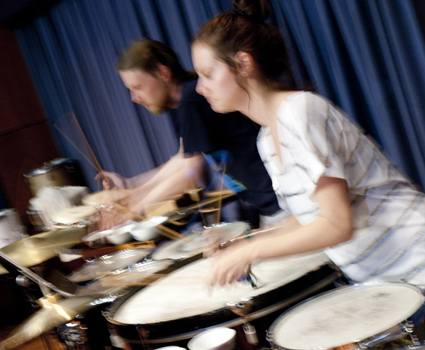
Percussion students, Queensland Conservatorium Griffith University
from the local to the global
Outside the lecture hall, or contiguous with it if institutions are functioning properly, students find their musical identity through a complex interplay of local and global influences. In Brisbane, Vanessa Tomlinson finds that “students are most influenced by what they see in the city around them. At the moment that would mean Joel Stern, Lawrence English, Topology, my own work with Clocked Out, and the Viney-Grinberg duo. They are most interested in what they hear live.”
Just as they engage with their immediate surroundings, students will consider themselves in relation to global musical trends. Tomlinson also identifies “probably about three groups of young composers who are working really hard to establish their musical identities in Brisbane and contextualise that within a historical framework—be it European Modernism or contemporary New York minimalism.” Arthurs reinforces this interplay between the local and the global: “musicians in Brisbane, generally, do not interact much with musicians from Sydney or Melbourne. They do need to contextualise their practice, but they do that in relation to music from New York or Hamburg just as well as they could with Perth or Melbourne.”
writing yourself into a music career
In professionally navigating local and global boundaries, critical literacy is again vital. Vanessa Tomlinson explains that “because we have this fairly strong funding system, compared to the US and Asia, but not Europe, a lot of the responsibility for getting music out there falls on the musicians themselves. You have to publicise your gig, get it online, you virtually have to do your own critical writing. This is one of the big responsibilities of education, to train up critical thinkers so that we can have more independent, freelance writing…It is easy to slip into an educational system that is purely skill-based, that makes performers and sends them out into the world. The world is not there to receive them. So critical thinking is not just about reading obscure philosophical texts, it is also about understanding how to engage with the world. The question is ‘how does and can art function in the world in relation to other art forms, philosophy or ecology?’”
With books and online resources on Australian music growing in number, the paucity of music criticism currently stands out as one of the greatest hindrances to the inclusion of Australian works in music education. Critical writing provides vital teaching material, forming a bridge between the ‘outside’ world and the academy. It is the glue of otherwise disparate and alienated music scenes. It should be part of the professional toolbox of every musician, ready to deconstruct their detractors and justify their own glorious existence.
RealTime issue #104 Aug-Sept 2011 pg. 43
© Matthew Lorenzon; for permission to reproduce apply to realtime@realtimearts.net
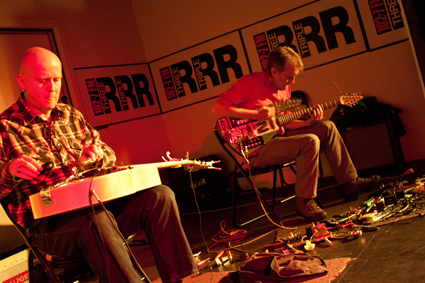
Dave Brown and Lukas Simonis, Liquid Architecture
photo Sebastian Avila
Dave Brown and Lukas Simonis, Liquid Architecture
THE SMALL 3RRR PERFORMANCE SPACE IS AT ONCE A BROADCASTING STUDIO, A CONCERT HALL AND AN INSTALLATION SITE. EACH FUNCTION ENTRAINS A DIFFERENT SET OF CONVENTIONS AFFECTING THE WAY AUDIENCES APPROACH THE MUSIC AND SOUND ART PRESENTED THERE. THROUGH DAVID CHESWORTH’S OCEANOGRAPHY/PERON STATION INSTALLATION AND THE LIQUID ARCHITECTURE CLOSING CONCERT, EACH OF THESE SETS OF CONVENTIONS WERE CHALLENGED BY A PROGRAM THAT ASKED “WHO’S AFRAID OF LAUGHING?,” “WHO’S AFRAID OF THE DARK?” AND, FINALLY, “WHO’S AFRAID OF LISTENING?”
For the Oceanography/Peron Station installation, Chesworth moved away from the large-scale site-specific installations of his and Sonia Lieber’s Wax Sound Media to produce an intimate listening environment in the 3RRR performance space. The dim room invited the audience to apprehend the eight-channel works acousmatically, or on their sonic merit. The striking juxtaposition of synthesised and field-recorded sonic environment provided the listener with a fresh auditory perspective on both sound sets while provoking their curiosity about the works’ extra-musical associations.
Oceanography is an almost completely synthesised soundscape that Chesworth describes as suggesting an “underwater eco-system.” High, diatonic tones shimmer above humming chordal currents, frissons of static, pealing motifs and a sound like a squeaky shopping trolley (an object common to many marine environments). The characteristically dream-like timbral palette and steady but understated pulse, similar to Sigur Ros’ 2004 work Ba Ba Ti Ki Di Do for Merce Cunningham’s dance piece Split Sides, gave the work a theatrical quality well beyond bean-bag- bound listeners’ immediate surroundings.
After the synthesised sounds of Oceanography, the strictly field-recorded bird and insect calls of Peron Station sounded strikingly artificial. The call of the Chiming Wedge-Bill resembles the metallic tinkling of digital artifact in a badly encoded MP3. The White-Winged Fairywren twitters like a tiny super-charged Leslie speaker. Beetle stridulations coalesce in what sounds like a granulated shopping cart. Only the recordings of blowholes and the odd crow betrayed the natural origin of their unearthly sounds.
The installation works developed an engrossing sonic dialogue, although the empty stage and lonely piano pushed against a wall were reminders of the kind of show you were not attending. The performative element of sound art formed the subtext of the Liquid Architecture concert featuring James Rushford and Joe Talia, Lukas Simonis and Dave Brown, Pascal Battus and Marc Behrens.
Paris-based sound artist Pascal Battus explored the sounding properties of styrofoam trays, cassette deck motors, foil, cardboard, plastic cups and other everyday materials in an intimate table-top setting. Battus’ brow knotted in earnest concentration as he strove to find the sweet spot of each object. Sometimes the truly experimental procedure of grinding a piece of acetate against a spinning disc would open up unexpected and remarkable sonic terrain. At other times a muted flatulence would announce the disagreement of two objects coerced into sonic co-operation. The suspense, surprise or disappointment of each experiment was intensely comic, the latter submitted to with a small, decisive nod by the sonic researcher.
Marc Behrens lent a satirical air to his quadraphonic diffusion of characteristic industrial sounds including doors, chains and static. Dressed in a long grey coat with his face aglow from his red laptop screen, Behrens variously stood on, leant against, or lay upon the stool that most laptop performers would slump down on for a performance’s duration. Behrens triggered samples with heroic gestures and concluded the performance with four stiff bows to the audience, who were garishly lit by two red spotlights from under Behrens’ musical pulpit.
While sound artists must be aware of their own performance conventions, I would not want them to sidestep their obligation to provide interesting sounds. As Chesworth’s installation demonstrated, much of the interest of a sound lies not only in its isolated presentation and performative contextualisation, but in its relationship to other sounds. With the exception of certain thin textures consisting of two squealing pieces of styrofoam, Battus’ series of sonic experiments did not provide a sense of the interconnectedness. Despite their brilliant, high fidelity amplification, Behrens’ industrial sounds did not move beyond their own stereotype. Dave Brown and Lukas Simonis’ prepared guitar improvisation set, on the other hand, displayed an almost furious attention to soundscape construction, at least in the short-term interactions of the two guitarists with their armoury of kitchen utensils. Using a pre-recorded tape recording as a compositional tool, Rushford and Talia’s set presented longer-range, episodic changes in texture.
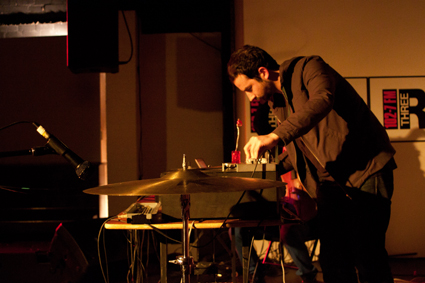
Joe Talia, Liquid Architecture
photo Sebastian Avila
Joe Talia, Liquid Architecture
Though their concert blacks and almost complete lack of lighting initially seemed out of place in a concert exploring the expanded possibilities of concert performance, Rushford and Talia’s subdued presentation resonated with their tense, horror-themed set. A reel-to-reel tape with foley effects and snatches of dialogue from The Evil Dead II provided the underlying structure of the performance. Rushford’s extended viola techniques and Talia’s processed ride cymbal contributed timbral washes and insidious scratching sounds between gasps and creaking doors. Sometimes the texture reduced to a deep rumble, while at other times careening, echoing tones from the viola produced an ear-splitting cacophony. Sometimes, long moments of silence passed in horror-movie suspense, punctuated by a breathy voice asking “are you all right?”
This question seemed to probe the discomfort we can have about unexpected silence in a performance situation, particularly when there is little to look at. What one usually realises, in the awkwardness of the moment, is not the fullness of Cagean silence, but that silence is profoundly changed in relation to the sounds that precede it. This is particularly evident in radio, where the relationship between sound and silence is even more carefully orchestrated than in a concert setting. For instance, as the Rushford/Talia set was broadcast on 3RRR, we were asked to make some crowd noise when the performance space became live. The “on air” sign was greeted with cheers, before which everyone was sitting quietly, conversing in hushed whispers. The sudden intrusion of ‘crowd noise’ in an almost pitch black performance space was absurd, just as a few coughs and creaking seats would have seemed out of place on a ‘live’ radio broadcast.
It is because of the mutual influence of silence and sound, rather than in spite of it, that the presentation of sound art needs to be taken into consideration. The darkness of an acousmatic performance, such as David Chesworth’s installation or Rushford and Talia’s set, encourages the audience’s focus on the reciprocity between sounds, while any visual element is capable of changing the listener’s experience of that relationship, such as Battus’ focused gaze as he tries—and fails—to bring a tin cup and a small motor into consonance.
Liquid Architecture 12, Festival of Sound Arts, Oceanography and Peron Station, composer David Chesworth, 3RRR, June 27-29; concert, Marc Behrens, Pascal Battus, Lukas Simonis, Dave Brown, James Rushford and Joe Talia, 3RRR, Melbourne, June 30
RealTime issue #104 Aug-Sept 2011 pg. 44
© Matthew Lorenzon; for permission to reproduce apply to realtime@realtimearts.net
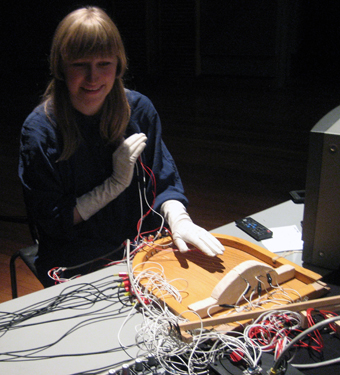
Pia van Gelder, Liquid Architecture
photo Somaya Langley
Pia van Gelder, Liquid Architecture
FOR THE LAST TWO YEARS, THE SYDNEY LEG OF LIQUID ARCHITECTURE HAS BEEN PRODUCED IN ASSOCIATION WITH ABC CLASSIC FM WITH ONE OR TWO CONCERTS BROADCAST THAT SAME NIGHT ON NEW MUSIC UP LATE. THE BROADCAST ASPECT SETS A CHALLENGE: HOW TO SATISFY BOTH CONCERT AUDIENCE AND HOME LISTENER. CURIOUSLY, THE ARTISTS PROGRAMMED IN CONCERT 2 ALL USED STRONG VISUAL ELEMENTS IN THEIR PERFORMANCES.
Pia van Gelder is very handy with a soldering iron, creating a variety of homemade electronic instruments—her audio-visual harp in this performance resembles a harp in shape only. Van Gelder dons white gloves with wired up electrical circuits in the fingertips. As she touches a combination of ‘strings’ or electrical componentry an audio signal is converted into a video signal. The resulting sound is a familiar dark buzz and hum with sharp on/offs, deep drones and rude eructations: electricity doing what it does when it’s being interfered with. The visuals range between bands of static-filled colour reminiscent of liquorice all-sorts and a kind of baroque wallpaper. While the audio element was engaging, it was a symbiotic composition—the radio listeners missed out on a vital aspect.
Marc Behrens’ piece was perhaps a better experience for the remote listener than for the live audience. In response to the oft-heard criticism that playing music from a laptop is not performative, Behrens augments his surround-sound set with a series of overly dramatic gestures and actions including some inexplicable play with a stool, none of which have any clear relationship to the sound being made. Whether they are in earnest or parody is also ambiguous. I asked Behrens about his performance and he said that he is inspired by the renowned Italian designer Bruno Munari’s explorations into interactive sculpture and the composer and intermedia artist Jerry Hunt. The reality however is that Behrens’ actions do not appear integral to his soundmaking, seeming rather like an unnecessary and distracting decoration. If performative provocation is the intention that’s fine, but surely listening is the point here? The audio I could focus on was finely detailed and dramatically spatialised.
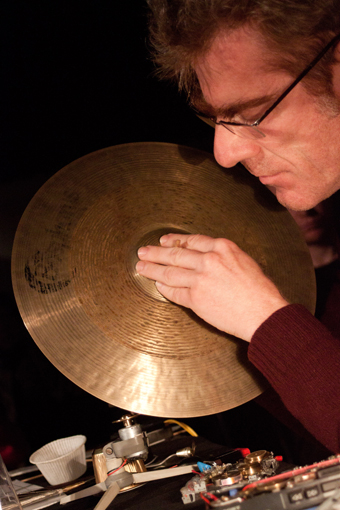
Pascal Battus, Liquid Architecture
photo Sebastian Avila
Pascal Battus, Liquid Architecture
Pascal Battus is more shaman than showman, extracting the essences of sound from a range of materials applied to the spinning gizzards of old Walkmans. The results are rewarding for the deep listener as each object is coaxed to emit its own subtle combination of rings, brrrrs and fricatives. Battus’ concentration is fascinating, like a watchmaker working in fine detail; however, having but two hands he can only make a maximum of two sound gestures at a time. Consequently, his piece becomes a series of similarly composed sonic moments as he works methodically through all the objects on his table. While the detail of each sound set would have been engaging, I am curious as to how the homogenous episodic structure held for radio listeners. However the final cymbal grinding with a dazzling array of harmonics was well worth waiting for.
Battus also presented a series of one-on-one ‘sound massages’ the following day. With eyes closed you sit opposite the artist while he performs a mini concert around your head: tiny scrapes, crackles and rustles define a complex sphere of listening. The manipulation of spatialisation is amazing, resulting in a feeling of deep intimacy with both Battus and the sounds themselves. It’s so simple yet so incredible I don’t know why we don’t do it all the time!
The sound massage was a little taster of a more innovative way of engaging with focused listening than the concert for radio format and made me crave more. In its current mode, Liquid Architecture in Sydney does seem to lack an engagement with, or support from, the local experimental scene. Perhaps this is due to its contracted size which limits local involvement and/or choice of venue: the exposure offered by ABC Classic FM is significant, but it seems audiences are not so keen on the live recording format and the formal setting of Eugene Goossens Hall, despite its great sound potential. Maybe Liquid Architecture is what it is—a touring concert (or two) but it’s hard not to long for an expanded program with associated events across a range of spaces (which I acknowledge means time, money and people’s energies). It will be interesting to see how the thematic focus of Liquid Architecture 13, Antarctic Convergence, curated by Philip Samartzis and Lawrence English, will shape next year’s event.
Liquid Architecture 12 Sydney, Concert 2, Pia van Gelder, Pascal Battus, Marc Behrens, Eugene Goossens Hall, ABC Ultimo Centre, July 2; Sound Massage, Pascal Battus, Bon Marche Building, UTS, July 3; national artistic director Nat Bates, Sydney co-producers Thomas Knox Arnold and ABC Classic FM; www.liquidarchitecture.org.au
RealTime issue #104 Aug-Sept 2011 pg. 45
© Gail Priest; for permission to reproduce apply to realtime@realtimearts.net
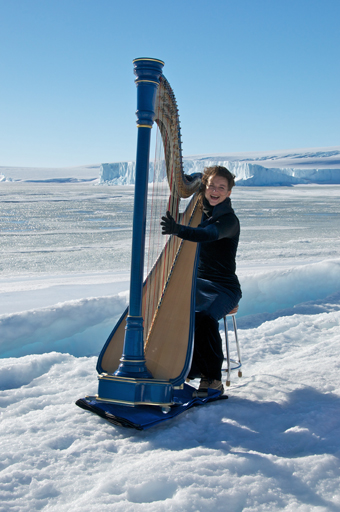
Alice Giles in Antarctica
photo courtesy the artist
Alice Giles in Antarctica
FOR MOST OF US, ANTARCTICA IS A PLACE OF THE MIND. FOR CT MADIGAN, A MEMBER OF THE 1911 AUSTRALASIAN ANTARCTIC EXPEDITION, IT WAS A VERY REAL PLACE WHERE SOUTH AUSTRALIA AND THE BRITISH EMPIRE BECAME DISTANT MEMORIES. A CENTURY LATER, AS A RECIPIENT OF AN AUSTRALIAN ANTARCTIC ARTS FELLOWSHIP, MADIGAN’S GRANDDAUGHTER, HARPIST ALICE GILES USES MUSIC TO REIMAGINE HER GRANDFATHER’S VOYAGE, BREAK THROUGH OUR FROZEN CONCEPTION OF THE PLACE AND LET THE STRANGENESS OF THE LANDSCAPE SEEP INTO HER OWN PERFORMANCE PRACTICE.
In his diaries, Madigan wrote of the importance of music and writing on a continent with so little of both. Records, songbooks and letters from home did not just sustain familiar memories, but testified to lives that persisted despite being obscured by distance. Writing about his fiancée Wynnis, Madigan confessed it “hard to find anything that I do not know by heart in her letters.” Just as static memories became dynamic when traces of life were found between the familiar lines of a letter, the Antarctic environment, long-supposed silent and monolithic, proved all too real for the early explorers. When Madigan’s close friends Xavier Mertz and Belgrave Ninnis died on an ill-fated sledging expedition, he grieved the loss of “fellow sympathy and confidences only known in the Antarctic.”
Since the real of Antarctica does not affect us in the same way today, it is not surprising that the heroic age of Antarctic exploration persists as our privileged image of the place. Today scientists are shunted around Antarctica in temperature-controlled bubbles and the category of ‘explorer’ has all but disappeared. However, thanks to an increasing interest in artistic ‘exploration’ of the continent, this monochromatic and silent image is giving way to digital clarity and surround-sound clamour as cinematographers, sound artists—and harpists—rediscover the continent with hand-held recording devices. ANU’s Antarctica: Music, Sound and Cultural Connections Conference showcased some of these processes of exploration, including Alice Giles’ Alice in Antarctica concert.
Alice in Antarctica reveals Australian composers’ dated understanding of the place as an object composed of shimmering surfaces and characteristic scenes (mainly involving penguins). It then asks, through a rapprochement between the natural environment and the harp, how the Antarctic environment might be understood on a personal level and affect musical practice.
Armed with a small lever harp and a full sized electroacoustic harp, Alice Giles arrived in Antarctica with a program, like a series of letters known by heart, of works composed about a continent largely unknown to Australian composers. Joshua McHugh’s “Billions of Penguins” for solo harp consisted of a series of vignettes characterised by waddling penguin rhythms. Jim Cotter’s “On Not Dancing with Penguins” expressed frustration at not being able to accompany Giles to Antarctica and painted the Antarctic landscape through repeated rising and cascading figures.
Larry Sitsky’s “Fantasias 16 and 17” for solo harp avoided musical depictions of the landscape, instead transplanting abstract music to both natural and artificial Antarctic environments. Fantasia 16 for lever harp was performed and filmed outdoors, while Fantasia 17 was performed indoors, utilising sound processing on the electroacoustic harp to suggest the natural scale of the continent. Martin Wesley-Smith’s “Aurora Wynnis” also avoided depicting landscapes, drawing on Madigan’s writings and the music he listened to while in Antarctica to develop a nostalgic picture of Madigan’s own nostalgia for home. Giles asserts that “more composers need to be going to Antarctica to bring back their expressions—we have been a consistent presence as a nation in Antarctica for 100 years and yet we have barely any musical expression of or from the continent.”
Perhaps it is not even in the music, but in the performer that the musical effects of Antarctica are to be found. As Giles wrote on her blog, a modern day explorer’s notebook, “[t]his is how I hope the Antarctic Adventure affects my playing: rather than the idea of programatic [sic] pieces to perform or compose, my world is concerned with how to express beauty from the heart. The perfection of nature I saw yesterday, not mechanical, ever changing, but uncompromisingly clear, leads me to seek perfection of expression and sound in every note with serenity.”
A musical presence in Antarctica is not only important for musicians, but for others who travel to the continent. Giles believes that “[m]ost people who travel to Antarctica—from ‘tradies’ to scientists—have a strong emotional response, but they have no vehicle to share and discuss this. Drawing historical reference into a contemporary program with an emotional but abstract musical thread seems to give this a universal expression.”
One of the most arresting compositions from Alice Giles’ journey is the video of her lever harp standing alone on the beach at Davis Station. The wind passing by the strings produces a constantly changing tone while the ice slushes on the shore and an elephant seal goes for a dip. It is a magical, minimal meeting between the elements and music, as if you had introduced two animals to each other for the first time to see if they would get along and they started singing to each other.
–
Alice in Antarctica, harp, voice, electronics Alice Giles, voice Tegan Peemoeller, Llewellyn Hall, ANU School of Music, June 26
RealTime issue #104 Aug-Sept 2011 pg. 46
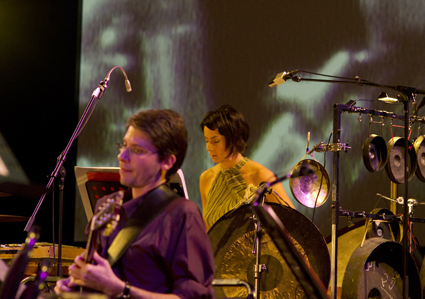
Ensemble Offspring, Professor Bad Trip
photo Oliver Miller
Ensemble Offspring, Professor Bad Trip
DOOF DOOF DOOF DOOF, nnSe nnSe nnSe nnSe…IN THE ABSENCE OF POPULAR MUSIC’S MOST UBIQUITOUS QUALITY, METRIC BEAT, ENSEMBLE OFFSPRING’S LATEST CLASSICAL PROGRAM, PROFESSOR BAD TRIP, DREW PARALLELS WITH ITS PALTRY YOUNGER SIBLING, POP, USING ASSOCIATIONS OF TIMBRE. SUPERSATURATED AND DISTORTED ELECTRIC GUITARS, BASS AND DRUM-KIT DROVE MUSICAL FRAGMENTS ALONG, NEVER AIMING TO ARRIVE ANYWHERE, JUST TRIPPING.
Ensemble Offspring regulars teamed with guests Zane Banks on electric guitar, Dave Symes on bass, Ngaire de Korte on oboe, Rob Llewellyn on bassoon and Alex Bieri on trumpet to explore the divide and crossovers between classical and popular music. None of the works in the program were derivative of popular music but, instead, asserted classical music’s currency. Each showed that classical music can attune to the modern world while simultaneously transcending the form’s perceived limitations. In a packed Bay 20 at CarriageWorks the audience took a trip to the future of classical music. Our psychoactive tendencies were polled in an audience survey that asked us to name our hallucinogen of choice: Peyote, mushrooms, LSD or nutmeg.
Early in the program “Study for String Instrument #2” by fan of allspice and composer Simon Steen-Andersen raised the whammy pedal onto a classical pedestal. The pedal’s sound-modifications are unusually scored for a separate player from the string instrumentalist. It was performed by the fantastically frenzied Geoff Gartner on cello with ‘whammy assistant’ Adrian Bertram. Gartner played mad glissandi; he bowed the edge of the cello rather than the strings while tapping the instrument’s body to produce wild effects. I heard battling space gerbils, while Ensemble Offspring’s Damien Ricketson called the study’s ludicrously exaggerated language “a grotesque caricature of itself.”
Australian Matthew Shlomowitz’s “Joy Time Ride for Ives” parodied art music’s relationship with the musical cliché. Schlomowitz challenges the prevalent aesthetic in classical music that once a musical idea or motif is overused it’s no longer artistically classy. Instead he makes cliché the focus of this composition, exercising snippets of rock beat on drum-kit and recurring flourishes through the upper woodwinds. The repeated fragments are attention grabbing and a little jolting. It’s a relief to hear a familiar passage but you feel luxuriantly trashy enjoying something that’s been sounded so many times before. Cliché winSe nnSe nnSe.
The central works of the evening though were the three “Lessons” of Fausto Romitelli’s “Professor Bad Trip.” Inspired by the mescaline-fuelled poetry of Henri Michaux and the mind-bending drawings of Gianluca Lerici, aka Professor Bad Trip, Romitelli’s exploration of psychedelia is hallucinatory. In the broadest sense, hallucination is perception in the absence of stimulus—it’s the invention of something greater than what is really there. Each “Lesson” does just that. It breathes. It heaves. The music expands and contracts in such extraordinary plays with time that it’s as though universes are born and die with each surging sound. Time actually alters when you’re listening to this music.
“Ever since I was born, I have been immersed in digitalised images, synthetic sounds, artefacts,” the late Romitelli had explained. “Artificial, distorted, filtered—this is the nature of man today.” With this acceptance of the modern racket Romitelli’s sound world draws careful inspiration from disparate sources: from Ligeti to rock, electro and techno. He considered sound to be “a material into which one plunges in order to forge its physical and perceptive characteristics: grain, thickness, porosity, luminosity, density and elasticity.” Romitelli’s music is sculpture of sound, instrumental synthesis, transformation of spectral morphology. It’s in constant drift towards unsustainable densities, distortions and interferences. When I was able to escape the waves of immersion in his music for long enough to reflect, the phrase “an acoustic Aphex Twin” kept surfacing.
Video projections repositioned the audience’s attention out of the music and back onto the musicians. It assured we stay present, but was unnecessary for the majority of the time as the musicians were doing such a good job of transmitting the music that their bodies became superfluous to the art in action. Occasionally the filming caught a facial expression of concentration or communication that would otherwise have been invisible and this invited us deeper into their practice. It also reminded us to change our focus—in seeing someone new, we heard something new. Comedian Bill Bailey describes his experiences on acid as spending hours noticing ever more detail in the few things positioned beside him. He says while darting his head about, “Oh that’s quite interesting, that’s quite interesting, yes, that’s quite interesting.” Visuals, here, revealed the momentarily invisible points of interest.
As I left with an uncanny desire to bake spiced cookies, I thanked these musicians for creating a space for this music to be heard, inhaled, versed, warped, wet, born, aired…Who needs drugs anyway? Just as Ensemble Offspring had assured us in its pre-concert hype, I’ve been changed by this music. New music isn’t what it used to be.
Ensemble Offspring, Professor Bad Trip: Mind Altering Classical Music, conductor Roland Peelman, flute Lamorna Nightingale, clarinet Jason Noble, oboe Ngaire de Korte, bassoon Rob Llewellyn, trumpet Alex Bieri, keyboards Zubin Kanga, percussion Claire Edwardes, violin James Cuddeford and Veronique Serret, viola James Eccles, cello Geoffrey Gartner, double and electric bass Dave Symes, electric guitar Zane Banks, electronics Adrian Bertram, sound Bob Scott, lighting Neil Simpson, video Sean Bacon, Bay 20, CarriageWorks, Sydney, June 18
RealTime issue #104 Aug-Sept 2011 pg. 47
© Felicity Clark; for permission to reproduce apply to realtime@realtimearts.net
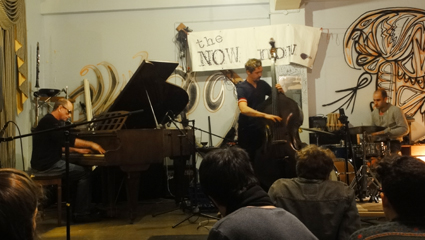
Chris Abrahams, Mike Majkowski, James Waples, Roil, the NOW now
IN PART TWO OF THIS SURVEY OF EXPERIMENTAL MUSIC AND SOUND HAPPENINGS IN SYDNEY, I TAKE IN TWO REGULAR EVENTS THAT SEEMINGLY SIT AT EITHER END OF THE CURATORIAL SPECTRUM: THE PURE SPONTANEOUS MUSIC PURSUITS OF THE NOW NOW SERIES, ONE OF THE LONGEST RUNNING GIGS; AND THE GLORIOUSLY HETEROGENEOUS SOUND SERIES WHICH STARTED IN 2010. WHILE THESE GIG SERIES HAVE QUITE DIFFERENT APPROACHES, THERE IS A STRONG SENSE OF COMMUNION BETWEEN THEM AND IT IS THIS CROSS-FERTILISATION THAT IS CURRENTLY MAKING THE SYDNEY SCENE ALL THE MORE VIBRANT.
the NOW now
The NOW now series is probably well known to readers but to recap, it was started by Clayton Thomas and Clare Cooper in 2001 under the moniker “If you like improvised music, we like you,” from which the first NOW now festival evolved in 2002. The unruly name persisted until the co-founders re-located to Berlin in 2007 and the festival and series became collectively run, both under the same title. The current curatorial team is Sam Pettigrew, Rishin Singh and Laura Altman.
The NOW now series has had many a home since it started at the now defunct Space 3 Gallery in Redfern. Currently events occur monthly and sometimes fortnightly (as they did originally) at Serial Space and a range of other places around the inner-city. Number 6 in the series took place in 402, one of the live-in warehouse spaces in Hibernian House, Surry Hills, featuring a baby grand piano. While occasionally the curation allows a slightly broader sweep of music styles, this evening offered a line-up of pure, unadulterated improv.
First up was Erebis (sitar and double bass) vs Reuben Lewis (trumpet) from Canberra. Lewis is conventionally clad while Erebis dresses up in yukata and plastic Elvis wig, but their music is not quite so flamboyant, offering a version of minimalist free jazz. On the whole they focus on rhythmic and harmonic exploration and only in their fourth piece does it feel like they are starting to approach newer territories by introducing unpredictable timbres.
Unpredictable timbres is what it’s all about for Dale Gorfinkel and Arek Gulbenkoglu from Melbourne. Gorfinkel has a serious sense of play placing objects on his vibraphone and exploiting their rattles and frictions. By casually coaxing materials into action he makes a complex multilayered soundscape with occasional haunting tones from the vibe keys. Gulbenkoglu is a perfect companion on snare drum and objects, using more minimal methods, yet adding just the right rattle of pine cone on snare, metallic ring of egg whisk on rim and tiny chopper effect of a small fan held close to microphone. Their battle of Styrofoam sounds was a particular highlight in a set that felt truly exploratory.
Ivan Lysiak offered a brief piece of guitar feedback. There’s a sense of egolessness as Lysiak lets the signal flow, manipulating its cycles with small changes of proximity between the guitar and the small amp placed on top of an ironing board. It’s not a nice sound, more a nasal whine than a deep, dark massaging drone, but it develops more textures the longer he plays. He goes where the sound goes and then he stops, turning off the amp and holding still, as we do for a breathless minute of ‘silence.’
Roil is Chris Abrahams on piano, Mike Majkowski on double bass and James Waples on drums. Abrahams’ repetitive melodic figures wind around Majkowksi’s angular bass lines, while Waples disperses timbral shimmers that draw it all together. With an instrumental line-up similar to The Necks in which Abrahams also plays, it’s hard not to listen for similarities, but instead of the slow build of the former this combination of characters suggests a journey across constantly shifting territories. One player finds a zone and the others look for ways to meet him there. After a while another wanders off again and the quest continues. This tangible sense of the musicians travelling into the unknown together illustrates the NOW now ethos at its best.
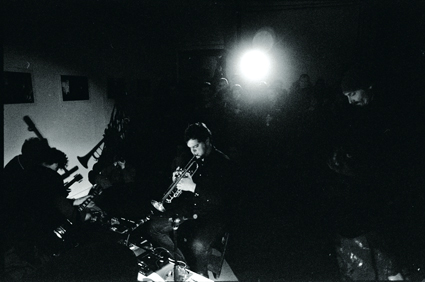
Matthew Syres, Joe Cummins, Dirk Kruithof, Forenzics, Sound Series #15, photo Lucien Alperstein
sound series
Sound Series, curated by Romy Caen, held monthly at Hardware Gallery in Enmore, started in March 2010 and has quickly become a highlight of the alternative music scene. What is distinctive about Sound Series is its eclectism with four to six acts per night ranging from alternative rock/pop to electronica, improv and noise.
Sound Series 15 kicked off with Textile Audio, aka Eve Klein, an electronic composer and mezzo soprano. In the intimacy of the small gallery, her operatic performance is, as she describes it, a little in your face, but her sense of quiet assurance eases the awkward context a little. Klein has a fine voice and creates some intriguing electronic accompaniments, but for my taste (which I admit doesn’t run to opera), Textile Audio doesn’t disrupt the classical conventions quite enough, however many in the crowd were spellbound by her virtuosity.
Next up was Secrets, from New Zealand making some great bouncy pop beats, with almost catchy melodies delivered in a kind of slacker vocal style hidden deep in the reverby mix. With livelier vocals you could imagine these songs being pop hits—people were almost dancing—and Secrets’ performative presence, a mixture of nervousness and reckless abandon, is rather endearing.
Forenzics have been around since 2005 but I hadn’t heard them play. With Matthew Syres on guitar and way too many effects pedals, Dirk Kruithof on lead guitar, Joe Cummins on trumpet and Kaos pad and Alex Slater on drums they play loose yet utterly cohesive improv inflected with jazz, rock, drone and psychedelia. Joe Cummin’s trumpet loops and soaring melodies are a particular highlight creating a smoky, sensual atmosphere and the rhythmic interplay, pushing against the metre with loping rubatos, gives the sound an intriguing elasticity. It occurred to me that music is best when it picks you up and takes you somewhere you didn’t know you wanted to go, and Forenzics did just that.
The final set was by Sydney veterans Toydeath who, if you haven’t seen them play in the last 15 years, dress like creepy children’s TV show characters and create music purely from electronic toys ‘defiled’ with audio outputs so they can be amplified. A particular highlight is their cover of Billy Joel’s “It’s Still Rock and Roll to Me” featuring a hee-hawing donkey and the track with lead vocals by a scripture quoting Jesus doll (yes such a thing exists!). Back from a recent US tour, they presented a slick show that had the crowd on their feet.
I ask Romy Caen about her approach to curating these very successful nights and she answers, “There’s a broad community in Sydney which I think is loosely connected through the idea of experimentation but comprises really varied practices and genres. Instead of specifically seeking experimental performers Sound Series tends to dip into this pool of people.” These resulting ‘hybrid’ gigs often bring large and new audiences. Caen suggests that maybe this is because “Sound Series inhabits a strange realm between mainstream and underground events,” strongly influenced by the venue—a commercial gallery rather than a hard to find industrial space (and sometimes the drinks are free.) While this eclectism is not necessarily to the liking of some purists, Sound Series is doing a great job creating an exciting atmosphere around experimentation across a range of musical styles.
My final report on Sydney sounds and scenes will look at ¼ inch, psh.live plus more.
The NOW now, Series #6, Erebis vs Reuben Lewis, Dale Gorfinkel & Arek Gulbenkoglu, Ivan Lysiak, Roil, curators Sam Pettigrew, Rishin Singh, Laura Altman, 402 Hibernian House, July 26; www.thenownow.net; Sound Series #15, Textile Audio, Secrets, Forenzics, Toydeath, curator Romy Caen, Hardware Gallery, July 23, http://tiny.cc/aox79 Lucien Alperstein’s exhibition Water and Music featuring photos taken during previous Sound Series events was exhibited at Hardware Gallery July 5-23
RealTime issue #104 Aug-Sept 2011 pg. 48
© Gail Priest; for permission to reproduce apply to realtime@realtimearts.net
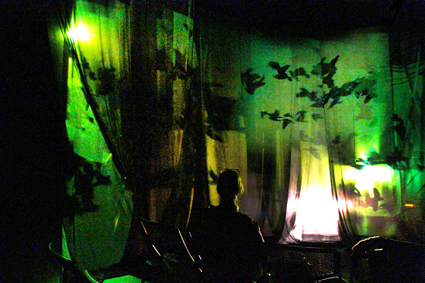
Hourglass
photo Sarah Kaur
Hourglass
HOURGLASS IS AN IMMERSIVE LIVE PERFORMANCE AND NEW MEDIA INSTALLATION THAT EXPLORES THE EXPERIENCE OF TIME. IT IS AN EVOLVING COLLABORATIVE WORK FEATURING A TEAM OF AUSTRALIAN AND MEXICAN ARTISTS INCLUDING NICOLE CANHAM (WHIRLY, CLARINET, TAROGATO), SARAH KAUR (VIDEO), IVAN PUIG (TECHNOLOGY ARTIST) AND CARLOS LOPEZ CHARLES (COMPOSER), WHO WERE BROUGHT TOGETHER BY A PUNCTUM IN-HABIT INTERNATIONAL GRANT TO DEVELOP THE FOUNDATIONS OF A NEW WORK.
Canham and Kaur had worked together previously, exploring the relationship between image projection and music performance, and Canham had also visited Mexico with the help of a Churchill Fellowship. The four artists initially spent an intensive period at CMMAS (Mexican Centre for Music and Sonic Arts) developing their concepts and working relationships, then a period of virtual collaboration and, finally, a week in Bendigo to workshop their ideas, resulting in a performance encapsulating some of their thoughts and experiments. We experienced a 25-minute sampler of a projected hour-long work involving the four artists and Rodrigo Sigal (composer), Drew Crawford (composer), Jose Luis Garcia Nava (new media artist) and Javier Alvarez (composer). It featured works specially written for Hourglass, but also earlier works adapted for the performance. The final version will probably consist entirely of works specially written for the project.
The aim was to create an immersive space that accommodates electroacoustic music, video, installation and a live performer, breaking away from the often formal presentation of new music. Layered black chiffon separated the audience from performer and installations, also acting as a multi-layered screen for video projection; the 3D rhythm generated by images slightly offset by the screens was enhanced by movement due to the airconditioning system. However, the audience was confined to a quarter of the space, restricting the immersive character of the visuals, while a 10-speaker system engulfed us.
Within this space we were presented with a series of musical vignettes centred on the passing of time or feelings generated by it, imagining the space as the inside of an hourglass (grains of sand fall from the ceiling at the end of the performance).
The program began with Into the Hourglass, an improvisation developed by Canham and Charles for whirly and electronics. The tonal range of a whirly is limited but it was intriguing to see how the sounds were created. The computer manipulation was subtle and lingered after the instrument stopped. Kaur’s multi-projection of watery ripples was our first introduction to the black chiffon screen in this short, atmospheric mood piece.
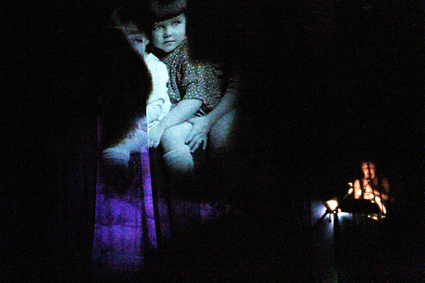
Hourglass
photo Sarah Kaur
Hourglass
Not Alone for clarinet and live processing by Carlos Lopez Charles was really a musical duet in three dimensions. Canham’s clarinet fragments were picked up and manipulated by Charles using live digital processing (Max/MSP). The echoes, mimicking techniques he used as a rock guitarist in the 80s/90s, were expertly moved around the immersive speaker system. As the piece progressed, the clarinet took on a more delicate tone, resulting in a subtle dialogue between clarinet and computer-generated echo. Kaur’s visuals featured random abstract shapes which may have felt more appropriate had their rhythm echoed the looping character of the music.
Next came a short performance by Ivan Puig’s glass bottle contraption (a miniature reference to his beautiful light and sound glass machine, “Mandalas for a Modern Life”), which was both too brief and difficult to see because of its size and positioning. The projected text—“Is it wise, the way the clock turns?”—reminded us of the premise for Hourglass. Puig’s complex machines have a wonderful character of their own and it was a pity his creative contribution was relatively minor here because of the short time he had in Australia. Hopefully the full version rectifies this.
Rodrigo Sigal’s “Vida Lunar” for clarinet and tape was the most substantial piece on the program. Adapted from a piece written for alto flute, all the components came together here: Canham’s extended clarinet techniques, Charles’ immersive diffusion of the complex electronic score and Kaur’s vintage monochrome family photos floating throughout the space.
Paula Matthusen’s “Before the Weather Changes” for sampled tarogato and electronics introduced us to the haunting sounds of the tarogato, a Hungarian folk woodwind recently adopted by Canham for development of a contemporary repertoire. This meditative piece was designed to include a live interactive video, a moving starscape by Jose Luis Garcia Nava, possibly created in “Processing,” but in this performance a video record from a previous performance was screened.
The program finished with Australian composer Drew Crawford’s “Time Flies When You’re Having Fun” for tarogato and tape, which turned out to be a three-minute sketch for a longer piece being developed for Hourglass. Featuring live and looped tarogato and some recorded percussion, it created a playful mood, but didn’t have time to develop. The best part was Kaur’s poetic video manipulation of images of a flock of birds.
Many in the audience were enthralled by Hourglass, but I felt a little hesitant. I sometimes feel sympathy for Francisco Lopez who blindfolds his audience, removing distractions from the listener. Hourglass went to the other extreme, not only immersing the audience in sound, but ensuring they kept their eyes open. Before the performance Canham said “we were less interested in utilising new technologies or looking into ground-breaking techniques as we were in exploring the poetic, the beautiful and narrative ways our art forms could interact.” This worked best in Rodrigo Sigal’s piece where all the elements came together and would have been even better had the audience been free to move around and feel the work—as planned for the future.
Punctum’s Hourglass, artists Nicole Canham, Sarah Kaur, Ivan Puig, Carlos Lopez Charles and guests, Old Fire Station, Bendigo, May 28-29
RealTime issue #104 Aug-Sept 2011 pg. 49
© Jacques Soddell; for permission to reproduce apply to realtime@realtimearts.net
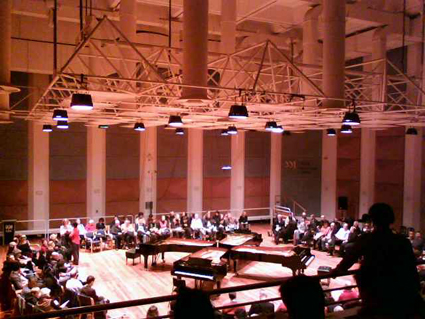
Canto Ostinato
photo Virginia Coventry
Canto Ostinato
WHEN ACTRESS AND DIRECTOR JO KENNEDY INTRODUCED DUTCH COMPOSER SIMEON TEN HOLT’S CANTO OSTINATO (1979) TO MELBOURNE COMPOSER ELIZABETH DRAKE IN EARLY 2009, SHE SET IN TRAIN A MUSICAL LOVE AFFAIR THAT SAW AN EXPLOSION OF PERFORMANCES IN ADELAIDE, PERTH AND NEWCASTLE. DRAKE RECENTLY JOINED FORCES WITH RENOWNED AUSTRALIAN PIANISTS LISA MOORE, CAROLINE ALMONTE AND EMILY GREEN-ARMYTAGE AT IWAKI AUDITORIUM FOR CANTO OSTINATO’S MELBOURNE PREMIERE. CAREFULLY CRAFTING THE WORK’S LONG-RANGE STRUCTURE AND MOMENTARY ARTICULATION, THE ENSEMBLE PROVIDED A CONSTANTLY EVOLVING DURATIONAL LISTENING EXPERIENCE.
Concentric staging lent Iwaki Auditorium a charged atmosphere, with the pianists eyeing each other off like gunfighters around their four grand pianos. The performers’ intense concentration was echoed by the audience, seated in the round like townsfolk gathered to witness a bloody ordeal. Finally, Lisa Moore started the limping five-pulse rhythm that drove the piece forward in one form or another for the next hour and a half. The other pianists contributed complementary ostinati: an insistent, dissonant peal; a swaying melody in the middle register; a loping bass line; until the developing harmony filled the auditorium. Sometimes the texture thinned to a solo line, or five parts raced along like a cartoon chase scene, before bursting into a rocking sea shanty theme. The performance’s success as a musical journey hinged on the close attention paid by both composer and performers to the boundaries of improvisation and determinacy in the work’s construction.
The score is divided into short rhythmic cells that the performers may repeat as many times as they wish and with their own articulation, before coming together for through-composed bridge passages. Ten Holt’s score is ingeniously put together, with five interlocking piano parts capable of producing a wide range of musical effects. Previously a composer of atonal and extended tonal music, ten Holt was “mystified when this music started pouring out in the form it took—entirely tonal and gradually evolving texturally, gesturally and harmonically.” Canto Ostinato’s romantic harmonic idiom might also come as a surprise to fans of minimalist composition, distinguishing it from the pale tonality of its immediate predecessor, Steve Reich’s “Music for Eighteen Musicians” (1976). Caught between modernist complexity, romantic melodicism and minimalist duration, the performers challenged themselves to keep the sophisticated musical machine moving while leaving space for the unexpected to occur.
To Drake, the experience of listening to minimalist music is captured in Henri Bergson’s description of sitting by a river in Duration and Simultaneity (1922): “When we are seated on the bank of the river, the flowing of the water, the gliding of a boat or the flight of a bird, the ceaseless murmur in our life’s deeps are for us three separate things or only one, as we choose.”
Like Bergson’s river, boat and internal monologue, Elizabeth Drake wants the listener to hear Canto Ostinato as a unity of disparate elements. She does not leave this synthesis up to the listener, carefully analysing the score and shaping the performance in order to provide the conditions under which the performers may interact. Drake brought her experience composing for film and theatre to the work, storyboarding each section to take advantage of terraced dynamics, extended crescendi and transpositions. The next step was to integrate articulation into the dramatic outlines of the score.
In developing articulation, the performers found themselves confronted with the problem of trying to repeat musical novelty. “We would be playing as though saying ‘this is what this is about now. It’s about this Db to this C,’” Drake remembers. “But if you introduce an idea, you can only repeat it once. You can introduce it, then you can repeat it. But the purpose of repetition is not to introduce material, it is to keep going until something unexpected happens.”
Caught between the possibilities of an evenly articulated but ultimately boring duration piece and an overbearing repetition of musical emphases, the performers looked to interaction to keep the performance interesting. “We had the directive that we could abandon the plan,” remarks Drake. “You can let things open out if you have a very strong structure and a strong sense of interaction. The stronger the structure, the stronger the plan, the better the performers know what to listen for, the further you move away from just reciting a dictionary of possibilities. You can make a new composition.”
The performers’ detailed knowledge of the score came across in their smooth and gripping performance. Beneath their covert nods and the dazzling, ever-changing surface of the music, part-swapping proceeded seamlessly, page turns were managed with military precision and the performers could focus on letting moments of singular beauty appear.
Canto Ostinato, composer Simeon ten Holt, performers Lisa Moore, Caroline Almonte, Emily Green-Armytage, Elizabeth Drake, IWAKI Auditorium, ABC Southbank Centre, Melbourne, May 13
RealTime issue #104 Aug-Sept 2011 pg. 50
© Matthew Lorenzon; for permission to reproduce apply to realtime@realtimearts.net
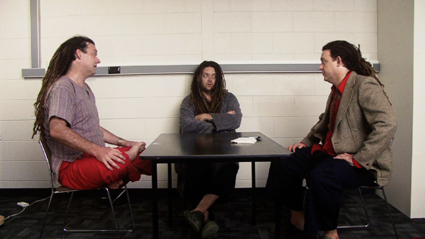
Dept. of Crippling Self-Doubt, short film still, Robert Harding, Graduate, RMIT College of Design and Social Context
courtesy the artist
Dept. of Crippling Self-Doubt, short film still, Robert Harding, Graduate, RMIT College of Design and Social Context
WHEN MORE THAN 1200 PEOPLE PACKED INTO THE MELBOURNE TOWN HALL FOR A KEYNOTE LECTURE AT A WORLD CONGRESS ON ART HISTORY (CIHA) IN 2008, EVEN CONVENER JAYNIE ANDERSON OF THE UNIVERSITY OF MELBOURNE WAS SURPRISED AT “THE STRENGTH OF PUBLIC SUPPORT FOR ART HISTORY IN MELBOURNE.” HER THEME, “CROSSING CULTURES: CONFLICT, MIGRATION, CONVERGENCE,” STRUCK A CHORD AND THE DIVERSE PAPERS DELIVERED ON AUSTRALIAN ART UNDER THIS CROSS-CULTURAL RUBRIC ATTRACTED THE INTEREST OF THE CAMBRIDGE UNIVERSITY PRESS WHO APPROACHED ANDERSON TO COMPILE A BOOK IN THIS VEIN. THIS OCTOBER WILL SEE THE PUBLICATION OF WHAT PROMISES TO BE A GROUNDBREAKING NEW TEXT, THE CAMBRIDGE COMPANION TO AUSTRALIAN ART.
Such publications, says Anderson, reflect growing international interest in “radical new ways of looking at what’s happening south of the equator.” For students picking up the book from the library shelf its lateral essays exploring the intercultural connections of Australian art will present a distinct departure from reigning texts such as McCulloch’s Encyclopedia of Australian Art (2006). At the same time, the way Australian art positions itself in relation to the rest of the world has always been a phenomenon of shifting sands as the tensions over tradition and contemporaneity, and local versus global, are frequently taken up for revision. For today’s students of the visual arts navigating the pluralistic currents of the university curriculum, which vary from institution to institution, must at times prove a giddying experience. As horizons broaden, does this necessarily imply that Australian content becomes narrowed? How adequately are Australian artists represented in the university curriculum at present?
australianness an issue?
“In the last decade or so, ‘Australian’ as a category has become less important to students,” observes Martyn Jolly, Head of Photography and Media Arts at the Australian National University’s School of Art in Canberra and a practising photographer and writer. “When I was a student, Australian identity was a big issue. I think that contemporary students at art school are less concerned with Australianness as an issue. Photography has always been globalised but it is now moreso than it was 10 or 20 years ago.”
While “concerns with what it means to be Australian as a particular topic” might be receding, Jolly argues that “for myself personally and staff generally, there is an emphasis on maintaining Australian photographic history and particularly the issues that Australian photography talks about.” This continues to be achieved through studio lectures on Australian photographic history and a “heavy emphasis” on Australian and Asian Art in the Art Theory program as well as initiatives like regular gallery visits, exposing students to the growing body of books on Australian photography and a vibrant visiting artists program. As Jolly notes, “scholarship on Australian photography is going on still and shows dealing with Australian photography are still happening, like the recent Judy Annear-curated Photography & Place at the Art Gallery of New South Wales. So you’ve just got to include all of that in the curriculum.”
learning from the local
The declining interest in national identity is less of a concern for arts writer and academic Jacqueline Millner, Lecturer in Theoretical Enquiry at Sydney College of the Arts and formerly at the University of Western Sydney, than the implication for students of the prevailing sense “that the local practice is not as compelling or significant as some of the international examples,” which can translate into missed learning opportunities. To counter this, Millner suggests that from the foundational level and onwards students would benefit from greater exposure to local examples. “I’m a firm believer that you should work with what is at hand to begin with because I do think there is a strong pedagogical benefit to actually being able to see and experience the works you’re talking about without relying on reproductions for instance, and for honours and postgraduate students in particular to have access to the artists themselves. I think in general there is not enough attention paid to local practice and that is, not exclusively but at least partly, a result of residual cultural cringe.”
Millner’s philosophy hinges upon “the need to be attentive to what’s happening on the ground around you” and is further reflected in her book, Conceptual Beauty: Perspectives on Contemporary Australian Art (Artspace, 2010; reviewed RT98, p50) which draws upon a decade of arts writing practice. By placing analyses of artists who might be overlooked by mainstream art histories, predominantly but not solely women artists, alongside more well-known Australian practitioners like Fiona Hall and Patricia Piccinini, Millner reveals there is great scope for more expansive definitions of “Australian art.” Asked to comment on the gender mix of Australian content generally presented at a tertiary level, Millner points out “the curriculum tends to be more skewed toward male practitioners. This is something that I address, perhaps not even consciously, through my subjects which tend to be dominated by examples from female practitioners.”
indigenous art: beyond euro-centrism
In identifying shifts in student attitudes towards Australian art, the case of Indigenous art presents a clear exception with a number of academics citing steady growth in this area. According to Jaynie Anderson, “14 years ago we didn’t get a huge amount of interest in Indigenous courses but we do now.” Senior Lecturer in Art History and expert in Indigenous art at the University of Queensland, Sally Butler, agrees that the increased attention paid to Indigenous art is “helping people to look beyond Euro-centric ideas of art,” however, it does remain “a little marginalised.” Students of Indigenous art courses become “hooked for life,” says Butler, but overall there’s still some “resistance to the idea of stepping outside the comfort zone of a Euro-American tradition.” In a 2006 Artlink article, Sylvia Kleinert observes course categories can also prove misleading. Artists such as Gordon Bennett, Tracey Moffatt and Lin Onus, for example, “have consistently refused to be marginalised by their ethnicity, demanding instead to be included within the broader, more inclusive category of Australian art.”
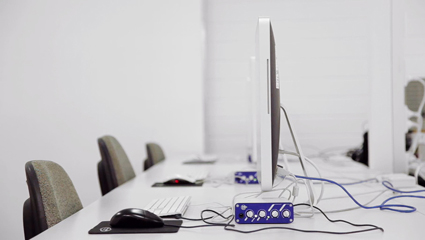
Structures to move to (conversations on work), Chloe Hughes (UNSW), 17 min HD video & sound work, winner of the Dr Harold Schenberg Art Prize presented at this year’s HATCHED Graduate Show
not just in a name
At the University of Queensland, Butler also points out that “there’s far more local content than is necessarily perceivable just from the names of the courses.” She confirms that among students “there’s certainly less interest in a kind of national canon of Australian art.” Yet as the university has cultivated an expertise in Australian art, established at the expense of other areas like early European modern art, for example, “Australian case studies and examples are embedded widely across everything we teach,” Butler explains. In addition to two specific Australian art courses, for instance, “Studies in Photography would actually include 50% Australian art content, Asia Pacific Art includes 50% Australian art, International Contemporary Art includes 50% contemporary Australian art.” Add to this regular visits to local galleries and “students do go away with a very good understanding of practitioners and exhibition activity in Australia.”
Likewise, Anderson argues the University of Melbourne offers many courses with an Australian component; however, “we wouldn’t necessarily call it ‘Australian’ in the title. We’re living in a global age so if you isolate and ghettoise Australian content that’s not good. Rather, we will integrate it at all levels and at the postgraduate research level especially there is a vibrant research culture into Australian art topics.”
This quiet repackaging of university visual arts courses that paradoxically strive to engage with local content while not overtly branding it “Australian” might not appear problematic to some but for Jolly, as a practising artist who does see himself as making work “in an Australian context first and foremost,” the situation appears to resonate on a more personal level. “I gave a talk at the National Gallery of Victoria recently about the 1980s tableaux vivants and it did make me think about how in the 80s we would have called ourselves Australian photographers and we were making work about Australia.”
connecting the local with the global
Directing students to points in art history where South Australian artists are recognised for their active role in global movements, such as the connections between Adelaide artists of the 1940s and 50s with Surrealism and Adelaide’s role in the development of post-object art, is one strategy Jude Adams has adopted at the South Australian School of Art (part of UniSA) where the cultural cringe is compounded by the regional versus eastern seaboard opposition. A lecturer whose courses include Australian Art: Image, Issues and Identity, Adams observes that studio based courses may be “less reflective” of local practices and can unwittingly “reinforce the cultural cringe.” That said, artists’ talks are a compulsory part of the BVA program and usually feature Australian artists. Adams is proactive in wearing down “ingrained attitudes,” emphasising to students that knowledge of Australian art benefits studio practice by “providing a context, a genealogy that helps us to know where we came from.” Adams suggests a perceived student prejudice against Australian art might also be a reaction against history (similar to that identified with Australian history in the secondary school syllabus) while the contemporary can seem more relevant. Within the university, however, “there are so few courses and so few staff, there’s really not much chance to introduce more Australian content.”
the local, a world lived in
It’s this pendulum effect which makes quantifying Australian art content in university curricula such a delicate task as increases in one area imply decreases in others. Certainly, the internationalisation of visual arts courses, and the more recent flourishing of cross-cultural approaches as exemplified by the upcoming Cambridge Companion, represent healthy counterpoints to geographical and cultural insularity. At the same time, most educators agree it would be a mistake to swing too far from local practices, although attitudes towards methods of implementation vary. Embedding local examples with international content appears a logical and pragmatic strategy, but in practice this can be effective only when students are actively challenged to engage deeply with a breadth of local examples and not simply overlook them. A goal all good teachers will aspire to, Jaynie Anderson argues, whether experts in Australian art or not. “Any real art historian will be able to relate their specialisations to the part of the world they live in, the culture they work in,” she says, “otherwise they won’t be successful.”
RealTime issue #104 Aug-Sept 2011 pg. 52
© Ella Mudie; for permission to reproduce apply to realtime@realtimearts.net
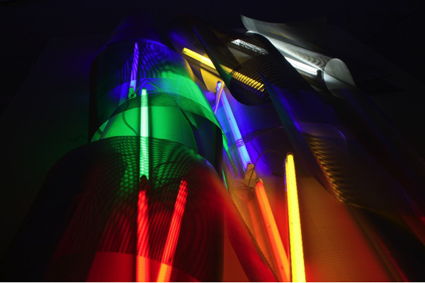
Peter Kennedy: Light Years 1970-1
AUSTRALIAN CONCEPTUAL ART PIONEER PETER KENNEDY’S WORK WAS THE SUBJECT OF A RECENT MAJOR EXHIBITION AT THE INSTITUTE OF MODERN ART, BRISBANE. LIGHT YEARS 1970-1 PRESENTED WORKS FROM THREE SOLO SHOWS OF INSTALLATION, LIGHT, PERFORMANCE AND SOUND WORK THE ARTIST MOUNTED IN 1970 AND 1971. KENNEDY BEGAN TO EXPLORE THE POSSIBILITIES OF MINIMALIST ART WORK WHILST WORKING AS A SIGN DESIGNER AT CLAUDE NEON, CHANNELLING HIS INDUSTRIAL EXPERIENCE INTO A SERIES OF WORKS EXPLORING THE CREATIVE POTENTIAL OF THE MASS-PRODUCED MEDIUM OF NEON TUBES IN THE GALLERY SETTING.
Neon Light Installations (1970/2011) is one of Kennedy’s key early light works and one of the best-known early instances of Australian light art. Kennedy first presented the work in February, 1970, at the Sydney incarnation of the ground-breaking contemporary art space, Gallery A. In the spacious concrete IMA cavern in Brisbane, the straight lengths of coloured neon, intensified by reflective housings, occupied not just the vertical surfaces of the walls, but the corners, ceiling-lines and gleaming horizontal expanse of the floor. What is illuminated is not the material per se, but its effects, drawing our attention to the nature of light as a temporal and spatial presence. Pouring itself around the room’s contours—literally escaping framing conventions—this work treats all interior surfaces as a single, distributed compositional material, one that registers both the interplay of overlapping beams and incidental reflections, and the movement of spectators’ bodies throughout the gallery space: light describing a room.
This contingency is taken further with Luminal Sequences, from Kennedy’s second and final show at Gallery A Sydney, in March 1971, which played on the subjectivity of time through the integration of documentation into subsequent iterations of the artwork. In this work, past and present, the actual and the depicted, absence and presence are brought together in a work featuring neon lights on timers, spotlights and slide projectors. The projections, featuring images of the gallery space, the light work itself and spectators engaging with it, are what shifts the work into a critical postmodernist terrain. This kind of art practice has a long history, as the IMA’s attendant screening of trailblazer László Moholy-Nagy’s Lightplay Black-White-Grey (1930) showed, but with the incorporation of viewers into the ongoing expression of the work and the series of effects this generates, inter alia, about the relations between perceiving bodies, the artwork and documentation, marks the point where high modernist abstraction gives way to conceptualism.
Concurrent with the second Gallery A show in 1971, Kennedy staged another exhibition at Inhibodress, the infamous alternative space he ran with artist Mike Parr (who featured prominently in Let the Healing Begin, the IMA exhibition immediately prior to Kennedy’s). But the Fierce Blackman was a John Cage-inspired sound-performance piece embracing chance operations in subject matter, tones, duration and dynamics. At the heart of this piece was a looped tape recording of Kennedy repeatedly intoning the (randomly chosen) mantra “but the fierce blackman” over a PA, accompanied by a television tuned to static, which intercepted moments of radio signals from passing taxis and a whirring electric fan. In the original performance, the artist appeared at half-hour intervals to intervene with further recitals of the phrase live through the PA. Installed as a documentation piece, while still menacing—owing to the powerful echoes of the artist’s distorted vocals throughout the space—the work appeared to lose some of its ostensive intensity, coming across more as a sound art piece than the exploration of “interference variables” the artist described. Restaging it as a live performance work, rather than reproducing it as an installation, might have accessed more of the work’s heated multiplicity.
In other works, the restaging took advantage of later developments of the works, such as the nesting of the neon tubes of Neon Light Installations in tangles of soft wood wool, which invited a dialectic between rigid containment and diffuse modulation, between synthetic and organic, gas and glass and between the optical and haptical address of the work. At their best, Kennedy’s works produce effects that are powerfully distinct from their material forms; it’s not only electrons being excited to a higher quantum state, but an entire spectrum of visible and invisible forces that are harnessed as his subject.
Peter Kennedy: Light Years 1970-1, Institute of Modern Art, Brisbane, May 7-June 25; Artificial Light Films, Institute of Modern Art, Brisbane. A joint project with OtherFilm, May 26; Let the Healing Begin, Institute of Modern Art, Brisbane, March 5-April 30
RealTime issue #104 Aug-Sept 2011 pg. 55
© Danni Zuvela; for permission to reproduce apply to realtime@realtimearts.net
the totally huge new music festival
“A great festival is one that exposes participants and audience to new directions and ideas and the 2011 Totally Huge New Music Festival promises to do just that with an impressive program of Australian and international work.” (Tura website) The program will include concerts, installations, surround sound presentations, live broadcasts, workshops artist talks and more. Special guest for this year’s festival is New York composer and turntablist Marina Rosenfeld renowned for her ongoing performance, Sheer Frost Orchestra: a graphically noted score performed by 17 females using nail polish bottles to activate electric guitars. Rosenfeld will also be the keynote speaker of the Totally Huge New Music Festival Conference focused around the theme of Immanence. Other artists in town for the festival include from Australia, Speak Percussion, Decibel Ensemble, Etica Ensemble, Pollen Trio, Sonia Leber/ David Chesworth, Philip Samartzis, Anthony Pateras and Ross Bolleter along with guests Mark Gasser (UK) and from Japan FourColor, minamo and moskitoo. Various venues across Perth, September 15-25. www.tura.com.au/totally-huge-music-festival/events
atyp, sweet bird andsoforth
The Australian Theatre for Young People will present the world premiere of German playwright Laura Naumann’s play Sweet Bird andsoforth. Translated by Benjamin Winspear (RT62), and directed by Laura Scrivano, the play begins at a farewell party on the edge of town; but while the group is trapped in an isolated suburban wasteland, their Gen Y dreams transcend location. Billed as an “original, unexpected and blackly comic story of a group of friends caught between adolescence and adulthood,” the play won Naumann the Munich Prize for Young German-Language Drama (press release). Australian Theatre for Young People, Sydney, Sweet Bird andsoforth, Aug 18-Sept 10; www.atyp.com.au
land, sea and sky, goma
It might be one box on the Census (coming soon, August 9) but Aboriginal and Torres Strait Islander cultures are very different from each other, to the point where the latter is sometimes called “Australia’s other Indigenous culture” (press release). Over the next four months, Queensland’s major arts organisations at the Cultural Centre, South Bank in Brisbane, are joining forces to present The Torres Strait Islands: A Celebration, showcasing the diversity and vibrancy of historical and contemporary arts and culture of Torres Strait Islander Australians. The program encompasses an exhibition, Awakening: Stories from the Torres Strait at the Queensland Museum, Strait Home at the State Library and Land, Sea and Sky: Contemporary Art of the Torres Strait Islands, at the Gallery of Modern Art. The last is the largest and possibly most significant exhibition to date of contemporary art by Torres Strait Islander artists anywhere in the world and it includes dance objects, prints, film, video, textiles, ceramics and installations drawn from the Queensland Art Gallery’s extensive collection of works by Torres Strait Islander artists as well as key loans and commissioned works. Artists include Dennis Nona and Destiny Deacon. Land, Sea and Sky: Contemporary Art of the Torres Strait Islands, Gallery of Modern Art, Brisbane; http://qag.qld.gov.au
under the radar, brisbane festival
Returning to the Brisbane Festival is Under the Radar providing a platform for artists to “frolic with risk and experiment with artforms” (website). There are over 30 events including A Three Hotel City, a collaboration between poet Marissa Allen and RealTime writer Joel Stern exploring contemporary society in decline while Motherboard Productions re-imagine Jean Cocteau’s classic La Voix Humaine through text, dance and multimedia. Rebecca Cunningham (co-director of the Exist-ence festival, see RT101, p42) will be collecting one million samples of DNA in her durational performance One and Israel’s Tami Dance Company will remount their acclaimed PeepDance with six Australian dancers performing unique pieces to the same music inside seven peep cells. There’s also a strong music program including House Proud, an immersive percussion performance exploring the sounds of a home by composer Anna van Veldhuisen and designer Ben Landau; Macrophonics combining sound, video and movement through sensor-based gestural controllers, featuring Julian Knowles, Donna Hewitt, Wade Marynowsky and Tim Bruniges, with choreography by Avril Huddy, and two experimental sound nights curated by Dan Lewis & Andrew Tuttle. Under the Radar, Brisbane Festival, Sept 3-24; www.brisbanefestival.com.au/
play, short play publications
An enterprising new venture from Short Play Publications in Melbourne is Play, a stylish volume of Australian contemporary video art comprising both video collection and accompanying booklet. Curator/producer Rachel Feery and Editor Mark Hewitt have assembled 14 video works from artists who are bound together by their exploration of “play” and playfulness; the booklet contains essays by emerging arts writers reflecting on concepts in the collection. Artists in the compilation include: Brown Council, Hit&Miss, Rachel Feery + Lisa Stewart, Timothy P Kerr, Jane Korman, Alanna + Matthew Lorenzon, Riki-Metisse Marlow, Ms & Mr, Hannah Raisin, Safari Team, Sam Smith, Lachlan Tetlow-Stuart, Michael Vale and Jemima Wyman. Short Play will release an annual DVD publication of contemporary video works. www.shortplaypublications.com.au
go graphic at the opera house
The second of Sydney Opera House’s GRAPHIC festivals will include a wide range of works by leading graphic artists, international and local, as well as featuring performances, animation and music, with many of the works world exclusives, Australian premieres and specially commissioned works. The festival’s special guest is the renowned comic artist Robert Crumb, whose epic The Book of Genesis Illustrated was published in 2009—a surprising subject for the artist and a work rendered with respectful fidelity if with his inevitable, relishable idiosyncrasies. Crumb will also DJ a session of his old 78rpm favourites. Melbourne composer Gotye will present An Animated Album Preview, featuring his songs with animations by Australian artists. Shaun Tan’s Oscar-winning The Lost Thing will be screened with the original score performed live; the 2006 anime classic Tekkon Kinkreet (directed by Michael Arias and animated by Studio 4°C) will be accompanied by live music from the UK’s PLAID (WARP) supported by FourPlay and Synergy Percussion; and there’ll be a performance and talk by Masaya Matsuura creator of Playstation game Parappa the Rapper. Something special comes in the form of works by China’s best emerging animators and there’ll be talks, masterclasses, the Best of the Independent Games Festival exhibition and a $20,000 prize for the winner of the animation competition. GRAPHIC is co-curated by Jordan Verzar and Virginia Hyam. Sadly, in news just in, Robert Crumb has cancelled his visit thanks to some nasty and censorious editorialising on the part of the Sunday Telegraph.GRAPHIC, Sydney Opera House, Aug 20-21, http://graphic.sydneyoperahouse.com
new arts fellowship: talent & courage
The Sidney Myer Creative Fellowships provide unrestricted grants to individual artists, arts workers. There are two criteria for selection of grant recipients: outstanding talent; and exceptional courage. Recipients might include painters, sculptors, curators, dancers, choreographers, playwrights, actors, dramaturges, producers, musicians, composers, conductors, multi artform practitioners, writers and thought leaders. Grants will go to those practitioners in the first five to ten years of their professional practice, or equivalent, and those who have a demonstrated capacity to develop and extend their practice. Application is through nomination and grants of $80,000 per year will be awarded for two years. The Sidney Myer Fund does not require specific outcomes from the grant. Sydney Myer Creative Fellowships, www.myerfoundation.org.au
RealTime issue #104 Aug-Sept 2011 pg. 56
© RealTime ; for permission to reproduce apply to realtime@realtimearts.net
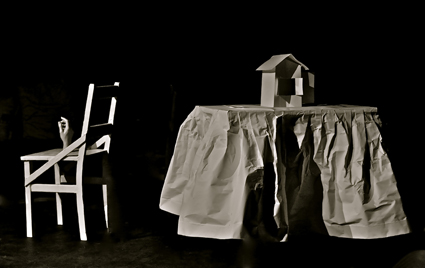
Home, Margi Brown-Ash, Free Range 2011
photo Bev Jensen
Home, Margi Brown-Ash, Free Range 2011
FREE RANGE AT METRO ARTS HAS BEEN DESCRIBED AS A FOUR-WEEK LONG CREATIVE DEVELOPMENT BOOT CAMP, AND THE METRO TEAM’S RESOLVE TO NURTURE PROCESS OVER PRODUCT MAKES IT A UNIQUE AND CRUCIAL INCUBATOR OF PERFORMANCE IN BRISBANE. IF THE AIM IS TO FOSTER NEW WORKS OUTSIDE DISTINCT ARTFORM PARAMETERS, FREE RANGE 2011 ALSO PROVIDED OPPORTUNITIES FOR AUDIENCES TO GAIN INSIGHTS INTO THE PROCESSES OF FAMILIAR, WELL-LOVED ARTISTS WHO HAVE BEEN WORKING INDEPENDENTLY ALONG THESE LINES FOR, WELL, A LONG TIME, IN ADDITION TO NEW AND EMERGING ARTISTS.
While ‘beautiful’ aesthetics were mainly on call (even the whimsical comedy of Neridah Waters trying to convince us she was ‘Dodgy’), I was drawn to works that were raw and seemed to emerge out of the corner of a frenetic eye, out of relatively unexplored emotional areas of the human psyche. These unexpected works weren’t age-related nor seeking to brand themselves. Circus artists Skye Gellmann and Ivan Smith in Something with Sabotage spelled out the nature of “attention seeking ego-driven self-indulgence (a performance).” On the surface, and this was true of the enthusiastic audience response to this piece of theatre larrikinism—they were a pair of likely lads. The show itself was hung on the bones of the tale of “Sinbad the Sailor and the Old Man of the Sea” from the Arabian Nights with Smith impersonating Sinbad as one of the great epic heroes “like Rambo and Rocky.” Gellmann, as the anti-hero and the old man basically perched on his head and shoulders strangling his performance. In the first act the audience was intimately on stage with the performers facing an alternative audience of balloon heads in the seats and gratefully escaping the attentions of the old man. However, there was a steely idea behind all this, as Gellmann notes, “Do I always feel the gaze (as a performer) even when I’m alone in the room? Does my shadow mock and reflection judge me?”
After an interval, when we were required to return through a different door, the second act conventionally distanced the audience and performers but witnessed the two performers in a meltdown deconstruction of the previous act, incorporating bizarre and disturbing imagery of male relations. Smith performed an immaculate juggling act in reverse that lost six balls while retaining one singing like a canary on his shoulder, while Gellmann, upside down, nude and utterly transfixing, like a creature from an Heironymous Bosch painting, inscribed hieroglyphics with his body around the walls of the theatre. More sabotage.
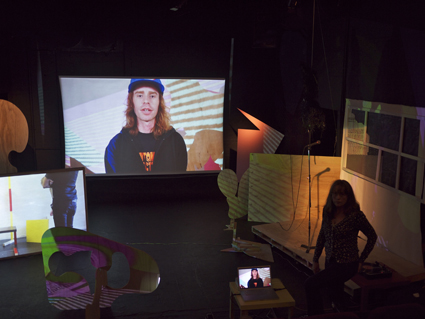
Artist’s Gamble with Time A portrait of Clint (An Expanded Portrait of Everyone)
When I met visual and installation artist David M Thomas he went for the chin by quoting Morrissey: “I don’t perform. Seals perform.” He stressed that his hybrid work, Artists Gamble with Time/ Portrait of Clint, An expanded portrait of Everyone was an enactment not a representation, putting it, of course, into the live art category; but nomenclature doesn’t go far enough to describe a work that was so refreshing and resonantly witty, seamlessly playing off elements of performance, music, photography, painting, installation and video like a form of free style jazz, “in order to explore the construction and maintenance of one’s self.”
Continuous video of a man and a woman constructing and deconstructing abstract, geometric assemblages of coloured blocks of wood evidenced the ecstasy of creative play as opposed to fetishism of the object. Plywood cut-outs evoking the abstract art of the early 20th century painter and poet Jean (Hans) Arp were surfaces for kinetic, op-art projections in vibrant pastels. Arp represented opposition at the time to the proscription of abstract art by both Stalinist Russia and Nazi Germany. He sat on the editorial board of Abstraction-Creation which made the statement in Cahiers no. 2, 1933: “…free thought is being fiercely contested, in many ways, on all levels, in some countries more successfully than in others, but everywhere.”
There was a mini stage above which hung, like a stalactite or nest of night creatures, what turned out to be a ridiculously tall black wig with Gothic connotations when worn by Archie Moore, an urban Indigenous artist and lead singer in Egg Vein, accompanied by Thomas in a leather jump suit on guitar. Unfortunately what I interpreted from the look as ‘horror country’ lyrics about life on the Darling Downs were indecipherable due to sound quality. These seemingly diverse elements framed and commented on what was not so much a portrait but an evocation that amounted to an abstract, almost sculptural assemblage through consciously distancing effects—Clint conceived of as an absence. A second film featured young people speaking fragments of Doyle and Thomas’ email dialogues Godard-style direct to camera within clever re-arrangements of the Arp shapes and projections mirroring the play with blocks. In case you’re thinking all this sounds like a spoof, it was—of 80s video clips, for one—but it wonderfully caught the essence of art as process, a ‘doing,’ and Thomas’ notion that all art is performance art. Loved it.
The Process Project involved Margi Brown Ash, Nikki Heywood and Brian Lucas in a year-long colloquy and exploration of performance hybridity from their perspectives as mature artists and from meetings with a community landscape designer, a restaurateur and a Buddhist terminal care worker. In a summary report on their experiences to a Free Range audience, they created an elegant three-fold schemata of the artistic journey given vivid immediacy by the shapes of Lucas’ sand mandalas and embodied by the journeyman, the villager and a desperate wanderer negotiating the wasteland. It was striking that art and life skills (techne) shared in common with others in the community seemed to be equally compounded by grace, as the Greeks would have it, not just productive efficiency. In an age when the arts are marginalised and grace is considered an option the economy cannot afford, theirs provided a civilised and reassuring conclusion.
This mutual involvement also enabled Brown Ash, as a self-admitted “senior artist” shortly turning 60, to re-imagine (with long time collaborator Leah Mercer) her life as an artist, wife and mother in it for the long haul in Home presented by The Nest 4 Change. Brown Ash it was who famously announced at the presentation of The Process Project that “IF I should ever die…” she would prefer to do so under Buddhist palliative care. Brown Ash has always been a performer who constantly surprises you with her strengths, and is also a skilled art therapist and counsellor. Superficially, Home resembled a form of drama therapy, but it was soon clear that this was no unexamined life. We were caught up in the headlong rush of Brown Ash’s artfully fragmented myth and storytelling—dashing back and forth from teenage years to young womanhood to middle-age; spinning out into the cosmos on the wings of the Egyptian gods Isis and Osiris; capturing members of the audience as her surrogates in different times and places as she roamed round the space with fierce, prowling energy. She was everyone’s bohemian mother (or the one you wanted), feeding you tea and biscuits—and home truths—with an unsentimental pellucidity that reminded me of the English poet Stevie Smith. Spawner of unusual progeny, one of whom went to Palestine to learn Arabic and another who went to Israel to learn Hebrew, Brown Ash’s new work is similarly prodigious in scope and potential. It was not intimate theatre but epic theatre about intimacy.
Free Range 2011: Something with Sabotage, Ivan Smith, Skye Gellmann; Home, Margi Brown Ash, Travis Ash, Bev Jensen, Leah Mercer; Artists Gamble with Time/ Portrait of Clint, an expanded portrait of Everyone, David M Thomas, Archie Moore, Suzanne Howard; The Process Project, Margi Brown Ash, Nikki Heywood, Brian Lucas’ Metro Arts Brisbane June 3-28
RealTime issue #104 Aug-Sept 2011 pg. 14
© Douglas Leonard; for permission to reproduce apply to realtime@realtimearts.net
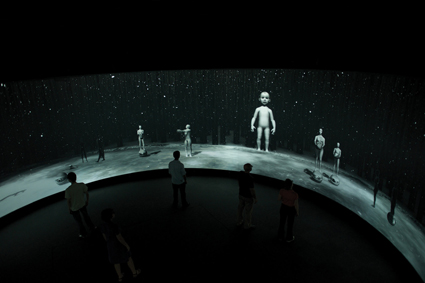
Scenario
photo courtesy of iCinema
Scenario
SCENARIO, DIRECTED BY THE ARTIST DENNIS DEL FAVERO, IS A 360-DEGREE, 3D INTERACTIVE CINEMATIC STORY, THE RESULT OF AN EXTENSIVE COLLABORATIVE PROJECT AT THE UNIVERSITY OF NEW SOUTH WALES. IT PREMIERED AT THE 2011 SYDNEY FILM FESTIVAL ATTRACTING MEDIA ATTENTION BOTH FOR ITS CINEMATIC INNOVATION AND EERIE ATMOSPHERICS.
Edward Scheer, who teaches at the Faculty of English, Media and Performing Arts at UNSW, has followed the evolution of the project and written a companion study. I spoke with Scheer, who believes that Scenario marks a new level of interdisciplinary research in innovative technology. Its more profound value, however, is as a poetic text that taps into archetypal human experience.
an eye as avatar
Scenario opens with a shadowy underworld that beckons the audience to enter and engage with its humanoid inhabitants. In Scheer’s words: “You walk into a 360-degree environment and you see some eyes staring at you. A voice tells you to choose an eye and the eye becomes your avatar. Then a humanoid figure jumps on top of the eye and leads you through a series of underground spaces—spaces of abandonment, one suspects of criminality. You are told that you have to find the body parts of a humanoid child and that these parts have to be returned to the child. One is therefore introduced to a scene of horror but in a gentle way. You are also implicated in the restitution of this violent act.”
The fact that the spectator is not just a voyeur immediately suggests an unusual cinematic experience. Scheer observes that in conventional cinema one is passive in a “cinematic machine that grinds on regardless of your subjective investment.” In contrast, this work opens an interesting ethical space. Scenario has a tracking device which picks up the spectator’s motion. Ultimately, if the body parts are successfully returned to the child, the child is free to walk away. However, if the parts are not returned, an apocalypse descends, ash falls from the sky and there’s a blackout. There are two endings then, each contingent on the active spectator’s participation.
Scheer believes that the unique way Scenario brings together interactive narrative, aesthetics and the use of 3D makes it a world first, one situated within the broader achievements of iCinema itself: an ARC-funded project to look at new software, screening environments, narrative possibilities and spectatorship experiences. The research centre has created the 360-degree Advanced Visualisation and Interaction Environment (AVIE), unique in itself. Over the last ten years some quite remarkable works of new media interactive art, such as Eavesdrop (2004) and There is still time…Brother (2007), have been produced there pushing the boundaries of disciplines and separations between art practices.
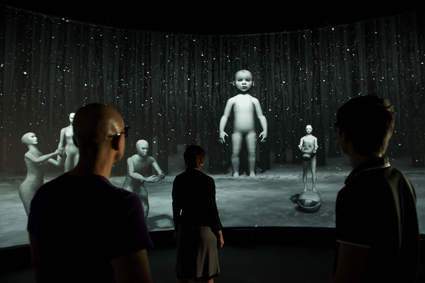
Scenario
photo courtesy of iCinema
Scenario
performative media
The question of whether Scenario’s immersive environment fits comfortably within a film festival program leads Scheer to ponder if cinema is actually the right model for such an experimental and interdisciplinary approach. “The cinema-goer is not going to have the same kind of experience that they will be used to. Theatre-goers might be more familiar with the kinds of calling forth of one’s own subjective experience to respond to the material.”
Where then should Scenario be positioned? Scheer calls it “performative media” as it is setting up a mediated space. The humanoid behaviours are modelled on live actors—achieved through the use of motion capture to establish a library of behaviours. There is also the way the spectators have been animated through their involvement in the media. This genealogy resembles media art and crossover performance art. While such a genre reminds cinema of its own performative roots, it remains uncertain if it will have commercial possibilities in the cinema. It has in other fields—the iCinema project has been taken up, for example, by Chinese mining industries.
collaboration as research trajectory
Scheer became involved in the Scenario project several years ago when Dennis Del Favero talked about it in the context of their mutual admiration of the work of Samuel Beckett. “When Dennis told me that Scenario was based on Beckett’s Quadrat, I started turning up to the early iterations of the work.” After giving some feedback, Scheer was formally invited to be the official scribe. It has been a two-year project working with the team with an eye to reporting on compositional and dramaturgical processes, examining its precursors and providing a reading of the work as Scheer sees it.
Scheer describes the collaboration as “a kind of open source dramaturgical project.” The computer scientists rendered the images with Dennis Del Favero. The playwright and screenwriter Stephen Sewell provided the text which changed as the project evolved. Visual designers gave cues to the visual world as it was being formed. These people were sharing their ideas with the computer scientists. “It was a fascinating set of exchanges with Dennis directing but doing so with tremendous generosity. The depth and complexity evolved through these discussions, properly interdisciplinary.”
If the scale of this interdisciplinary collaborative process suggests a new trajectory in the creative research process in the arts, Scheer would point to new media art as a leader simply because of the increasing scope of digital systems requiring a multiplicity of skills to create a meaningful experience for audiences. However, he suspects that a similar modality of collaboration is influencing the way academics engage with artists who traditionally have worked very much alone with their own imagination. Scheer cites his own research on Mike Parr, with whom he has long been in conversation in order to make the artist’s output available to a wider audience. Perhaps it is not just that artworks are changing but the way the academy is engaging with artists. Instead of sitting back and making critical judgements about the value of an art work, academics are now talking with artists, trying the develop a conversation around the work and from that process the reading emerges.
the limits of representation
In his attraction to Scenario Scheer was mindful of the work of Antonin Artaud on whom he wrote his PhD and still someone he considers a massively inspirational force in contemporary aesthetics. “Artaud worked in all of the media of his time and was acutely aware of the confluence of creative forms across different media and the performative, transformative power latent within them.” He believes that Del Favero is clearly engaged in a similar aesthetic, trying to break through to very essential experiences such as trauma, which cannot be encoded within representational media. That which eludes representation was the concern of the “theatre of cruelty.” “What other forms are available that can pursue experiences otherwise fundamentally lost?”
a folktale
Underlying the experience of trauma is something perhaps even more elemental, namely the experience of confinement. I ask Scheer if Scenario stands as a 21st century folktale about the urge to find freedom from one’s received confines. He believes so as it picks up on those universal experiences of loss and abandonment as well as the sense of containment and release. Scenario’s intertext is the Josef Fritzl case, which provides an elusive subtext to some of the work’s narrative. “This was an experience of depravity but also one of containment —seven children confined for 24 years in a cellar beneath the house in Amstetten in Austria. Imagine waiting for 24 years to be released.” Scenario not only tracks the endless experience of confinement but in a form that takes the shape of a folktale.
Scheer considers the tale an ur-story by which he means that the drama is not something happening for the first time; rather, we have seen it all before. He is not alone in thinking this way. Elfriede Jelinek, Austria’s Nobel Prize winning writer sees the Fritzl case as a typical performance of Austria, something that requires no rehearsal because male violence against women is an everyday performance. Scenario taps into that story, “not as something to fetishise but as an archetypal experience that leaks out of the four walls of the basement in Amstetten to be picked up here, perhaps ultimately as an atmosphere of threat, menace, loss and possible recuperation.”
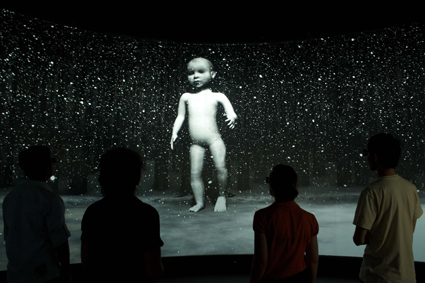
Scenario
photo courtesy of iCinema
Scenario
containment & release
Such an atmosphere is played out as a spatial dialectic, akin to Gaston Bachelard’s “poetics of space.” The spectator experiences the phenomenology of restriction and containment: corridors, tunnels, basements, cracks in the ceiling through which you see the rain coming down, an inner city alleyway. The final scene reveals a frozen lake in a forest and there is a more expansive sense of space. In one version this space closes down. In the ‘happy ending’ version, it opens out and the gigantic figure of the child rediscovers its motility, moving out of the space of confinement towards the space of the forest. “The phenomenology of this for the spectator is very evident in that we experience expansiveness as opposed to restriction, freedom not isolation. Seeing this giant figure moving gives us a sense of hope.” This is important to a reading of so dark a work. At least in one version, the work is ultimately quite hopeful in tracking the relations between self and other.
Edward Scheer Scenario (2011), UNSW/ZKM Press, www.unswpress.com.au; Scenario, director Dennis Del Favero, writer Stephen Sewell; other credits at: www.icinema.unsw.edu.au
This article originally appeared in our July 26 e-dition.
RealTime issue #104 Aug-Sept 2011 pg. web
© James Paull; for permission to reproduce apply to realtime@realtimearts.net
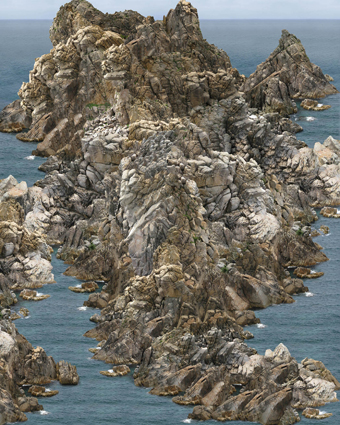
Jae Hoon Lee, Ha Jo Doe, 2010, digitally collaged photography
courtesy of the artist and Starkwhite, Auckland
Jae Hoon Lee, Ha Jo Doe, 2010, digitally collaged photography
PUTTING ON MY GLASSES, THE LARGE-SCALE DIGITAL PHOTOGRAPHY OF JAE HOON LEE COMES INTO FOCUS AND I NEED TO STRIDE BACKWARDS IN ORDER TO TAKE IT ALL IN. REMINISCENT OF A GATEWAY TO AN ANCIENT TEMPLE, THE OVERSIZED IMAGES TITLED HA JO DAE 2 AND TREKKING 2 MARK THE ENTRANCE TO UNGUIDED TOURS: THE 2011 ANNE LANDA AWARD FOR VIDEO AND NEW MEDIA ARTS EXHIBITION AT THE ART GALLERY OF NEW SOUTH WALES.
jae hoon lee, ha joe dae 2, trekking 2 and levitation
To the left appears a landscape of ocean and rocky outcrops. Looking as if they have been constructed chunk-by-chunk, these formations rise from the sea; patterns of indistinguishable similarity emerge, then deviate. To the right, Trekking 2 features a path repeatedly zigzagging, cutting into the sheer, barren mountainside. Someone passing by comments: “God, you wouldn’t want to run off that road.” Spectators stop, pondering where in the world this incredible hillside track might be; until they twig. Or perhaps some of them don’t. Uncannily similar furrows of snow appearing in the crevices are in fact identical. By means of a digital cut-n-paste remix, Trekking 2 takes what is already an awe-inspiring landscape one step further.
Fittingly, Jae Hoon Lee’s Levitation sits between these two digital image giants. The constant ding of a small, tinny yet reverberant bell heralds the exhibition’s entry point. The resonant Buddhist’s bell sound accompanies beautiful textures (in deep ambers, rich chocolates and jade greens) of moss-adorned bricks on screen, slowly rising upwards. Having passed over the threshold, I begin my journey through New Zealander Justin Paton’s curation of award contenders, titled Unguided tours.
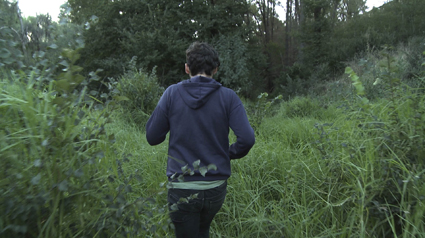
Charlie Sofo, 2010-11, mixed materials digital videos
courtesy of the artist and the Art Gallery of NSW
Charlie Sofo, 2010-11, mixed materials digital videos
charlie sofo, fields 2010-2011
In contrast to Lee’s meditative landscapes, Charlie Sofo’s Fields 2010-2011 is a solid reality check; familiar to all who have ever ventured into the Australian suburbs. Over the past year or so, Sofo has enlivened his potentially boring everyday journeys by gathering like objects. An array of videos, slideshows, as well as the items themselves are clinically displayed: small pebbles collected by way of getting stuck in the grooves of the artist’s shoes, chips of coloured paint, a Google map indicating where condoms and/or condom wrappers have been discarded around Melbourne’s suburbs of Brunswick and Northcote and a box of pastel-coloured cards, each announcing yet another venue (presumably somewhere the artist frequented) has closed down. The premise of Fields 2010-2011 is to attempt to assist the audience in “looking anew at what’s already there.” For one audience member, a small component of Sofo’s work becomes incredibly significant: a video of various neighbourhood cats contains a fleeting image of what she thinks might have been her own cat, who recently passed away. In asking his audience to view tiny scraps of the everyday in a new light, Sofo offers us a way to invest meaning in our banal daily treks.
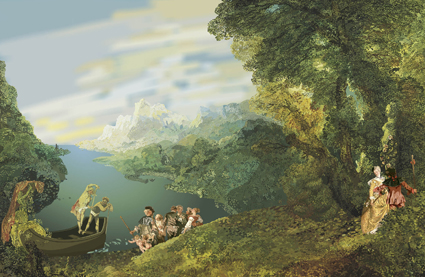
Arlo Mountford, The lament, 2010-2011, two channel digital animation with 5.1 surround sound
courtesy of the artist and the Art Gallery of NSW
Arlo Mountford, The lament, 2010-2011, two channel digital animation with 5.1 surround sound
arlo mountford, the lament
Stepping away from the doldrums of familiar life, we are back in the surreal once again. Arlo Mountford’s The Lament is another large-scale digital work—a painting virtually brought to life. This is a fairytale remix of sorts. Taking the two versions of Watteau’s L’embarquement pour Cythere (Embarkation for Cythera) stitched together, the creator then bestows upon this work the breath of life. Taking the time to sit and observe as a peaceful scene unfolds, what becomes noticeable is actually the large degree of activity taking place. Lovers kiss, birds twitter away, a dog rushes around (the spatialised audio space) barking excitedly, waves lap at the shores, couples—flanked by chubby flying cupids—either embark or disembark from the wooden boat, which then encircles the island, partially cloaked by drifting digital mists. For me, this work provides brief solace before returning to hectic city life.
rachel khedoori, untitled
From one natural setting to another, Rachel Khedoori’s Untitled presents a panorama unfolding from the middle, an old technique used in moving imagery, yet Khedoori’s work does not concentrate on this trick. Instead, the symmetry and smoothness of movement help to draw focus towards the endlessness of a lush bush-scape, peeling outwards forever. A group of kids gather to watch, emitting a collective “whoa…”
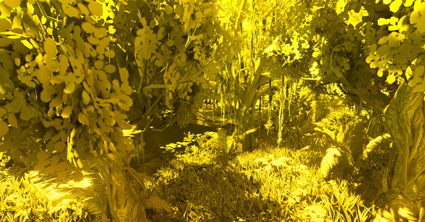
David Haines and Joyce Hinterding, The Outlands 2011, projected real time 3D environment utilising the Unreal Engine; additional sound Rosy Parlane, Michael Morley and Danny Butt
courtesy of the artist and the Art Gallery of NSW
David Haines and Joyce Hinterding, The Outlands 2011, projected real time 3D environment utilising the Unreal Engine; additional sound Rosy Parlane, Michael Morley and Danny Butt
david haines and joyce hinterding, the outlands
I follow the kids and their parents into The outlands, David Haines and Joyce Hinterding’s game environment, knowing it’s going to be a while before I get my turn. As I enter the space, The outlands creaks with sounds from the shadowy vegetation, created by New Zealanders Rosy Parlane, Michael Morley and Danny Butt. With only two controller “sticks” (joysticks with large dead twigs attached), diplomatically sharing these between a large group of kids calls for other forms of interaction. Without hesitation, some of them crouch down in front of the floor to ceiling projection, pretending to be prowling animals and then slowly swaying from side to side as if aboard a vessel traversing this imaginary landscape. Hovering above a blue-tinged black swamp, surrounded by low-lying branches and deadwood, we fly towards the towering rock formations. The kids were happy to improvise their own interactivity but I wanted to demand much more from the winner of the $25,000 acquisitive Anne Landa Award for 2011. What I desired was a greater degree of immersion (in both this work and also in the overall scope of the exhibition), with fewer works presented as if they were paintings or photographs, merely shifted into the video realm.
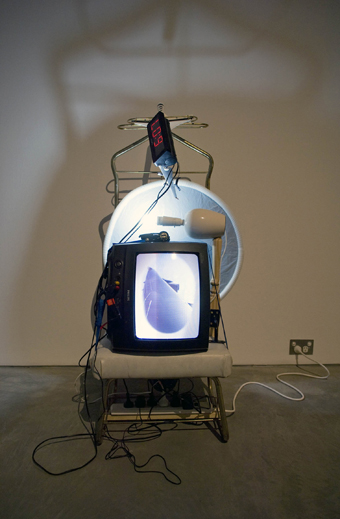
Ian Burns, 15 hours v4, 2010, found object, kinetic sculpture, live video and audio
courtesy of the artist and the Art Gallery of NSW
Ian Burns, 15 hours v4, 2010, found object, kinetic sculpture, live video and audio
ian burns, various
While at first glance it didn’t look like much—just a random bunch of old junk cable-tied and taped together—the pièce de résistance of Unguided tours was the work of Ian Burns though I’ll admit it did take me some time to comprehend what was actually going on. Commencing with Well Read, homage to the road trip and car culture, your eye wanders these sculptures of second-hand odds and ends, eventually settling on two analogue TV screens strapped to the front. Switching between different camera angles, a car drives along open roads, blue sky above. The driver, a peroxide blonde Ken doll, bobs along as the wheels of the car spin…on what turns out to be a seven-inch of Time Bandits’ “Endless Road.” These unremarkable objects are cleverly pieced together to create an illusion found regularly on our screens.
With each of his works in the exhibition (including From orbit displayed in the gallery’s entrance), Burns takes the lid off various movie-like scenes of travel we believe in and commit to so wholeheartedly, exposing the underbelly of smoke and mirrors. Standing in the passageway between Makin’ tracks and 15 hours v4 (an endless view from an aeroplane window over the plane’s wing), I overhear a 20-something comment as he passes by that “it’s just shit really, I don’t get it.” The combination of this remark and Burns’ works illuminates the real crux of Unguided tours. While there may be a general preconception that the digital realm is all about instant gratification, these works require a time commitment. Their messages are not immediate.
From familiar digital suburban-scapes through to pristine pixel wilderness, while none of these works demands attention, you are only granted insight if you take the time to contemplate. This is the same headspace one enters when travelling solo through unfamiliar countries and cultures: precisely what each of these artists must have done at some point, in order to produce these offerings. But while the “touring” aspect of the exhibition works, I am less convinced by the “unguided” framing since, regardless of whether or not a conventional narrative is present, many of the works still portray a semi-predictable journey, one that is predetermined by the digital tools they employ. Nevertheless, this concern is of far less importance than the feeling that I depart with—I have been reinvigorated, as if returning from a holiday, and I haven’t even left town.
Unguided tours: Anne Landa Award for Video and New Media Arts, 2011, Art Gallery of NSW, May 5-July 10; www.artgallery.nsw.gov.au
This article first appeared in our July 26 e-dition.
RealTime issue #104 Aug-Sept 2011 pg. web
© Somaya Langley; for permission to reproduce apply to realtime@realtimearts.net
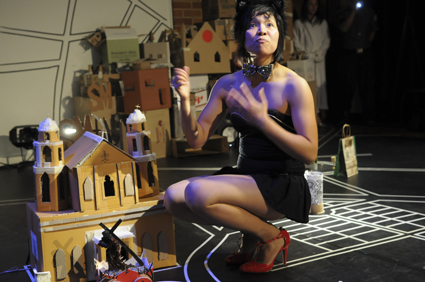
Within and Without
photo Heidrun Löhr
Within and Without
LAST YEAR’S TINY STADIUMS FESTIVAL FEATURED A SITE-SPECIFIC WORK OF NOTE. APPLESPIEL, A COLLECTIVE OF FORMER UNIVERSITY OF WOLLONGONG STUDENTS, TOOK UP RESIDENCE IN SYDNEY’S ERSKINEVILLE TOWN HALL AND, OVER THE COURSE OF 12 DAYS, TRANSFORMED A COLOURFUL CARDBOARD MINIATURE OF THE SUBURB’S MAIN STREET INTO A STRANGE NEW VERSION OF ITSELF. INVITING AUDIENCE MEMBERS TO PLAY THE ROLE OF HANDS-ON URBAN PLANNERS AND ENGINEERS, THE COLLECTIVE PLANTED MONEY TREES OUTSIDE THE CAFE, BROKE GROUND ON A NEW AQUARIUM AND CUT THE RIBBON ON THE BATCAVE, A BATMAN-THEMED MUSEUM.
I was reminded of Applespiel’s Erskineville recently when I visited Within and Without’s Manila. A collaboration between the Philippines’ Anino Shadowplay Collective and local artists Valerie Berry, Deborah Pollard and Paschal Daantos Berry, Within and Without is a hybrid work of performance and installation art that is laudable for its ambition if not always for its achievement. More than a mere city street, it features a sprawling miniature cityscape constructed not from coloured card but recycled detritus: cardboard boxes, unloved toys, curious knick-knacks and old tangled fairy lights, the lot held together with masking and gaffer tape.
While I have spent a little time in Erskineville, I have never been to Manila. My impressions of the city were formed by Alex Garland’s 1998 novel The Tesseract, which paints it as a sprawling nightmare slum and John Safran’s TV series Race Relations, where the show’s host famously had himself crucified on what were pretty flimsy thematic and narrative grounds. In Within and Without, Manila is presented as a city defined by its own ongoing, contested construction: the US rebuilding of Manila post-WWII, the Ayala family’s construction of the affluent Makati district and Imelda Marcos’ Martial Law-era beautification projects are all mentioned during the show. The most devastated allied city after Warsaw, Manila is here imagined as one that has not only grown out of the debris, but has actually been constructed from it.
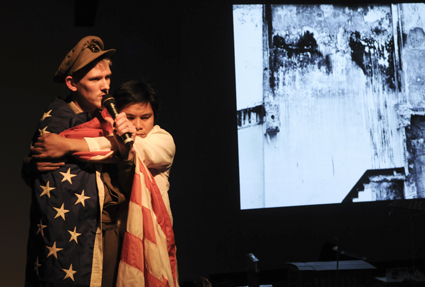
Within and Without
photo Heidrun Löhr
Within and Without
For all the aptness of this metaphor, however, there otherwise remains a disconnect in the piece between its form and content. As you are shown around the cardboard city by a performer-cum-guide—you see only parts of the installation during any given performance and would need to attend maybe two or three times in order to experience the whole thing—this disconnect becomes ever more apparent. From the arts-and-crafts construction of the city to the wide-eyed, forced-grin delivery of the tour guides, the form is instantly reminiscent of children’s television programming. The content however covers everything from WWII and the ensuing dictatorship of Ferdinand Marcos to tours of the city’s gay and red-light districts—“I am sure we can find you a nice ladyboy here, ma’am-sir!”—and is decidedly more complex than either the cardboard city, or the piecemeal exposure available to it on any one visit, would suggest.
While occasionally charming, this disconnect between form and content doesn’t really seem to reveal anything about either. While providing a more or less arbitrary framework for us to learn about Manila, the cardboard-and-egg carton city does not appear to reflect or reveal anything about the flesh-and-blood one, which itself seems like a strange choice of subject for anyone looking to more fully exhaust the possibilities of this form. It is a poor critic who presumes to tell an artist that they could improve their work by doing something entirely different. But Applespiel’s Erskineville keeps coming to mind. It seems to me that a Playschool-ish approach is perfectly suited to the creation of a wholly imagined city, or an amalgamation or reinvention of an already existing one, and that such miniaturisation is a perfect way to get people thinking about urban planning, spaces for living in or the relationship between geography and community. As a way of getting people to think about what the program notes call “the horrors of history” it seems indirect and ineffective. We are left to ask ourselves one of two questions: “Why Manila?” or “Why in miniature?”
Garland’s The Tesseract provided such a striking representation of the city—I cannot, obviously, speak to its accuracy—because it employed a narrative form that was well-suited to its author’s idea of the place: a temporally dynamic postmodern structure for a spatially dynamic postcolonial city. It is arguable that the aforementioned disconnect between Within and Without’s form and content itself mirrors the manifold divisions inherent in what the artists, in their aforementioned program notes, describe as “the way we collectively see [the city]:” the divisions that exist between East and West, Christianity and Islam, rural and urban, rich and poor. Tellingly, two of the words the artists choose to describe the city are “schizophrenic” and “chaotic.”
Which is why the soundscape that opens the performance, taking place before we have even seen the cardboard city, is more effective than what follows it. Entering a dimly-lit space and asked to don the blindfolds they have been given in the foyer, the audience are treated to a densely layered sound design that includes everything from barking dogs and construction work to loud-mouthed hawkers and a discordant dirge of car horns. The key word here is ‘layered.’ Where the rest of the work is characterised by its own internal divisions, this opening sequence gets somewhat closer to approximating the messy, communal and continuous process that is the construction, not only of a city like Manila, or even an inner-city suburb like Erskineville, but of any space in which we must live. In doing so, it gets somewhat closer to actually approximating what a history is, too. It gives us a palimpsest.
Performance Space and Blacktown Arts Centre: Within and Without, artists Paschal Daantos Berry, Deborah Pollard, Valerie Berry, Anino Shadowplay Collective (Datu Arellano, Andrew Cruz, Don Maralit Salubayba), guest artists David Buckley, Kenneth Moraleda, Melanie Palomares, lighting designer Jack Horton; Blacktown Arts Centre, Sydney, June 23-July 2
This article was first published as part of the July 26 e-dition.
RealTime issue #104 Aug-Sept 2011 pg. web
© Matthew Clayfield; for permission to reproduce apply to realtime@realtimearts.net
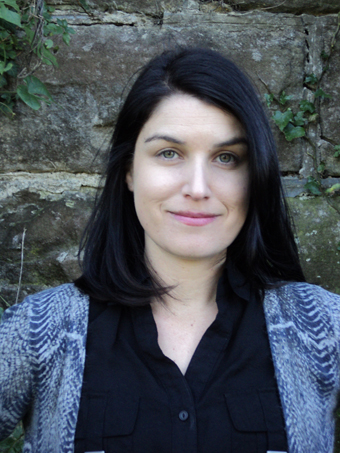
Ella Mudie
photo courtesy of the author
Ella Mudie
Bio
My father’s a painter so I grew up with art and the smell of oils still takes me back to my childhood. First and foremost though I’ve always been a big reader, which led me to enroll in a BA at the University of Sydney where I majored in English and wrote an honours thesis on the maverick boy poet and hoaxer Thomas Chatterton. I also took some postgraduate studies in journalism and among the climate controlled towers of UTS found my niche in print features and arts writing. Some early gigs such as a catalogue essay for a painter friend snowballed into bigger things, eventually leading to features for The Age and other papers to articles and essays in magazines and journals including Meanjin and the Griffith Review. My interests are broad but the visual arts are a longtime passion and common thread running through much of my work. I find myself mostly drawn to writing about photomedia, installation and conceptually driven practices.
Exposé
My desire to write comes mainly from curiosity, I think. Journalism opened my eyes to the importance of writing within a social context and why giving a voice to real, everyday people matters. When it comes to visual arts writing specifically, I’m most interested in how writing introduces a pause, interrupting the passive consumption of images, objects and ideas and instead feeding a sustained contemplation which, in order to be shaped into a text, requires reflection and interpretation. Art writing can’t be rushed, it gestates over time and represents a subversive gesture in this speedy capitalist culture where time is money. I enjoy how good artworks reveal something new each time I revisit them, leaving the process somewhat open-ended.
Freelance writings assignments can be relatively short in length so I like to counterbalance this by immersing myself in bigger topics over longer periods of time. Sometimes they turn into stories, sometimes they don’t. I’m currently researching the influence of Surrealism on the development of the psychogeographical novel, from André Breton’s Nadja to the elegiac meanderings of WG Sebald. I’m enjoying the indeterminate nature of these stories. In my own work I always strive for clarity yet curiously I often start with a point of confusion—something perplexing which somehow the process of writing works to unravel and resolve.
Recent articles for RealTime
studio vertigo: fiona mcgregor
RT99 night works: bec dean, nightshifters, performance space
RT98 sino-supernova: the big bang, white rabbit gallery, sydney
RT94 deepening degrees of subjectivity: brad miller, james charlton, simon barney, artspace
studio special effects: sam smith
other writings
between art and garbage, meanjin
dream it, build it, the age
the spectacle of seismicity: making art from earthquakes, leonard journal, mit press
the alpha pre-schoolers, sydney morning herald
building conversations: architectural photography as discourse, afterimage journal of media arts and cultural criticism
RealTime issue #103 June-July 2011 pg. web
© Ella Mudie; for permission to reproduce apply to realtime@realtimearts.net
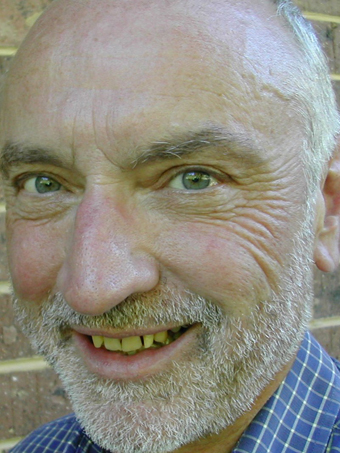
Chris Reid
photo courtesy of the author
Chris Reid
Bio
As an undergraduate in South Australia, I studied Political Science and History and have made a 30-year career in educational administration — “herding cats”. More recently I completed a masters degree in art history and had a brief taste of teaching in that field. After 5.00pm, I’ve always been an arts addict. I write about both art and music but I’m neither an artist nor a musician. My life is split between three worlds — art, music and education. Every interstate or overseas trip is a cultural (as well as socio-political) excursion.
Exposé
I began writing about art in 1992 for Adelaide-based visual art magazine Broadsheet, published by the Contemporary Art Centre of SA, and regularly wrote exhibition reviews and artists’ profiles for Broadsheet for many years. From the outset, I always tried to write from the position of the engaged viewer, rather than the expert, and to re-present the spectacle to the reader. I also regularly write catalogue essays for artists and in the 1990s contributed to other art magazines such as Art Monthly Australia.
I was first invited to write for Real Time in 1995—a piece on an Adelaide contemporary music ensemble—and, for Real Time, I have written much more about music than art. In covering musical performances or in writing CD reviews, I try to write as an engaged listener.
Since the art and music I cover is typically new and often groundbreaking, I try to convey the concept to readers in a way that allows them to get a feel for the work, form their own view and take from it whatever inspiration they can. I try to leave my tastes and assumptions at home and act as an informative conduit rather than an evaluative judge. In a globalising and rapidly changing art/music world, it’s important to write sympathetically as well as analytically. I immerse myself in the work to find its poetics, its maker’s spirit, and often feel I’m entering a new world of ideas each time. I feel privileged to be able to write about the work that I do, given the effort that artists, curators, composers and musicians put into it and the impact it can have on audiences. The work might only be seen or heard by a few people, so the text that describes it must document it well to ensure that it fulfils its potential and endures.
And writing keeps me sane.
Recent articles for realtime
earbash decibel: disintegration: mutation
earbash toplogy: difference engine
RT101 sa art: present tense: cacsa contemporary 2010: the new new
RT100 intimate warnings: vocal thoughts, cacsa
RT93 music like speech: elision in session, melbourne
RT93 music that needs to be seen: soundstream adelaide new music festival
RealTime issue #103 June-July 2011 pg. web
© Chris Reid; for permission to reproduce apply to realtime@realtimearts.net
our other indigenous culture
It might be one box on the Census (coming soon, August 9) but Aboriginal and Torres Strait Islander cultures are very different from each other, to the point where the latter is sometimes called “Australia’s other Indigenous culture” (press release). Over the next four months, Queensland’s major arts organisations at the Cultural Centre, South Bank in Brisbane, are joining forces to present The Torres Strait Islands: A Celebration, showcasing the diversity and vibrancy of historical and contemporary arts and culture of Torres Strait Islander Australians. The program encompasses an exhibition, Awakening: Stories from the Torres Strait at the Queensland Museum, Strait Home at the State Library and Land, Sea and Sky: Contemporary Art of the Torres Strait Islands, at the Gallery of Modern Art. The last is the largest and possibly most significant exhibition to date of contemporary art by Torres Strait Islander artists anywhere in the world and it includes dance objects, prints, film, video, textiles, ceramics and installations drawn from the Queensland Art Gallery’s extensive collection of works by Torres Strait Islander artists as well as key loans and commissioned works. The artists include Dennis Nona (RT69) and Destiny Deacon (RT66). Land, Sea and Sky: Contemporary Art of the Torres Strait Islands, Gallery of Modern Art, Brisbane; http://qag.qld.gov.au
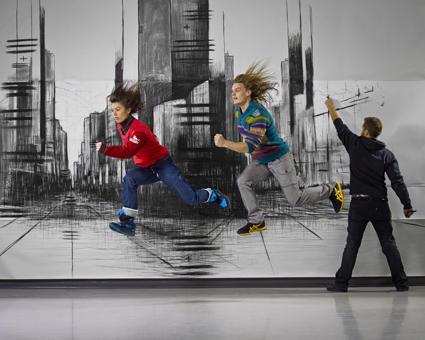
Worldhood
photo Chris Herzfeld
Worldhood
premieres aplenty
Two weeks ago (July 12) we mentioned Lisa Griffiths and Craig Bary’s new work Side to One, which premieres at the Adelaide Festival Centre on July 27. Next month the venue will play host to another world premiere, Worldhood, a collaboration between choreographer Garry Stewart (see his profile in RealTime Dance) and Adelaide artist Thom Buchanan. While dancers from the Australian Dance Theatre and the Adelaide College of the Arts move, Buchanan will create dramatic charcoal drawings live on stage: “his frenetic mark-making, fuelled by hundreds of visual decisions per minute, recalls artists like Frank Auerbach, Alberto Giacometti and Cy Twombly” (RT67). Later in August, the Centre will also present the Australian premiere of Gabrielle Nankivell’s solo performance I Left My Shoes on Warm Concrete and Stood in the Rain. Nankivell has spent the past decade working with some of Europe’s groundbreaking choreographers; on this occasion she is collaborating with composer Luke Smiles and Bluebottle, whose striking designs have been featured in the work of Jenny Kemp (RT99), Balletlab (RT93) and Michelle Heaven (Dance Massive), among many others. The show is part of A Mini Festival of New Performances, copresented with Mobile States and features four shows in five days including Vivaria by Sam James (reviewed in RT97, artist interview in RT91), En Route by One Step At a Time Like This (RT94, back when they were still bettybooke) and The Harry Harlow Project by Insite Arts (RT95). Worldhood, Aug 10-13, I Left My Shoes on Warm Concrete and Stood in the Rain, Aug 24-27, part of A Mini Festival of New Performances, Aug 23-28, Adelaide Festival Centre, www.adelaidefestivalcentre.com.au
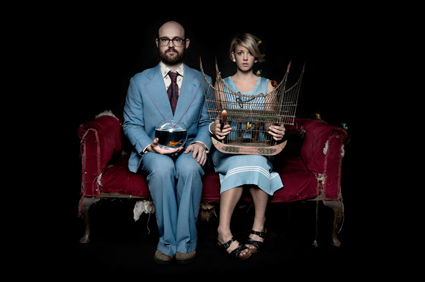
Fuse, STRUT Dance
photo Eva Fernandez
Fuse, STRUT Dance
motion and emotion
There’s more dance on offer over in the west, where PICA is presenting STRUT Dance (see all of our previous reviews of STRUT in the RealTime Dance Archive), as part of its performance program. (In May they presented My Darling Patricia’s Africa RT94 and this month they presented Team Mess’s This Is It.) Directed by Jonathan Buckels (RT86), Fuse is a full-length dance work based on the relationship between two people: “through the cycle from strangers, to friends, towards cohorts, through dependents and on to parasites. Love can give you the chance to change almost any facet of yourself in order to fit the needs of the object of your desire. But if your love is reciprocal, shouldn’t they also change for you? Will this create positive perpetual motion, or a destructive vicious circle? Can those within the relationship tell which of these paths they are on?” (website). Buckels and Rhiannon Newtown (RT94) will be dancing the answer. STRUT Dance, Fuse, Aug 26-Sept 3, PICA, www.pica.org.au
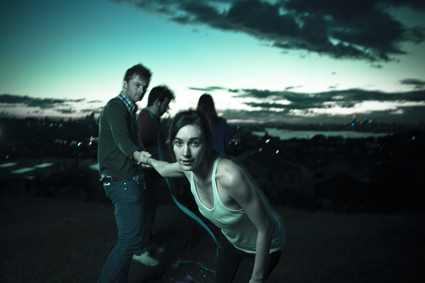
Sweet Bird andsoforth
photo Grant Sparkes-Carroll
Sweet Bird andsoforth
sweet bird of youth
The Australian Theatre for Young People will present the world premiere of German playwright Laura Naumann’s play Sweet Bird andsoforth. Translated by Benjamin Winspear (RT62), and directed by Laura Scrivano, the play starts with a farewell party on the edge of town; but while the group is trapped in an isolated suburban wasteland, their Gen Y dreams transcend any location. Billed as an “original, unexpected and blackly comic story of a group of friends caught between adolescence and adulthood,” the play won Naumann the Munich Prize for Young German-Language Drama (press release). Australian Theatre for Young People, Sweet Bird andsoforth, Aug 18-Sept 10; www.atyp.com.au
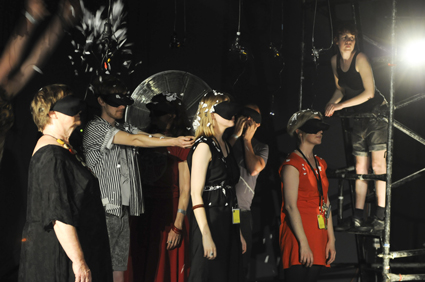
Thrashing Without Looking
photo Heidrun Löhr
Thrashing Without Looking
performance goggles
If you missed Aphids’ work Thrashing Without Looking at LiveWorks, Performance Space, then you might like to get to Melbourne soonish. Divided into two groups the audience watch, create, perform and control their environment in this experiential work. Video goggles are provided to the first group who watch and interact directly with a series of bold transformative images unfolding live in front of them as the second group help create the imagery. Fiona McGregor wrote: “It provoked all sorts of thoughts about the modes of disembodied communication we engage in now—televisual, internet—how trust and agency are still called upon and how intense and liberating is the sense of touch. There were moments of alienation, boredom, confusion, anticipation, humour and the ending was surprisingly tender. I didn’t want to leave” (RT101). Aphids, Thrashing Without Looking, Arts House, North Melbourne Town Hall, Aug 3-7; http://aphids.net
RealTime issue #103 June-July 2011 pg. web
© RealTime ; for permission to reproduce apply to realtime@realtimearts.net
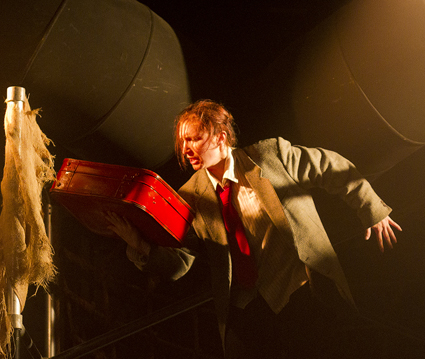
Belinda Raisin, Dead Cargo
photo Leesa Connelly
Belinda Raisin, Dead Cargo
METRO ARTS HAS ALWAYS BEEN A HOME FOR INDEPENDENT PRODUCTIONS IN BRISBANE, BUT SINCE LIZ BURCHAM’S APPOINTMENT AS CEO IN 2006, THIS POSITION HAS BEEN BOTH CEMENTED AND STRENGTHENED. BY PROVIDING FUNDING SUPPORT AND PAYING ACTORS DURING REHEARSALS (AFTER WHICH IT’S INTO COOPERATIVE SHARING ARRANGEMENTS), BURCHAM HAS TRANSFORMED METRO INDEPENDENTS INTO A VITAL AND COHESIVE PART OF THE CITY’S PERFORMANCE SCENE. BUT WHY KEEP THE FAITH?
In an interview with Katherine Lyall-Watson, Brisbane icon Eugene Gilfedder lays out a manifesto: “Independent theatre chooses YOU. It says, come to me, do as I say, work many long hours without wages, get wound up with nerves—you’ll love it. Independent theatre is the HEART and I’ve been honoured to have had so many wonderful people who have been likewise CHOSEN.”
dead cargo
But as an audience you don’t necessarily have to love it. In fact, the first production for the year, Dead Cargo by Tim Dashwood and Nigel Poulton, aroused emotions in me ranging from boredom, disappointment, utter confusion, outrage, repulsion and homicidal feelings towards the protagonists that they also apparently harboured for each other, accompanied by a savage glee that I was experiencing all these emotions. This had the taste of the real thing. It also proved an extraordinary introduction to Meyerhold’s Biomechanics, which he developed in mid-20th century Russia, and which Nigel Poulton now teaches in 21st century Brisbane.
There was one simple action. Three clowns performed riffs on that good old standard prop, the suitcase, fighting for possession until the most recently arrived (and most innocent?) spontaneously gives it away because someone “needs it more,” and then gets himself killed into the bargain for breaking the rules of this closed society. The most absurdly inspired piece of clowning took place at this point as Deb Sampson put one foot in a bucket of water in order to avoid leaving her watery domain to commit the murder. Otherwise, time (itself something of an obsession) was spent in non-stop demonstrations of an infinite capacity to talk past each other.
In my opinion, this aspect of the work was an unintentional red herring. Dashwood and Poulton might have been better off learning from the new existential comedy of British playwright Will Eno rather than flagging the Absurdist theatre of the mid-20th century. In any event, promoting Dead Cargo as contemporary absurd theatre was a bit of a misnomer. Surely—and on the evidence of this production—Meyerhold was closer in time to Expressionism and to the concepts of Artaud’s Theatre of Cruelty. Certainly I was most moved by the stylised recounting by each of the performers at different times of a refugee’s flashback childhood memory involving soldiers “with angry eyes,” a seeming massacre, and their subsequent lonely fall into an abyss of cultural displacement. This was passionately conveyed by the actors and coupled with Jason Glenwright’s lighting and Phil Slade’s sound design, Dead Cargo revealed itself in the end to be a very thoughtful and powerful production.
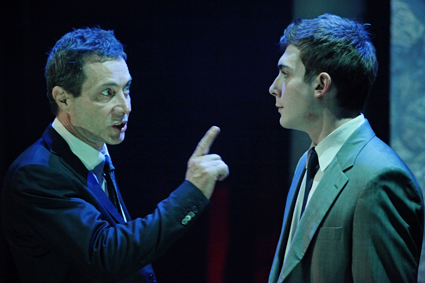
Eugene Gilfedder and Finn Gilfedder-Cooney, Empire Burning
photo Stephen Henry
Eugene Gilfedder and Finn Gilfedder-Cooney, Empire Burning
empire burning
Eugene Gilfedder’s The Fiveways was the bright gem in the 2009 Brisbane Festival (RT87). His latest offering, Empire Burning, has even more profound scope as political allegory with multiple overtones conveyed in the heightened language of a blank verse that was marvellously contemporary and played seamlessly to its audience. I periodically found myself closing my eyes just to relish the words. This was also a tribute to a cast consisting of some of Brisbane’s finest actors who took on the text as their own. This was a theatre of ideas that was as visceral as it was cerebral, requiring us to mentally jump with the alacrity of Gilfedder’s own agile facility to gather worlds.
The piece originated in 2005 when Gilfedder was reading about the influence of the Roman playwright Seneca on the age of Shakespeare (think the graphic violence of Timon of Athens) and at the same time brooding about the so-called war on terror abroad (think Abu Ghraib) as well as attacks on democracy and civil liberties at home. Seneca was also a renowned philosopher and tutor to the young Nero who was named emperor in 54AD and, as legend has it, fiddled while Rome burned. This all became enmeshed in an intense poetic fantasy about an ur-empire in decline rather than keeping to strict historical parallels. This is clear when “we none of us know / What people these are that come through the flames.” The captured terrorist (Dan Crestani) is inarticulate, cannot speak the language…there is nothing to designate him as other than Other. These self-immolating strangers hint at a mysterious interpenetration of the human and supernatural worlds, a mood further enhanced by Geoff Squires’ lighting and Freddy Komp’s projections. Gilfedder recreates something of the feel of classical tragedy with these mysterious epiphanies and symbolic revelations of the divine, however strongly parodic their final delivery in this piece.
There was much to praise in the performances: Gilfedder portraying Seneca as a warm and decent man (especially evident in early scenes with his son), a humanist and democrat increasingly baffled and ultimately overwhelmed by the madness of his times; the cold choice of madness itself a valid response to the times embraced with beautifully modulated nonchalance and fierce humour by Finn Gilfedder-Cooney as Nero; the saturnine ease and contemporary chutzpah of all the conspiring senators; and the power-hungry, domineering Agrippina, mother of Nero, played with flamboyant abandon by Nikki-J Price. This was a work of gripping energy and relevance that has the legs for a lot more miles.
Dead Cargo, director Nigel Poulton, writers Tim Dashwood, Nigel Poulton, performers Nigel Poulton, Tim Dashwood, Belinda Raisin, Deb Sampson, sound design Phil Slade, lighting Jason Glenwright, Metro Arts, Brisbane March 9-26; Empire Burning, writer, director Eugene Gilfedder, performers Finn Gilfedder-Cooney, Eugene Gilfedder, Nikki-J Price, Dan Crestani, Damien Cassidy, Steven Tandy, Sasha Janowicz, Michael Futcher, sound design John Rodgers, Ken Eadie, lighting Geoff Squires, costumes Jess Staunton, visuals/projections Freddy Kemp; Metro Arts, Brisbane May 13
RealTime issue #103 June-July 2011 pg. web
© Douglas Leonard; for permission to reproduce apply to realtime@realtimearts.net
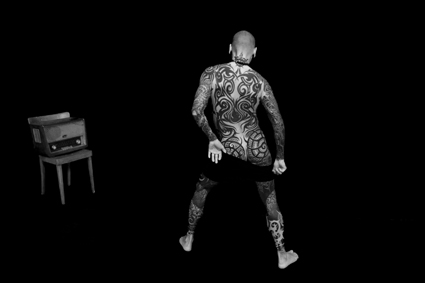
Didi Bruckmayr, The Black Box Sessions
photo Alex Davies
Didi Bruckmayr, The Black Box Sessions
YOU ENTER A DARK CORRIDOR ALONE. IT’S AN ALL ENVELOPING DARKNESS THAT SEEMS TO SUCK THE BREATH FROM YOU, BUT BY SLIDING YOUR HAND ALONG THE WALL YOU CAN NAVIGATE TOWARDS THE SMALL LIGHT THAT EVENTUALLY APPEARS IN THE DISTANCE—A PEEPHOLE. PEERING IN YOU SEE A SMALL SCREEN DISPLAYING INFRARED CCTV FOOTAGE OF A ROOM. SOMEONE IS ALREADY IN THE ROOM OVER IN THE CORNER WITH THEIR BACK TO YOU. YOU WONDER, “WHO IS THAT LOOKING INTO THAT PEEPHOLE?”
Some people recognise themselves faster than others and this moment of realisation is almost enough in itself. Looking at yourself looking at yourself—seeing one ‘you’ who is thinking about how it is seeing this other ‘you’—creates a phenomenological mirror of infinity that leaves you gasping. But there is more to Alex Davies’ The Black Box Sessions. You are here to see a show that will be performed in this room, just for you.
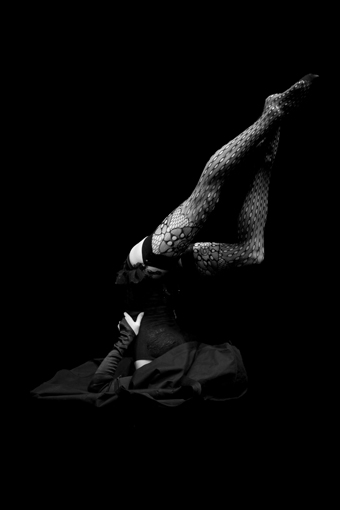
Annabel Lines, The Black Box Sessions
photo Alex Davies
Annabel Lines, The Black Box Sessions
I peeped at three acts randomly selected from the 30 performances by Australian and international performers. The lovely, leggy Annabel Lines escaped gracefully from a sack to hula-hoop for me; Didi Bruckmayr revealed his fully tattooed corpus in a rough striptease; and Patrick Huber tried to tell me, in his rambling way, about what a great actor he is. The performances are not always astounding and some are looser and more haphazard than others. The most successful moments occur when actions reinforce the sense of the darkened space and the performance is directed specifically to you. But even when the illusion is faltering, the sense that the action is taking place just behind you is hard to shake, heightened by the well-spatialised audio. The compulsion to look behind is strong, but when faced with the void you turn back to the screen for the mediated comfort of yourself and your performer.
The Black Box sessions continues Davies’ explorations into mixed reality environments first successfully realised in his installation Dislocation (2005, see RT70 and RT88). In this earlier work the room is visible in both the virtual/screen and real worlds, and the apparitions don’t tend to do much that is out of the ordinary. They are looking at the work as you are with the occasional anomaly of a barking guard dog or an argument. This mundanity creates a kind of ruptured reality. In The Black Box Sessions, the disorientation created by the utter darkness—the inability to match the screen view with the physical space—and the overlaid construction of the peep show creates a much stronger sense of entering a consensual fantasy. This is reinforced by Davies’ extension of the peepshow premise out in the foyer where a monitor placed on the gallery attendant’s desk shows CCTV footage of the waiting room (with you in it) and the adjoining dressing room with the performers undertaking their pre-show preparations. It’s a nice touch though easy to miss if you don’t have to wait too long to enter the corridor.
Like all Davies’ works, The Black Box Sessions is impressive from a technical perspective as the real-time video interaction is seamless and its complex machinations completely invisible. Davies’ playful attention to detail really invites you into this fantasy world. However this finessing reinforces the central wonder—first established in Dislocation and iterated here—of the perceptual and conceptual mind-bending that occurs as you try to reconcile your position in this world, being simultaneously inside and outside yourself. You will never look at yourself in the same way again.
Alex Davies, The Black Box Sessions, performers Celia Curtis, Annabel Lines, Chas Glover, Las Venus, Patrick Huber, Didi Bruckmayr, Roland Penzinger, Justin Shoulder, Matthew Stegh, Scott Sinclare; UTS Gallery, Sydney, May 31-July 15
RealTime issue #103 June-July 2011 pg. web
© Gail Priest; for permission to reproduce apply to realtime@realtimearts.net
from organisation to institution
Like the Performance Space in Sydney several years ago, Performance Space 122 in New York is experiencing growing pains. But whereas its namesake chose relocation, PS122 chose renovation. In the meantime, however, it will be a bit like a government in exile, presenting performances in London as well as co-presenting work with Crossing the Line, an innovative interdisciplinary festival in New York. The new building comes not long after PS122’s 30th anniversary, adding to the sense of a shift from being a mere venue or organisation to something of an institution. Indeed, the list of participants at the anniversary party reads like a roll-call for the avant-garde: The Wooster Group, Split Britches, Mabou Mines, Philip Glass, Big Dance Theater, Elevator Repair Service etc. It will be interesting to see how artistic director Vallejo Gantner balances this inheritance with the need for innovation and experimentation. For more information, see Claudia La Rocco’s article in the New York Times. PS122, www.ps122.org
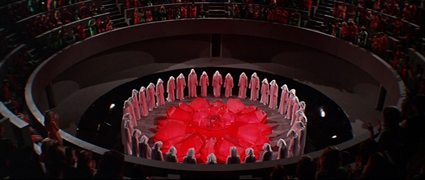
The Carousel, Soda_Jerk
video still courtesy the artists
The Carousel, Soda_Jerk
remix: the remake
You’ve seen the sequel (RT83), now see the director’s cut! The Sydney-bred, Berlin-based sisters of Soda_Jerk (Dominique and Dan Angeloro) will be premiering Pixel Pirate 2: The Director’s Cut (2011) at the Revelation Perth International Film Festival on July 22. Billed as a work that “reimagines the role of cinema, the function of entertainment and lays down the gauntlet for all who want to uphold traditional notions of image and sound” (website), it will appear alongside four short films by Tony Lawrence, including Goldtop Mountain, Girl on Fire, Monsignor Blood and From Water. Both Soda_Jerk and Lawrence will be in attendance for a Q&A afterwards. Soda_Jerk will also appear at the Fremantle Arts Centre where they will be debuting The Carousel, a “dark and compelling presentation that is part lecture, part video performance…Navigating their way through an elaborate matrix of film samples, the artists will unearth a hidden history of cinema that traces the capacity for recorded media to seemingly reanimate the dead” (website). Soda_Jerk, The Carousel, Fremantle Arts Centre, July 21, www.fac.org.au; Soda_Jerk vs Tony Lawrence, Revelation Perth International Film Festival, July 22, www.revelationfilmfest.org
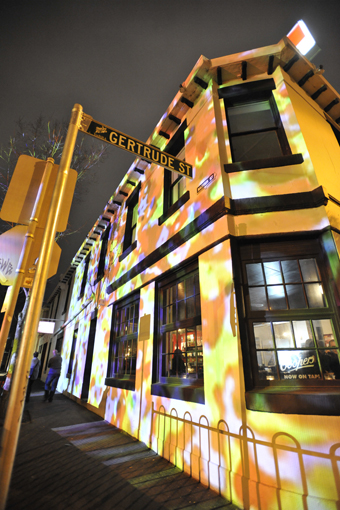
Ian de Gruchy, Gertrude Hotel
photo Bernie Phelan
Ian de Gruchy, Gertrude Hotel
the real fitzroyalty
There will be a similar combination of the live and the mediatised at this year’s Gertrude Street Projection Festival, on from July 22 to 31 (keep an eye out for Kate Warren’s review in our September 5 e-dition). On the evening of July 27, you can go to the Atherton Gardens Estate to hear Stories Around the Fire: The Hidden History of Aboriginal Fitzroy, which features “the memories, cultural knowledge and stories of our real Fitzroyalty: the Traditional Owners, Elders and respected Aboriginal community members of Fitzroy” (website). Later in the week, there is a walking tour of the site, where you can learn more about the locations and the artists, including Olaf Meyer (RT76, RT86, RT86), Ian de Gruchy (RT64), Kit Webster (whose projections were seen at Dance Massive), Arika Waulu, Yandell Walton (RT85), Nick Azidis, Lindsay Cox, Salote Tawale, Rowena Martinich and Greg Giannis. On the final Friday there is Sensory Overload, a night of music and projected art at the Workers Club. Gertrude Projection Festival 2011, July 22-31; www.thegertrudeassociation.com
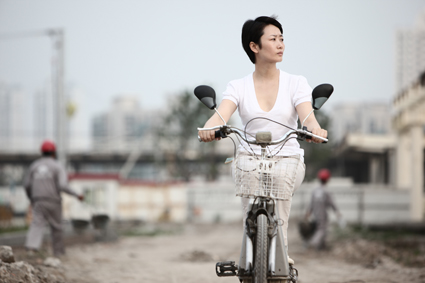
I Wish I Knew
full of film
Still in Melbourne, and still on screens, it’s time for the Melbourne International Film Festival. The opening night features The Fairy, a Belgium-French-Canadian-Australia collaboration which “pays homage to Chaplin, Keaton and Jacques Tati [with] a few added contemporary socio-political twists” (press release). Other highlights include the world premiere of Fred Schepisi’s (RT87) The Eye of the Storm, which is based on the Patrick White novel and features Geoffrey Rush, Judy Davis and Charlotte Rampling. Other Australian films include David Bradbury’s (RT71) documentary about Paul Cox (RT48, RT50, RT51) On Borrowed Time, Michael Rymer’s Face to Face and Jon Hewitt’s X. International films worth investigating include Alexei Balabanov’s (RT92) A Stoker and Jia Zhang-ke’s I Wish I Knew (see Dan Edwards’ appraisal of his work in our Contemporary Chinese Cinema archive highlight) as well as Dreileben, a triple-bill of 90-minute movies made by German writer-directors Christian Petzold (RT79), Dominik Graf and Christoph Hochhäusler. Dreileben is part of a new program called Prime Time, which focuses on works made for television by directors best know for their cinema—an interesting and important idea in an era when Martin Scorsese is directing episodes of Boardwalk Empire for HBO. Primetime will also premiere the first two episodes of the ABC TV series The Slap, based on Christos Tsiolkas’ novel. Melbourne International Film Festival, July 21-August 7; www.miff.com.au
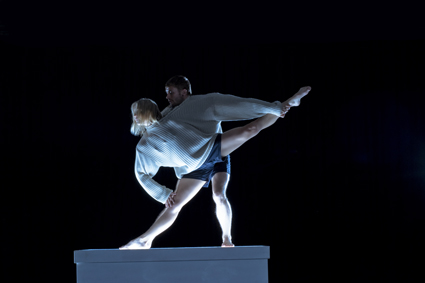
Side to One
photo Chris Herzfeld
Side to One
side to one
Last seen in Tanja Liedtke’s construct (RT83), Lisa Griffiths (RT49) is about to debut her own work Side to One. Choreographed in collaboration with ADT regular Craig Bary (who also danced for Liedtke, see RT61), the piece “follows two individuals destined to connect, attracted like magnets they are never static but constantly evolving” (website). Side to One will premiere in Adelaide, at the Festival Centre, before travelling north to Parramatta Riverside, where it will form part of a season of dance, alongside Martin Del Amo and Ahil Ratnamohan’s Mountains Never Meet (read Gail Priest’s interview with Del Amo in RT103). Side to One, Adelaide Festival Centre, July 27-30, www.adelaidefestivalcentre.com.au; Parramatta Riverside, Aug 10-13, www.riversideparramatta.com.au
RealTime issue #103 June-July 2011 pg. web
© RealTime ; for permission to reproduce apply to realtime@realtimearts.net

John Leary, Samantha Young, Jody Kennedy, Thomas Henning, The Business
photo Heidrun Löhr
John Leary, Samantha Young, Jody Kennedy, Thomas Henning, The Business
NEOLIBERALISM’S NEO-DARWINIST RALLYING CALL, GORDON GECKO’S “GREED IS GOOD” (WALL STREET, 1987), REMAINS LARGELY UNDISCREDITED DESPITE THE LESSONS OF THE GFC, SO EMBEDDED IS THE ETHOS OF SELFISHNESS IN EVERYTHING FROM TV ADVERTISEMENTS WHERE PEOPLE PINCH FOOD, BOYFRIENDS AND CARS FROM FAMILY OR FRIENDS, TO REALITY TV’S CRUDE AND CRUEL ELEVATION OF SOLE SURVIVAL OVER COOPERATION, TO THE PERSONAL PRONOUN-ISM OF SELFHOOD INITIATED BY MYSPACE AND CONFIRMED BY MYBUS, MYSCHOOL, IPHONE AND THEIR SUNDRY IMITATORS.
The corresponding failure of public empathy over issues like asylum-seeking (save at the safe distance offered by donating to charities subsequent to natural disasters) and the reinvigoration of 19th century-style philanthropy (as the gap between wealth and poverty again radically widens) provides the depressing context for Belvoir’s production of Jonathan Gavin’s bitterly funny The Business. It’s set in the 1980s, the very period in which the ‘greed is good’ ethos was getting into its public stride—and we still march to its insistent step in 2011. The world of The Business feels quite like home.
Grossly self-obsessed behaviour is central to Gavin’s bitter-black comedy of bad manners and inheritance snatching, with director Cristabel Sved and costume designer Stephen Curtis wickedly ramping up the rude behaviour and appalling dress sense of the characters to the edge of grotesquerie, but somehow without losing the sense of these people as real, thwarted and, at times, oddly innocent and certainly pathetic—such is their tunnel-vision of the world.
Gavin and Sved took their cue for The Business from Russian writer Maxim Gorky’s grim, sometimes comic play, Vassa Zheleznova, which premiered in 1911 and was later a favourite of Stalin who saw it many times, presumably enjoying the agonies of a bourgeois family in their act of self-destruction (and enforcing changes to the play in 1935 to suit his tastes). Gavin’s play is based on Gorky’s; it is not an adaptation. But in both there is a shared, strong focus on the female characters.
In Gorky’s original, Vassa, wife to a shipping agent, Zheleznova, is relieved when her husband dies—at the end on Act 1 as opposed to the wrenching, protracted and off-stage decline in Gavin’s play which ups the suspense and complications of the mother and her disaffected daughter’s machinations to secure the inheritance the household patriarch would have denied them. Zheleznova’s death is also a relief because the charge of raping a 12-year-old servant girl will now not go to court. Vassa battles on alone, corralling daughters and servants, bribing dockworkers and police and bickering with her estranged socialist daughter (torn between motherhood and the life of a revolutionary) over possession of the latter’s child. The pressure is such that Vassa dies at the play’s end, an exhausted manipulator. Gorky’s empathy for her is limited, but he makes it clear that as well as being a nasty bourgeois she is to varying degrees a victim, though never without fight.

Kate Box in reflection and Thomas Henning, The Business
photo Heidrun Löhr
Kate Box in reflection and Thomas Henning, The Business
The Business’ 1980s family is immigrant in origin (no coffee, just a steady flow of tea), wealthy, the adult Australian-raised offspring and their spouses child-like and spoilt. The runaway daughter Anna (Kate Box) returns home, apparently more principled than the rest but, like her mother, Van (Sarah Pierse) embittered by her father’s mistreatment and ready to conspire with Van to seize the inheritance from the ne’er-do-well siblings who would promptly sell-off the family business. As with Belvoir’s Wild Duck (RT102), the social and political context inherent in the original play has no substantial contemporary equivalent in The Business, which seems a pity given the rich complexity and contradictions of 1980s Australian politics. Although this is frustrating it certainly amplifies the sheer vacuity of an emerging materialist life-style culture—save for its business (unlike Vassa’s, only vaguely indicated) this family lives in a closed circuit of vituperation, envy and a refusal to forgive.
The plays by Gorky and Gavin share the same spirited assault on the bourgeoisie—but what at first seems grimly frantic and comic slips into dispirited horror. Gorky’s Vassa demands that her husband suicide (he dies without resort to that but there is no grieving); Gavin’s Ronald (Van’s crippled second son; Thomas Henning) kills his wife’s lover Gary (Russell Kiefel) and the family dutifully manages the cover-up. Not least because the principal mother-daughter relationship is more nuanced and the two women win out, The Business comes off as more complex than Gorky’s Vassa Zheleznova (incidentally The Business appears to borrow some of its plot from the even grimmer Egor Bulychev where a wealthy father is dying, initiating a struggle for his property).
The Business might represent a victory for women but not necessarily for integrity or compassion, as if to say the legacy of the 80s is a greedy, self-serving, culture, whose children live in luxury and surly disaffection, emasculated by their parents who completely control the business. In this world Van must live on, the legacy doubtless intended for a daughter who will become like her mother, or already has.
If The Business is not strong on 80s politics and culture, the specificities of time and place are largely left to design (Victoria Lamb)—an aptly tackily furnished, expensive modernist home with Californian bungalow open stone walls, a lounge room replete with board games for children who will never grow up, and a sunny porch that becomes a site for unexpected violence. Costumes (Stephen Curtis) and hairstyling are comically acute, viciously accentuating character traits and some of the fashion follies of the period. Van’s power-dressed shoulders and daughter Anna’s great height pushed up by heels and hairstyle immediately suggest competing forces. The casual wear and pronounced body shapes of the other brattish siblings, Simon (John Leary) and Natalie (Samantha Young), amplify their laziness while the arch-backed, lank-haired, bare-chested wild-child Ronald (Henning) lurches about like a purposeless Iggy Popp. A persistent soundtrack of 80s pop ranging from the execrable to the arty further compounds the period sense. The family lives inside this bubble. The business is not loved—it’s simply what it means in terms of survival or sustained leisure.
The one aspect of the family business that is focused on is a legal suit against it for the death of a worker who refused to wear a protective mask (“What is OH&S anyway?”). Van simply doesn’t want the company to accept responsibility—the victim was, after all, a chronic smoker. This is the world of The Business—a selfish society that doesn’t care enough for itself let alone others. Simon puts it in context, his: “I started buying art works from the coons across the river. I give then 10 bucks for a dot painting then I can sell it for two hundred. Hello. People buy that shit. And the guys I buy from are not gonna sue me for negligence or cry to Four Corners because the ventilators in the workshop stop running.”
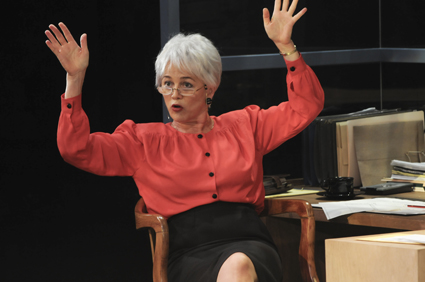
Sarah Peirse, The Business
photo Heidrun Löhr
Sarah Peirse, The Business
Inevitably, a limited range of concerns and character traits generates grotesques, utterly without empathy for the dying father (who clearly showed none to them) and locked in a bitter fight for an inheritance that Van has worked so hard for but that others simply feel they deserve. Emotions run to extremes but in Van we can see the fluctuating degrees of frustration, anger, near defeat and the need for reconciliation with Anna, even if it entails compromise. Van shows some compassion for the adulterous daughter-in-law Jennifer (Jody Kennedy)—even, as in Gorky’s original, working with her in the garden. The rest is misunderstanding, confusion, blindness and occasional insights that can’t be explored—Jennifer: “We’re all unhappy; none of us know how to love anything.” The best she can sadly come up with is: “I’m a human mix tape.” Van herself can barely live up to what she expects of her children: “These young people. ‘Duty,’ ‘consideration’—foreign concepts. I keep hoping one day they’ll grow up.” Her relationship with her husband is just as muddy: “So what? Maybe he was violent and drunk and yes he cheated on me, but it’s men like this who made this country what it is.”
What makes The Business potent is its emotional cruelty presented in the guise of comedy, sometimes bordering on farce, rich in gags (the business over a dead parrot, the nouveau riche ‘luxury’ of croissants stuffed with Fruit Loops), in explosive tensions and, not least, suspense (who will get the inheritance?)—and then shock. Director Cristabel Sved and her cast are endlessly inventive, keeping these monsters believable. If you were hoping for empathy and compassion and felt short changed then The Business was not for you—like Gorky’s original, this is tough social satire, even if Gavin is a tad more forgiving. And sometimes tougher: a communal sing-along in the Gorky is replaced with the dissolute Simon and Natalie’s faithful rendering of a ‘Tab cola’ jingle, followed by Simon’s “Want a root?” It’s that kind of play, that kind of world. In the current political climate we’re hardly in a position to deny it.
Performances in The Business were uniformly excellent, underpinned by a strong sense of ensemble. Sarah Pierse’s Van rarely allows her bitterness to defeat her purpose or her anger to overrule the requisite moments of compassion or opportunity. Pierse plays out Van’s considerable contradictions without doubt. Kate Box as the returning prodigal with a purpose is all elegance and bottled restraint almost ready to act but when she does so it is with reason as well as anger. Jody Kennedy as Jennifer is slatternly but engagingly sensitive; Grant Dodwell as the company manager is gentle and fair—if an ignored moral compass; Russell Kiefel is strong as Gary the apparently easy-going but embittered brother of Van’s dying husband; John Leary and Samantha Young are an horrendous couple, the ultimate uncaring brats, bravely played with physical and vocal verve; and Thomas Henning is the crippled Ronald who believes himself unloved—and he is, the best his mother can do to cover the murder of Gary is to have the boy committed to a psychiatric clinic. Henning’s Ronald is physically confined to his staggering gait but, when not pathetically self-aware, always on the edge of exceeding his emotional borders. In working from Gorky’s Vassa Zheleznova, Jonathan Gavin has created a play that is his own, one finely realised by his collaborators and, sadly, a play for and of our times.
–
Belvoir: The Business, writer Jonathan Gavin, based on Maxim Gorky’s Vassa Zheleznova, director Cristabel Sved, performers Kate Box, Grant Dodwell, Thomas Henning, Jody Kennedy, Russell Kiefel, John Leary, Sarah Pierse, Samantha Young, set design Victoria Lamb, costumes Stephen Curtis, lighting Verity Hampson, composer/sound Max Lyandvert; Belvoir St Theatre, Sydney, April 27-May 29; www.belvoir.com.au
RealTime issue #103 June-July 2011 pg. web
© Keith Gallasch; for permission to reproduce apply to realtime@realtimearts.net
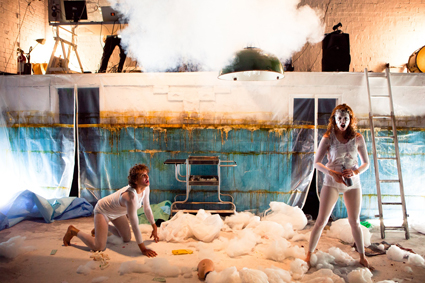
Simon Corfield and Sarah Enright, Trapture
photo courtesy of the artists
Simon Corfield and Sarah Enright, Trapture
ALL PLEASANT BREAK-UPS ARE ALIKE; EACH UNPLEASANT BREAK-UP IS UNPLEASANT IN ITS OWN WAY. WHICH IS WHY THE ONE AT THE HEART OF SARAH ENRIGHT AND SIMON CORFIELD’S TRAPTURE IS SUCH A CURIOUS THING: BY ATTEMPTING TO COVER THE UNPLEASANT BREAK-UP FROM EVERY CONCEIVABLE ANGLE—TO GIVE US, IN A SENSE, THE UR-BREAK-UP—THE PRODUCTION DOESN’T GET TO THE ESSENCE OF THE MESSY SEPARATION SO MUCH AS MERELY PRESENT US WITH A GENERALISED SURVEY OF ITS MOST COMMON AND PREDICTABLE FORMS. THE RESULT IS A PAGEANT OF MILLS & BOON METAPHORS LITERALISED AS STAGE GROTESQUERIES: AN AT TIMES HILARIOUS, BUT ALWAYS SUPERFICIAL, BREAKDOWN OF THE BREAK-UP.
The evening begins with an embrace. Enright, her mouth taped up and her wide, slightly unhinged-looking eyes meeting yours, takes your ticket, asks with a silent gesture if you would like a hug, and then takes you in her arms. The Old Fitzroy’s little theatre has been done up to resemble one of those plastic-draped rooms in otherwise empty warehouses where psychopaths wine and dine their victims before hacking them to pieces. This, as we will soon learn, is appropriate: of all the things to which Enright and Corfield compare the break-up, the most notable are disembowelment and related acts of torture. The central conceit of the piece is to realise emotional violence as physical violence.
This is, of course, something we do every day when we equate the two in language. A pleasant break-up is what you get when both parties choose to “end the relationship.” An unpleasant one is what you get when the metaphors start creeping in: when the man “emotionally raped me” or the woman “tore my heart out.” Men become “pigs” and women “bitches.” One party claims the other can “eat my shit.” For Pat Benatar love is a “battlefield.” Kramer Vs Kramer and The War of the Roses—Danny De Vito’s, not William Shakespeare’s—incorporate this idea of conflict into their titles. And Trapture seeks to give each of the above its time in literalism’s spotlight.
The show begins with Enright and Corfield dressed for a fancy date, making their way to a couch at the far side of the stage. She blindfolds him—he thinks it’s foreplay—before taking out a suitcase, throwing a few things into it and leaving him sitting there. When he finally realises what has happened, things really begin to fall apart: Enright re-emerges, dressed in surgical garb and gives her former partner a sex-change operation. Sporting a Koskian prosthetic and killer heels, Corfield waves his new vagina around in the faces of those in the front row. The performers climb into the audience, invading personal space. Masks emerge. Corfield becomes a pig and Enright a dog, the former forcing the latter to eat his shit and smearing it across her mouth. They throw bedpans of urine at one another.
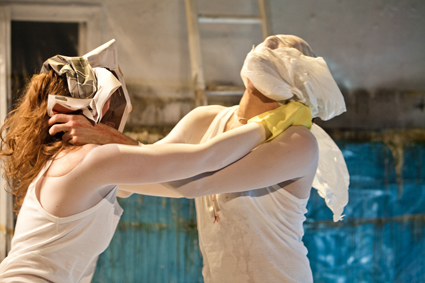
Sarah Enright and Simon Corfield
photo courtesy of the artists
Sarah Enright and Simon Corfield
In the production’s most graphic and unsettling scene, Corfield dons a clown mask and rapes Enright. She gets her revenge by sticking her hand into his chest and tearing out a cow’s heart. It’s an image straight out of The Simpsons episode “New Kid on the Block” and it is difficult for anyone familiar with that episode to take its recreation here very seriously. Indeed, I found myself marvelling less at the literalisation of the metaphor—which, as The Simpsons’ writers understood only too well, is not so much profound as hilarious—than at the fact that the actor had been wearing a bloody bovine organ strapped to his chest for the duration of the performance. Enright cooks the heart on a portable hotplate and feeds it to him. She eats a slice, too. An unholy communion.
All of this is rendered in a visual style reminiscent of visual artist and filmmaker Matthew Barney. Indeed, if Barney were to direct Artaud’s Jet of Blood, he might come up with something like Trapture. Only he wouldn’t. Barney’s use of metaphor is elaborate where Trapture’s is simplistic, providing his work with its deep, architectonic structures which are almost impenetrable. In contrast, Trapture’s structure is not even really that of a break-up, but rather a shopping list. And it’s a shopping list that, in the end, doesn’t really amount to much: referring back to a non-specific idea of a break-up—to the words we use to describe them—even the impact of the rape is lessened.
Shocking stage images, it seems to me, are becoming increasingly less shocking. I would argue that Sydney hasn’t seen a genuinely cutting one since Kosky put Robyn Nevin in Abu Ghraib for The Women of Troy (2008). As with Simon Stone’s Baal at the Sydney Theatre Company, which seems pitched to offend only a certain strata of the audience (namely the aging subscriber base), Trapture seems to suffer from putting too much stock in the inherent force of its images. That force is lessened the more it’s relied upon. It becomes increasingly difficult to care about, to invest in such images, which have less and less to do with the emotional content of an idea and more and more to do with their capacity to inspire walk-outs. Pass the heart.
Sands Through the Hourglass in association with Tamarama Rock Surfers, Trapture, director Shannon Murphy, conceived & performed by Sarah Enright and Simon Corfield, live sound design Basil Hogios; Old Fitzroy Theatre, Sydney, April 21-May 14. Trapture by Sands Through the House Glass won Best Show Sydney Fringe 2010.
RealTime issue #103 June-July 2011 pg. web
© Matthew Clayfield; for permission to reproduce apply to realtime@realtimearts.net
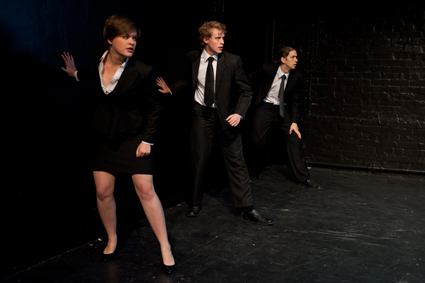
Applespiel, Executive Stress/Corporate Retreat
photo Michael Myers
Applespiel, Executive Stress/Corporate Retreat
HOT ON THE HEELS OF IMPERIAL PANDA COMES TINY STADIUMS—ANOTHER SYDNEY-BASED, SELF-PRODUCED FESTIVAL THROUGH WHICH EMERGING ARTISTS GAIN BOTH EXPERIENCE AND EXPOSURE. THE TWO FESTIVALS SHARE MORE THAN A DIY SENSIBILITY AND A FONDNESS FOR QUIRKY NAMES, THEY ALSO SHARE SOME CURATORIAL TALENT—MISH GRIGOR CURRENTLY SERVES ON BOTH ORGANISING COMMITTEES AND ZOE COOMBS MARR AND EDDIE SHARP HAVE DONE SO PREVIOUSLY. SO IT’S NOT SURPRISING THAT, LIKE IMPERIAL PANDA, TINY STADIUMS PROVIDES A DIVERSE PROGRAM THAT COMBINES LIVE ART IN A VARIETY OF LOCATIONS AS WELL AS SOME MORE THEATRICAL OFFERINGS, INCLUDING A GOOD OLD FASHIONED DOUBLE BILL AT PACT THEATRE.
First on the program is Applespiel’s Executive Stress/Corporate Retreat, which, as you might suspect from its title, is a satirical take on every self-improving, team-building, life-affirming exercise you’ve ever had the misfortune to endure. The show starts with an invitation from a young man in a snappy suit to enrol in the elite club. Several audience members head to the desk while I hang back, until I remember that I am reviewing the piece so I’d better participate. Unfortunately the elite club closes just as I reach the desk—hesitation then rejection, that’s a double fail. Having been photographed and name-tagged, the elite club members now circulate with “ice breaker” exercises, asking the non-elite about our allergies, holidays and siblings. Ice broken, we then do another survey, where the performer poses a question and we stand on one side of the foyer or the other, depending on whether we like tennis, have a father with a drinking problem etc. Finally, we enter the theatre and as we take our seats—elite club at the front, mere mortals at the back—we see several performers in black suits sprinting back and forth across the stage.
The rest of the show basically consists of Applespiel running a corporate workshop, demonstrating an exercise and then directing the elite team to do it on stage. These efforts are then scored and the results displayed in a sort of league table, which is projected onto a large screen upstage. The exercises include mock job interviews, in which participants are asked not only about their strengths and weaknesses but also about which food they most resemble. “An egg” is the recommended answer, for its ability to work solo and in combination with a variety of other ingredients, its balance of protein and fat, not to mention its facility for segueing from one cuisine to another. Do not say “banana” as they are “the first to go missing in a crisis.” Participants are also taught an obscene rhyme in order to remember how to tie the perfect Windsor Knot and led through a strange series of actions to find their totem animal. Last but not least, they close their eyes and vote on each other’s performance.
There are some amusing moments and the premise has real potential, but it isn’t completely fulfilled here. On the night I attend, the elite club members are oddly acquiescent, to the point where I was dying for someone to throw a spanner in the works. But the closest anyone got was when one participant refused to grade the others’ performances, instead giving them all a thumbs up. While this may be due to the nature of this particular ‘team,’ I suspect the problem is structural for the rules of workplace and audience participation are basically the same: as audience members we’re aware that we have entered into a contract, that the performers are depending on us and we don’t want to let them down. These are of course exactly the thoughts of hapless employees as they are conned into doing just one more hour of overtime. Thus, even as Applespiel seek to mock the mindless supplicants of the corporate world, they implicitly rely on their audience to behave similarly. There is much more to be mined here and I was reminded of Jon McKenzie’s book Perform or Else! (Routledge, 2001), an elegant exploration of how corporate, technical and theatrical notions of performance intersect. With this in mind, I look forward to undertaking another “performance review” of Applespiel soon.
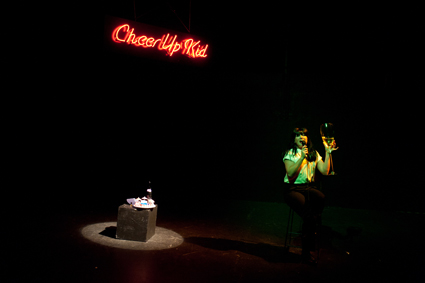
Nat Randall, Cheer Up Kid
photo Michael Myers
Nat Randall, Cheer Up Kid
While Executive Stress employs a cast of thousands, Cheer Up Kid is the work of just one writer and performer—Natalie Randall. She runs on stage wearing a white t-shirt, black pants and the broad grin of a child who has finally coerced the family into sitting down for a living room show. She briefly outlines the structure of the show, noting however that she is “completely unreliable, with no sense of consistency or consequence.” These words are repeated at the beginning of each section, so that we hear the same phrase recited by different characters, in different accents. In the second section, Randall plays a weird and bad-tempered child, who is prone to swallowing whole bottles of Vitamin C tablets, exaggerating her achievements at the school swimming carnival (winning that little known race, the 300 metres), getting swooped by magpies and secretly eyeing off the twice-cooked pork belly while being made to order the chicken schnitzel. In the third section, Randall plays an American agony aunt who slugs back a bottle of Passion Pop while dispensing advice on air, and in the fourth she plays a lonely Englishman scared his parents might die before he does.
Randall has a warm and generous stage presence, and I really enjoyed her performance in Some Film Museums I Have Known, but here she is let down by the writing, which is somewhat underdone. The characters are interesting as individuals but the connection between them, beyond their origin and juxtaposition, is not necessarily clear. Nevertheless the show, and with it the night, comes to a satisfying end when Randall slices up a “pool cake” (a classic from the Women’s Weekly cookbook) and passes it around—a gesture of generosity and hospitality that seems to encapsulate the theatrical act itself.
Tiny Stadiums Festival: Applespiel, Executive Stress/Corporate Retreat, devisor-performers Simon Binns, Nathan Harrison, Nicole Kennedy, Emma McManus, Joseph Parro, Troy Reid, Rachel Roberts, Mark Rogers; Cheer Up Kid, devisor-performer Nat Randall; PACT, Sydney, May 2-15
RealTime issue #103 June-July 2011 pg. web
© Caroline Wake; for permission to reproduce apply to realtime@realtimearts.net
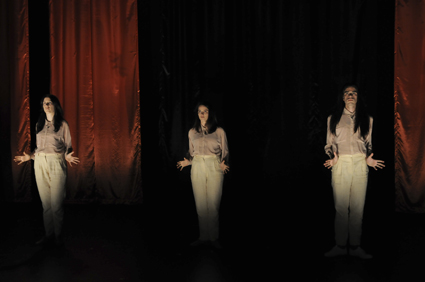
Mish Grigor, Zoe Coombs Marr, Eden Falk, Who’s the Best?
photo Heidrun Lohr
Mish Grigor, Zoe Coombs Marr, Eden Falk, Who’s the Best?
who’s the best?—post is
You’ve only got until July 2 to be seduced and wowed by Post’s infectiously delirious Who’s the Best?, commissioned by Sydney Theatre Company’s Wharf 2 Next Stages program. Once again Post raise daggy amateurism to a sublime artform—and with more professional verve than ever (see the review of Everything I Know About the Global Financial Crisis in One Hour in RT101). This experiment to determine which of the three collaborators and friends is the best performer employs a range of tests from psychological profiling to assessing who’s the ‘hottest.’ These are constantly complicated or sidetracked by hilariously mind bending battles of the Abbot and Costello “Who’s on first” variety over the semantics of category labels and terminology. They’re adroitly woven through the script, recurring as running gags and providing an immersive pulse to the work. The performers’ casual delivery (always played directly to the audience while they freely insult each other) yields intimacy and immediacy on a stage which wickedly threatens to subvert the show as curtains and lighting go about their own business regardless. Trio member and co-devisor Natalie Rose, who has recently had a child, is replaced for the premiere season by a wigged Eden Falk who slips easily into the Post mode while bringing his own wide-eyed comic innocence to Who’s the Best? alongside Mish Grigor and Zoe Coombs Marr. Post, Who’s the Best?, Wharf 2, Sydney Theatre Company, Next stage 2011, June 17-July 2, www.sydneytheatre.com.au
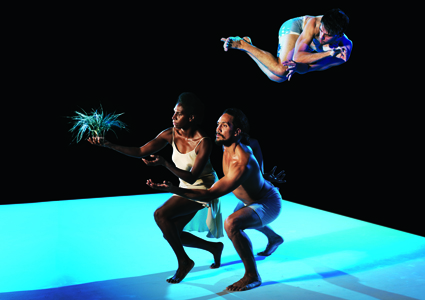
Elma Kris, Waangenga Blanco, Daniel Riley McKinley, Belong
photo Jason Capobianco
Elma Kris, Waangenga Blanco, Daniel Riley McKinley, Belong
new works in naidoc week
Next week is NAIDOC week and there are two exciting premieres to look forward to. In Sydney, the PACT Centre for Emerging Artists is presenting Bully Beef Stew, its first ever fully professional commission. Coming out of its Incubate initiative, a performance laboratory for emerging Indigenous artists, Bully Beef Stew features three young Aboriginal men—Sonny Dallas Law, Colin Kinchela and Bjorn Stewart—working with director Andrea James (former artistic director of Melbourne Workers Theatre) and choreographer Kirk Page. Billed as a “fearless theatrical exploration of Aboriginal manhood,” the piece draws on the personal experiences of the performers as well as their fathers and other men in their lives, past and present (press release).
Further north, Stephen and David Page will be premiering ID as part of Bangarra Dance Theatre’s double bill Belong. (Check out the Stephen Page archive in RealTimeDance.) This new work “draws upon Page’s personal experiences of observing contemporary Indigenous people tracing their bloodlines, reconnecting with their traditional heritage and living modern lives in a challenging urban society” (press release). The second new work of the evening, About, comes from emerging choreographer Elma Kris. The rise of Kris, Daniel Riley McKinley (RT98) and Vicki Van Hout (RT104) makes this an exciting time for contemporary Indigenous dance. The double bill will tour nationally. Bully Beef Stew, PACT Centre for Emerging Artists, June 29-July 9; www.pact.net.au; Bangarra Dance Theatre, Belong—ID and About, QPAC, July 1-9, then touring to Sydney, July 20-Aug 20, Perth, Aug 25-28, Canberra, Sept 2-3, Wollongong, Sept 8-10, Melbourne, Sept 15-24; www.qpac.com.au, www.bangarra.com.au
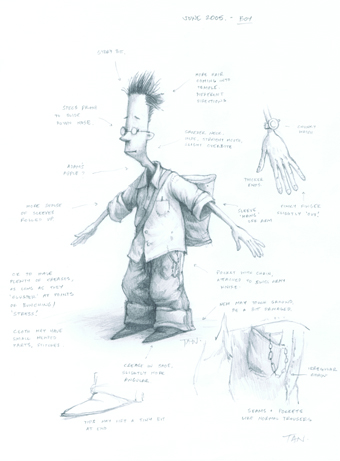
The Lost Thing
image courtesy of the artist
The Lost Thing
the lost thing found at the powerhouse
Still in Queensland, and just in time for the school holidays, the Brisbane Powerhouse presents Shaun Tan: The Art of the Story, a free exhibition showcasing the art of the Academy Award winner and children’s illustrator. On display will be limited edition prints of illustrations from his books The Rabbits, The Red Tree, The Lost Thing, Tales from Outer Suburbia and The Arrival (we reviewed Red Leap theatre’s adaptation of The Arrival in RT94). The exhibition also features the film version of The Lost Thing, which won this year’s Oscar for Best Short Animation as well as last year’s Yoram Gross Animation Award at the Sydney Film Festival (RT98). Shaun Tan: The Art of Story; June 28-July 10; www.brisbanepowerhouse.org
underbelly
In the wake of Imperial Panda (reviewed in our last e-dition) and Tiny Stadiums (reviewed in this one), comes another Sydney-based arts festival—Underbelly (see the interview with director Imogen Semmler in RT103). Previously staged at CarriageWorks (RT80) and Queen St Studios and surrounds in Chippendale, this year the festival heads to Cockatoo Island in Sydney Harbour. The festival proper is on for only one day, on Saturday July 16, but a 10-day preliminary program, The Lab, allows audiences to visit during the development period so they can watch the art unfold that’s been developing for several weeks. If you’re feeling particularly participatory, you can attend an Open Project session and contribute to the development of an anthropological experiment Case Study, Butterfries’ haunted-house inspired The All You Can Stand Buffet and Dan Koop’s The Stream/The Boat/The Shore/The Bridge, a human-scale board game in which the audience are the players. Underbelly Arts Festival, July 3-12, www.underbellyarts.com.au
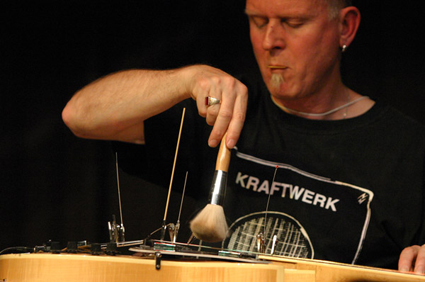
Dave Brown (aka candlesnuffer), Liquid Architecture
photo courtesy of the artist
Dave Brown (aka candlesnuffer), Liquid Architecture
sound flows
For more than a decade, the Liquid Architecture: National Festival of Sound Art has showcased the best of the world of sound art (see our Archive Highlight).This year’s program includes artists Marc Behrens (Germany) who is bringing with him sounds from China and the Amazon rainforest, Pascal Battus (France) who shapes his instruments to match his body gestures and insists on offering the occasional “sound massage” and Lukas Simonis (Netherlands), who in collaboration with Melbourne’s Dave Brown, will display his mastery of guitar improvisation. They are joined by Australians Pia van Gelder, with her own electrical inventions, plus Jon Rose and his ‘Team Music’ live interactive netball game. The festival has already kicked off in Melbourne where it continues until July 2 with concerts running simultaneously in Perth (June 27-28), Bendigo (June 29) and Brisbane (July 1). Arriving in Sydney on July 2, Liquid Archtecture will feature two free concerts at the Eugene Goossens Hall in the ABC’s Ultimo Centre, Sydney (no booking required) and Battus’ Sound Massages on July 3. If you can’t be there in person, you can hear the performance broadcast that night on ABC Classic FM’s New Music Up Late. Liquid Architecture: National Festival of Sound Art, June 27-July 3; www.liquidarchitecture.org.au; www.abc.net.au/classic/newmusic
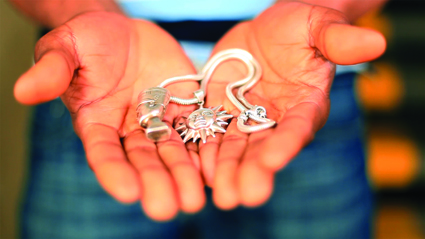
Show and Tell
scenes from the arab spring
Since last year’s Arab Film Festival, there have been revolutions in Tunisia and Egypt, a civil war in Libya, uprisings in Bahrain, Syria and Yemen, major protests in Algeria, Iraq, Jordan, Morocco and Oman and minor protests in Kuwait, Lebanon and Saudi Arabia. In other words, it’s a time of incredible change. Now in its 10th year (see our reviews from 2007 and 2010), this year’s Arab Film Festival presents 22 “front-line stories” from around the region, many of which have been presented at recent festivals in Cannes, Dubai, Berlin and Sundance. Highlights include Sarkhat Namla (The Cry of an Ant), the first feature film to address the Egyptian Revolution this year; Stray Bullet, which features Lebanese actress Nadine Labaki in her first role since the internationally acclaimed Caramel; and Into the Belly of the Whale, where we follow a man trapped in the supply tunnels under the border zone between Israel and Egypt. Local films include Mary, a story of neighbourly espionage in Western Sydney, and Show and Tell which examines the link between object and memory of recently arrived refugees in Sydney. There’s also a forum on July 1 titled Revolution, Romance, Realities, which will address “how new media has facilitated a critical mass movement, amplifying everyday voices, transmitting images globally” (press release). Speakers include Dr Paula Abood, Randa Abdel Fattah, Farid Farid and Sameh Abdel Aziz. The festival will then tour to state capitals. 2011 Arab Film Festival, Sydney June 30-July 3, Melbourne July 8-10, Canberra July 14-17, Adelaide July 23-24, Brisbane July 30-31; www.arabfilmfestival.com.au
life after death in venice
In our most recent print edition, we interviewed Anna Teresa Scheer about the work of Christoph Schlingensief (RT103). Schlingensief died of cancer in August 2010 at the age of 49, but a few months prior curator Susanne Gaensheimer had approached him to design the German Pavilion at the 54th Venice Biennale in 2011. Instead of abandoning the project completely, or attempting to realise it exactly as the artist had imagined, Gaensheimer chose a middle path, presenting Schlingensief’s plans in book form ahead of the event and then using the event itself to show a selection of his works, without attempting a retrospective. She was rewarded for her efforts on June 4, when the German Pavilion was presented with the Golden Lion for Best National Participation. You can see the announcement on the Biennale’s YouTube channel, read an interview with Gaesheimer in Deutsche Welle and an interview with Schlingensief’s widow Aino Laberenz in Der Spigel. For footage of the pavilion itself, see Vernissage, the official website Deutscher Pavilion and Schlingensief’s own personal website.
RealTime issue #103 June-July 2011 pg. web
© RealTime ; for permission to reproduce apply to realtime@realtimearts.net
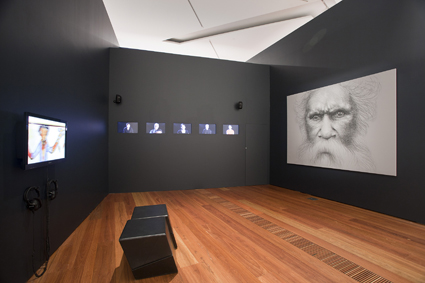
Vernon Ah Kee, Ideas of Barak 2011 Brisbane, Queensland charcoal on canvas, video installation, Felton Bequest 2011
THE NATIONAL GALLERY OF VICTORIA MARKED ITS 150TH BIRTHDAY IN MAY. IN ADDITION TO THE OCCASION’S DOMINANT NARRATIVE CELEBRATING AUSTRALIA’S OLDEST PUBLIC ART GALLERY, THE NGV ALSO USED ITS MILESTONE TO ENGAGE WITH AND FACILITATE BROADER REMEMBRANCE OF ONE OF VICTORIA’S MOST IMPORTANT ARTISTIC AND HISTORICAL FIGURES—WILLIAM BARAK. THROUGH A SERIES OF COMMISSIONS AT NGV’S IAN POTTER CENTRE, THE LIFE AND LEGACY OF THE WURUNDJERI LEADER HAS BEEN PROMINENTLY RE-PRESENTED AND RE-IMAGINED.
Barak’s life (c1824-1903) encompassed a period of intense change and trauma for his people. As a boy he was present at the signing of the 1835 Treaty between members of the Kulin people and John Batman, and as ngurungaeta (clan leader), Barak was a skilled diplomat and politician. He would famously walk from Coranderrk (near Healesville) to Melbourne to negotiate and fight for the rights and living conditions of his people—devastated and immeasurably changed after Batman’s treaty (see Bruce Pascoe, How It Starts, First Australians, Miegunyah Press, Melbourne, 2008). His legacy as an artist is also vitally important; towards the end of his life Barak produced a number of intricate works on paper that documented the traditions of the Wurundjeri people, ensuring that knowledge of this culture would be preserved and continued for future generations.
Despite the influence and impressive reputation of this Aboriginal leader, the cultural memory of Barak amongst Melbournians and Victorians remains limited. I first learnt about him at the NGV seeing his paintings on display in the Indigenous Galleries. Three new commissions on display by contemporary artists Vernon Ah Kee, Brook Andrew and Jonathan Jones represent an important opportunity to further ingrain the name and story of Barak into the national consciousness and cultural memory.
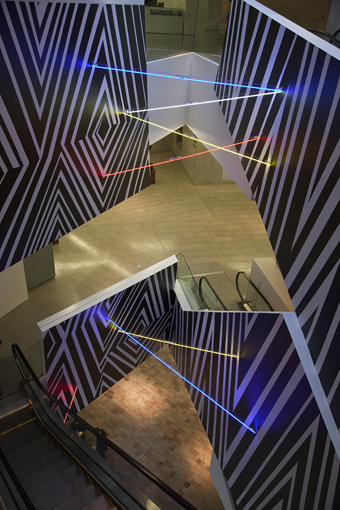
Brook Andrew, born Australia 1970, Marks and Witness: A Lined Crossing in Tribute to William Barak, 2011 Melbourne, Victoria
vinyl wall drawing, neon
Felton Bequest 2011
image courtesy of the artist and NGV Australia
Brook Andrew, born Australia 1970, Marks and Witness: A Lined Crossing in Tribute to William Barak, 2011 Melbourne, Victoria
vinyl wall drawing, neon
Felton Bequest 2011
brook andrew
Brook Andrew’s commission Marks and Witness: A Lined Crossing in Tribute to William Barak is a site-specific work installed in the Ian Potter Centre’s atrium. The recurrent Wiradjuri designs and neon stretch up multiple levels, offering an overwhelming and dizzying entrance to a space which is already monumental in its architecture. Like previous works such as Jumping Castle War Memorial (2010), there is an ironic tension in Andrew’s commission. Contrasting the connotations of formality and permanence in the memorialising process with an ironic and playful interpretation, it eschews the representational mode, offering instead an immersive and experiential form of memorial. It also possesses a sense of the ephemeral, a spectacle that may not be on display indefinitely, thus drawing attention to the relative lack of formal and prominent sites of remembrance dedicated to Indigenous histories and heroes.
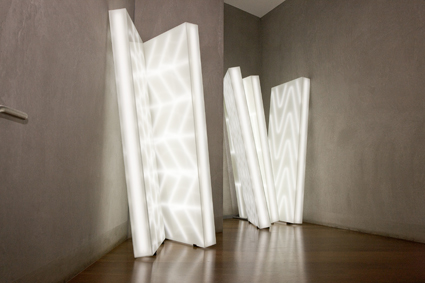
Jonathan Jones, Untitled (muyan)
2011 Sydney, New South Wales
light emitting diodes (LEDs), glass, aluminum
Felton Bequest 2011
jonathan jones
While some historical narratives emphasise the individualistic nature of heroism, Barak’s legacy as leader and artist is fundamentally entwined with the culture of his community. Joy Murphy Wandin, a senior Wurundjeri woman and descendent of Barak, explains the role of the ngurungaeta as those who “take on the responsibility for the entire community” (cited in Pascoe). Thus Barak’s paintings of Wurundjeri ceremonies are not just works by an individual artist, they also reveal the communal practices and celebrations of his people and Jonathan Jones’ commission Untitled (muyan) is inspired by and suggestive of this tradition.
Jones’ piece is composed of five LED illuminated glass light-boxes installed in a large stairwell of the gallery. Arranged into two groupings, it symbolises the two fires seen in Barak’s paintings, one for the Wurundjeri and another for visitors and guests. The white LED lights of the installation will annually turn yellow in August, signifying the blooming of the muyan (wattle), the time of year that Barak had predicted for his own death. Imbuing his piece with this temporality, Jones evokes a subtle sense of ritual and offers a visual cue to viewers, a possible catalyst for further visits and commemoration.
vernon ah kee
When presenting and documenting history, modes of representation and sources of information—history books, museum exhibits, documentary films—are generally positioned through the lens of authority and expertise. Vernon Ah Kee’s work Ideas of Barak is perhaps the most dense of the three commissions in terms of the level of historical information and context provided, however it resists didacticism by acknowledging the complexities and contradictions inherent in historical representation.
The piece consists of three components: a charcoal portrait of William Barak; a single channel video of the artist exploring and discussing Barak’s life and country; and a five channel video featuring a variety of individuals speaking about their personal ideas of Barak. Rather than offering a singular narrative, Ideas of Barak is constructed around fragments, impressions, imaginings, contradictions, musings, opinions and convergences. Some of the individuals acknowledge not knowing a great deal about Barak’s life—they are neither historians nor experts—yet each makes a personal and present-day connection with this figure. The artwork acknowledges that individuals do not need an encyclopaedic knowledge of history in order to be moved by its narratives and figures, and to play a role in their remembrance. While history might attempt to create linear narratives, memory often encompasses the fragments, fantasies and imaginations of individuals and cultures.
beyond the gallery
Last year, property developers Grocon announced plans to build an apartment building featuring a 32-storey portrait of Barak on its façade (see the plans and an article from The Age), meaning that Melbourne may well find itself with a prominent and permanent public memorial to this Aboriginal hero. However, we must not assume that any single act of remembrance, no matter how visible, marks an end to the memory-work. Cultural memory is an ever shifting and evolving realm, and the NGV’s commissions will hopefully be but one level of an ongoing, multi-layered dialogue that continues to foreground the legacy of William Barak in the consciousness of the Australian public.
The Barak Commissions: Brook Andrew, Marks and Witness: A Lined Crossing in Tribute to William Barak; Jonathan Jones, Untitled (muyan); Vernon Ah Kee, Ideas of Barak; The Ian Potter Centre, NGV Australia, www.ngv.vic.gov.au
This article first appeared in the June 28 e-dition.
RealTime issue #104 Aug-Sept 2011 pg. web
© Kate Warren; for permission to reproduce apply to realtime@realtimearts.net
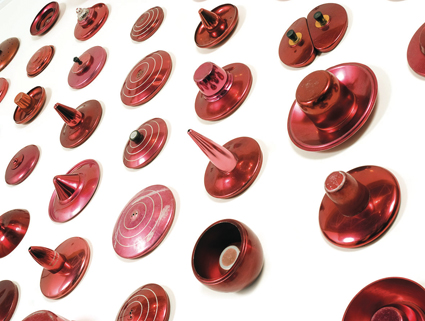
Naples 2011, Donna Marcus, found aluminium (detail), NOW and WHEN: Australian Urbanism
courtesy the artist and dianne tanzer gallery + projects
Naples 2011, Donna Marcus, found aluminium (detail), NOW and WHEN: Australian Urbanism
“We are called on to be the architects of the future, not its victims,” Buckminster Fuller once insisted. His words are an apt reminder of the rising public passion now for the re-casting of cities to improve access, health and the environment. Alternatively, we could become the artists of the future. There’s plenty of evidence in this, The Future City edition of RealTime, where we report on artists, often in collaboration with the public and working in public spaces, altering our perception of the city, recasting it as gallery and performance arena, communal meeting place and green environment. Our stories range from a gardening project in an art school (Tending) to re-workings of the city (Right to the City) and pragmatic and fantastical cities of the future (NOW and WHEN). Dancers re-cast Perth (Tongues of Stone). An artist and the community transform a city centre south of Sydney with video works and a performative installation (The Begin-Again). Performers place their audience inside a cardboard Manila in Sydney’s West in Within & Without (p2). An artist creates a site-listening guide to greater Brisbane. Visiting Irish/UK artists Desperate Optimists show their film Tiong Bahru in which Singaporean locals enact the tensions and pleasures of their lives. In Birmingham UK, artists in the Fierce festival inventively take on the city. On this page, Gold Coast artist Donna Marcus, in an adjunct exhibition to NOW and WHEN, reflects on the architectural layering and historical aura of Naples using found aluminium cook-ware. And, in the first of our Burning Issue features, you can read how the late German theatre provocateur Christoph Schlingensief made cities politically performative.
RealTime issue #103 June-July 2011 pg. 1
© RealTime ; for permission to reproduce apply to realtime@realtimearts.net
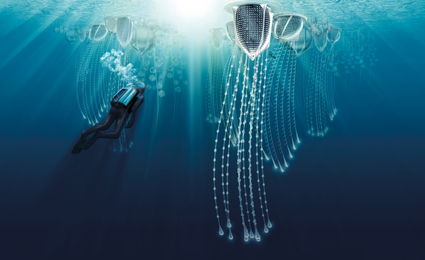
The Oceanic City, Arup, team members Alanna Howe, Alexander Hesp
image FloodSlicer
The Oceanic City, Arup, team members Alanna Howe, Alexander Hesp
NOW AND WHEN: AUSTRALIAN URBANISM IS NOT YOUR TYPICAL EXHIBITION FARE. RATHER IT’S ARCHITECTURE AS POETRY, COMBINING THREE-DIMENSIONAL MOVING IMAGE, SOUND AND INSTALLATION. AS A CONVERSATIONAL CATALYST, A 16-MINUTE FILM HOUSED WITHIN THE EXHIBITION, DESCRIBES THE URBAN DENSITY AND ECONOMIC SUSTAINABILITY FACING AUSTRALIA, AND HOW THESE MAY INFORM HYPOTHETICAL (IF NOT HYPERREAL) VISIONS OF URBAN EXISTENCE 50 YEARS FROM NOW, AND BEYOND.
NOW and WHEN is creatively directed by John Gollings and Ivan Rijavec, realised in 3D by Floodslicer and commissioned by Janet Holmes à Court. Launching at last year’s prestigious Venice Architecture Biennale, the show attracted an impressive 93,000 attendees. The Gold Coast is Australia’s sixth fastest growing city. It is also a metropolis that, in voraciously re-imagining its urban character, also serves to delete whatever is left of its architectural heritage. This is where Now and When makes its Australian debut.
Entering Gold Coast City Gallery, the venue for the show, I immediately feel transported into an otherworldly environment. The cavernous, infinity-like darkness of the space is startling. I find myself transfixed by the way-finding lines that slash across the black-coated walls and onto the floor and glow blaze-orange under ultraviolet lighting. Like traffic cones, they direct me to a stack of hollowed-out orange cubes. Fashioned into a dense cluster, not unlike a downtown city, these cubes tower at varied heights and remind me of the skeletal histories of past buildings, or templates of a future metropolis. Or perhaps they represent the void between people who reside in high-rises, disengaged from the bustling congregation of the ground below. A great screen commands the middle of the space, and 3D glasses (made especially for the show) vine down from the ceiling. I take my place in a scatter of stools and prepare for the eye-ride.
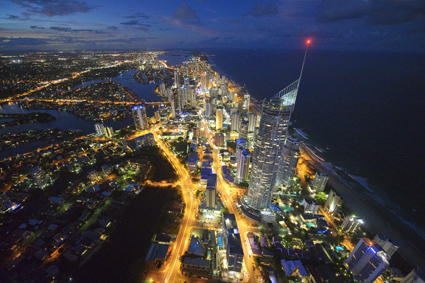
Surfers Paradise, Queensland, Australia, NOW
photo John Gollings
Surfers Paradise, Queensland, Australia, NOW
now
The short film starts with prototypical photographs of contemporary Australian landscapes, as documented by John Gollings. Here, vastly deserted mining craters of the western outback are contrasted with the high density eastern cities of Melbourne, Sydney and Surfers Paradise. Ninety three percent of Australia’s population is crammed onto the whiskers of the coastline, or the upward heave of concrete and lights. At the same time, it’s alarming to see colossal craters drilled into Newman and Kalgoorlie to become cityscapes in the distant future.
when
WHEN features 17 immersive, at times overwhelming, multi-dimensional explorations of future cityscapes. Selected from a nationwide competition, various designers and architects aimed to challenge conventions, and liberate themselves from notions of ‘safe’ design.
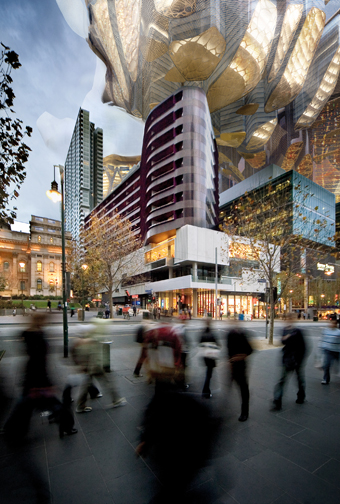
Multiplicity, John Wardle Architects and
Stefano Boscutti, WHEN
image FoodSlicer
Multiplicity, John Wardle Architects and
Stefano Boscutti, WHEN
At the recent Excellence in Architecture forum, Michael Harrison from City of Sydney asked: “Are cities a kind of grand accident, or can human will be exercised effectively so that city form is a true expression of our highest aspirations?” Aspiration is indeed what comes to mind when viewing snippets of an idealistic, harmonious future. Among the highlights: In Multiplicity (John Wardle Architects and Stefano Boscuitti) Melbourne does not expand further inland, rather it grows up and down. Airspace is utilised to intersect a ‘floating city’ with the existing ‘underground’ metropolis. Featured on this edition’s cover, Mould City (Colony Collective, Melbourne School of Design) explores what Rijavec calls “metropolitan Darwinism,” re-conditioning mould to turn it from a decaying organism into an active harnessing source. The ongoing migration problem in Australia is resolved through gigantic residential biomimetic water-pods in The Ocean City (Arup).
3D
Recently, film critic Robert Ebert chastised 3D films as a waste of filmic experience and an excuse to hike up movie prices. However, I believe that in the circle of architecture, 3D is king. This show portrayed architecture as having the ability to visually stimulate, augment and enchant, to convince audiences they are, for a moment, immersed in another dimension. Urban planners will use this new form of 3D to translate concepts and multifaceted visual narratives, and flattened drawings and models will come to life as environments and encounters.
sound & interactivity
The show’s soundtrack, engineered by T4K, enhances this suspension of disbelief. The score for NOW sounds foreboding, sometimes urgent—often the bass rumbles at my feet, leaving my stool slightly vibrating. I am later told by a gallery staff member that the positioning of the sound system just behind the audience was an intentional request by the Creative Directors. In contrast, WHEN is meditatively ambient, heightening the utopian imagery of a fearless and environment-friendly future city. I stay for repeated viewings, and notice that while a few visitors complain of the sound being too loud, a group of children appears to relish this environment. Their shoulders jump slightly at the sharp, cacophonous parts and they harmoniously ‘whoosh’ around the swirl-sounding scenery of Saturation City (McGauran). Children also seem to sit very close to the projection screens—not so different from watching television up close—but without the restraints of two-dimensional TV screens. This multi-layered experience means they too can be part of the action. The kids start clawing their hands in the air and like cats about to scratch, they ‘catch’ the enormous jelly-fish-like hydro-turbines of The Ocean City and duck down as the glass-like, multi-polar structures of Survival and Resilience pierce the air (BKK Architects, Village Well, Charter Keck Cramer and Daniel Piker).
side-shows
Displayed alongside the film is Then and Now: The Surfers Paradise Re-photography Project, a comparative 2D photographic study of Surfers Paradise from 1973 to present day 2011. I am astounded to see just how much this city is alien to its vintage evidence. As John Gollings laments (Sara Hicks, “A 3D Revolution in Architectural Photography”, ABC Radio 2011), “The problem is there is not a single building left in the photographs that I shot and they’ve moved the road alignments…I want people to understand what’s been lost and what’s been gained by these direct comparisons.” Out on the foyer, Revisiting the City—Naples by Donna Marcus sees an assemblage of aluminium kitchenware depicting the civic uniformity of grid cities. (See Editorial page.)
the 3D book
NOW and WHEN is a blockbuster exhibition supported by a limited edition 3D book, a short documentary and two mini-exhibitions as well as forums and workshops. However, unlike traditional shows seen at much larger, institutional galleries—whereby pre-digested mainstream works from overseas ‘star’ artists are imported—NOW and WHEN is proudly an Australian production, one of fierce creative foresight and technological vigour. And while the urban fabric explored is uniquely Australian, the issues it raises are felt globally.
To encapsulate the experience, the book comes with complimentary 3D paper glasses bringing to life the NOW pages. Like the film, the pages are split between the insipid mining fields and the luminous, dusk-shot city lights. When a colleague perused the 3D sections she shrieked, “This book is giving me vertigo!” She shut the book, thus flattening the pointy skyscrapers that, for a moment, seem to dart off the paper.
And this is inherently what exhibitions should be about, eliciting reaction and pushing boundaries. As an avid exhibition-goer, I feel that NOW and WHEN is one of the most striking shows I have seen in a long while. Someone asked me, “What is an architectural showcase doing in a contemporary art gallery?” There is a saying that an artist can create a square wheel, but an architect must make theirs round. Through NOW and WHEN architects become artists by harnessing creative inceptions to build cities and streetscapes that supersede realistic notions and constraints. This entertaining and spectacular program achieves its aim to create instant impact, to make those wheels square and to leave an impression long after the glasses are taken off.
NOW and WHEN originally appeared in the Australian Pavilion, Venice for the 12th International Architecture Exhibition, La Biennale di Venezia, 2010, and is now showing at the Seoul Museum of Art, from April 25-June 26. Versions of the exhibition will appear at Object: Australian Centre for Craft and Design, Sydney, July 2-Sept 25 and Ballarat International Foto Biennale, Aug 20-Sept 18.
Australian Institute of Architects, NOW and WHEN: Australian Urbanism, creative directors John Gollings, Ivan Rijavec, 3D visualisation Floodslicer; Gold Coast City Art Gallery, March 26-May 1, www.architecture.com.au
RealTime issue #103 June-July 2011 pg. 5
© Mariam Arcilla; for permission to reproduce apply to realtime@realtimearts.net
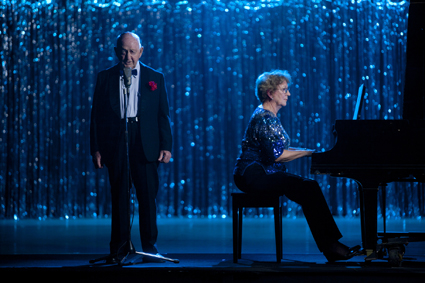
Vince Lemon, Mavis Noakes, Old Man River, video still, Angelica Mesiti, The Begin-Again
image courtesy and © the artist, photo Jamie North
Vince Lemon, Mavis Noakes, Old Man River, video still, Angelica Mesiti, The Begin-Again
AS WE INCREASINGLY ADDRESS THE PLIGHT OF THE NATURAL ENVIRONMENT, OUR CONCERNS EXTEND TO CITIES, NOT JUST THEIR POTENTIAL FOR GREENING BUT AS SITES OF HUMAN CO-OPERATION AND CULTURAL SHARING. ONE SUCH VENTURE IS THE C3 WEST PROJECT, A COLLABORATION BETWEEN THE MUSEUM OF CONTEMPORARY ART, CASULA POWERHOUSE ARTS CENTRE, PENRITH REGIONAL GALLERY AND THE LEWERS BEQUEST, CAMPBELLTOWN ARTS CENTRE AND COMMERCIAL PARTNERS.
C3 West has extended south to Hurstville with The Begin-Again. Angelica Mesiti, a video, performance and installation artist based in Sydney and Paris, worked intensively with locals to create four video works and a performative installation that could be enjoyed over two nights as you wandered the city centre.
Just outside the railway station on Memorial Square a large screen shows respected senior citizen Vince Lemon sveltely delivering “Old Man River” with an affectingly pronounced Australian accent. Down the main street in a small park by the Bus Exchange, we watch another video projection, intriguingly juxtaposing a driving percussion soundtrack with images of young children in various historical guises joyfully re-constructing the first local railway line and then innocently kicking it apart (a comment it seems on current public transport issues). Despite being dimly projected, the work is enthusiastically received by a large gathering of families.
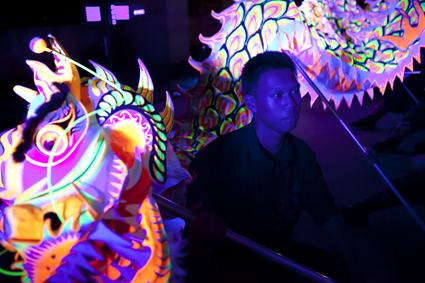
Kwang Leung, Parking Lot Dragon, Angela Mesiti, The Begin-Again
image courtesy and © the artist, photo Jamie North
Kwang Leung, Parking Lot Dragon, Angela Mesiti, The Begin-Again
Down a nearby lane we encounter another screen, this time featuring local ballroom dancers waltzing against a classic TV studio city skyline design. The video is beautifully edited, conveying the charm and confidence of the dancers—another kind of free-floating innocence. Suddenly out of the first night crowd, a popular featured dance pair glide before the screen and execute some deft turns to great applause. Around the corner on an otherwise bland brick wall, Lucinda Liu elegantly performs Water Sleeves, a traditional Chinese dance often shot in medium close-up with orange-red textures to capture the nuances of expression and gesture. At the top of the ramp, there’s something quite different, Parking Lot Dragon—four revving, glammed-up cars (smoke machines sensibly providing the mock exhaust fumes), vividly lit from below and darkly sparkling as their sound systems rumble. Darting and looping between them comes a richly fluorescent day-glo Chinese dragon (mythological but also a local sports mascot) whose increasingly sinuous moves are brilliantly executed.
The Begin-Again is not an epic event, but an intimate one built out of protracted collaboration with locals who become onscreen or live performers. Urban Theatre Projects has long engaged communities in Sydney’s West through an impressive range of performative means, while here The Begin-Again brings together the cinematic inclinations of a visual artist with local issues and passions.
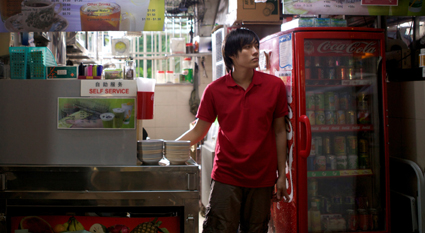
Leo Mak, Tiong Bahru, Civic Life, Singapore, Desperate Optimists (Christine Molloy & Joe Lawlor)
photo Samantha Tio
Leo Mak, Tiong Bahru, Civic Life, Singapore, Desperate Optimists (Christine Molloy & Joe Lawlor)
The UK-Irish pair, Desperate Optimists (Joe Lawlor and Christine Molloy), have taken their widely admired Civic Life project to Singapore, creating Tiong Bahru, a seductive 20-minute 35mm cinemascope film (shot by leading Singaporean cinematographer Daniel Low) featuring citizens as performers in a subtle, un-melodramatic account of the everyday tensions and pleasures in their lives. Tiong Bahru Estate, one of the oldest housing estates in Singapore and well known for its architecture and the excellent food of its hawker centre, provides the film’s focus. With the support of 150 locals, the film centres on the lives of four individuals across the course of a day, each faced with the challenge of change. An older woman treasures her home and community, but is pressured to move elsewhere to live with her family. A young man inherits his father’s coffee shop but invites paternal opposition in wanting to transform it into a tapas bar. A difficult teenager adjusts to a new foster mother. And a young schoolgirl struggling with her homework completes it as a story, realised on screen, of a group of children wondering what they should do when they find an abandoned baby in the food centre’s garden.
The film is accompanied by 19 short films made by locals and a booklet with excellent essays about living in Singapore. Desperate Optimists are visiting Australia with screenings of Tiong Bahru and other works in the Civic Life series in Melbourne at ACMI, in the Sydney Film Festival, at Performance Space and a workshop with ICE in Sydney’s West (see websites for dates and times).
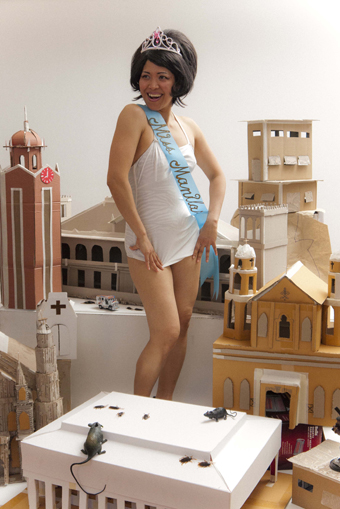
Valerie Berry, Within & Without, Performance Space and Blacktown Arts Centre
photo Datu Arellano
Valerie Berry, Within & Without, Performance Space and Blacktown Arts Centre
Also in Sydney’s West is the Blacktown Arts Centre where, thanks to the inventive creators of The Folding Wife (RT79, p35), you could soon find yourself in Manila: “Audiences [will be] immersed in a physical reproduction of the city…made entirely out of recycled cardboard boxes, shadowplay and surround-sound environments” (press release). Within & Without is the creation of Paschal Daantos Berry and Deborah Pollard in collaboration with Valerie Berry and the Anino Shadowplay Collective from the Philippines. The group’s aim is to explore “how capital cities—through their architecture, mythologies and histories—represent and personify the cultural identity of a nation.” But don’t expect a literal approach to the topic from these performance magicians.
C3 West Projects and Within & Without are just two of a growing number of creative ventures that explore our relationship with cities, suburbs and communities. Campbelltown Arts Centre’s Minto:Live was another fascinating example and more will doubtless emerge as the pressures of urban life demand to be addressed through discussion, planning and the engagement offered by art. RT
The Begin-Again, A C3 West Project, MCA and Hurstville City Council, artist Angelica Mesiti, Hurstville, Sydney April 1-2; Civic Life, Tiong Bahru, various venues Melbourne and Sydney; http://civiclifetiongbahru.com/; www.desperateoptimists.com; Blacktown Arts Centre and Performance Space, Within & Without, installation from June 24, 10am-5pm Tues-Sat, performances June 22-July 2, www.artscentre.blacktown.nsw.gov.au
RealTime issue #103 June-July 2011 pg. 2-3
© RealTime ; for permission to reproduce apply to realtime@realtimearts.net
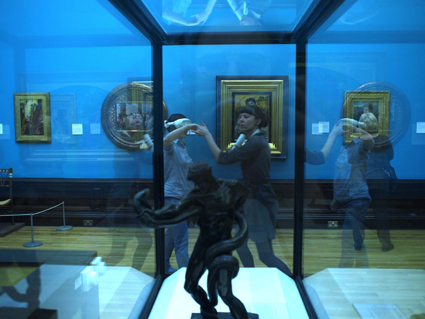
Lundahl & Seitl, Symphony of a Missing Room
photo Christer Lundahl
Lundahl & Seitl, Symphony of a Missing Room
LIVE ART. COLLISION. HYPERLOCAL. SUPERNOW. THESE FOUR CHALLENGES DROVE THE RECENT FIERCE FESTIVAL, A DENSE PROGRAM OF IDEAS THAT INFILTRATED THE CITY OF BIRMINGHAM FOR FIVE DAYS IN MARCH. NEW ARTISTIC DIRECTORS LAURA MCDERMOTT AND HARUN MORRISON’S VISION FOR FIERCE WAS DEEPLY AFFECTING, MOSTLY FOR ITS CLOSE AND CAREFUL CONSIDERATION OF THE FESTIVAL’S RELATIONSHIP TO BIRMINGHAM AS A CITY.
From religion to war, museums to football, architecture, food and micro-local journeys, the program took my hand and gently introduced a place both dirty and profound. A city that—in the words of Andy Field (co-director of the remarkable Forest Fringe)—wears its urban development scars much closer to the surface than other ‘rebranded’ English cities.
March 2011 marked the first Fierce since 2008 and the first without Mark Ball at the helm (Ball is now Artistic Director of the London International Festival of Theatre—LIFT). Like many of their peers around the country, McDermott and Morrison are alumni of Battersea Arts Centre’s extraordinary posse of producers, who establish key collaborations with emerging artists within BAC’s bosom, then go on to present their work in a range of other contexts.
I arrived in Birmingham after a 23-hour flight, one and a half-hour tube ride and two-hour cross-country train. Unshowered, confused and with my eyelids starting to fold inside out, I shared my disorientation on Twitter and immediately received a cheery “Ew! And welcome, see you soon!” from whoever manages Fierce’s account. It was the cheeky first step in unexpected intimacy with the festival’s program and the city of Birmingham itself.
The next morning, eyelids in place, I followed a series of bright yellow ribbons and yellow A4 posters towards the Birmingham Museum and Art Gallery for Lundahl and Seitl’s Symphony of a Missing Room. With “headphone art” becoming increasingly ubiquitous and sometimes just plain lazy, it was exciting to encounter the thorough and considered practice of this research-driven performance art duo. Six of us were led through the museum, observing the typical 19th century oil paintings, apricot walls and creaky polished wood floors. Upstairs, we were each given Sannheiser headphones fitted with a tiny MP3 player, and blindfolded. Robbed of sight for the work’s duration, we were led through the gallery while an audio narrative reimagined our journey as one through forests, castles, small tunnels and finally, a long winding staircase at the top of a castle overlooking a hill. A series of imaginative Catherine Wheels followed, as choreography, instruction and technology combined with the intimacy of a stranger’s gentle hand to lead us on a beautiful physical and imaginative journey. The work’s lyric storytelling managed to completely reinvigorate my relationship with this kind of institution. Blindfolds off and headphones returned, I wandered towards the Museum’s exit viewing its paintings and artefacts anew, with an increased physical agency within what is usually perceived as a space of formality and restriction. Symphony of a Missing Room has also been performed in Sweden and Brussels, each new iteration folding a ‘museum’ of previous imagery into the new site-specific work. It’s the kind of sophisticated and innovative live art for which established institutions should be clamouring.
Leaving the Museum, I wandered through Birmingham’s infamous ‘Bull Ring,’ an absurdly large retail complex hit hard with the Bedazzler. I ducked into Moor Street Train Station and found a wooden box: Quarantine’s The Soldier’s Song. As someone staunchly anti-war, this was an important work for me. Disappearing inside the box, I was greeted by a lone microphone and TV screen with six karaoke songs and six profiles of male and female British soldiers currently serving in Afghanistan. Warrant Officer Shaun Kelvin (North Wales) and I sang “Sweet Home Alabama” together—the whole thing. It was fun and silly, poignant and breathtakingly unique—when had I ever before associated troops in Afghanistan with giggling joy? Soldiers sing and dance and laugh and feel awkward too; why had I never considered that before? Through Warrant Officer Kelvin’s booming baritone and my squeaky soprano, the political became intensely and unforgettably personal.
On to the ‘dirty end’ of Birmingham and a talk by performance artist Eitan Buchalter at the Fierce Festival Hub, VIVID. Buchalter’s practice reframes human behaviour through a performance context, offering reflective space within the flow of crowds who are restricted in choice. During the lead-up to Fierce, Buchalter had observed VIVID’s proximity to St Andrew’s Stadium and that on football days thousands of people overflowed the footpath passing the gallery. In Veer, he set up barriers that channelled crowds away from the street, through an empty gallery and out again (now with a token redeemable for a beer at the pub next door). The vacant nature of the space makes clear that the point of this work is not to confront non-gallery goers with art, but to make the flow of crowds itself the subject of artistic inquiry. Responses to this detour ranged from hesitant to oblivious to cautious to nervous, with some even crossing to the other side of the road to avoid such ‘confrontation.’ Buchalter has an elegant commitment to letting go of ‘where’ his work takes place and acknowledges that his gestures may result in art that exists most potently in people’s memories. Participating in his workshop the next day, we discussed the vital importance of process-based performance art being presented to audiences in a manner as fulfilling as the original unique experience of the artist, rather than re-presented. The challenge of ephemerality—and the curse of unsubtle documentation—is something keenly felt in Australian live art and performance circles. I found Buchalter’s perspective persuasive and insightful.
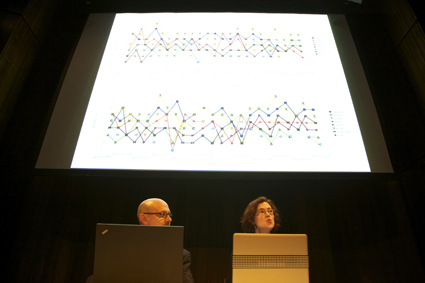
plan b, Narrating Our Lines
photo Briony Campbell
plan b, Narrating Our Lines
Now nearing the end of the day, I jumped into a cab and headed to the Midlands Arts Centre (MAC) for Plan B’s performance-cum-lecture Narrating Our Lines. Sophia New and Daniel Belasco Rogers have geo-tracked their daily movements since 2003. From the birth of their daughter to visiting their favourite cafe, the incidental and the unexpected are gathered and examined for habits, tendencies, moods and prejudices. They shared this intimate practice with 12 residents of Birmingham, creating a living map via donated GPS data. After a long day of walking and thinking, it was terrific to sit and contemplate the constellation of Birmingham’s movements as of Wednesday March 23, contrasting my first steps in this strange city with the hyperfamiliar steps of locals.
So from imagined forests to Afghanistan to the micro-local, a day with Fierce proved instructive and insightful. It revealed how vital a festival experience can be when the artistic direction is passionately dedicated to site and place, showcasing a city’s shiny bits as well as the parts it would rather ignore. I wandered from major government-funded venues to ARIs, from decadent retail strips to industrial bohemia, yet Fierce’s sound artistic choices ensured the experience was consistently joyous, filled with curiosity and love for the diversity of Birmingham and its people. The festival was a lovely example of the extraordinary sense of immersion artistic directors can achieve with a program that’s cohesive and multi-faceted, with good clear signage making the journey between shows as full of character as the works themselves.
Working with an 18-month development period and a relatively small group of artists, as an international arts festival Fierce is miles away from the superficial supermarket approach of some million-dollar arts festivals, where the connection between artist, locality and audience is so presumed, so without consideration or care, as to be lost altogether. Festivals must continue to assert their rationale beyond a marketing guide or catering to a collection of people who came last year. In my own practice and in those that inspire me, there exists an attempt at genuine and specific engagement with artists and the audiences who care enough to pay attention.
With curation charged with humble curiosity for the “hyperlocal” and a dedication to openness and possibility that consistently allowed its artists’ works to exist in the “supernow,” Fierce 2011 impacted deeply on the city it sought to explore, the artists within its embrace and the visitors who witnessed it sparkle.
Fierce Festival, Birmingham, UK, March 22-27, www.wearefierce.org
RealTime issue #103 June-July 2011 pg. 6
© Emily Sexton; for permission to reproduce apply to realtime@realtimearts.net
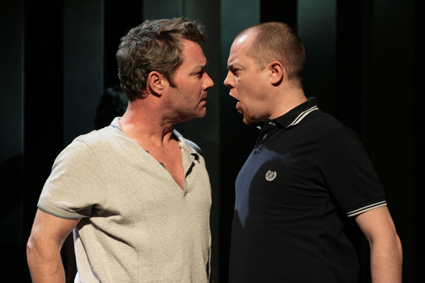
Martie Maguire, Chris Corrigan, Chronicles of Long Kesh
photo courtesy Ten Days on the Island
Martie Maguire, Chris Corrigan, Chronicles of Long Kesh
A BURLY, RUDDY-FACED INMATE STANDS ATOP HIS BED IN HIS SOLITARY CONFINEMENT CELL AND BELLOWS “I’M THE EMM-CEEEEEE, WITH THE PERSONALITEEEEE.” HE GOES ON TO ENCOURAGE HIS FELLOW INMATES OF CELL BLOCK H TO SING, TELL STORIES, TO DO ANYTHING AS LONG AS THEY JOIN HIM ON ‘AIR’ ON HIS RADIO STATION THAT RELIES ONLY ON THE VOLUME OF ANY ONE VOICE AND THE POROSITY OF A CELL. THIS IS OSCAR. HE IS A MEMBER OF THE IRA AND A LONG-TERM INMATE OF LONG KESH AND HE CAN ALSO MAKE A MOTOWN TUNE SPARKLE.
Chronicles of Long Kesh, one of the headline theatre shows of Tasmania’s Ten Days on the Island festival, depicts a 30-year period in the Belfast gaol that began in the early 70s when the British government had the authority to intern offenders without sentence. We are witnessing a scene that takes place as this group of inmates hovers on the edge of an historic and tragic decision to launch a rolling series of hunger strikes as a protest against their mistreatment in this institution.
Seven players working with a minimal set of grey, body-length boxes perform the high energy play by Belfast local and ex-IRA member Martin Lynch. The show offers insight into the tempestuous politics of the period, but its focus is squarely on all of the people involved—the IRA, the Loyalists, the prison guards and the families of these people. In a post-show talk Lynch says, “I wanted to write a play that was true to the people I grew up with.” In doing so, he pulls no punches when it comes to depicting the violence and despair of these years in gaol, where hunger strikes were preceded by years of protest. During this time inmates remained naked except for blankets, in solitary cells plastered with their own shit as gaol management withdrew services such as cleaning in an attempt to stop the protests.
What is most surprising is that Chronicles of Long Kesh is funny, perhaps even delightful, despite the content remaining so difficult to digest. Lynch’s key device to achieve this mood is song. While the prisoners may not have sung Motown tunes as Lynch’s players do, it is stories of the galvanising action of singing and talking that inspired this play. Lynch recalls that his generating idea was hearing that Bobby Sands—the first to die on the hunger strikes—recalled the story of Spartacus for his fellow inmates over a three-week period.
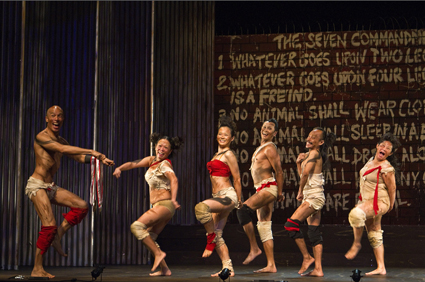
Animal Farm, Wild Rice
photo Albert Lim
Animal Farm, Wild Rice
Another high energy show with a serious intent, Animal Farm, directed by Ivan Heng of Singaporean theatre company Wild Rice, manages to be a quirky mash-up of the book by George Orwell, while remaining faithful to the detail of the text. Like Lynch’s show, the scene is established by the players rather than the set, with much of the action simply performed in front of a full height ‘brick’ wall painted with the imposed rules of “Animalism.” An enthusiastic one-man band plays from a raised platform within the orchestra pit. Dressed in colours that offer a nod towards communism and revolution—red, white and grey—the players create the various farmyard animals with sets of signature gestures that allow them to flip between duck, goose, pigeon, pig, cow and horse. It takes a little time to get used to each of the characteristics and hear the text of the play through the stamps, snorts and wing flutters, but the players are remarkably consistent and convincing in their portrayals.
While I was able to come to terms with Lynch’s infusion of humour into the traumas of Long Kesh (feeling I was witnessing a true coping mechanism among those inmates), I could never quite relax into Heng’s wacky portrayal of Orwell’s text. With schmaltzy tunes such as “Sugar Sugar” by the Archies, slapstick humour and a generous smattering of pop culture references, the show often felt like a pantomime and yet the serious themes persisted. These opposing directions appeared awkward, although I did muse that I may have seen it with different eyes had I the benefit of a more intimate understanding of the complexities of Singaporean culture.
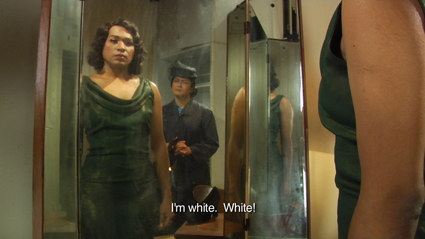
Ming Wong, still from Life of Imitation
courtesy Ming Wong and Ten Days on the Island
Ming Wong, still from Life of Imitation
Ming Wong: Life of Imitation is a show that offers some insight into an aspect of Singapore’s culture. Installed at CAST gallery, the show presents a small section of a much larger exhibition taken to the 2009 Venice Biennale. It incorporates several works by Ming Wong in conjunction with an array of artifacts such as film posters from a golden age of cinema in Singapore through the 1950s and 1960s. The most compelling of Ming Wong’s works is Life of Imitation in which two projections, each paired with a large mirror, face each other across the gallery. The artist has recreated a short, emotional excerpt from the 1959 film entitled Life of Imitation, where the same two female characters are played by a rotating series of cross-dressed male actors collectively representing the country’s multicultural mix. The dialogue in the looped scene between a young mixed-race woman and her estranged black mother reveals the moment when the daughter is caught out in her assumed ruse as a white woman. Ming Wong’s interpretation of this film hints at an aspiration to escape the constraints of one’s cultural heritage or any defined role. Once again, I sit on the outside of cultural understanding, but I feel as though this work offers a small window into the Singaporean psyche.
In keeping with a core commitment of the festival to be a statewide event, several productions were staged in regional areas. Minotaur—The Island, the first in a trilogy by Chamber Made Opera, was performed in the Dennes Point Community Hall on Bruny Island. With rich mythological fodder as a base, David Young and Margaret Cameron’s work is an esoteric take on the story of Ariadne lamenting her abandonment by Theseus, whom she saved from the Minotaur. Wearing a series of handbags as hats, the players work with a minimal set and makeshift percussion to tell Ariadne’s story. Their focus is on spoken word, noise and movement and on improvised instrumental music rather than sung text.
While I don’t believe that any art form should be constrained in its reach, I felt disappointed that the ‘opera’ seemed to have been lost in the making of Minotaur—The Island. Small moments of poetic, sung text by Deborah Kayser (Ariadne) were haunting and beautiful, but they were fragments in a work that felt more like a series of experiments in physical theatre, held together loosely by the landmarks of a well-known story—a red thread, a labyrinth, an island. I don’t think I’m mistaken in gauging that the audience was at best puzzled at the conclusion. A major factor in my disappointment—particularly given the eight-hour adventure required to get to the island location and back—was that the work was performed in a bland community hall, rather than two minutes away on a beach or jetty within extraordinary surrounds that may have added resonance to the story. Given Chamber Made is known for playing with context in their performances staged in private living rooms, the choice of venue seemed an odd and perhaps risk-averse decision.
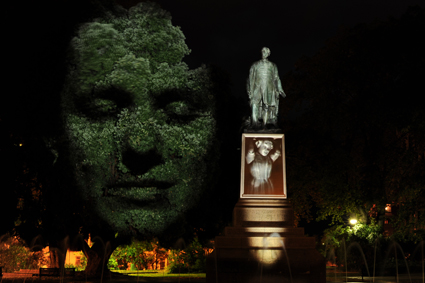
Intension 2011, Craig Walsh (three channel video projection at Franklin Square, Hobart
image courtesy and © the artist
Intension 2011, Craig Walsh (three channel video projection at Franklin Square, Hobart
A free festival highlight was Digital Odyssey by Craig Walsh, a public work developed as part of his Hobart residency. Located at Franklin Square and on the edge of the wharf in Sullivan’s Cove, the artworks brought the space of the tree canopy and the water surface to life using projections. The Franklin Square location was the most successful as large video projections of young faces were cast onto the canopy of several trees surrounding the public space. The mapping of light created the illusion that the trees had been trimmed, or had grown into the shape of the faces and I was not alone in finding it mesmerising to stare into the ‘eyes’ of this silent, blinking and seemingly benevolent vegetation.
There is ongoing talk within the local arts community about the festival and its direction. This year’s Ten Days felt like a series of isolated performances rather than a cohesive, transformative event, which is partly to do with the selection of shows but also the unfortunate circumstance of decreased funding. The Ten Days team, to their credit, has continued to battle on in increasingly difficult financial circumstances, but in light of newer festivals in the state such as MONA FOMA, which has quickly become a summer highlight in Hobart as well as Junction Arts Festival in Launceston, it does seem as though a significant rethink is needed. Perhaps we don’t need a statewide festival any more. Perhaps a permanent theme of ‘islands’ is limiting to potential content. And maybe one reason why we all love MONA FOMA so much is that it’s a festival that is not tangled up in defining Tasmania’s identity or battling with the impression of being the poorer cousin to Melbourne or Sydney, yet in the act of ignoring these issues positively contributes to the redefinition of this place.
Chronicles of Long Kesh, writer Martin Lynch, directors Lisa May, Martin Lynch, musical director Paul Boyd, Green Shoot Productions, Hobart Theatre Royal, March 30-April 3; Wild Rice, Animal Farm, director, designer, choreography Ivan Heng, George Orwell’s novel adapted by Ian Wooldridge, composer Philip Tan, Hobart Theatre Royal, March 25-29; Ming Wong Life of Imitation, artist Ming Wong, curator Tang Fu Kuen, Contemporary Art Spaces Tasmania (CAST), March 24-April 24; Chamber Made Opera, Minotaur—The Island, composer David Young, writer, director Margaret Cameron; Digital Odyssey, artist Craig Walsh; Ten Days on the Island, Tasmania, March 25-April 3
RealTime issue #103 June-July 2011 pg. 8
© Judith Abell; for permission to reproduce apply to realtime@realtimearts.net
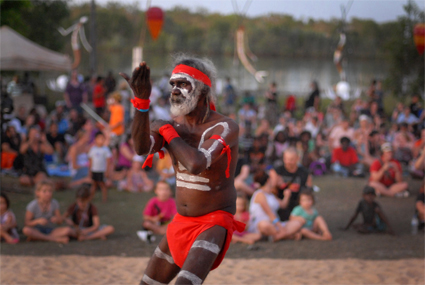
dancer with David Dingala’s group from Groote Eylandt, Mahbilil Festival
photo Dominic O’Brien
dancer with David Dingala’s group from Groote Eylandt, Mahbilil Festival
DIRECTOR AND PRODUCER ANDRISH SAINT-CLARE HAS MADE JABIRU’S MAHBILIL FESTIVAL A DISTINCTIVE CULTURAL EVENT IN THE NORTHERN TERRITORY, WITH ITS INNOVATIVE INSTALLATIONS, PERFORMANCES AND FAMILY-ORIENTED APPEAL. FOR 2011 HE’S BEEN INVITED TO BE ARTISTIC DIRECTOR OF THE FAMOUS GARMA FESTIVAL AS WELL, A QUITE DIFFERENT EVENT BUT WITH SOME IMPORTANT SHARED PRIORITIES, NOT LEAST FOR YOUNG INDIGENOUS ARTISTS. I ASKED SAINT-CLARE ABOUT HIS BACKGROUND AND HIS APPROACH TO EACH OF THE FESTIVALS.
What is your background as an artist and producer?
My mother collected and illustrated folk songs and tales when I was a small child and also forced me to study the cello, which I got good at. Later after the difficult years as a dislocated and deprived teenager looking for an Australian identity, I started to meet and work with artists, musicians, filmmakers and became a member of a seminal theatre group, The Performance Syndicate, led by Rex Cramphorn which was devoted to realising a new performance language that paid homage to our Asian geography.
This early period involved various excursions from Khatakali to Kabuki to Martha Graham, writing for radio, learning film editing at ABC TV, composing on an Atari and tutoring for NAISDA, doing all manner of things as an arts worker and performer. Then after abandoning the arts for a decade or more I was invited back to compose for a ballet by Kim Walker about the life of Aboriginal opera singer Harold Blair.
A couple of years later I decided to abandon city life and settled in the Northern Territory and spent a lot of my time in remote communities creating and devising performance works with the people there. On Elcho Island I found an opportunity to create a work about the contact history of Yolngu people from North East Arnhem Land and the so called Macassans from the island of Sulawesi in the eastern Indonesian archipelago. The resulting large-scale stage work Trepang was widely appreciated and has been written up in various books and articles.
Trepang was followed up by another large live performance work for the stage called Fire Fire Burning Bright about a massacre of Aboriginal people in the Kimberleys around the closing stages of the First World War. The work was performed by Gija and Mirrawong speaking people at the Quarry for the Perth International Arts Festival and at the Arts Centre’s State Theatre for the Melbourne International Arts Festival.
After this period, finding it increasingly difficult to raise funds for large stage work, I found myself more and more involved with community cultural development projects including producing festivals.
Why your particular and enduring engagement with Indigenous cultures?
I have a refugee background and had considerable racist experience when I first arrived in Australia as a child. This continued in lesser ways of discrimination for many years and added to this were the very distressing stories my mother related to me about the war years in eastern Europe, which included the murder of several relatives and the scattering and dispossession of my family. All this led me to have great sympathy for the lot of Aboriginal people when I finally met and made friends with some as a young adult.
From these roots and the sometimes lengthy travels I undertook to places in South America, North Africa and Indonesia set me on the road to a fascination with Indigenous people and cultural studies. Of course, as one matures and illusions dissipate, it becomes untenable to apply attitudes of ‘study’ to the many Indigenous people who have become personal friends and family.
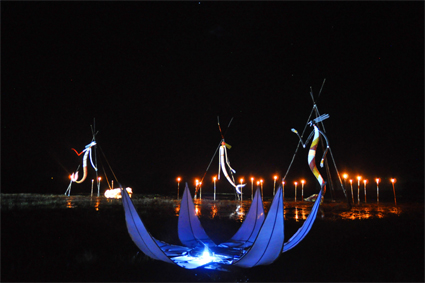
Yawk Yawk figures by Techy Masero after bark paintings of local totem figures. Lotuses by Conor Fox open to release illuminated balloons
photo Dominic O’Brien
Yawk Yawk figures by Techy Masero after bark paintings of local totem figures. Lotuses by Conor Fox open to release illuminated balloons
How long have you been working with the Mahbilil Festival and what is its particular character and appeal?
Originally I was asked to do a cultural mapping of the area around Jabiru by a mining company looking to develop small business with Bininj people in 2004, but ended up being asked to take over the Jabiru Wind Festival by Gundjeihmi Aboriginal Corporation and change it to a more Indigenous event, which I did successfully. In 2009 I was again invited back to reverse a slide in the quality and direction of the festival and again made it largely about local and regional Indigenous culture with a youth focus.
Having worked on a number of regional festivals I generally look for what is unique in local characteristics and resources. Jabiru is a mining town with a mixed population of Indigenous and multicultural backgrounds so I thought it would be good to reflect this diversity, something that is rare in the remote and regional festivals of the Northern Territory. The town is also situated in the midst of a vast wetland full of birds, buffalo, barramundi and so forth, so we have instituted a magpie goose cooking competition for instance, judged by chefs from Cooinda and the Gagaju Crocodile Hotel. Magpie geese are delicious to eat and there is no place else in Australia really that you can get a taste of this bird. We also feature large earth oven cuisine where buffalo is cooked in maleluca bark and spiced with local native herbs.
The festival site is also in a park next to a lake, so on a laid back family afternoon you can eat, shop for artefacts, watch Aboriginal artists weaving and painting and let your kids go on free water slides and dodgem cars and enter spear throwing and didgeridoo blowing competitions. Then you can marvel at the magical installations on the water in the fading sunset.
This part of the festival is all about art and multimedia. The installations are based on local Indigenous mythological figures, the use of which has been approved by the local elders and are interwoven with soundscapes and, when possible, traditional dance. In 2009 we created large, illuminated mobile puppets mounted on boats that appeared like creatures from another world. Last year we installed five-metre tall Yawk Yawk figures, the Bininj “mermaids” on the lake. These were surrounded by gigantic lotus buds that opened to reveal illuminated balloons that floated up into the starry darkness like mermaid eggs.
The final part of the festival is devoted to the concert stage. Here we have all manner of bands from Indigenous groups such as Narbalek to funk and rock from the night spots of Darwin interleaved with dance performances that have included Maori poi, Balinese, Congolese, traditional performance from Groote Eylandt, Oenpelli and hip hop. Simply put, the festival caters to family, art and entertainment with a broad, eclectic programming mostly absent from the other festivals.
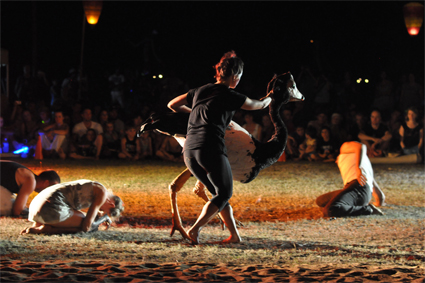
Gary Lang’s group, Goose Lagoon
photo Dominic O’Brien
Gary Lang’s group, Goose Lagoon
What do you feel you’ve achieved with Mahbilil?
Mahbilil is devoted to winning hearts and minds in the town and celebrating our communality. The festival has certainly achieved this and virtually everyone living there comes out to enjoy the sights and activities. Local attendance has also increased since we discontinued alcohol being served on site. We also have an increasing number of visitors to the extent that you have to book way ahead for accommodation in the town.
Beyond this, the festival is about showcasing what is going on, especially for children and youth. The Kakadu Youth Centre for example runs many after-school workshops where the young learn to make videos, train in music, songwriting, dance, gymnastics and various other arts and crafts. There are also extensive collaborations with the Jabiru Area School that tend to go into overdrive a few weeks before the festival. By now I feel that we have achieved a unique festival that is contributing cohesion and pride to the life of the town. For the first time last year we were asked to expand the festival with sporting events and we’re working on a parade, which will hopefully display floats and marching groups contributed by the organisations and businesses in the region.
Garma is already well defined, not least as an ideas and issues festival. How did you come to it and what do you wish to do with it in terms of continuity and new directions, if any?
There was nothing special about how I came to Garma. In early 2010 there was a change of administration at the Yothu Yindi Foundation, which runs Garma under the guidance of a Yolngu steering committee. I was asked if I wanted to direct the festival. I said no straight away, as I didn’t think I had enough time available to do the amount of work it would take and I was also uncomfortable with the idea that a non-Indigenous person should be the director, even though there had never been an Indigenous director before. I could not think of a Yolngu who had the training, experience or willingness to take it on, so I recommended Rhoda Roberts, whose Dreaming Festival I had attended a couple of times. A short while later I was rung again and asked if I could handle producing some part of the festival at least and I ended up agreeing to do the Bunggul, the traditional performance section, which was put on every afternoon. I basically accepted because I had been working with Bininj in central Arnhem Land for the past two years and this was an opportunity to get back together with my Yolngu friends and do things together. As well, Rhoda’s production team were all southerners, so they had no one else who knew the elders in the various communities to negotiate with to bring their teams to Garma.
Early this year, things had moved on again and I was asked to be the artistic director, as well as carry out many of the other directorial jobs. I thought that within the steering committee’s guidelines I could perhaps try to change a few small things in the proven formula and provide a situation which might be both more supportive of local talent while being more open to presenting contemporary culture from the Yolngu communities. I was also aware from many of my younger colleagues ‘down south’ that Garma was unknown to most of their generation, yet here it is, the most significant Indigenous festival in Australia.
As you say, Garma programming has been well defined for a dozen years, so it is not something which can be easily toyed with. Many important people from traditional leaders to industrialists to politicians and academics attend the key forum lectures and discussions, nor are the exhibitions and performance-oriented activities devoid of representational significance or statement of values and status. There are however gradual steps which need to be taken to keep proceedings open to voices and influences that maintain currency as well as cultural integrity.
Garma is essentially an Indigenous bush festival, not a pop extravaganza. We do not strive to showcase established and well-publicised artists, but find it more valuable to present incredible talents found in the communities who may not have had the advantages of promotional opportunities found in cities. There are sweet and powerful singers as good as any in the city and these may be seen at the 2011 Garma Festival. What is more, we are negotiating a deeper and more extensive set of Bunggul or ceremonial dance performances than perhaps anywhere in Australia.
Finally we have also identified some extra time in the daily regime allowing for the presentation of contemporary performances that combine traditional dance with, for instance, a contemporary band rendition of manikay or song. This is the living culture that youth are experimenting with in their communities. They get almost no government support and the commercial world is thousands of kilometres away, so Garma is one of the rare opportunities for them to reveal their work.
Garma Festival, North-East Arnhem Land, Aug 5-8, www.garmafestival.com.au; Mahbilil Festival, Jabiru, Kakadu National Park, Northern Territory, Sept 10
RealTime issue #103 June-July 2011 pg. 10
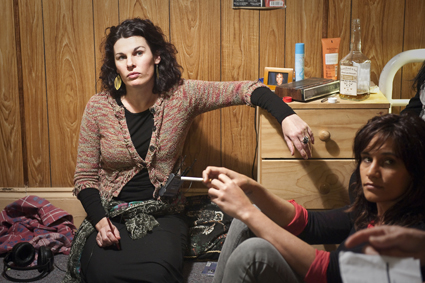
Beck Cole on the set of Her I Am with Shai Pittman
photo Sam Oster
Beck Cole on the set of Her I Am with Shai Pittman
CINEMATIC REPRESENTATIONS OF INDIGENOUS LIFE OFTEN SEEM TO DWELL UPON THE TRAGIC ASPECTS OF THE PAST, THE OVERPOWERING WEIGHT OF A TRAUMATIC HISTORY OBSCURING ONGOING EFFORTS TO IMPROVE LIFE IN THE PRESENT. WHILE POWERFUL AND CONFRONTING FILMS HAVE BEEN MADE ON THE ONGOING DISINTEGRATION OF INDIGENOUS CULTURES IN REMOTE AREAS, STORIES DEALING WITH THE EXPERIENCES OF INDIGENOUS PEOPLE IN URBAN AREAS ARE RARELY, IF EVER, TOLD. WITH HER DEBUT FEATURE HERE I AM, WRITER-DIRECTOR BECK COLE HAS BROKEN THIS MOULD, CONSTRUCTING A QUIETLY ENGROSSING PORTRAIT OF CITY LIFE FOR INDIGENOUS WOMEN IN CONTEMPORARY AUSTRALIA THAT IS IMBUED WITH GENTLE HUMOUR AND A THOUGHTFUL AND UNASSUMING OPTIMISM.
Here I Am follows the struggles of Karen Burden (Shai Pittman) in her attempts to turn her life around on being released from prison. Desperate to regain custody of her young daughter Rosie (Quinaiha Scott) from her unforgiving mother Lois (Marcia Langton) while persuading the authorities that she’s put her drug-addled past behind her, Karen enters a women’s shelter run by the formidable Big Red (Vanessa Worrall), settling into the emotional hard work of straightening out her life.
Working from her own script, Cole’s film illuminates the reality of a “fairly common experience” through a simple but effective naturalistic style that allows her to lay bare the human story behind the statistics. “Karen comes from me really,” she says, “my experience and what concerns me and the things that I think Aboriginal women experience…There is a disproportionate number of Indigenous women in prison in this country, that’s a fact…You’re making a film that you hope will engage an audience, because everyone’s got a mother, most people are parents at some point in their lives, so it’s dealing with universal themes. But it is also taking you into a world where you (probably) haven’t been before, one that really exists.”
In this film, Beck Cole draws on her experience making documentaries—her previous work includes Making Samson & Delilah (2009) as well as the brilliant SBS series First Australians (2008) with Rachel Perkins—and the half-hour drama Plains Empty (2005), which also followed the experiences of a lone woman. Cole shot Here I Am on location in the “familiar territory” of Port Adelaide (her upbringing being punctuated by regular moves between Alice Springs and South Australia) to lend the film an inimitable aura of realism. “We were in that world all the time,” she comments, “it was a really good grounding, a reality check, to be making a story amongst it…we were really welcome there. [Adelaide’s] like a big country town, really laid back.”
Immaculately shot amongst cheap motels, decaying industrial infrastructure and cigarette-butt littered streets by director of photography (and Cole’s husband) Warwick Thornton, Here I Am is grounded by an extraordinary performance from Shai Pittman, who approached her task with similar energy and persistence to her director. “I love doing this style of work,” she enthuses. “I suppose being an actor you’ve got to be quite open to diverse, different people…Karen was really easy to relate to. There were times when I just thought, okay, this is a test…[but] I did it all, never questioned it.” Says Cole, “Shai was completely and utterly fearless.”
Karen’s story plays out against the backdrop of the women’s shelter, the makeshift camaraderie among the residents leavening the desolation that continually threatens to overwhelm her. As Cole notes, “it’s important to have a laugh in dire situations.” As well as giving roles to theatre veterans Betty Sumner and Pauline Whyman, Cole drew on predominantly Indigenous, non-professional actors from the local community in casting the supporting roles, their efforts adding to the film’s raw honesty. “I like to try and find the heart in people, get them to express that,” explains Cole, “but when you’re putting words in their mouths you’re dealing with something else, it’s a different scenario…It was challenging, and I think it’s just something that you’ve got to embrace and look for those little quirky moments…That’s what I like. I think you can tell when there’s that essence of that person’s heart in that moment on screen.”
Indeed, the roles of many of the institutional figures encountered by Karen—her parole officer, a job-seeking coordinator, a child welfare officer—are played by Indigenous women who hold similar positions off-screen, a decision that Cole believes reflects an encouraging trend in reality. “I’ve got loads of friends who work in those sorts of jobs…Women are in these jobs, right across the country. I think it’s a statement about employment, a statement about taking control of your own destiny and getting to change things for the better—you’ve gotta get in there and work from within. It’s not rocket science.”
Which doesn’t mean it’s easy. Against Pittman’s smudged and battered Karen, Cole sets the stony and unrelenting figure of Lois, who has achieved a position of stability through hard, repetitive but essentially restorative labour—she is employed, significantly, as a cleaner. Langton, a renowned academic and social activist, was by all accounts an inspiration on set, reading Senate Notes between takes—when not on Facebook. “She’s very strong,” says Pittman. “She reminds me of Indigenous mothers and grandmothers these days [who are] just like her; she’s strong like that. It was just like having my grandmother on set, or my mum.”
Much of the emotional power of the film comes from the ultimate reassertion of Karen’s individual dignity and sense of self-worth against the contemptuous judgement of her mother and society at large. In a remarkable scene towards the end of the film, she takes a shower, a simple symbolic act shot with uncomplicated grace. “I reckon you can forgive,” Cole muses, “…[but] the thing that is really hard to shake is shame…When I was thinking about Karen I was thinking: how do you get over the shame of neglecting a child? Because that is mega-shame. How do you forgive yourself for that? You can’t, all you can do is try to forget it—and you can’t do that either…It’s a hard question.”
A willingness to confront hard questions seems to lie at the heart of Cole’s filmmaking. As with other contemporary Indigenous filmmakers such as Ivan Sen (Beneath Clouds and more recently Toomelah) or Thornton (Samson & Delilah), Cole has received immense support from the Indigenous Branch of Screen Australia who recognise the importance of talented Indigenous storytellers sharing their stories. “I think there’s…an important place for films like [Rolf de Heer’s] The Tracker (2002) and others,” says Cole, “the more the merrier—the history of this country being told from all its perspectives is an important thing. But the reason why there’s a lot of support for films made by Aboriginal people about Aboriginal people has been largely I think due to a commitment by Screen Australia and its Indigenous Branch… it’s been strategic I think, and it’s great that there’s been such a high calibre of films released. It’s no longer this bullshit ooga-booga blackfella sort of stuff. These are stories that audiences can sink their teeth into and enjoy. That’s all you want for someone who’s paying 15 bucks to see a film…Now there’s more of a push to get the next group of people through, to keep this momentum up. It’s an exciting time to be a filmmaker in this country—particularly an Aboriginal one.”
Here I Am, writer, director Beck Cole, director of photography Warwick Thornton, producer Kath Shelper, Scarlett Pictures, 91mins, 2011
RealTime issue #103 June-July 2011 pg. 13
© Oliver Downes; for permission to reproduce apply to realtime@realtimearts.net
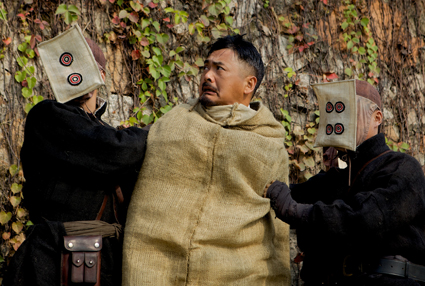
Let the Bullets Fly
AT THE FILMART MARKET THAT ACCOMPANIES THE HONG KONG INTERNATIONAL FILM FESTIVAL (HKIFF), THIS YEAR THE TALK WAS ALL OF THE RISE OF CHINESE CINEMA AND WHETHER WE WERE SEEING A GOLDEN AGE. THE IMMEDIATE RESPONSE TO THIS QUESTION WAS A RESOUNDING YES, WITH THE BOX OFFICE ROCKETING PAST 10 BILLION RENMINBI ($A1.45B) AND A RECORD NUMBER OF FILMS PRODUCED LAST YEAR.
This represents hefty growth, but the longer the panellists tried to talk up China, the more the doubts started to emerge. China’s box office still doesn’t represent such a great advance on Australia’s $1.1 billion, and it seems there are only 20 million active cinema-goers in China. Other revenue sources such as video, television and the internet remain sadly underdeveloped and, worst yet, of the 536 films made in China last year, only 100 got any kind of distribution. While Chinese films still have almost 60% of their domestic market, this is attributable to a handful of blockbusters.
A lot of films are being made throughout East Asia right now. The most interesting are shot cheaply on digital video, sometimes with seed money from the promotional events that accompany Asian festivals. They go largely unseen within China and the industry folk at FilMart have little interest in them. One of the few places where they mingle is at HKIFF, so it seems an ideal place to sample developments on either side of the Chinese cinema chasm and also to consider the middle ground.
let the bullets fly
The biggest recent hit in Chinese cinema is Jiang Wen’s Let the Bullets Fly (2010). This is a remarkable and welcome development, not only because it is a pretty good movie but also because Jiang has shown himself to be a fine filmmaker, one whose last film, The Sun Also Rises, wilfully embraced all the obscurities of art cinema.
The new film is set during the 1920s, a transitional period when China was struggling to move from peasantry to modernity. It is flush with two-fisted automatic pistol action and flashy CGI effects, but succeeds in using digital effects for something more than just spectacle. In fact, spectacle is held in check for moments of flourish, while character interaction is still the main driver. Jiang plays a bandit who starts out simply wanting to make a fortune and ends up achieving something more. There are some clear analogies to the spaghetti western here. The film is a poker game between Jiang and an urbane warlord played by Chow Yun-Fat—two smiling antagonists learning mutual respect even while each plots to kill the other. This battle of wits is all macho co-operation on the surface and simmering animosity beneath it. Somehow, China will take a step forward out of this confrontation, though each of the protagonists will be left behind.
Devils on the Doorstep (2000) showed Jiang to be a fabulous stylist and this latest film demonstrates a confidence and storytelling finesse. It is one of those rare instances where a blockbuster can capture a mass audience’s respect for pleasurable innovation. Significantly, it marks a step away from the overblown, period martial arts fantasies which have weighed down big budget Chinese production for a decade now.
old dog
On the other side of the divide is Old Dog, a cheap, digital feature from Tibetan Pema Tsuden. The story is of a Tibetan mastiff owned by an old man. These dogs are in demand by Chinese businessmen and the old sheepherder is besieged with offers to sell before the dog is stolen. Of course, this is all open to interpretation as an allegory of Tibet’s situation in relation to the Han Chinese. Tibetan culture can provide no place of respite from the demands of the Chinese.
On the other hand, we can also see the dog as simply a dog. There is a resolute refusal to take the easy option by allegorising or sentimentalising the story. The dog is the item of exchange that keeps the narrative going, but it has no name and is never touched or spoken to by its master. Things rarely need to be spoken in this film. One scene is shared between a father and his son who has just been arrested. They say hardly anything but pass a lighter back and forth with an eloquence that speaks loudly.
There is also a lot of spare time in the film: time to show guys playing pool in the street, time to show a herd of cattle pass by. One memorable shot is sustained so that we can watch a sheep stuck on one side of a fence try to get through to rejoin the flock.
Narratives are like bags—you can put a lot of things in them. Pema’s bag has a lot of space in it for wonderful things. The camera is kept back from the action, not to distance you from the characters in the style of Hou Hsiao-Hsien, but to place the characters in their environment. Part of the project of the film is simply to show you what small Tibetan towns are these days, with their mixture of wide, muddy, rubble-strewn streets and cloud-adorned mountains; where trucks and motorcycles share the streets with goats and cattle.
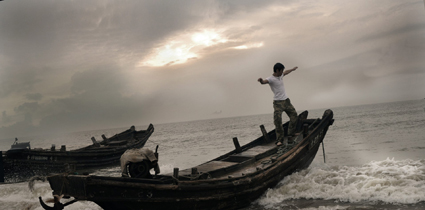
Chongqing Blues
chongqing blues
To be stuck in the middle of the Chinese cinema is an uncomfortable place. Dan Edwards’ accompanying HKIFF piece (p15) touches on the ungainly way that Jia Zhangke is trying to scramble across the divide. A few years ago Wang Xiaoshuai, director of Beijing Bicycle (2000), was grouped together with Jia as one of the key figures of the so-called Sixth Generation. So what if the Fifth Generation was largely a marketing device and that the 6G tag never took off as a label in the broad post-Tiananmen territory of low budget grunge in which filmmakers who were never going to be accepted by the Party made China look like hell on earth.
Fifteen years on, this miserabilist orthodoxy has run out of steam, Wang is no longer a cutting edge figure, but he has a new film, Chongqing Blues (2010). He isn’t a particularly distinctive stylist or social critic, but he is still a solid filmmaker. The film is dominated by Wang Xueqi’s fine, understated performance as Lin, a middle-aged sea captain returning after an absence of 15 years to make peace with his past. The sailor is home from the sea because his estranged son, who hates but loves his absent father, has been gunned down in a hostage-taking standoff.
Like many recent Chinese films, this one addresses the generational gulf in China. Lin shares the problems of millions of migrant workers who have left their families to earn a living, only to find that they have to learn how to be fathers on their return. Wang follows the action in longish handheld takes as the father wanders a city he barely recognises. His son’s crime and death grow out of the way that Chinese youth is poised on a knife-edge between aimlessness and the lure of spurious success.
An epilogue: my HKIFF ended on a strange note with a visit to the HK Film Archive for a screening of the Australian National Film and Sound Archive’s restoration of The Man from Hong Kong (1975). Coming so soon after Mario Andreacchio’s Dragon Pearl and the formation of an Australia-China Film Alliance to try to attach Australian cinema to the coat-tails of the Chinese market, Brian Trenchard-Smith’s delirious mixture of popular film elements seemed especially poignant as a road not taken, and as a nostalgic remembrance of action genre traditions in Australia and Hong Kong that are now, alas, dead. The film is a reminder that there was a brief moment when Australian and Chinese film cultures briefly touched and that bringing them back into alignment remains an elusive quest.
[The renminbi (literally people’s currency ) or the yuan is the official currency in the mainland of the People’s Republic of China. Eds]
Hong Kong International Film Festival, March 20-April 5, 2011, www.hkiff.org.hk
RealTime issue #103 June-July 2011 pg. 14
© Mike Walsh; for permission to reproduce apply to realtime@realtimearts.net
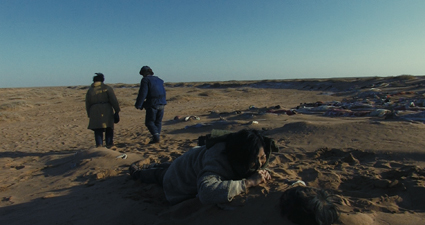
The Ditch
HONG KONG’S INTERNATIONAL FILM FESTIVAL EMBODIES ALL THE STRANGE CONTRADICTIONS UNDERLYING CHINA’S DIVIDED CONTEMPORARY CULTURE. ON THE ONE HAND THE CHINESE STATE HELPS PROP UP A FILM INDUSTRY BOOMING IN TERMS OF CINEMA NUMBERS AND BOX OFFICE SALES. ON THE OTHER HAND SOME OF THE NATION’S MOST TALENTED AND POPULAR FILMMAKERS SEE THEIR WORKS DELIBERATELY SHUNTED INTO QUIET SEASONS—JIANG WEN’S LET THE BULLETS FLY (2010) SPRINGS TO MIND, (P14)—TO LEAVE HOLIDAY SEASONS CLEAR FOR SAFER, VACUOUS HISTORICAL BLOCKBUSTERS OR OVERT PROPAGANDA LIKE FOUNDING OF A REPUBLIC (2009; RT94, P21).
Other key contemporary directors like Wang Bing are barely known on the mainland, their films not permitted in cinemas or on television. Only in Hong Kong—a part of China, yet culturally quarantined from the mainland—can these films rub shoulders, providing some kind of rounded picture of what’s happening in Chinese cinema.
the ditch
No title at Hong Kong this year highlighted the divide between China’s official and unofficial sectors more starkly than Wang Bing’s The Ditch (2010). While many Chinese features since the 1980s have touched on the suffering inflicted by Mao’s endless mass political campaigns, few have been so brutally raw in their depiction of the Maoist era. Wang emerged from China’s independent documentary sector in 2003 with his nine-hour epic West of the Tracks, about the closure and decay of a massive socialist industrial complex in China’s northeast. His documentary roots are in evidence in The Ditch, an unembellished realist drama based on Wang’s interviews with survivors of Mao’s labour camps.
The film opens with the arrival of prisoners in a vast desert landscape, which appears empty until the men are assigned beds in caves dug into the desert floor. This is the Gobi in China’s northwest, where thousands were exiled after taking up Mao’s invitation to speak out about societal problems in the Hundred Flowers Campaign of 1957. The severity of their desert plight was compounded by the food shortages that swept China in the wake of the botched Great Leap Forward. Wang disturbingly evokes the desperation of men on the edge of starvation, consuming roots they know will poison them and finally resorting to eating the corpses of fellow inmates.
This bleak tale plays out in long shots, the men only vaguely differentiated from each other as the indignities of prison camp life take their toll. They are dwarfed and ironically imprisoned by their wide open desert surrounds, adrift in a world utterly divorced from the urban environments they have come from. Wang shadows his characters in long tracking shots evoking the ghostly presence of the dead littering the landscape outside the caves. Every frame of this movie feels haunted—by hunger, death and the knowledge that the Chinese authorities have attempted to erase this history from the nation’s consciousness.
bachelor mountain
Yu Guangyi’s documentary treads more familiar ground, presenting a subtle portrait of the pressures placed on rural areas by China’s city-centric mode of development. In the country’s far northeast a logging community ekes out an existence in a harsh landscape now largely bereft of timber. Most of the local women have left for the promise of a better life in the cities.
We meet San Liangzi, a 46-year-old laid off worker, one of those left behind in this isolated community without money, a steady job or a wife. For a decade he has nursed a crush on Wang Weizi, a forthright woman more than 15 years his junior who runs a small inn, pursuing the tourist dollar with a single-minded determination. She also appears to be gay, a fact that does nothing to dampen her suitor’s obsession. During tourist seasons, he quietly tramps over to Wang’s inn every night, labouring without recompense as visiting urban tour groups indulge in hedonistic rituals of dancing and drinking around him.
Yu’s film is resolutely non-judgmental and handles San’s gentle, lumbering personality with tenderness. At one level the documentary is a study of quiet personal obsession, but we are also left to ponder the personal and social distortions created by economic circumstances that have left the mountain stripped of trees, the local community without young women, and men like San stranded with virtually no hope of a steady income or family life in their hometowns.
yulu
Jia Zhangke is one of the few filmmakers who has successfully straddled the divide between the commercial and independent industries in China in recent years, continuing to produce astute, innovative films since he began submitting his work for approval—and official mainland release—in 2004. His involving documentary, I Wish I Knew (2010; RT99, p17) appeared at HKIFF this year alongside the more recent project, Yulu.
It’s perhaps unfair to describe Yulu as a “Jia Zhangke film,” since he produced the work, which actually comprises a dozen or so short documentaries by seven different directors profiling “up-and-coming figures who the younger generation can easily identify with,” to quote the festival program. Jia directs the opening and closing segments, both of which unfortunately exemplify the film’s problems.
Jia’s opening portrait of Cao Fei, an entrepreneur who has created a groceries shopping website, is characterised by the lack of probing insight that runs throughout Yulu, reducing some of the episodes to the tone of a motivational video. The uncritical celebration of a “can-do attitude” becomes most problematic in the final segment—again directed by Jia Zhangke–on Pan Shiyi, Chairman of SOHO China, the developers who famously constructed a series of vast residential-commercial complexes around Beijing. Unsubtle attempts to ‘modernise’ the face of major Chinese cities have seen hundreds of thousands of people forcibly thrown out of their homes across the country, often with little or no compensation—a process that has greatly enriched developers and many government officials. Admittedly, SOHO’s complexes have largely been built on former industrial sites rather than residential zones, but like all such developments they have involved the commercialisation of land supposedly held by ‘the people’ under the socialist system, with the proceeds pocketed by officials. Jia’s uncritical celebration of a figure who has amassed immense wealth through this process is somewhat puzzling, given the attention his previous works have paid to China’s disenfranchised.
Other segments offered more interesting subjects, such as Chen Tao’s profile of the blind folk singer Zhou Yu and the AIDS charity worker Zhang Ying. Wei Tie presented a moving snapshot of Zhao Zhang, founder of the environmental NGO Green Camel Bell, while the strongest segment was Tan Chui Mui’s profile of investigative journalist Wang Keqin. Most of the episodes, however, suffered from the same lack of depth that plagued Jia’s contributions.
In the post-screening Q&A, an audience member pointedly asked if the film’s upbeat tone and theme of striding confidently forward were inspired by the walking figure of the Johnnie Walker logo. The liquor firm was the film’s principal sponsor.
a divided culture
If none of the Chinese documentaries at HKIFF this year had the power of last year’s Petition (2009; RT97, p16), Wang Bing’s drama The Ditch demonstrates the independent sector’s ongoing interest in unearthing China’s buried stories—and the cinematic power of these hidden tales. Meanwhile Jia Zhangke’s Yulu did nothing to combat perceptions that political and market pressures often work hand in glove to dilute directors’ critical prowess. While most of the Chinese films at HKIFF in 2011 fell somewhere between these two poles, the selection illustrated that for all the liberalisation of China’s cultural sphere in recent decades, there remains a sharp divide between what can and can’t be shown in official mainland content, reinforcing the unfortunate truth that much of the population remains ‘shielded’ from the nation’s most incisive film products.
35th Hong Kong International Film Festival, various venues, Hong Kong, March 20-April 5, www.hkiff.org.hk
RealTime issue #103 June-July 2011 pg. 15
© Dan Edwards; for permission to reproduce apply to realtime@realtimearts.net
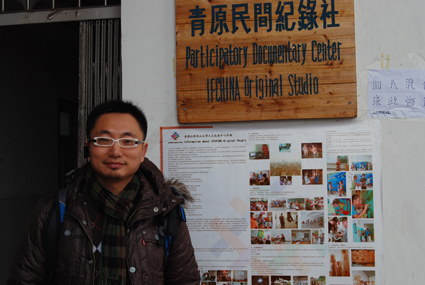
IFChina Studio founder and filmmaker Jian Yi, outside the studio on the campus of Jinggangshan University
JI’AN DOESN’T LOOK LIKE THE MOST AUSPICIOUS PLACE FOR A GROUNDBREAKING EXPERIMENT IN CHINA’S BUDDING CIVIL SOCIETY. THE TOWN DOESN’T APPEAR IN ANY ENGLISH LANGUAGE GUIDEBOOKS, THE LOCAL STATION PLATFORM IS JUST A LOW-SLUNG SLAB OF CONCRETE AND, IN EARLY SPRING WHEN I VISITED, A BONE CHILLING MIST HUNG OVER THE TOWN. YET THIS MINOR CHINESE CITY IS HOME TO IFCHINA ORIGINAL STUDIO, A BOLD ATTEMPT TO GENERATE COMMUNITY PARTICIPATION IN THE ARTS AND ORAL HISTORY IN THE HEART OF ONE OF CHINA’S POOREST REGIONS.
hidden stories
“We wanted to start with oral history because this place is so special—the Chinese revolution under Mao Zedong started here,” explains Jian Yi, a gently spoken local filmmaker whose credits include the documentary Super, Girls (2007). Jian Yi founded IFChina Original Studio with his wife Eva in 2009 on the campus of Jinggangshan University. Their activities include theatre classes, video workshops and photography programs, all built on an oral history foundation.
In a nation where history is always highly contested and politicised terrain, IFChina’s attempts to record personalised stories from China’s recent past and incorporate these into theatre and film projects is not only brave—it’s virtually unprecedented. “We are really doing groundbreaking work,” Jian Yi acknowledges. “We are facing an audience with zero literacy about documentaries and narrative films…many people who come to our screenings say, ‘That was the first documentary I ever saw’.”
Despite being a minor city, Ji’an provides fertile ground for a documentary maker looking to generate community interest in oral history. The remnants of the Chinese Communist Party fled to this area after thousands of members were massacred by Chiang Kai-shek’s forces in Shanghai in 1927, an incident that led to a fundamental shift in the previously urban-based party. As Mao Zedong rose to the fore with his vision of an agrarian-based revolution, the Communists regrouped and declared a Chinese Soviet Republic just south of Ji’an, a region they controlled until 1934, when encirclement forced them to embark on their “long march” to northwest China.
Since founding IFChina Original Studio, Jian Yi has been working with locals—mostly students from Jinggangshan University—to capture this history before it vanishes with only official accounts remaining that leave much unsaid. He cites a story from a 97-year-old local as an example of the tales they have uncovered: “This guy told a story of how his sister tried to get back the body of her husband, one of two men ‘wrongly executed’ by a faction of the Communists.” The murdered pair were local bandit leaders that Mao had persuaded to join his cause, but who were then killed in circumstances that remain unclear to this day. “The story was so human—you know, when we talk about Jinggangshan we think about this huge revolutionary era that’s so heroic. But this one little human story can reveal a side to the era that has been previously buried under slogans and a ‘grand’ historical narrative.”
IFChina Original Studio also works with locals to record more contemporary explorations of China’s rapidly shifting social reality. The 10,000 Village Writing Project will see students from rural areas at Jinggangshan University trained in recording oral history. “We’ll ask them first to write about their own family,” says Jian Yi. “We already have some young people writing about their experiences with the One Child policy. Most of the young female students from rural areas have younger brothers, so all of them have experience of the punishments of the policy. Then they will expand to their extended family, and the village as one community.”
One of their primary goals is to create a series of handbooks that will facilitate the creation of similar projects around the country, as well as hopefully leading Ji’an locals into more sophisticated forms of expression like documentary films. Jian Yi sees this nurturing of local culture as vital to China’s future, as the nation stands at a crossroads between its poverty stricken past and a materially wealthy but potentially culturally impoverished future under a system rife with restrictions.
“I’m convinced culture is a basic need,” Jian Yi asserts. “People are still trying to survive, but I don’t think we can survive as a proper society without culture. Many people around me are very cynical, while many people who do think independently tend to be very critical. I think it’s a step forward from not thinking at all, but then they don’t have the kind of positive energy which a society needs to cultivate and build something. I don’t think you can build something on negative energy, I don’t think you can build something on an emptiness.”
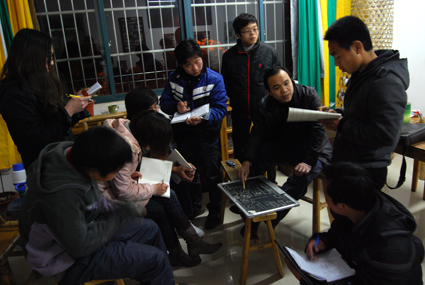
participants in the studio
reconnecting
It was his desire to build and cultivate a positive ethos in one of China’s more disadvantaged regions that led Jian Yi to give up a comfortable academic position in Beijing and return to his hometown to establish IFChina Original Studio.
“I lived in Beijing for more than a decade—going to school, teaching and working,” Jian Yi recalls. “Being in Beijing you really begin to have illusions about the country and you begin to misjudge many things. When I came back [to Ji’an] every year to visit relatives, I felt like I was in a different world. So that was the first objective—to get reconnected to social realities. The second objective was to do something similar to what Wu Wenguang and I did with the Villagers’ Documentary Project.”
The Villagers’ Documentary Project was an earlier attempt to forge a creative space for China’s rural classes, who despite comprising the majority of the country’s population, rarely have the chance to represent their own lives in any medium, let alone a relatively expensive one like video. Jian Yi was able to garner funding from an EU project on village governance in 2005 and worked with well-known Chinese documentary maker Wu Wenguang (whose credits include China’s first independently produced documentary Bumming in Beijing back in 1990) to train farmers in documentary making. Jian Yi says his work on the Villagers’ Documentary Project gave him the experience and confidence he needed to strike out and establish IFChina Original Studio a few years later.
international exchange
In addition to fostering localised forms of creative expression, an important part of the studio’s vision is giving Ji’an locals exposure to visiting foreign residents and interns. These programs, in turn, provide visitors with a chance to experience China away from the booming urban centres like Beijing and Shanghai. “I think it would be very exciting for people to come here to do their work, because it’s a totally different environment to Beijing,” enthuses Jian Yi.
IFChina’s internship program provides young people with interests ranging from arts management to filmmaking an opportunity to spend anything from one month to a year working at the studio. Similarly, the residency program provides a chance for scholars, artists and filmmakers with an interest in participatory cultural work to spend one to two months living on campus at Jinggangshan University, working with IFChina.
As well as accommodation, the studio provides volunteer translators who will help residents visit the region’s more remote revolutionary sites, including some historic villages. “You know, the social realities are there—Mao Zedong started from the villages here, and today China’s rural areas are still where China’s future has to come from,” comments Jian Yi.
Although IFChina Original Studio is clearly underpinned by an ambitious vision, Jian Yi sums up their work in quite modest terms: “We try to do very little things in a little community.” Yet as an earlier generation of Chinese in the same area demonstrated 80 years ago, little things with deep roots can one day change a nation.
Arts workers and scholars interested in internships or residencies at the studio should contact Jian Yi via the IFChina website at: www.ifchinastudio.org
IFChina Original Studio, Ji’an, Jiangxi Province, People’s Republic of China
RealTime issue #103 June-July 2011 pg. 16
© Dan Edwards; for permission to reproduce apply to realtime@realtimearts.net
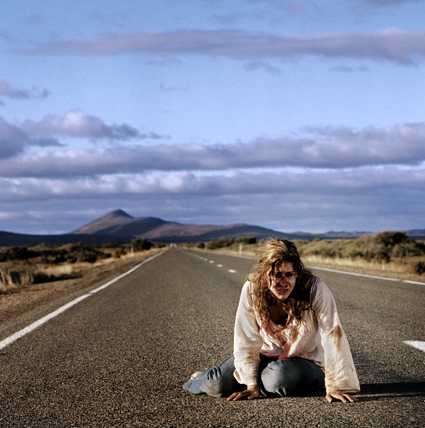
Wolf Creek
IN SPITE OF ISOLATED EARLY EXAMPLES SUCH AS LONG WEEKEND, PATRICK (BOTH 1978) AND RAZORBACK (1984), IT’S ONLY OVER THE LAST DECADE THAT AUSTRALIAN HORROR HAS TRULY FOUND ITS VOICE, GAINING INTERNATIONAL RECOGNITION, FINANCIAL SUCCESS, GRADUAL ACKNOWLEDGMENT AND SUPPORT ON THE PART OF AUSTRALIAN GOVERNMENT FILM FUNDING BODIES. THE NUMBER OF HORROR FILMS MADE SINCE 2000 (OVER 60) IS MORE THAN THREE TIMES THE NUMBER MADE IN THE 1990S (MARK DAVID RYAN, WHITHER CULTURE? AUSTRALIAN HORROR FILMS AND THE LIMITATIONS OF CULTURAL POLICY, MEDIA INTERNATIONAL AUSTRALIA INCORPORATING CULTURE AND POLICY, NO. 133).
saw
If one film can be said to have kicked off this boom in the genre, that would be Saw (2004), the first in what has become the most commercially successful horror franchise in history. The brainchild of James Wan and Leigh Whannell, two young Melbourne filmmakers, Saw, as an Australian success story, is notable for its complete lack of ‘Australianness.’ Picked up by Lionsgate in the US after failing to secure funding in Australia, Saw is internationalised horror—horror with an American accent but no clear national identity.
Sharing certain characteristics with Se7en (1995) and Silence of the Lambs (1991), Saw takes as its focus an intelligent serial killer who wants to play a game with those involved in his crimes. Although associated with the representation of strong violence, Saw keeps its gruesomeness in context and is not deserving of the disparaging ‘torture porn’ label bestowed (often justly) upon many of its imitators. In its pared-down, grim scenario, narrative is paramount. As with many a low-budget horror film, the initial set-up is minimal: two men regain consciousness to find themselves chained by the ankle at opposite ends of a grimy industrial bathroom. Between them lies a dead man.
The more mature, self-aware of the pair, Dr Lawrence Gordan (Cary Elwes) speculates, “Whoever brought us here could have killed us by now, but they didn’t. They must want something from us. Question is, what?” A mini-cassette each man finds in his pocket provides more riddles than answers. It also introduces the film’s main narrative preoccupation: the idea of the Game. The Game takes its cue from computer games (“Game over,” the killer tells his victim at the film’s end) as well as the competitive reality TV phenomenon, where distrust is fostered and contestants can only progress at each other’s expense. There is only one ‘winner.’ In keeping with the killer’s nickname, “Jigsaw,” the Game is also a puzzle that the victim-contestants must solve, full of hidden symbols, clues and riddles.
Jigsaw’s identity is part of the puzzle for viewers and characters alike. He hides behind an array of facades and disguises, including the puppet on a trike delivering the killer’s recorded messages; the assailant in a pig-mask; and Zep, the hospital orderly whom the audience are led to believe is Jigsaw, until we discover he’s just one more participant-’player’ in the Game. Jigsaw, like Se7en’s John Doe, is a moralistic killer who perversely attempts to teach his carefully selected victims the value of life. With its emphasis on saturated colour (green and red predominate), occasional frenetically sped-up scenes, the presence of puppets and masks and tricksy narrative, Saw uses stylisation rather than naturalism to create an atmosphere of horror.
wolf creek
Though spawning a similarly ‘iconic’ serial killer, Wolf Creek (Greg McLean, 2005) differs markedly from Saw in that it’s naturalistic and undeniably Australian. Before the opening credits, portentous documentary-style captions (much favoured by horror directors) appear onscreen informing us that, “The following is based on actual events. 30,000 people are reported missing in Australia every year. 90% are found within a month. Some are never seen again.” By adopting this visual characteristic of a documentary, Wolf Creek attempts to move its scenario out of the comfort of the cinema and into the lived reality of its audience.
Wolf Creek follows a trio of backpackers—Australian Ben (Nathan Phillips), Liz (Cassandra Macgrath) and Kristy (Kestie Morassi) from England—as they drive from Broome towards Darwin, taking in Wolf Creek Meteorite Crater along the way. McLean deliberately avoids in-depth characterisation; in the manner of a fly-on-the-wall documentary, the trio exists purely in the present. In the relatively long lead-in before any violence occurs, the emphasis is on their carefree youthfulness. As if to contrast with this innocent exuberance, and to offer a presentiment of future events, McLean hints at an ugly, misogynistic side of Australia from the film’s beginning. “They get real easy when they travel,” the Broome used car salesmen tells Ben, in reference to female backpackers. Later, a group of men in an outback pub joke about “gang-banging” the girls.
When Mick Taylor (John Jarratt), the film’s monster, appears, Kristy whispers, “He’s hilarious, he’s like one of those guys from Outback Australia shows.” This observation is underlined by parallels drawn in the film between Mick and his cinematic namesake, Mick “Crocodile” Dundee, with the latter’s famous “That’s not a knife” line quoted twice. Mick Taylor is Dundee’s dark counterpart. He’s also a figure with an intentional resemblance to backpacker murderer Ivan Milat, sharing the NSW serial killer’s enthusiasm for weaponry, hunting expertise, killing methods (severing of the spine, for instance) and protruding teeth. In Mick, the beer-swilling, sexist hunter stereotype in Ted Kotcheff’s seminal 1971 film Wake in Fright is taken to its extreme.
Despite the film’s title and some vaguely mystical allusions recalling Picnic at Hanging Rock (as when watches stop in the vicinity of the crater), there’s no sense of the landscape being threatening in itself. The real horror lurks in the ugly collection of sheds that constitute Mick’s hideaway, flickeringly illuminated in the darkness; and in his rifle sights, when a sunlit road provides no cover.
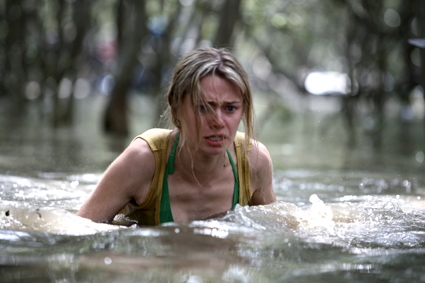
Black Water
black water
Horror takes us out of our comfort zone, which for a certain sub-genre, means following urban holidaymakers into the wilderness and whatever threat awaits them there. In Wolf Creek, it’s a psychopath, in David Nerlich and Andrew Traucki’s naturalistic Black Water (2007), a crocodile. Like Wolf Creek, Black Water uses ‘documentary’ captions, tersely explaining that the Northern Territory’s saltwater crocodile population is expanding alongside its human population. It’s also “based on true events.” As with Greg McLean’s follow-up to Wolf Creek, Rogue (2007), another crocodile film, Black Water’s subject is a river tour gone wrong.
Unlike Rogue, however, which uses stunning aerial shots and an animatronic croc to awe its audience, the minimalist Black Water works more subtly, employing landscape not as mere backdrop, but as an integral part of the threat. The camera dwells on the scenery: initially, accompanied by a gently strummed score, the river seems idyllic. Later, when a crocodile (real, not animatronic) has upended the tinny and killed the guide, the surroundings transform from peaceful to sinister. The three terrified protagonists taking refuge in a mangrove tree are interlopers negotiating a hostile environment: one that won’t let them escape. This is a film that manages to do much with relatively little.
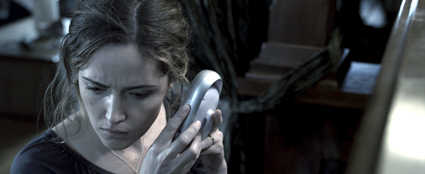
Insidious
insidious
All three sets of filmmakers are horror aficionados, but Whannell and Wan’s interest so far lies in generalised genre horror (in the manner of the Spierig Brothers, discussed in Part 2 of this article) whereas McLean, Nerlich and Traucki are concerned with developing distinctively Australian horror films. These variously draw on horrific elements of recent Australian criminal history and wildlife and the sinister potential of the landscape, as well as recalling Australian cinema classics. All continue to work in the genre: McLean has set up a production company and is working on Wolf Creek 2, and Andrew Traucki’s shark-themed The Reef was released earlier this year. With their new film Insidious (released in Australia in May) Whannell and Wan have taken their genre expertise and made what could be seen as a quintessential horror film: one designed primarily to scare.
As with Saw, Insidious is internationalised horror set in America, the only Australian element being the nationality of the female lead, Rose Byrne and of course its makers (Whannell also acts). In aspects of the art direction, certain scenes and the placement of a child at the centre of horrific events, Insidious is intentionally reminiscent of classic 1970s and 80s paranormal horror (think The Exorcist, The Shining, Poltergeist). Some of its stylisation even recalls Murnau’s Nosferatu (1922). Wan weaves these influences into a beautifully orchestrated film, which fulfils his early promise as director of Saw, demonstrating what he is capable of with a more generous budget and timeline.
Part 2 of The Horror: How Australian? will appear in RealTime 104.
RealTime issue #103 June-July 2011 pg. 15
© Katerina Sakkas; for permission to reproduce apply to realtime@realtimearts.net
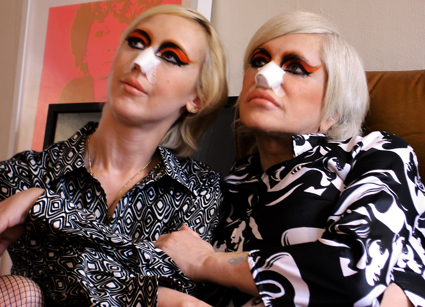
The Ballad of Genesis and Lady Jaye
REVELATION CONTINUES TO EXCITE PERTH AUDIENCES WHO ARE ENVIED EVERY YEAR BY THEIR INTERSTATE PEERS FOR THEIR ACCESS TO SOME OF THE WORLD’S MOST RECENT, STRANGE AND REVEALING FILM FARE. JUST A PRE-LAUNCH GLIMPSE OF A SMALL SLICE OF JACK SARGEANT’S 2011 PROGRAM, CURATED WITH HIS CUSTOMARY FLAIR, IS ENOUGH TO WHET THE APPETITE AND TRIGGER TREPIDATION. IN THE FOLLOWING CLUSTER OF FILMS THE BODY IS SEEN FROM A NUMBER OF PERSPECTIVES—AS ZOMBIE, THIRD GENDER, SKATEBOARDER RADICAL, CANCER VICTIM, MURDERER AND UNIVERSE-ENCOMPASSING ARTIST-SCIENTIST-PHILOSOPHER.
the advocate of fagdom
Angelique Bosio’s 2011 welcome documentary, The Advocate for Fagdom (France, 2011, 91mins, www.theadvocateforfagdom.com), will put Bruce La Bruce’s LA Zombie (RT99, p26) in perspective with its survey of the cult filmmaker’s output from shorts to the features Hustler White, No Skin Off My Ass and his zombie sex films. The specialist lineup of interviewees includes LaBruce himself, Gus Van Sant, John Waters, Harmony Korine (RT99, p16), Richard Kern and Revelation director Jack Sargeant. Bosio is a festival guest.
the ballad of genesis and lady jaye
Marie Losier’s The Ballad of Genesis and Lady Jaye (US, Germany, UK 2011, www.balladofgenesisandladyjaye.com/ballad/) investigates the ‘pandrogeny’ project of artist Genesis Breyer P-Orridge (70s performance art group Coum Transmissions; Throbbing Gristle; Psychic TV) and wife Lady Jaye transcending notions of gender by “transforming their bodies through cosmetic surgery into a third body.”
dragonslayer
Hot from SXSW 2011 in Texas where it won Grand Jury Award Documentary feature and Jury Award Best Cinematography comes Tristan Patterson’s Dragonslayer (USA, 74mins, www.dragonslayermovie.com). The film tracks an itinerant skateboarder Josh Sandoval as he journeys through suburbia “like the classic anti-hero, part-punk and part-bohemian, avoiding the bleak certainties of everyday life in favour of the magical pleasures to be had in skateboarding, hanging out with his friends and falling in love.”
gravity was everywhere back then
Described as “dreamlike,” the animated film Gravity Was Everywhere Back Then (Brent Green, 75mins, 2010, http://gravitywaseverywherebackthen.blogspot.com) will feature a live soundtrack performance by five of the film’s makers. It’s based on the true story of a man who, with love and hope, builds a healing-house for his terminally ill wife. Revelation reports that “director Green built a replica of the healing machine in his garden for the film, his own obsessions mirroring those of his subjects.”
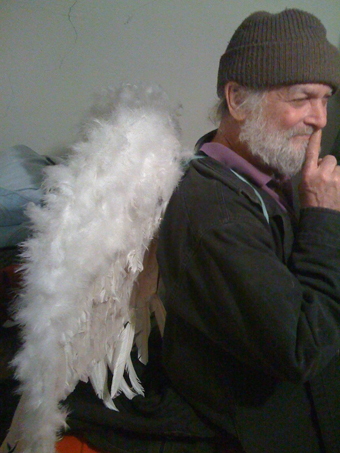
Heaven & Earth & Joe Davis
heaven & earth & joe davis
Peter Sasowsky’s Heaven and Earth and Joe Davis (USA, 90mins, 2011, www.joedavisthemovie.com) introduces us to artist, philosopher and scientist Joe Davis: “art and science fuse in his work; whether creating a genetically modified apple designed to tempt the Devil, recording the sounds of micro-organisms or encoding Greek philosophy into fly DNA.”
Stranger still is Davis’ account of “the broadcast of the harmonic frequencies of vaginal contractions into space as a comment on the censorship of gender by the space program.” Reevlation reckons that polymath Joe’s enthusiasms will generate a revitalised sense of awe about the universe of which we are part.
the redemption of general butt naked
The Redemption of General Butt Naked (Daniele Anastasion, Eric Strauss, 2011, USA, 84mins) won Excellence in Cinematography at this year’s Sundance (www.generalbuttnakedmovie.com). Revelation fills us in on the background to this documentary: “During the [first] Liberian civil war (1989-1996) Joshua Milton Blahyi, aka General Butt Naked, led his brutal army, many of whom were child soldiers, into murderous attacks. Known as the Butt Naked Batallion because of their habit of fighting naked in order to get the spirits to protect them, the Warlord and his men were responsible for thousands of deaths.” Blahyi has since reappeared as a Christian seeking forgiveness from victims and his own soldiers. The strength of the film lies apparently in its avoidance of easy judgment given the moral complexity of a post-colonial war.
soda_jerk v tony lawrence
If these films are not enough to make you see the world in a different light, Soda_Jerk v Tony Lawrence might do the trick. Instead of revealing unexpected realities, these artists play with the very way the world is mediated for us. Berlin-based Australians Soda_Jerk and Sydney’s Tony Lawrence present a feast of new and recent works using whatever comes to hand—mixing, mashing, experimenting in their very different ways. Soda_Jerk will premiere the epic Pixel Pirate 2: The Director’s Cut (2011), messing with iconic images, forms and sound-image norms. Lawrence will present four short films, “from the rock-based Goldtop Mountain, through to the poetic evocation Girl On Fire, the quasi-religious imagery of Monsignor Blood and the almost mystical From Water (2009-2011).”
Revelation Perth International Film Festival, Perth, July 14-22, www.revelationfilmfest.org
RealTime issue #103 June-July 2011 pg. 19
© RealTime ; for permission to reproduce apply to realtime@realtimearts.net
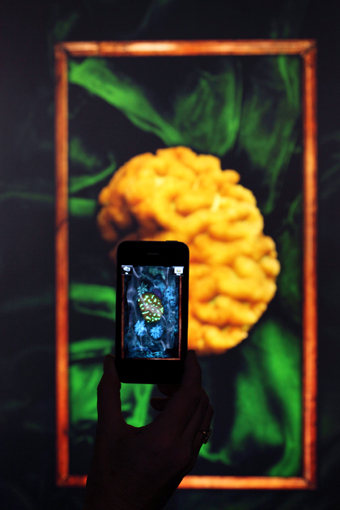
Rekindling Venus: In Plain Sight 2011, Lynette Wallworth, commissioned by Adelaide Film Festival
photo Tony Lewis
Rekindling Venus: In Plain Sight 2011, Lynette Wallworth, commissioned by Adelaide Film Festival
SOME TIME DURING THE WINTER OF 2010 I FOUND MYSELF BASKING IN THE WARM, SYNAESTHETIC GLOW OF AN ANACHRONISTIC SUN. THE DECKCHAIR ON WHICH I RECLINED PROVIDED JUST THE RIGHT VANTAGE POINT FOR CONTEMPLATION OF THE WONDERS OF ARTIFICIAL SUNSHINE. RATHER LIKE THE SUN DOMES OF RAY BRADBURY’S SHORT STORY “THE LONG RAIN” (1950), RAFAEL LOZANO-HEMMER’S GLORIOUS SIMULATED SUN INSTALLED AT MELBOURNE’S FEDERATION SQUARE OFFERED WELCOME RESPITE FROM INCLEMENT WEATHER. AS PART OF THE CITY OF MELBOURNE’S LIGHT IN WINTER FESTIVAL, SOLAR EQUATION RESONATES AS A PARABLE OF THE UBIQUITY OF DIGITAL LIGHT, ITS AMBIENCE IN THE CONTEMPORARY BUILT ENVIRONMENT, ITS FACILITY IN ENABLING SO MUCH OF WHAT WE SEE AND ITS REMARKABLE CAPACITY TO SUBSTITUTE APPEALING COPIES FOR THE REAL THING.
Such themes were among the concerns of the two-day Digital Light symposium, the public face of Genealogies of Digital Light, an ARC (Australian Research Council) Discovery project that seeks to provide a critical account of digital light-based technologies “by tracing their genealogies and comparing them with their predecessor media.” The principal researchers of the project and organisers of the conference—Sean Cubitt, Daniel Palmer and Les Walkling—conceived the event around a number of questions, chief among them the issue of how Australian and international artists working with light-based technologies are considering “the capacities and limitations of contemporary digital processes” in their work.
This reflexive gesture was welcome, for at face value the notion of digital light, in itself, is not immediately compelling as a framing theme for a packed two-day program of speakers. As if adding to my growing relief, Sean Cubitt’s opening remarks set the right conceptual tone for the event, asserting that there is still a “general ignorance” regarding digital technologies and how they actually work, despite their omnipresence in our lives. While this polemical sortie clearly identifies the research opportunity of the project, it also opened up a dialogue to do with the realpolitik of the digital, providing a reason why members of the public would bother giving up half their weekend to attend such a conference. Alvy Ray Smith, computer graphics pioneer and co-founder of Pixar, detailed the extraordinary and exponential development of computational power since the early 1960s in an entertaining and authoritative talk. He also set the digital record straight on a crucial point: pixels are actually round, not square.
The pixilated, block aesthetic of the 1980s and 90s that signified the emergence of the digital world was in fact an optical illusion, a mis-seeing of digital light. In a similar spirit of critical revisioning, Geoffrey Batchen boldly asserted, “photography has always been embedded in the DNA of digital media.” Among the many exquisite examples he discussed to support his position was Henry Fox Talbot’s 1839 contact print of two pieces of lace that he presented to Charles Babbage. “It’s as if Talbot wants to show us,” Batchen suggests, “that the photograph too is made up of a series of smaller units”—in other words, round pixels. Appropriately closing the show, Victor Burgin’s conceptually rich presentation also détourned the histories of cinema and photography, returning to their very origins in the manipulation of light and its capacity to fool the eye. Burgin’s own recent practice of compositing moving, panoramic montages from sequences of still images, evidenced the uncanny and even unsettling sensation of moving through a natural landscape that does not move with you.
The event certainly brought together an impressive who’s who of Australian and international artists, curators and technological innovators worthy of the radiance of Lozano-Hemmer’s sun. In this the symposium provided the refreshing opportunity to engage with historical perspectives alongside glimpses of contemporary aesthetic practices that explore the notion of digital light. Lynette Wallworth’s beautiful Rekindling Venus series engages with her concerns about the impact of climate change on ecosystems, using a cell phone app to transform hand-held media into a “virtual porthole to coral reefs and connected real-time data.” This canny use of augmented reality brings to life the illusion of a vibrant, three-dimensional world of fragile beauty. The symposium also offered Jeffrey Shaw the opportunity to document his long association with the wonders of light, from his expanded cinema events of the 60s, his light shows for bands such as Genesis in the 70s, to his immensely rich and varied experiments with immersive and interactive cinema and the convergence of real and virtual spaces as manifestations of light: a history that in itself charts the sedimentary record of artists working with digital technologies during the last decades of the 20th century, as well as looking back to the trompe l’oeil experiments of Baroque optics and illusionism in painting and architecture. Similarly, Stephen Jones’ comprehensive history of early electronic art within Australia added to the sense of a rich heritage of experimentation with digital light in this country. And as luck would have it (or was it an artefact of the digital?) Jones’ long awaited book Synthetics: Aspects of Art and Technology in Australia, 1956-1975 (MIT Press, 2011) was hot off the press, providing a concrete instance of the longevity on show in both his and Shaw’s presentations.
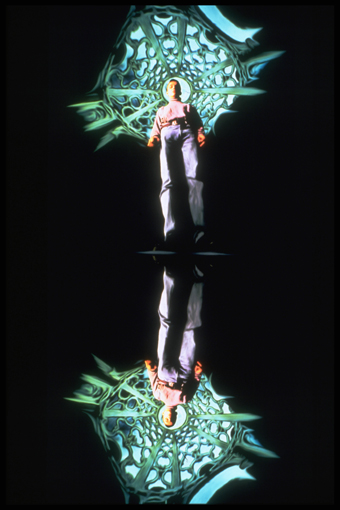
Heaven’s Gate 1987, Felix Meritis 1787-1987, Shaffy Theater, Amsterdam, Netherlands
With the advent of the minutely small (such as nanotechnology and biomechanics), a deeper questioning of the metaphysics of digital light is emerging, whereby the notion of “seeing,” as curator Christiane Paul eloquently described, becomes irrelevant. This alternative epistemology of light was taken in a different, haptic direction by Stephen Jones back to the telegraph in his re-tracing of the digital as a strict micro-economy of “on/off,” associating the digital “picture element” with the dots and dashes of the telegram. Alvy Ray Smith decisively quashed the hype around 3D TV and cinema, pointing to the misconception that 3D was ever possible on the two-dimensional screen to begin with, since it “happens in the brain, not in the display.” Smith also contributed to this galvanizing counter-phenomenology of digital light at the symposium with one of the most memorable aphorisms of the event, “Reality begins at 80 million polygons per frame.” But reminding us of Lucasfilm’s famous acronym REYES (“renders everything you ever saw”) may prove to be the boldest gauntlet thrown down to artisans of digital light in their quest for the highest-fidelity vision; the ultimate dream when the map will surely replace the territory.
Digital Light: Technique, Technology, Creation Public Symposium, University of Melbourne, March18-19, 2011
RealTime issue #103 June-July 2011 pg. 20
© Darren Tofts; for permission to reproduce apply to realtime@realtimearts.net
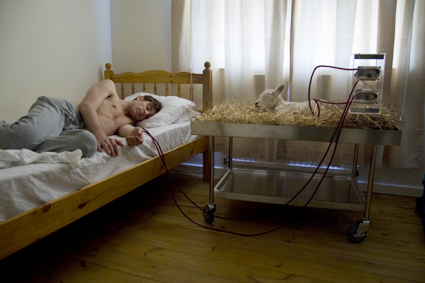
Life Support: Dialysis Sheep, 2009, Revital Cohen
image courtesy the artist
Life Support: Dialysis Sheep, 2009, Revital Cohen
IN A RECENT ARTICLE FEATURING ALEXANDRA DAISY GINSBERG’S SYNTHETIC KINGDOM PROJECT, HETTIE JUDAH ASKED, “WOULD PEOPLE STILL BE SCARED OF NANOTECHNOLOGY IF WE COULD MAKE IT STRAWBERRY FLAVOURED?” IN SOME WAYS THE ARTWORKS IN LIFE 2.0: ARTIFICE TO SYNTHESIS ARE SO SUBTLE THAT THEY DON’T NEED SWEETENING. NEW TECHNOLOGIES SLIDE INTO OUR LIVES IN SUCH AN INNOCUOUS MANNER THAT THE TECHNOLOGIES DISCUSSED IN THIS EXHIBITION SEEM TO BE ALREADY NORMALISED.
Much of the exhibition is couched in scientific-utopian terms which, on the surface, could be read as advertisements for synthetic engineering. The exhibition conjures an intense fascination for what we have done and can still do with synthetic life. There is only a slight feeling of discomfort about some of the proposed uses—a subtle twinge, miniature, like the subject matter of most of the artworks.
Some of the concepts that the exhibition asks the viewer to consider are not too far away from what people are already doing. If we can breed a sheep just for the purpose of shearing it, then why can’t we use the same sheep to provide dialysis for a human? Is one ‘use’ of the animal more humane than the other? If we use animals for our entertainment (pets, racing) or manufacture them for our food, why not use them as medical aids? Revital Cohen’s Life Support: Respiratory Dog and Dialysis Sheep proposes using retired working animals in medical programs, producing a symbiotic relationship between animal and patient. A lamb lies down on a bed of hay next to a sleeping man; the image is beautiful, softly lit and sensuous. Both man and lamb are connected to a dialysis machine, blood is feeding out of the man into the lamb, waste is processed by the lamb’s kidneys, a natural cleaning system, and eliminated through the lamb’s urine. Healthy blood flows back into the man. During the day the lamb is free to graze in the backyard and at night, while it sleeps, it is put to work. In a kind of chimerical/cyborg configuration, human, machine and animal come together and produce what curator Melinda Rackham describes as an emotionally and physically intimate healing relationship. Two of Cohen’s four photographs of Dialysis Sheep and Respiratory Dog are in everyday picture frames—taking the concepts further into the domestic arena—but are we ready to be so emotionally and physically (even parasitically) dependent on animals?
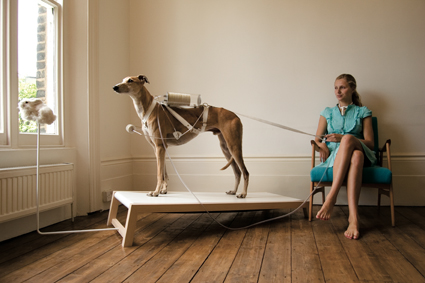
Life Support: Ventilation Dog, 2009, Revital Cohen
image courtesy the artist
Life Support: Ventilation Dog, 2009, Revital Cohen
Alexandra Daisy Ginsberg’s individual artworks and collaborations dominate the exhibition space. The Synthetic Kingdom: Synthetic Pathologies features beautiful luminescent photographs: Bioluminescent Kidney Stones, CMYK Plaque (on a set of teeth), Pollution-sensing Tumour Lung and Colonic Alchemy (gold faeces), with each body part showing anomalies formed by the body’s exposure to synthetic bacteria that have accidentally escaped from laboratories, factories and broken products. In this fictitious scenario, some of the bacteria have evolved, changing their function as they proliferate. Each image comes with a back story, such as Colonic Alchemy, where a patient’s waste material is turned to gold—although genetic testing failed to find the origins of the bacteria that caused this precipitation. These stories are almost believable; I found myself questioning whether this had already happened somewhere. Ginsberg plays with the fear of invasion/infection by our last ‘other,’ ie bacteria, with the alchemists’ quest finally answered by something that we have made, but cannot quite control.
In The Synthetic Kingdom: A Natural History of the Synthetic Future, exhibited as an animated video and as a diagram, Ginsberg explores the need to add a new branch to the Tree of Life—Synthetica. She asks, “How do we classify natural and unnatural if life is built from scratch?” The animation explores the way that life can be built from existing DNA rather than from petrochemicals. In E.chromi, collaborating with James King and the Cambridge University International Genetically Engineered Machine (iGEM) team, Ginsberg explores how the team constructed bio-bricks, synthetic genes which, when inserted into the bacteria E.coli began to secrete colours visible to the naked eye. The animation projects future uses for these bacteria: by 2039 they could be used to make a yoghurt drink which changes the colour of waste to indicate the presence of specific diseases in the body. A physical example of this is also exhibited as The Scatalog, a case of brightly coloured stool samples, each colour indicating a different disease. The animation also suggests that in the future a new profession will be created, with people searching the world for DNA that produces certain colours. Colour swatches are shown alongside a whale and a canary, perhaps suggesting that synthetic manufacture will not quite be able to stop the plundering of the natural world.
The two artworks by Richard Pell, from the Centre for Postnatural History, provide captivating catalogues of genetic research. A Selection of Noteworthy Genetically Engineered Bacteria, 2011-05-17, a cabinet of curiosities, features ‘highlights’ from the world of miniature synthetic life. Two samples that stand out are the Olfactory Art Bacteria, engineered in Bangalore India to produce the smell of fresh rain at the start of the monsoon season (why has this not been sold commercially?) and the GenTerra bacteria used by the Critical Art Ensemble, which was seized by the FBI in a mismanaged bioterrorism investigation. GenTerra was used in a performance that implicated the audience by giving them permission to release samples of bacteria into the atmosphere, one of which was possibly synthetically manufactured. These samples are fascinating as a catalogue of what can be done with genetic engineering—the presence of Gen Terra along with the sealed case that the samples are presented in is a reminder of the responsibility that accompanies this desire to tinker with the world. Pell’s Strategies in Genetic Copy Prevention looks at techniques that are used to control life, such as sterilising insects that were damaging the cattle industry in the United States and, on a more sinister note, sterilising humans (those considered to be criminal, idiots and rapists) in a plan passed in Indiana in 1907, a practice that died out after World War II. This is another reminder of the implications of these new technologies, beyond fashion and politics.
Deborah Kelly’s animation Beastliness is part of her ongoing exploration into the poetics of biotechnology. The animation features hand-cut chimerical creatures made of human, animal and plant parts dancing seductively together in a crazy mating ritual. Kelly writes, “The horizonless, post-species-specific possibilities of our new on- and offline lives demand sustained investigation as we tango into the far-fetched future, propelled by unchecked hungers.” In some ways, Life 2.0 is very clean and sanitised—if it weren’t for the uproarious music of Beastliness, inserted between the soothing pseudo-scientific soundtracks of Ginsberg’s animations, desire in all its messiness might not enter the gallery space. Kelly’s animation actively injects a little of the dystopian into the utopian future of manufactured scientific endeavour, moreso than some of the more subtle works in the exhibition. Beastliness leaves us with the question: what should we fear and what should we celebrate? It’s a question that bypasses the need for sugarcoating.
Life 2.0: Artifice to Synthesis, curator Melinda Rackham, RiAus Gallery, The Science Exchange, Adelaide, 7 April-July 8
RealTime issue #103 June-July 2011 pg. 21
© Kirsty Darlaston; for permission to reproduce apply to realtime@realtimearts.net
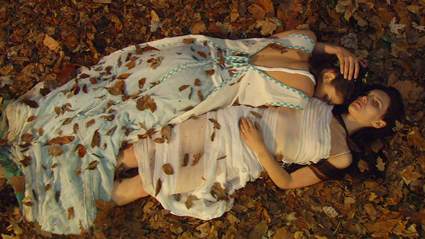
Penelope
BEN FERRIS’ 80-MINUTE DRAMA, PENELOPE, IS AN UNUSUAL WORK THAT PROVOKES REFLECTIONS ON CURRENT FILM AND VIDEO PRACTICES, NOT LEAST BECAUSE THIS INTENSELY VISUAL FILM WILL HAVE ITS PREMIERE AUSTRALIAN SCREENINGS IN A MUSEUM AND AN ART GALLERY. IT’S A FILM THAT ASKS YOU SURRENDER TO THE MOMENT.
With video art revitalised by relatively inexpensive, software-rich new technologies in the 21st century, art galleries have increasingly become sites for reflective viewing of works short, long, epic and looped. As per Christen Cornell’s encounter with Yang Fudong’s No Snow on the Broken Bridge and Seven Intellectuals in Bamboo Forest (p46), and in the tradition of video art, the viewing experience is supremely visual while cinematic expectations regarding character, dialogue, plot and structure are elided or subverted.
On the other hand, the experimental and feral heritage of video art increasingly sits beside sleek monumentally projected digital works, like those of AES+F and Isaac Julien in the 17th Biennale of Sydney, that are nothing less than cinematic in their scale and immersiveness. In fact the material distinction between film and video is fast disappearing, while not a few artists refer to themselves as filmmakers and leading visual artists—like Sam Taylor-Wood, Steve McQueen, Julian Schnabel—are making feature films.
Ferris’ film is a variation on the mythological tale of Queen Penelope waiting 20 years for the return of Odysseus, King of Ithaca, from the Trojan War. In that tale she is surrounded by 108 suitors who have assumed the hero is dead. Penelope defers choosing a new husband by focusing on the weaving of a burial shroud for her father, unravelling it nightly to extend the time of its making. Finally, she sets the suitors a near impossible archery task that the returning, disguised Odysseus executes with ease. He then kills the suitors.
Ferris’ telling is broadly true to the myth and sometimes to its detail (Penelope’s painful prayer to the god Artemis for death, for example), but in the end makes a surprising departure, one not to be revealed here but consistent with the film’s focus on Penelope herself. For the most part (save for cutaways to the loutish, gluttonous suitors), the film is realised as a sumptuous visual embodiment of her state of mind, shifting from recollection to reverie, delusion and nightmare, a condition amplified by the film’s real time unfolding and slow tracking shots. The camera’s long lines of movement and circlings suggest the omniscience of a storyteller who never speaks and is in no hurry to inform or guide us—there is little narrative propulsion and only spare dialogue. This is a film of the lived moment, quite apt for a contemplative gallery screening.
The slow pacing of the film correlates with a sense of timelessness in the late Jennie Tate’s expert production design. Penelope and her maids appear as if from a Classical frieze or a Renaissance painting of the same (glimpsed in the film’s opening), while the suitors seem attired like Florentine gentlemen. Odysseus in a trench coat smokes a cigarette and Penelope plays a 19th century piano. The elegant, modestly grand house has an Italianate openness and is imbued with a sense of mystery—perhaps the gods are at work, particularly towards the film’s end when huge timber doors are slowly buffeted then blown open and an aura glows around a determined Penelope. A single crow sits ominously on her windowsill. Wolves howl out of the emphatic sound design. Penelope’s silken weaving glows in the night like a spider web—and is unthreaded like one. The world of Penelope is an oddly disparate but simultaneously coherent one.
The formal camera work, its considered, painterly gaze and the symmetries of the film’s design are counterpointed by what they frame: Penelope’s disturbed state—her loneliness, her anguish over the sickness destroying her beloved geese, her imagined lovemaking with Odysseus in an autumnal forest and the nightmare of the suitors raping her maids (enough to soon stir her to action). It’s an effective dynamic in a film that warrants patient attentiveness to yield its subtleties and pleasures.
Penelope, director Ben Ferris, director of photography James Barahanos, production designer Jennie Tate, composer Max Richter, producer Irena Markovic; Australian/Croatian, 80mins; Nicholson Museum, University of Sydney, June 15, 6:30pm, free; Art Gallery of New South Wales, June 25, 2pm, free
RealTime issue #103 June-July 2011 pg. 22
© Keith Gallasch; for permission to reproduce apply to realtime@realtimearts.net
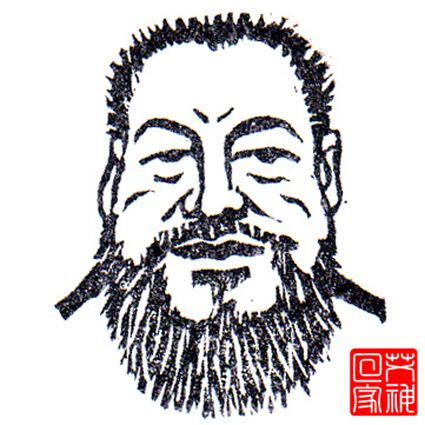
Free Ai Weiwei!, hand carved stamp by Carloe Liu
creative commons, some rights reserved
Free Ai Weiwei!, hand carved stamp by Carloe Liu
“IF IT CARRIES ON LIKE THIS IT WILL BECOME LIKE THE CULTURAL REVOLUTION.” THAT WAS THE ASSESSMENT EXPRESSED TO ME RECENTLY BY A WELL KNOWN CHINESE CREATIVE FIGURE REGARDING THE CURRENT SITUATION IN THE PEOPLE’S REPUBLIC. IF THAT SOUNDS LIKE HYPERBOLE, THE FACT THAT THESE WORDS ARE BEING UTTERED BY SOMEONE OLD ENOUGH TO REMEMBER WHAT THE MAOIST ERA WAS ACTUALLY LIKE IS INDICATIVE OF THE PREVAILING MOOD AMONGST THE NATION’S ACTIVIST AND CREATIVE COMMUNITIES.
On Sunday April 3, China’s best known contemporary artist Ai Weiwei was taken from Beijing airport as he attempted to board a flight for Hong Kong. He has not been directly heard from since. His wife, Lu Qing, told international media outlets on Monday, May 16 that she had been allowed to see the artist the day before for around 20 minutes—her first contact with Ai for six weeks. It is still not clear where or why the artist is being held. Four of Ai’s associates have also been arrested and have not been heard from now for seven weeks.
As well as being a prolific filmmaker, architect and designer, Ai Weiwei has long been an outspoken critic of the Chinese government. His domestic and international profile, however, led many to believe he was unlikely to suffer the harsh treatment dealt out to many lesser known opponents of the regime. In the words of The Guardian’s Jonathan Jones on April 4, his arrest is being interpreted as an attempt to “stamp out the idea that any individual is greater than the law of the state.”
Unfortunately Ai Weiwei’s case is just the tip of the iceberg. After anonymous calls for a Chinese “Jasmine Revolution” emulating recent uprisings in North Africa and the Middle East circulated online in mid-February, the Chinese authorities moved swiftly to neutralise the perceived threat. Initially political activists were targeted, including lawyers and well known bloggers. In March, they also began exerting pressure on parts of China’s creative community.
The China Human Rights Defender website claims, “The Chinese government has criminally detained a total of 39 individuals since mid-February.” Seventeen of these are still in detention, nine have been charged and are awaiting trial and three have already been sent to camps for “re-education through labour.” The claims are supported by a map detailing the names and locations of those detained (see chrdnet.org). Earlier this month the same organisation reported that around 200 others have been placed under various forms of “soft detention”—in other words, house arrest.
In addition, an unknown number of people across China have been subject to a ramping up of intrusive surveillance, harassment and interference in their daily lives. On March 18 for example, I visited the academic and documentary filmmaker Ai Xiaoming (no relation to Ai Weiwei) at Sun Yat-Sen University in Guangzhou. Ai has made numerous low budget documentaries focusing on controversial issues such as the spread of AIDS in rural China through unregulated blood collections.
As Ai Xiaoming led a translator and myself to her apartment, we were intercepted by a plain-clothed security officer who addressed Ai by name and asked what we were doing. He was joined a few moments later by another man and a woman, while two other men stood watching a few metres away. None of the group were uniformed or offered any form of identification. The first man informed Ai Xiaoming that we needed to accompany him to the campus security office (bao wei chu), while the woman asked me and my translator our names, occupations and places of origin. Ai Xiaoming agreed to accompany the “officers” if they let me and my translator go. As my companion and I made a hurried exit we were followed by other plain-clothed personnel into the subway station next to the campus.
On May 13 China Human Rights Defenders reported that Ai Xiaoming has recently received a high volume of “silent phone calls, believed to be automated, that have disrupted her phone service.” The keyhole to her front door was also recently filled with glue by an unknown harasser.
Although certain filmmakers and artists have long been under surveillance and subject to phone taps, since the 1980s it has been rare for Chinese authorities to physically prevent artists meeting with foreigners. It is a disturbing development that the kinds of restrictions that more radical political activists have long endured are now being extended to established creative figures.
In more bad news for China’s film community, on April 18 organisers announced the cancellation of the 8th Documentary Film Festival China, an event staged annually since 2004 in the far flung Beijing suburb of Tongzhou. The festival is one of a handful of regular events in China showcasing films made outside the country’s state-controlled approval system. The 2011 edition had been planned for the first week of May. Critic and programmer for the Vancouver International Film Festival, Shelly Kraicer, reported on the dGenerate website (www.dgeneratefilms.com) on May 12 that, “Several levels of government, represented at a surprisingly high level, made it clear…that this was not the right time for an independent organisation to screen Chinese films that the state has not authorised.” Kraicer also claimed that foreign visitors who had journeyed to Tongzhou were followed by plain-clothed police.
The literary world has also been affected by the tightening of the cultural sphere. On March 27 Yang Hengjun, a China-born Australian novelist and blogger, disappeared in the city of Guangzhou. He resurfaced the following weekend and was allowed to return to Australia via Hong Kong, but he declined to elaborate on his experience.
Writer Liao Yiwu was less fortunate. In early May he was denied permission to leave China to attend the Sydney Writers Festival to talk about his new book, The Corpse Walker. This turn of events was disappointing but unsurprising—writers’ organisation PEN claims that Liao has been denied permission to leave his own country 14 times in the past three years.
It remains to be seen whether the present crackdown represents a longer term hardening in the government’s attitude or is simply a panicked, typically heavy-handed response to events overseas. Either way, it’s a sobering reminder of the immense arbitrary power wielded by China’s ruling party and how quickly cultural liberalisation can be wound back when the state feels threatened. Even if all the detained figures are released tomorrow, the atmosphere of fear will linger, intensifying the already pervasive self-censorship that exists in China’s media and cultural spheres. Which is, of course, precisely the intention. The message from the authorities is clear—the right to creative expression in China is always on notice.
This report is an updated version of the one originally appearing in the e-dition of May 10.
RealTime issue #103 June-July 2011 pg. 23
© Dan Edwards; for permission to reproduce apply to realtime@realtimearts.net
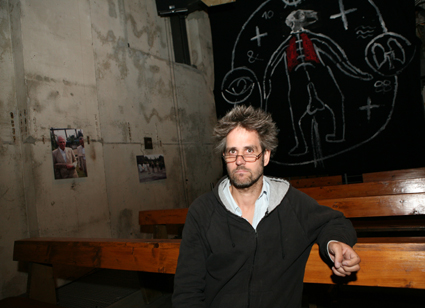
Christoph Schlingensief preparing for Church of Fear (2003)
photo © Ursula Kaufmann
Christoph Schlingensief preparing for Church of Fear (2003)
ART WITHOUT BORDERS, EDITED BY TARA FORREST AND ANNA TERESA SCHEER, RECENTLY PUBLISHED BY INTELLECT, IS THE FIRST MONOGRAPH ON CHRISTOPH SCHLINGENSIEF, THE GERMAN THEATRE AND FILM ARTIST WHO DIED IN JULY 2010. IT IS THE FIRST ENGLISH LANGUAGE RESOURCE ON THE MAN CONSIDERED TO BE ONE OF THE MOST IMPORTANT 20TH CENTURY ARTISTS OF THE GERMAN SPEAKING WORLD, BUT ALSO THE FIRST ACADEMIC STUDY OF A VERY PROVOCATIVE OEUVRE. I SPOKE IN MELBOURNE WITH ANNA TERESA SCHEER ABOUT THE ARTIST AND THE BOOK.
First things first: Schlingensief is almost entirely unknown in Australia.
In 2008, when I returned to Australia, I realised Schlingensief’s work was among that which had really impressed me during my 14 years in Germany—especially when I realised how apolitical Australian art had become in the Howard years. For example, there was no attempt to test the sedition laws. People seemed afraid of losing the support of the funding bodies. Schlingensief, by contrast, had gone out on a limb time after time, in Germany, Switzerland and Austria. He was arrested twice and wasn’t bothered about the consequences.
In Germany, I was used to him being a household name—an unusual position for a theatre artist. It became especially apparent to me that his work needed to be written up when I began my postgraduate studies. He’s not mentioned in any of the ample literature that was coming out on politics and performance. American and British perspectives dominate the field, and still focus on people like Augusto Boal. Even Baz Kershaw, in The Radical in Performance, still talks about The Living Theatre and the Welfare State International from the 1960s.
After nearly 30 years of work, not much has been published on Schlingensief. Of course, there were articles in German papers and magazines, but that’s not the same as a scholarly, referenceable book. His work wasn’t considered serious—which didn’t detract from its power, from it being always sold out at the Volksbuehne in Berlin. The writing that did get published was primarily from his own collaborators. I was interested in how other people thought about the work, how it could be understood. In this book, we move from Adorno to Brecht to Goffman, looking for interpretive context.
We know Schlingensief as a theatre-maker, but his theatre career was an accident. He was an underground filmmaker when Matthias Lilienthal invited him to work in the re-established Volksebuehne in former East Berlin.
An incredibly smart move for Lilienthal, to pick up on a man who says his films were only ever going to be shown in cellar cinemas. Schligensief was invited after making the third film in his German trilogy, Terror 2000: Intensive Station Germany, which lampoons Germany’s memorial culture—politicians laying wreaths at every opportunity, the Gladbecker hostage disaster, the plight of the asylum seekers—piling up a lot of stuff together using very unaesthetic, trashy means. The film was called sexist, racist, every negative epithet you can imagine. And he was invited by Lilienthal to retort to critiques in a stage production.
I am intrigued by Rocky Dutschke ‘68 (1996), an early theatre work in which he tried to confront the Left’s nostalgia for the 60s and uncritical emulation of kinds of protest that are now futile.
It tried to re-create the 60s: Schlingensief in a Dutschke wig inciting people to go into the theatre, then out again for a protest, a love-in in the theatre…It inquired into the leftist mythology of Rudi Dutschke [assassinated leader of the West German student movement in the 1960s], seriously asking: is anything like this still possible, or are we all postmodern super-cynics and resistance no longer imaginable?
He really targeted the Left’s idealism: ‘We’ll still find the working class, who will revolt and take over.’ He wasn’t interested in that sentiment. You could absolutely not describe him as a leftist in those terms. He was an anarchic spirit, whose line was one of inquiry.
In your book cinematographer Sandra Umathum reflects very personally on what it meant to experience Rocky Dutschke ‘68.
The difficulty of writing about Schligensief’s work is that it was different every night. He throws dramaturgy overboard, gets rid of previously made agreements with the actors; he will on the spur of the moment upturn the whole thing. Key sections may remain—or maybe not! Schlingensief’s theatre work was not fuelled by a great love of theatre, of wanting to follow in Brecht or Grotowski’s footsteps. He was experimenting with theatre like a child with plasticine. What can you do with this? He was interested in the way theatre was never finished, but happened anew each night.
Rocky Dutschke ‘68 was the first performance in which Schlingensief used non-professional performers, a practice he continued throughout his career: people with disabilities, the homeless. In Hamlet in 2001 he conscripted a bunch of reformed neo-Nazi youths. He was not interested in the ‘show me your wounds’ approach in which we turn up to be compassionate. The audience is not allowed complacency.
He was not doing it to elevate the status of a minority, but to get to the core of societal problems—and not in a linear or simple, causal way. People forget how turbulent Germany was in the 90s. Moving the capital back to Berlin, the ‘media chancellor’ Gerhard Schroeder, then the bombing of Belgrade, the first time German troops were employed since WWII. Germany was outraged: this happened under a red-green government! Then the ongoing reunification debate: will we become the great nation of fascists again? All these things swirling around, as if in a washing-machine. And that is how these productions looked: like questions, with actors representing contemporary politicians, with references to the Nazi past…but always as this “past that will not pass.”
Was he an heir of Brecht in that sense?
Yes—the audience had to sit there and critically engage with their own society and socio-political problems, because he wasn’t telling them what to think.
PASSION IMPOSSIBLE, 1997
Passion Impossible was an inquiry into the city of Hamburg. Schlingensief was invited to create a work at the Deutsches Schau-spielhaus in Hamburg, Germany’s largest theatre [whose production Pornography was presented at Melbourne Interntional Arts Festival in 2010].
At that time, Hamburg station, which sits opposite the theatre, was literally a camp for the homeless and drug users. To get to the theatre, you had to step over their bodies. Schlingensief was essentially a moralist and found this situation unbearable. He first suggested to the administration they tear down the facade of the theatre and turn around the seats, to face the theatre across the road, the theatre of misery. The theatre rejected the proposal ‘for technical problems.’ Instead, they agreed to sponsor a benefit gala, to raise money for a mission.
The seven-day event Schlingensief staged was a mission in the former police station down the road and a series of mass events in public space. You had him standing outside the theatre in a policeman’s jacket with a megaphone, encouraging the theatre patrons to “come away from this ugly bunker! There’s nothing in here for you!” Like the Pied Piper of Hamelin, he would encourage people, having bought their ticket, to leave the building and come to the mission, which was a real mission—with beds and a soup kitchen. Here they had an open mike, a small stage and people could speak about whatever they wanted. He had an accordion player, the Salvation Army band, people singing songs…All sorts of little moments of what could be called entertainment.
Was this real or just a provocation?
It wasn’t clearly outlined. The theatre had publicised the event. The audience would buy tickets, then walk 200 metres up the road to the mission. You were paying to be involved with the people you would normally completely ignore, would never encounter in your daily life, or could have easily dealt with for free!
Participating in it was a provocation to oneself. Some of the stories of the homeless people were just awful. Early on, at the benefit gala, Schlingensief appeared with a decrepit battery chicken, and asked: “I want to see how much money can be raised to save the neck of this chicken!” People in the audience started protesting but he said, “We eat these chickens every day. What do you care about its life? I want to know how far people will go. We’re all addicted”—addicted to one’s own sense of doing good, of being a good citizen. We responded to the phone call, turned up at the benefit gala, did our little bit, even if otherwise we don’t really care. But now we’re really worried about the chicken!
But the main provocation was to the Lord Mayor by getting the citizens to eventually march up to the Town Hall, asking for the mission to continue. It became permanent.
I found Passion Impossible fascinating because it took it right out onto the streets. It is not dissimilar to Augusto Boal’s invisible theatre. There was a lot of media around. Questions were asked: Is he serious? Is this a charity campaign? Is it performance? Of course, it was all these things. And it evolved into an actual campaign, which he couldn’t have planned in the beginning. The work really asks: can art do something that politics can’t, create impetus for change? It questions our idea that artists can at best be pranksters. This is very different from watching The Chaser boys having a good time.
PLEASE LOVE AUSTRIA, 2000
I remember the reverberations from Please Love Austria (2000) as it made news throughout Europe that summer. There were riots!
2000 was the year when the liberal Austrian government became the only one since WWII to form a coalition with a far-right populist party, FPÖ, led by Jörg Haider. Sanctions were imposed on Austria. All of Europe was aware of Haider’s anti-immigrant campaigns.
Schlingensief was invited to create a work for the Vienna Festival. It was planned that shipping containers would be placed in the centre of town, on the Opera Square. These containers would be the living quarters for 12 asylum seekers for a period of seven days. Inside were webcams streaming to a website and Austrian citizens were encouraged to vote out their least favourite inhabitant, who would be taken to the border and deported. The winner would get 35,000 schillings and the possibility of becoming an Austrian resident by marriage. It followed the Big Brother format, which had just appeared.
It was only when Schlingensief, opening the show, revealed a large banner on the container, which said “Foreigners Out.” that it stopped being a game, or even funny. This is a well-known right-wing slogan: “Germany for Germans, Foreigners Out.” Jaws dropped. It attracted growing attention. People were coming through town for the festival and Schlingensief was there with a megaphone, exhorting tourists to take photos: “This is the future of Europe, this is Austria, send this to your friends at home, dear Japanese, dear Americans!” Austrians were shocked: “Besmirching our country!” Schlingensief kept publicly inviting Jörg Haider to meet with the asylum seekers—involving him in the performance, in absentia. The national boulevard press, the Kronen-Zeitung, were writing every day: “This Schlingensief clown is costing you money, dear readers.” Schlingensief retorted that they were just writing the program notes to his event.
The Left were campaigning against Jörg Haider. They saw the “Foreigners Out” banner simply as a provocation, accusing Schlingensief of misusing asylum seekers for his project. They marched around the container, demanding that he set those inside free, showing mind-boggling naivety—these were real asylum seekers, all with cases pending.
In the end they stormed the container.
Jumped on the roof, destroyed the banner, demanded a meeting. The asylum seekers had to be evacuated. The protesters then realised these were real asylum seekers and had to question their own activities. When they finally left, Schlingensief raised the ante by putting up an SS slogan that had been used by an FPÖ member: “Loyalty is our Honour.”
In that moment, it was as if Schlingensief reminded everyone that we were watching an art performance and that the real issue was only being represented. It questioned the efficacy of removing a symbol as a political action.
The Left-Right binary looked pathetic. The Right couldn’t take down the sign and government officials taking down an artwork would look pretty stupid. On the other hand, leftist protesters making insane demands weren’t effective either. Set the asylum seekers free—for what? Where?
The show wasn’t so much about the asylum seekers. Austria was televised around the world—the theatre was the Austrians, watching each other perform. Whatever happened, Schlingensief incorporated it into the work. That was the fun aspect of it. He didn’t have to rise to the bait or argue that this was a serious piece of political art. He would say: “I’m just repeating what Haider has been saying.”
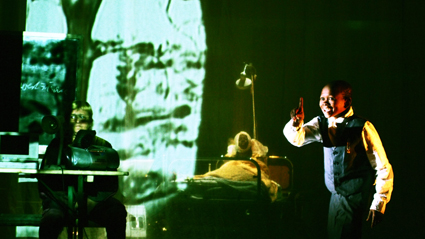
Kerstin Grassmann, “Kandy” Mamounata Guira, Amando Komi in Christoph
Schlingensief’s award winning 2010 work Via Intolleranza
Slavoj Žižek calls this “radical overidentification”— an artistic position where you critique by overstating, by taking a claim to its absolute extreme to reveal its ugly possibilities.
Please Love Austria was a perfect example—the asylum seekers being forced to learn German, do callisthenics…It’s not as if Austria changed when the project left. That didn’t see the end of the coalition. But it showed how art can be directly involved in events of the day, in a very radical way.
In the book you point out the connection between Schlingensief’s work and the neo-avant-garde of the 1950s. You write about “an art practice that emerges from the social sphere—and that develops out of the active, creative participation of the viewer.”
The comparison with happenings is not wrong—everyday life, spontaneity, experiments. Schlingensief didn’t start something with a blueprint of how it should end, but set it in motion like a wind-up toy, to see where it goes. In Germany he is often considered the inheritor of the legacy of Joseph Beuys. Beuys’ discussions, definitions, ideas—of social sculpture, of an expanded form of art—Schligensief co-opted for his own ideas on an expanded form of theatre. Getting rid of the fourth wall, people leaving the theatre for the streets. That became really clear in 1998, when he ran his own political party in the German election.
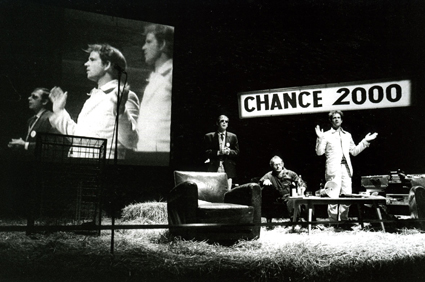
Christoph Schlingensief (right), Chance 2000—Vote for Yourself (1998)
photo © Aino Laberenz
Christoph Schlingensief (right), Chance 2000—Vote for Yourself (1998)
CHANCE 2000—VOTE FOR YOURSELF, 1998
It started off with an event at the Volksbuehne. Schlingensief had a circus performance set up in a tent—the “electoral circus.” But at the same time, he started his own media campaign on national television about Chance 2000 – Vote For Yourself (1998). He was encouraging the disabled and the unemployed to run as political candidates. “None of these people in the Bundestag represent you. The idea that you will be represented by someone else your whole life is ridiculous—you have to prove you exist. Get involved in starting your own campaign.”
He toured Germany in a bus, campaigning non-stop. It wasn’t a completely serious attempt to form a political party. He would say, “Unlike all other politicians running in this election, the only promise I am going to make is that everyone will be bitterly disappointed.” Then he decided that the people who joined the party were too boring, left it and set up the Schlingensief Party. He wouldn’t let those he rejected into his new tent, but after two days they reunited. A very clever German reviewer commented that Schlingensief gave us a short run-through of democracy in a week. Parties, factions, reuniting, splitting up, another leader emerging, and all happening with such a turbulent tempo!
Germany was baffled: vote for yourself? Is he lampooning the election? The party got 30,000 votes. But the idea wasn’t that they would take over the Bundestag but rather “prove you exist.” In this world, where the only voices we hear are those of rich politicians, who are these faceless unemployed people, apparently numbering six million? He was demanding you make yourselves visible in a world that’s trying to erase you.
There was a lovely offshoot action of Chance 2000. Schlingensief announced that the six million unemployed would join him to jump into a lake, Wolfgangsee, where Helmut Kohl’s villa is, to raise the water level, flood Kohl out and give him cold feet. The police were sent to the village, all sorts of preparations were in place. Schlingensief turned out with about 300 people. But Kohl ‘participated,’ against his will, in a performance. It doesn’t really matter if it did or didn’t happen. People saw the clips, it was national news that there hadn’t been 6 million people, only 300.
Schlingensief really understood the sound-byte world we’re living in—he created a mythology around the work, pretending things would go further than they actually could, and were bigger than they actually were.
How did Schlingensief’s work fit into the German theatre context? I remember when Denise Varney [Theatre Studies, University of Melbourne] showed a clip from Please Love Austria in class there was incredible consternation about whether such an action was legal or not. In Germany Schlingensief reached the status of a star. He directed an opera for the Bayreuth Wagner festival. He was not living in a live art ghetto, the way one would expect here.
Events such as the one he staged in the election campaign of 1998 made him nationally prominent, while internationally it was Please Love Austria. He became the biggest name in art in Germany. After years of people saying it wasn’t real theatre, the fact that he wasn’t going away and was finally invited to direct Parsifal at the shrine of Wagner in Bayreuth, meant that he was finally accepted. On the other hand, he never became an intendant of a theatre—people didn’t trust him on that level. But after he contracted cancer, when he was only 47, he released a book—his cancer diary, titled Heaven Can’t Be More Beautiful Than Here—and it became a bestseller.
SHOCKED PATIENTS
He started a website, Shocked Patients (www.geschockte-patienten.org). The first thing he found out as a cancer patient is that you lose all autonomy. People start shoving tubes into you, no one talks to you, they talk over you. You are again erased. He created a forum for people diagnosed with terminal diseases, cancer and ALS [amyotropic lateral sclerosis] to write about their experiences, to have their own voice.
He had previously created a performance called Art and Vegetables (2004) at the Volksbuehne, in which, centrestage, was a woman with ALS, in bed, able to write messages by blinking at a computer screen. The woman, Angela Jansen, was quoted in the program, saying, “I’ve got everything I need, it’s just that I can’t move.” He used that as a reference to German society of the time. The woman became the forum moderator.
It’s not as if he avoided scandal, he sought the media, did things knowing they would provoke a reaction—saying unkind things about Lady Di, for example. But there is also his metaphorical language: “Jump into the lake and give Kohl cold feet,” or relating physical sickness to a social sickness and lethargy.
One of the reasons it’s hard to talk about Schlingensief’s work is because he covers so many forms: happening, performance, theatre, film, activism, politics. It’s hard to sum up his work. One motif is, perhaps, visibility, the other is putting himself in his work. And particularly interesting to me, in these times of complete social inertia—I’m thinking Australia now—is his idea of movement, getting out of torpor and lethargy. He often took to the streets with groups of people. “Move! It doesn’t matter where we’re going. I don’t even need a plan.” No need for direction – you just move. “We’ll figure it out as we go.”
Tara Forrest and Anna Teresa Scheer eds, Art Without Borders, Intellect Books, 2010; www.intellectbooks.co.uk
RealTime issue #103 June-July 2011 pg. 24-25
© Jana Perkovic; for permission to reproduce apply to realtime@realtimearts.net
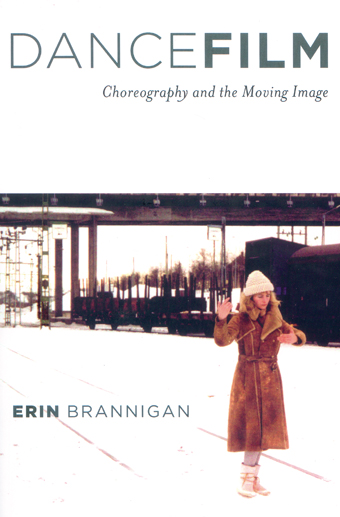
Dancefilm: Choreography and the Moving Image,
CHOREOGRAPHER WILLIAM FORSYTHE STATED, “THERE ARE WONDERFUL INNER THINGS HIDDEN WITHIN DANCING,” AND FROM THE LATE 19TH CENTURY TO THE START OF THE 21ST, SCREEN-BASED EXPLORATION HAS OPENED ACCESS TO ALTERNATIVE MOVEMENT WORLDS, ENGINEERING ALONG THE WAY THE CROSS-BRED DISCIPLINE OF THE DANCEFILM.
Formulating an academic approach to this field of study has been a more recent development, with groundwork laid over the last 10 years by a variety of approaches and writers. However in the introduction to her new book, Dancefilm: Choreography and the Moving Image, Erin Brannigan notes a ‘stand-off’ between dance and film discourse, with an often unclassifiable hybridised form left languishing in the theoretical margins. Brannigan manages to integrate both strands in a deeply rooted field of critical thought, making reference to Walter Benjamin, Henri Bergson and Gilles Deleuze among others. She also nods to contemporary dancefilm practitioners—David Hinton, Miranda Pennell and Gina Czarnecki—with examples of work on an accompanying website. The book comes into its own, however, as an historical tour-de-force, probing deeply into cultural causes, presenting the reader with a spiralling timeline of critical nexus points.
Brannigan sets the scene by arguing convincingly for the emergence of, in Bergson’s phrase, ‘modern movement’ as symptomatic of the neurasthenic, turn-of-the-20th century city-dweller’s state, set within a wider historical context of technological transformation. Here, the primacy of the pose in classical ballet and still photography gives way to a notion of constant flux. This notion is presented as the defining characteristic of both modern dance and moving pictures, which are as inseparably entwined in Brannigan’s reading as the twin strands of a double helix.
Placed centrally to this argument is the work of solo performer Loïe Fuller, whose serpentine spin weaves through the cultural milieu of fin-de-siècle Paris, reflecting and expanding on the ideas of Mallarmé, Valéry, the Lumière Brothers and Georges Méliès. Neither ballerina nor showgirl, ‘La Loïe’ was the first artist regardless of gender to claim the title of director/choreographer, manipulating billowing fabric around a shrouded body as lighting effects conjured a continuous stream of allusion—flowers, butterflies, fire and snow. Complete in herself as a one-woman ‘moving image,’ Fuller is positioned by Brannigan as prefiguring the thematic and operational territory of both avant-garde film and postmodern dance.
The threads of this lineage are traced along multiple pathways, finding resonances between the work of Jean Renoir, René Clair and the Dadaists and writing on non-narrative cinema, such as that of Hungarian theorist Béla Balázs on the expressive potential of the close-up. The latter is explored in depth, with the abstracted play of bodily detail—the twitch of a finger, the ripple of a spine—central to much contemporary dancefilm cast as ‘micro-choreographies,’ small-scale, transformational experiments in ‘movement-for-movement’s sake.’ Brannigan also traces the historical roots of Delsartism—a gesture-based system of actor training—noting its role in the highly physical performance style of silent-era stars such as Lillian Gish and Charlie Chaplin. Tracking the pathways of this tradition through the pedagogy of the Dennishawn school and the Graham Studios, Brannigan winds her way towards the psychologically charged, non-linear montages of Pina Bausch and Wim Vandekeybus, finding particular significance en route in the gesture-heavy waking dreamscapes of Maya Deren.
A figurehead for the mid-20th century Greenwich Village avant-garde, Deren’s writing on a choreographic dimension to filmmaking is highlighted as central to an understanding of the field. Deren’s notion of “horizontal form”—where the feeling state of being-in-the-moment is explored in depth—provides Brannigan with a template for analysis not only of experimental film, but also for the Hollywood musical, here cast as “longer format vertical film form.” In contrast to much pre-existing, production-led analysis, Brannigan approaches this territory by highlighting the phenomenon of highly nuanced transitions between performance modalities. Focusing on a central—often female—physicality, she contrasts the precise, self-contained technical style of Ginger Rogers with the long-limbed, ground-covering expansiveness of Rita Hayworth, while casting the hyper-expressive sensuality captured in Marilyn Monroe’s close-ups as micro-choreographies in themselves. However Brannigan finds fullest expression of Deren’s ideas in the work of choreographer/director Bob Fosse, with Liza Minelli and Shirley MacLaine barely keeping in check an edgy over-exuberance, spilling out into highly stylised song-and-dance numbers.
Deren’s input is also tracked through convergence points where avant-garde film and dance intersect, noting her influence on the work of artists such as Shirley Clark, Amy Greenfield and Norman McLaren, before arriving squarely at the writings of Judson Church alumnus Yvonne Rainer and the movement research of fellow downtown Manhattanite Trisha Brown. Rainer noted that “dance is hard to see,” and Brannigan observes that Brown’s exploration of uninflected sequencing— characterised here as “anarchic phrasing” and as a lack of conventionally “privileged moments”—pushes technical boundaries in registering the “in-betweenness” of a work such as Watermotor (1978), ultimately captured in otherworldly slowed-motion by Babette Magnolte’s cinematography.
In her concluding chapter, Brannigan makes the case for a hugely disparate “cinema of movement,”—identifiable throughout genres from abstraction to advertising—bringing together the body-centric notion of ‘somatic intelligence’ and Jean-François Lyotard’s concept of “somatography.” The latter emerges as a highly significant element of Brannigan’s theorising. Described as “a writing on/of the body,” it provides graspable language for a notoriously slippery phenomenon—kinesthetic engagement with screen practices such as framing and edit. Brannigan goes further, arguing that this also allows for a kinesthetically framed viewing experience, sited within the “sensitive field” of filmic mise-en-scène and completing an improvisatory circuit of multisensory transference between moving image and audience—a “call-and-response” grounded in non-verbalised levels of body-based exchange.
Tackling a large-scale agenda from a meticulously researched and unapologetically dance-centred perspective, Dancefilm is a much-needed resource for the serious scholar. Viewed in addition to Karen Pearlman’s recent focus on a choreographic approach to editing in Cutting Rhythms (2009) and the appearance of the International Journal of Screendance in 2010, we could be forgiven for thinking that these are promising times for raising awareness of a significant field.
Erin Brannigan, Dancefilm: Choreography and the Moving Image, Oxford University Press, New York, 2011
RealTime issue #103 June-July 2011 pg. 26
© Chirstinn Whyte; for permission to reproduce apply to realtime@realtimearts.net
WHO ON EARTH WOULD WANT TO SPEND AN ENTIRE WEEKEND TALKING ABOUT ‘PRACTICE’? THIS QUESTION WAS ANSWERED WHEN THE NATIONAL DANCE FORUM, DESIGNED TO “REFLECT ON THE STATE OF DANCE PRACTICE IN AUSTRALIA NOW, AND TO CHART A COURSE FOR THE FUTURE,” QUICKLY SOLD OUT. DANCE TYPES, IT SEEMS, NEED LITTLE INCENTIVE TO RUMINATE.
True, there were two weeks of Dance Massive performances book-ending the talkfest in Melbourne in which to see practice in, well, practice. The forum sat neatly within the biennial festival’s program and the foyers of Dancehouse, Malthouse Theatre and Arts House were more than usually clogged on March 19 and 20.
Inspired by the 2010 National Theatre Forum that proved a dynamic meeting place for the theatre sector, Ausdance and the Australia Council supported independent producer Kath Papas to work with a National Advisory Group to create a platform of similar scale for dance. While Australia Council Director of Dance Carin Mistry’s summary of the event published on the Australia Council website emphasised the to-and-fro between dance in Australia and overseas, the forum was focused determinedly on the local. Mistry concluded her article with an aspiration for the debates of the forum to connect to the world stage. While there were two international guest speakers and several artists on panels who work internationally, there was a particular urgency to the discussions about the Australian context.
Three keynote interviews, 12 round tables and a plenary were interspersed with breaks in which the conversations were more hungrily pursued than the meals. Noise levels were high in the underground canteen of North Melbourne Town Hall, suggesting an excitement and energy to the communion that was repeatedly articulated over the weekend. There was a lot of kissing.
While I was unable to attend every round-table due to the simultaneous programming of three groups in each slot, I spoke with participants in each. The general opinion was that the more specific the theme, the better the quality of discussion. Dramaturgy for example, chaired by independent choreographer Brian Lucas with speakers Anne Thompson, Lisa O’Neill and Tang Fu Kuen, provoked a lively discussion of the whys, hows and whos of this discipline. The session on Dance Practice in Communities was equally specialised and energetic. Chaired by Annie Greig of Tasdance, speakers Philip Channells, Annette Carmichael, Jess Devereux and Dalisa Pigrum inspired the full room to contribute their experiences, sparking an upbeat debate that affirmed work that is often excluded from the spotlight. The session on Critical Feedback run by choreographers Becky Hilton and Lucy Guerin was a group exercise in self-analysis, attending to often painful aspects of the dance-making process.
Less successful were the larger panels or those where the topic was less clear. It bears remembering that the most innovative artists are not necessarily the most interesting speakers about their work, or that those who love to talk about their work are often not the most interesting. Young artists became rather bogged down in their personal experiences in a panel that sought to give them an equal voice. Artists expressing their enthusiasm for technology relied too much on said technologies in their presentation and forgot the bodies in the room. A long line of collaborators presented too many perspectives upon collaboration to find a thread and a discussion on practice itself succumbed to the perhaps inevitable navel-gazing its rather abstruse questions set up.
The roundtable entitled “Where are we?” directly addressed the Forum’s overarching theme. Keith Gallasch, Editor of Real Time, Kate Denborough, Artistic Director of KAGE Physical Theatre and Daniel Brine, Artistic Director of Performance Space, offered personal points of view in an optimistic survey of dance in relation to other artforms, other nations and other cultural pursuits. Gallasch, delineating a mock ecology of contemporary Australian dance, worried that elements missing in the system left dance undernourished, while Daniel Brine was curious about what he regarded as unwarranted anxiety about contemporary dance’s achievements. In this session, as in most, there were diverse questions from the floor, considering phenomena from mass-market television dance shows to dance in education.
The role of session Chairs was vital and excellent work was done by representatives of a broad range of organisations that support dance-making in Australia, including Jeff Khan, now at Performance Space, Helen Simondson from ACMI and Erin Brannigan from UNSW. Panels represented the geographical spread of artists and organisations in Australia although some complained of a metropolitan focus. Other complaints concerned the underrepresentation of sectors such as commercial dance although the organisers defended their right to focus upon the subsidised sector, with Ausdance spruiking forthcoming conferences in other areas.
The keynote speeches were a personal highlight. Lee Christofis, the ‘Parkinson of Australian dance,’ coaxed poignant observations of an extraordinary career out of leading Indigenous dance maker, Raymond Blanco. The warmth of this conversation at the start of the first day set the tone of pleasure and celebration that persisted. The first day closed with Chrissy Sharp, Chair of the Australia Council’s Dance Board interviewing choreographer Kate Champion, delivering useful insights for emerging makers in particular. Thai choreographer Pichet Klunchen was interviewed by dramaturg Tang Fu Kuen from Bangkok, assisted by Naree Vachananda’s good humoured translation. Klunchun’s discussion of his status as an artist in Thailand, making contemporary work in reverence of and direct challenge to the traditional Kohn dance style, was fascinating. Fu Kuen struggled to draw out the wider implications of his grappling with Western audiences and responses to his recent production, Nijinsky Siam, but each word Klunchun uttered was sufficiently different from the way in which Australians talk about dance to merit close attention and the room was more hushed than at any other time by this interview.
Forum Facilitator Kristy Edmunds kept us on mission, reminding participants at the start of each day of their responsibilities to contribute. The Forum published rigorous principles: namely to embrace and value diversity, to foster robust debate, to maintain a positive tone, to focus on the future and to challenge each other to delve deeper. Edmunds worked these principles in the final session entitled Artistic Stocktake, in which she broke the plenary into groups and demanded punchy answers to provocative questions. Conversation spilled out onto the footpaths and foyers of Melbourne and continues still.
National Dance Forum, An Australia Council for the Arts and Ausdance National partnership, Arts House, North Melbourne, March 19-20
RealTime issue #103 June-July 2011 pg. 27
© Sophie Travers; for permission to reproduce apply to realtime@realtimearts.net
{$slideshow} PERFORMANCE SPILLING OUT INTO STREETS AND ALTERNATIVE VENUES CHARACTERISES PERTH OF LATE. AIMEE SMITH’S MONSTERS OF ACCIDENTAL MEANING (SEE PAGE 30) SLIPPED HUMAN CONTAMINATION AMID THE MUSEUM’S INANIMATE SPECIES, WHILE CAROL BROWN AND DORITA HANNAH’S TONGUES OF STONE AND WILLI DORNER’S BODIES IN URBAN SPACE SHOVED DANCE DEFTLY INTO ANARCHIC OCCUPATION. SKIN BECOMES METAPHORICALLY TAUT IN SPATIAL TRANSGRESSIONS, IMPOSING ALTERNATING CURRENTS OF FLOW AND RESISTANCE IN MOVEMENT AND STASIS, FLESH AND STONE.
In spite of the accumulations of energy and imagination involved in birthing cities, their monumental structures and half-hidden crumbling decrepitude are forbidding places for performance. The city emasculates human playfulness, tames its makers—well almost. These recent dance invasions suggest that the scribbled traces of bodies can defy the immovable stance of skyscraper and underground labyrinth and tease the automated traffic of corporate workers and castaways.
Human shapes orchestrated into architectural recesses, plastered gecko-like on blank walls or swept like refuse into obscure alleyways comprise the snatched moments of Austrian Willi Dorner’s site-specific choreography captured on video. Faceless, his dancers freeze in tension infused inversions, their geometric interventions creating tensile counterpoints to the wedged planes and joints of construction. Each momentary anti-dance carries movement into the heart of stillness willing a paradoxical negation of the hegemony of buildings. While video clips offered tantalising glimpses into Dorner’s work, his lecture fell short on revealing the thinking that produced the curious shapes.
Gathering at the departure point for Tongues of Stone was quite another story. Here within the stagnant design of the railway station’s regulated flow, the senses prickled. How could performance overcome such drabness and discomfort, even given the careful attentions of the production crew, which proved to be an intrinsic feature of the choreography? Then the journey from civilisation’s underbelly began. I surged with the rest of the mobile audience wearing slightly disorientating earphones into the choreographies of passing traffic to settle around a distracted bride figure, her voluminous tulle swept up in the grime of time. Blinded by a gash-like eye-mask, she thrust herself against a wall, fingers groping and scratching the worded surface while soundtrack intonations dissolved. “My words go home/Fear and fury” rushed towards the past while she continued to dig into the inert stone text’s “I am present.” Distraught flesh, stone and elusive tongues began to map the city’s hidden traceries.
Danced ephemera with textile and text, water and chalk-dust transformed human-made surfaces and conventions: the total experience kneaded the city’s present into its multiple histories. Intentional aesthetic layers, such as the Greek myth of Procne and Philomela and the creation body of the Indigenous spirit Wagyl relayed both through the visual and sonic experience, dissipated somewhere in the complex assault on the senses but the fierce guardians of unborn futures, the red mop-head furies, marked alleys and atriums with ‘attitude’ and breathed exquisite billows of black cloaks across architectural sharpness.
That striking collision of built environment, past and transitory shadows emerged forcefully in another episode when the chorus inhabited the escape stairs at the back of Her Majesty’s Theatre. Serendipitously, the sun’s angle directed the tiered and cascading silhouettes of their toil up and down an adjacent wall. The powerful effect would be the envy of any theatrical designer.
Across main arteries and back alleys, the performance trajectory snaked its way with the Wagyl towards the corporate enclave, producing particular reflections of alienation on the Saturday of my viewing. The emptiness of glinting marble, revolving doors and manicured landscapes seemed woven into the theatricality. Dancers laconically shifted within water features and filled spaces with stunning red satin, but they were not entirely alone. Pertinent accidents occurred: a female guard walked embarrassedly into the spotlight and a white and black bridal party crossed the performance flow creating surreal counterparts to the story being told. The irony of intersecting processions was Felliniesque—tulle bright in one direction, red stained drama in another.
Accidental juxtapositions are crucial to these kinds of performances and, I assume, will be different with each presentation. Mind you, the final destination, the Convention Centre forecourt may invariably be uninhabited for the structure forms a dead end, barring access to the life-giving river beyond. Even the wondrous scrawls of the paperbark trees within which the final de-robing takes place cannot displace the poignancy of hidden waters and raped landscapes that linger after the dancers disappear.
STRUT and the Dancing Cities Network: Tongues of Stone, co-directors Carol Brown (choreography), Dorita Hannah (spatial design), sound design Russell Scoones, Perth Dancing City Event, April 9-16; Willi Dorner (Austria) Lecture presented by STRUT in conjunction with the School of Architecture, Curtin University, April 1
RealTime issue #103 June-July 2011 pg. 28
© Maggi Phillips; for permission to reproduce apply to realtime@realtimearts.net
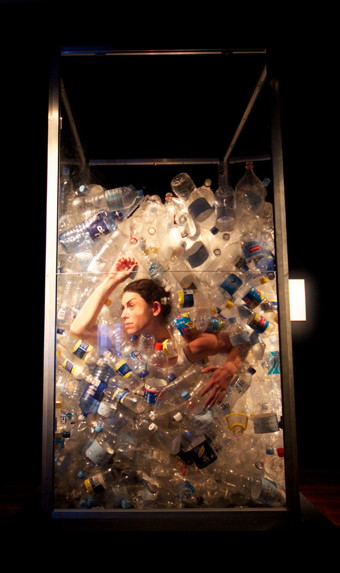
Deborah Robertson, Accidental Monsters of Meaning
photo Jarrad Seng
Deborah Robertson, Accidental Monsters of Meaning
ANTICIPATION PERVADED MOUNTING THE STEPS OF MONUMENTAL OFFICIALDOM: AN EXHIBIT OF CONTEMPORARY DANCE ‘SPECIMENS,’ CATALOGUED AND DELICATELY PINNED WITHIN CUSTOM-MADE GLASS-LIKE SHOWCASES, WAS ABOUT TO BE LAUNCHED AT THE WA MUSEUM, GIVEN EQUALITY WITH THE PRESERVED ‘WONDERS’ OF THE WORLD. THERE WAS SOMETHING DELICIOUS FOR AN HABITUAL PERFORMANCE GROUPIE, NORMALLY LEFT TO NAVIGATE ILL-ANGLED STEPS AND SHAKY SEATING CONSTRUCTIONS, IN THE PERSONALISED ATTENTIONS GIVEN BY THE MUSEUM STAFF WHO GUIDED VISITORS THROUGH INTRICATE PASSAGES TO THE PERFORMANCE VENUE. THE SCENE WAS SET FOR ASCENSION AND, UNPREDICTABLY, FOR ACCIDENTAL SMALL DISAPPOINTMENTS.
Instead of the horrified delight of my first viewing of these ‘accidental monsters’ too close-up, amidst a small pressed crowd in the now condemned visual art space, Spectrum, the specimens of human bondage in their own wasteful behaviours were now tactfully arranged, beautified by spatial expansiveness and subdued lighting. Ironically, giving equivalent treatment to the rest of the exhibits failed to extend the visceral potency of these danced monsters. In line with their inanimate companions, the metaphorical blood and weeping gristle of the danced specimens were cleansed, spruced up for visual clarity.
The impact of Aimee Smith’s conception lies primarily in the spectator’s shocked recognition of the future, indelibly hatched in the human present. Encased in choreographed taxidermy and animated by innovative technology, the creatures strain in various ways within their bleak destinies. A body ‘drowning’ in a receptacle jam-packed with empty water bottles, speaks of the absurdity of our behaviour. The plastic agitation of the soundscape as a hand penetrates entrapment, mixes humour and desperation with equal and colliding effectiveness. In the Spectrum space, the hand scratching the glass carried the horrendous potential of penetrating the audience’s own skin. Here, the absurd concept remained: but its unsettling proximity was alleviated.
Rhiannon Newton’s caged beast, the once robust and insatiable human consumer, lay trapped in lassitude with flickering enticements for Vegemite and pizza projected across her hunching form, driven deep like irascible tattoos. With the venue’s distancing from the beast, spectator voyeurism seemed less likely to be caught in a hall of mirrors’ effect, watching-the-self-watching-the-self ad infinitum. Moreover, while the zoological inferences are not missed, they are ameliorated—tamed, in a strange way. This species at the edge of extinction suggests an intellectual exercise, at a remove from the confrontational recognition that the caged creature is the human present about to become its future.
In an adjacent enclave, Natalie Holmwood’s Sisyphus amassed boxed products, undeterred in rebuilding an ever-collapsing accumulation of excess. She also hoards communication, strings of incomplete messages winding up and down over the purposeless reconstruction: these two broken actions keep a disconnected rhythm.
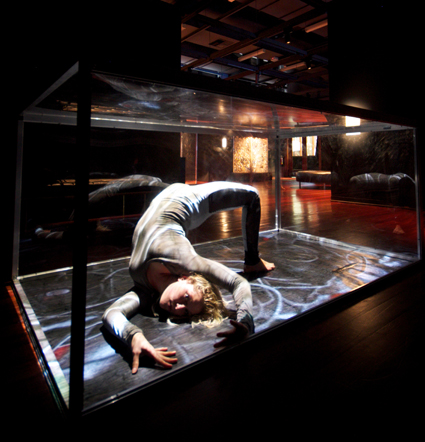
Accidental Monsters of Meaning
photo Jarrad Seng
Accidental Monsters of Meaning
The additions to the original concept tend to be less pungent in accidental monstrousness. Aisling Donovan’s Arctic figure sways wistfully fragile, an illuminated slice of body against film of the eloquent, expansive landscape. Whispers of erosion play on the purity of wilderness, transforming environmental wellbeing into a half-remembered fictive icon. In the space, this exhibit acts like a floating tissue of memory, not dissimilar to the fossil imprint of a feathery vestige found in a display case at the entrance. Whether this imagistic statement relays the dangers of climate change is debatable. Similarly, the spectatorial powerplay integral to the press-button dancer (Bianca Martin) can slip into a one-sided game. I imagine that the school groups to explore the installation in the following week will push this facility to its limits without realising the mirror that it holds on this very behaviour.
These two specimens filled out the space but did they contribute to the self-inflicted extinction highlighted in the Spectrum configuration? There was also a sequential performance element in the original cramped presentation, wherein each exhibit’s greed was pitched onto and against its neighbours’, which contributed to the claustrophobic perspective. Implication, not just as spectators but as participants in present consumption leading to future collapse, was inescapable.
Enabling spectators to roam freely and democratically bears its own advantages, a conspicuous one being access by the general public and notably the school groups mentioned above. Smith’s political commitment to the persuasive attributes of performance is undeniable, as is the commendable gain of prestige and exposure granted by the museum venue. However loss might ensue, particularly if the other monsters in the equation, the spectators, are given hushed spaces in which to hide. The accidental meanings provoked in an unconducive space may, under the banner of protest, ironically be the best place to be.
Accidental Monsters of Meaning, concept, choreography Aimee Smith, performers Deborah Robertson, Rhiannon Newton, Bianca Martin, Aisling Donovan, Natalie Holmwood, Isabella Stone, sound design Ben Taaffe, costume design Esther Gauntlett, Jason Reibel, projections Aimee Smith, Chris Jordan, Western Australian Museum, Perth, March 26-April 3.
RealTime issue #103 June-July 2011 pg. 30
© Maggi Phillips; for permission to reproduce apply to realtime@realtimearts.net
![Nicola Leahey, Jessica Jefferies, [sic], Dancenorth](https://www.realtime.org.au/wp-content/uploads/art/46/4690_ashley_dancenorth_sic.jpg)
Nicola Leahey, Jessica Jefferies, [sic], Dancenorth
photo Bottlebrush Studios
Nicola Leahey, Jessica Jefferies, [sic], Dancenorth
HAVING FUNDRAISED TO ENABLE THE ENTIRE COMPANY OF DANCERS TO ACCOMPANY DANCENORTH ARTISTIC DIRECTOR RAEWYN HILL TO HER BARYSHNIKOV RESIDENCY LAST SEPTEMBER, TOWNSVILLE WAS REWARDED WITH THE PREMIERE SEASON OF HER SHORT WORK BLACK CROWS, DEVELOPED DURING THE FORTNIGHT IN NEW YORK. HILL INVITED ROSS MCCORMACK AND ELIE TASS, IN AUSTRALIA EARLIER THIS YEAR WITH LES BALLETS C DE LA B, TO CREATE A SECOND SHORT WORK FOR DANCENORTH’S SEASON-OPENING DOUBLE BILL. TITLED [SIC], THIS EDGY AND CONFRONTING PIECE OF DANCE THEATRE WAS A PERFECT FOIL FOR THE CONSIDERED GRACE AND POWER OF BLACK CROWS AND A TESTAMENT TO THE VERSATILITY OF THE DANCENORTH DANCERS.
[sic] opens with a dormant pyramid of tangled bodies heaped against a wall as if thrown there. Apart from Nicola Leahey on top, standing semi-slumped against the wall with her back to us, it is difficult at first to see how many individuals are in the heap. To Jody Lloyd’s intoning, whispering soundtrack, Leahey eventually begins to jerk and slither down the now erratically twitching pile, while Lauren Carr slowly emerges like a breech birth from underneath. The two start inching across the floor in unison, on all fours, faces up. Their movements, initially insect like, progress to larger gestures and rolls, culminating in a twining, spastic embrace completely lacking in eye contact or any evidence of emotional connection.
Meanwhile the pile has been delineated and Thomas Gundry Greenfield, Jessica Jefferies and Jeremy Poi stand and stare down the audience, grinning malevolently. They intermittently reconfigure their cluster, moving without averting their challenging focus. This hostile inversion of the usual audience/performer gaze is discomforting. People cough, shift and half laugh.
All five dancers wear mismatched underwear—paradoxically exposed and vulnerable, yet bold as brass. The minimal costumes allow us to see every muscle isolation, each gesture and extension. When all of the dancers balance on their buttocks on the floor while holding an excruciating, uniformly angled Pilates V for what seems an eternity, the audience sweats in sympathy. The dancers hold and hold until quivering and in a pause in the music, their breathing provides the rhythm.
This almost perfect unison is a feature of [sic], right down to minute repetitions of flicked-back hair, lip biting and breath exhalation during a sequence of erotically charged flirtation with the audience. Set to a musical passage of classical strings, it appears to subvert the famous Swan Lake ensemble piece, with a pout and a lewd hip leading as the dancers rhythmically shift weight from foot to foot. Only Leahey falls out of time, blank-eyed and panicky, clutching at her throat. As Greenfield, Carr and Poi blithely continue the chorus line, Jefferies is on the floor. Leahey squats over her and, blank-eyed with an eerie absentmindedness, kneads the unresponsive Jefferies’ face while the audience squirms.
[sic] scrapes back the veneer of civilisation and utterly fulfils its intention as a series of moments of indulgence in primal, uncensored tics and urges. A sublime and grotesque experience, the entire audience is discussing it the moment it’s over and the descriptor ‘disturbing’ ricochets around during intermission.
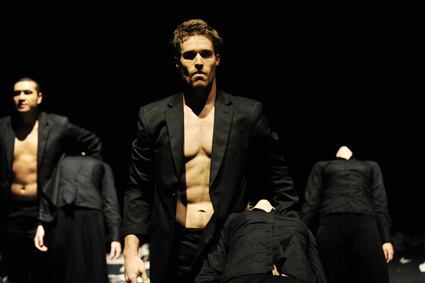
Thomas Gundry Greenfield, Black Crows, Dancenorth
photo Bottlebrush Studios
Thomas Gundry Greenfield, Black Crows, Dancenorth
Black Crows takes us on a very different journey of heightened emotions, of people pushed to the limit by extraordinary circumstances (war) but held in check by a sense of duty, discipline and the common good.
The costumes are Amish in their austerity—shirtless black suits for Greenfield and Poi, long widows’ weeds and hair pulled back for Carr, Jefferies and Leahy. The floor is precisely blanketed with old newspapers and, from the first pass of the dancers across the stage, its orderliness irrevocably disintegrates. The simple metaphor works brilliantly, with dignity and restrained passion in the dancing, chaos and unpredictability underfoot. In one later scene the dancers briefly lapse into a panic, scrabbling on the floor trying to pick up as much newspaper as possible and clasping it to their chests. Their desire to know is poignant in its futility.
Spaniard Micka Luna’s pumping score is contemporary but suggests WWII with sounds evocative of aeroplane engines roaring, air raid sirens and radio static. Inhabited with heartbeats and night terrors, it winds down to a slow dance to support the tenderness and heartbreak of the final scenes of reluctant, duty-bound men leaving behind stricken women.
With some of the ensemble pieces obviously devised for three couples, the absence of one male dancer through injury compromises the symmetry occasionally, but more often works in favour of the current of loss.
Black Crows, a beautifully realised and satisfying entity in itself, is also a precursor for an upcoming full-length work, Mass, on similar themes, opening at the end of June. Raewyn Hill’s choreography and Luna’s score will be expanded, with Jocelyn West (UK) on vocals and Mariona Omedes (Spain) creating digital imagery for the performance.
Dancenorth Double Bill: [sic], choreography, concept, direction Ross McCormack, Elie Tass, music Jody Lloyd, lighting Van Locker; Black Crows, choreography, design concept Raewyn Hill, music Micka Luna, lighting design Van Locker, dancers Lauren Carr, Thomas Gundry Greenfield, Jessica Jefferies, Nicola Leahey, Jeremy Poi; Dancenorth, Townsville, March 18–May 13
RealTime issue #103 June-July 2011 pg. 30
© Bernadette Ashley; for permission to reproduce apply to realtime@realtimearts.net
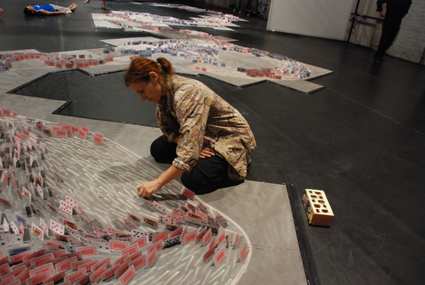
Vicki van Hout working on the installation/set of Briwyant
photo Marian Abboud
Vicki van Hout working on the installation/set of Briwyant
IT IS TWO DAYS AFTER THE OPENING NIGHT OF VICKI VAN HOUT’S NEW DANCE WORK BRIWYANT (FOR ‘BRILLIANT’). WE ARE IN BAY 20 AT CARRIAGEWORKS, THE SPACE WHERE THE PIECE IS PRESENTED. IF VAN HOUT FEELS AT ALL PLEASED WITH THE POSITIVE FEEDBACK HER LATEST WORK HAS RECEIVED FROM AUDIENCES, PEERS AND CRITICS ALIKE (P32), SHE CERTAINLY DOESN’T LET ON. “THE WORK ISN’T DONE YET,” SHE SAYS MATTER-OF-FACTLY.
And it’s easy to see what she means: The cavernous theatre space is split into two by an enormous river-like installation made up of several thousand playing cards. After every performance, each card needs to be reglued to the ground edgewise—a complicated procedure that takes up to seven hours. An activity expected from an installation artist maybe, but from a choreographer?
“You gotta give it a go,” Van Hout quips. “I’m a perennial student. I’m interested in other artforms. At first I thought this piece should be in an art gallery. Sometimes I feel dance is not enough anymore. I like integrating other forms of art into my work. In some ways it’s an excuse to find out about things I don’t know much about.” After a pause, she shrugs: “Who knows? Maybe at some stage there will be no dance at all anymore. My interest in the arts didn’t start with dance so maybe it won’t end there.” And as for those cards? “I’m lucky,” laughs Van Hout. “My 60-plus year old mum has taken time off work to help me and the stage manager.”
A Wiradjuri descendant growing up in Dapto in regional New South Wales, Van Hout didn’t start to train in dance until her late teens. All through high school she had taken drama lessons, wanting to become an actor. She recalls, “Around the time I was living in a squat, The Gunnery at Wooloomooloo, and this guy suggested I should go to NAISDA instead. I remember asking him: ‘What’s that?’ He said, ‘A place where you learn about your own people.’ I liked that.”
After four years at NAISDA, the National Aboriginal Islander Dance College, Van Hout received an overseas study award from ATSIC (Aboriginal and Torres Strait Islander Commission) to train at the Martha Graham School of Contemporary Dance in New York. Far away from the usual preconceptions and prejudices regarding her aboriginality, Van Hout relished the opportunity to immerse herself in a culture not her own. “As I’m quite fair-skinned, not a lot of people recognized I was indigenous and hardly anyone asked any questions. I hung out with a lot of musicians from the alternative music scene and punk culture. Our haunt was Manic Panic, the now legendary punk store. Their tagline was ‘Live Fast and Dye Your Hair’.” And yet, Van Hout took her dance training very seriously. After graduating from the Graham School, she stayed in New York to train and work with various modern and postmodern dance artists. “My concern was that I wouldn’t have anything to show for my time there,” Van Hout says. “I didn’t want to come back without skills.”
All up Van Hout spent almost seven years in New York, eventually returning to Australia in 1996 to perform with Bangarra Dance Theatre on an Asian tour of their seminal dance work Ochres. She later joined Marilyn Miller’s Fresh Dancers collective created to focus on the corporate and commercial market. After initially working mainly as a dancer, she soon helped to choreograph many of the works presented at indigenous events and functions. She then gradually moved into creating her own work. “It was actually [fellow indigenous choreographer] Jason Pitt who encouraged me to take that leap,” remembers Van Hout. “One day he looked at me and said, ‘What have you got to lose? Just go for it, sister.”
And go for it, she did. Working incessantly over the following years, Van Hout has steadily built a reputation as one of our most interesting and prolific independent dance artists. She has developed a growing following for her deftly imagined and thoughtfully crafted works examining urban indigenous realities, especially in NSW.
Briwyant is Van Hout’s third full-length work. Conceived as a cross-cultural, inter-disciplinary dance piece, it examines the ongoing nature of ‘traditional’ Aboriginal practices based on story telling through the act of painting. As in many of her works, van Hout aims to explore the commonality between traditional and urban cultural experiences and how indigenous cultural information is disseminated: “I’m interested in what was, what is and what is similar. I’m always trying to find what is contemporary and relevant.” The work started out as an idea for a solo and evolved into its current form featuring six performers including herself.
“My initial interest,” explains Van Hout, “was in the question: what is it to look white and identify as indigenous? I wanted to peel back layers and find out what’s underneath.” She is outspoken on the issue of claiming her indigenous heritage: “It’s a birthright but not only a birthright. It’s living an obligation defined by what you do. You are what you do.” It is not surprising then that Van Hout is a passionate teacher who has been working at NAISDA for over 10 years. She feels a strong responsibility, she says, to pass on the cultural information and knowledge she has acquired. “I have been taught [Aboriginal traditional] dances, it is my responsibility to pass them on. They are not the sum of me though. I’m also teaching the contemporary indigenous technique that I have been developing through my own work. I want to instil body discipline in students so that they can be adventurous and try something different.”
As important as the engagement with her Aboriginal heritage is to her, at the same time Van Hout is adamant that she doesn’t want to be “put in a box.” She wants to be taken seriously as a choreographer on the basis of her skills, not merely for the fact she is indigenous. Recently interviewed for a case study of artists affiliated with Performance Space, she said: “It’s important to me to participate in the broader dance and performance arena. I want to be critiqued on a par with everyone else .”
This might explain Van Hout’s extensive engagement with dance outside exclusively indigenous contexts. In the last few years she has created numerous works for both tertiary institutions and youth dance companies such as ATYP, youMove, fLING Physical Theatre and DirtyFeet, as well as WAAPA, to name but a few. She also frequently employs non-indigenous dancers for her works. The cast of Briwyant, for example, is decidedly mixed. “We’re an eclectic bunch, no one is the same,” laughs Van Hout. And there is no question that she likes it that way. It confirms her fascination with juxtaposition, a device she frequently employs in her works.
“I like things that sit side by side and can’t be rationalised. I want to give people a glimpse, not lay it out for them.” The seminal experience that triggered her thinking in this respect occurred many years ago: “I was in Maningrida [indigenous community, Northern Territory], it was about 22 years ago, and I observed a young woman washing her child’s hair on a piece of corrugated iron while watching Dallas on a portable TV on the veranda of the nearby house. It was the most bizarre vision. But it had such poignancy and absurdist poetry. That’s what I strive for in my work.”
See review of Vicki van Hout’s Briwyant
RealTime issue #103 June-July 2011 pg. 31
© Martin del Amo; for permission to reproduce apply to realtime@realtimearts.net
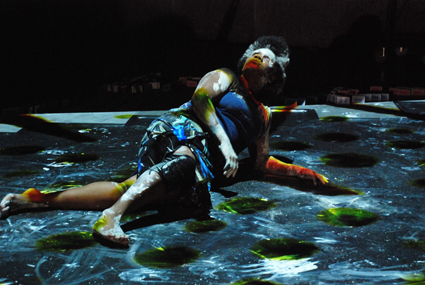
Ghenoa Gela, Briwyant
photo Marian Abboud
Ghenoa Gela, Briwyant
VICKI VAN HOUT’S CHOREOGRAPHY IS SOME OF THE MOST IDIOSYNCRATIC AND INVENTIVE SEEN IN AUSTRALIAN DANCE FOR A LONG TIME AND HER TEAM OF DEXTROUS DANCERS EXECUTE IT WITH HIGH PRECISION, UNBELIEVABLE ENERGY, HUMOUR AND ATTITUDE. VAN HOUT HAS BEEN A BUSY DANCER, CHOREOGRAPHER AND RESEARCHER TRAVELLING EXTENSIVELY TO INVESTIGATE INDIGENOUS DANCE. SHE HAS A COUPLE OF SUBSTANTIAL WORKS BEHIND HER, HOWEVER IT’S A NEW CREATION, BRIWYANT (FOR ‘BRILLIANT’), THAT COULD BRING HER THE ATTENTION SHE WARRANTS THANKS IN PART TO A SHORT BUT SIGNIFICANT PERFORMANCE SPACE SEASON.
In 2009 I was impressed by Pack (RT94), a sizeable piece in a Dirty Feet program of short works. I wrote: “In an intense work, four dancers, moving with bird-like alertness and the deep stepping of certain Aboriginal dance forms, map out their space territorially (with tape) and on each other’s bodies (with clothes pegs). Moments of intense, swiftly danced collectivity contrast with power plays and grooming displays—pegs removed gently from pinched flesh. This fascinating work, in which the tipping point seems to be whenever ‘enough is enough’ and the dividing tape is ripped up, fuses contemporary dance with Indigenous inflections to suggest that when it comes to territory we humans are pretty much just another animal.”
In Briwyant, Van Hout pays similar if much richer and more elaborate attention to the integration of dance with design. Scarves, for example, are transformatively shaped to suggest digging, cradling and the binding of one person to another. Hundreds of playing cards are arranged across the performing space evoking a riverscape. These are deployed, quite laterally, like the dots of the Indigenous paintings that fascinate the choreographer with their shimmering brilliance. On the Performance Space website, Van Hout writes, “Cards/ As the repetition of a dot/ Layed down as a river/ As a deck to share the wealth/ Made from?Dots on a canvas/ When sung/?Signify ancient power/ To transport us to the dreaming/?The everywhen.” She explains, “Briwyant is inspired by bir’yun: brilliance, shimmer and shine. In Yolngu traditional painting, bir’yun is the effect of intricate crosshatched patterns creating a sensation of shimmering movement over the painting’s surface, a manifestation of ancestral forces.” Briwyant conveys an engrossingly similar phenomenon when a dark upstage rectangle disappears the dancers but then bathes them in sparkling light.
The choreographer’s sources are many, drawing on and effectively melding diverse Indigenous and other forms within a dance theatre framework that ranges from droll rhyming verse (delivered by the charismatic Van Hout herself) to a lucid dreamtime tale transformed into dance, to witty social encounters and sometimes mysterious but never less than intriguing images pertaining to Indigenous art and culture.
Soundtrack, media and lighting are occasionally burdened with superfluities, but the best of Marian Abboud and Imogen Cranna’s digital media effects, Elias Constantopedos’ score and Guy Harding’s lighting fuse seamlessly with Van Hout’s organic exploration of the relationship between bodies and the lines, dots and the hatched ‘shimmer’ of Indigenous art. Danced organically across Van Hout’s playing card landscape design, this makes for a powerful experience, at once magically elusive and cohesive. Dancers Henrietta Baird, Ian RT Colless, Ghenoa Gela, Raghav Handa and Melinda Tyquin are superb.
See also an interview with Vicki Van Hout.
–
Briwyant, Performance Space, choreographer, designer, performer Vicki Van Hout, dancers Henrietta Baird, Ian RT Colless, Ghenoa Gela, Raghav Handa, Melinda Tyquin, digital media effects Marian Abboud, Imogen Cranna, composer Elias Constantopedos, dramaturg Kay Armstrong, lighting Guy Harding; Performance Space, CarriageWorks, Sydney, april 13-16
RealTime issue #103 June-July 2011 pg. 32
© Keith Gallasch; for permission to reproduce apply to realtime@realtimearts.net
MARTIN DEL AMO IS BEST KNOWN FOR HIS INTRIGUING SOLO WORKS AND FOR SOME OBSERVERS IT MIGHT SEEM THAT HIS MOVEMENT LANGUAGE IS SO INTERLINKED WITH HIS PHYSIOGNOMY THAT IT CANNOT BE PERFORMED BY OTHERS. HOWEVER FOR SEVERAL YEARS NOW DEL AMO HAS UNDERTAKEN A VARIETY OF RESEARCH PROJECTS INVOLVING HIM AS A NON-PERFORMING CHOREOGRAPHER. A RECENT PROJECT AT SYDNEY’S CRITICAL PATH SAW PAUL WHITE PERFORMING AN UNCANNILY ACCURATE YET TRANSFORMED VERSION OF ‘DEL AMO’ MOVEMENT.
Discussing his reasons for the transition from solo performer to director-choreographer, del Amo cites Kate Champion from Force Majeure who was also, at one stage, best known for her solo works. “Kate said you can only mine yourself for material for so long and at some point you get more interested in other people’s backgrounds, stories and ideas. I think this is exactly what happened to me. I’ve always really enjoyed working by myself and having that freedom but sometimes I thought it would be nice to work with other bodies and have another input on that level.”
Del Amo undertook some early research in 2008 with WAAPA’s post-graduate dance company, LINK. The work, Mountains Never Meet, an exploration of the difference between walking and dancing, was made with an all female cast. “I was working with very reduced movement material, but treating it in a complex way choreographically and that was quite difficult for the dancers…it [required] completely adapting or un-learning what they had studied over the years.”
While he found this process valuable del Amo says, “I felt there was something else in that work—the way it could communicate with audiences— that could be captured in a different way.” So for the version that is to take place in August as part of the Western Sydney Dance Action and Parramatta Riverside Dance Bites program, del Amo has chosen to redevelop the work with nine male non-dancers. Having finalised his cast with co-operation from Bankstown Youth Development Service (BYDS) he says, “I’m really happy with the guys that we’ve got now. It’s an eclectic bunch from different cultural backgrounds, different ages [ranging from 15 to mid-20s] and they also have slightly different sporting or physical backgrounds.”
For Mountains Never Meet del Amo has also invited former professional soccer player turned performer Ahil Ratnamohan—most recently seen in his own work, The Football Diaries (RT91, p42) and in Branch Nebula’s SWEAT (RT102, p15)—to take on the role of artistic associate. The working relationship between the two is an ever-evolving one. While del Amo has worked as a mentor on some of the younger artist’s projects, Ratnamohan has taken on the role of trainer and consultant on del Amo’s works such as It’s A Jungle Out There (2009-2010). “I wanted a more urban, non-dance feel and asked him to do soccer training with me to improve my footwork. Out of that—being his mentor and him being mine—we established some kind of training practice.” As well as performing in this project, Ratnamohan will have the roles of collaborator and liaison with the other performers. Del Amo says, “the choreography and direction is with me, but we’re actually sharing how that is being implemented.”
Ratnamohan will also perform in Duel, a duet with Connor Van Vuuren that Martin del Amo is choreographing to accompany Mountains Never Meet. “Duel involves much more intricate movement and is inspired by some memorable sporting battles, but not tied to one particular sport.” Again, the performers have different training backgrounds, Ratnamohan in soccer and van Vuuren in martial arts and gymnastics, so the choreographic relationship is ambiguous—“Is this a battle against each other, with each other or for each other? It’s also an investigation into what constitutes a duet. In some ways it’s set up as two intertwined solos rather than as a proper partnering duet.”
Del Amo is also known for his strong collaborative relationship with composers and in this instance he will continue his collaboration with Cat Hope who scored the original LINK version in Perth. Del Amo says, “The sound world Cat has created relates to the physical concept of the work without mirroring or imitating it. It features whistling, urban sounds such as AM radio and a big percussion section consisting of marching band sounds without the band music. Cat will digitally manipulate pre-recorded elements live which ensures some ‘breathing room’ for the interplay between movement and sound. “
Both Mountains Never Meet and Duel look to be exciting additions to Martin del Amo’s impressive and highly idiosyncratic body of work.
Western Sydney Dance Action & Riverside Theatres 2011 Dance Bites, Mountains Never Meet, choreographer Martin del Amo, artistic associate Ahil Ratnamohan, performers Ahil Ratnamohan, Connor Van Vuuren, Fraink Maino, Benny Ngo, Mahesh Sharma, Sean Stanley, Nikki-Tala Tuiala Talaoloa, Dani Zarodosh; composer Cat Hope; Parramatta Riverside Theatre, Aug 17-20
RealTime issue #103 June-July 2011 pg. 32
© Gail Priest; for permission to reproduce apply to realtime@realtimearts.net
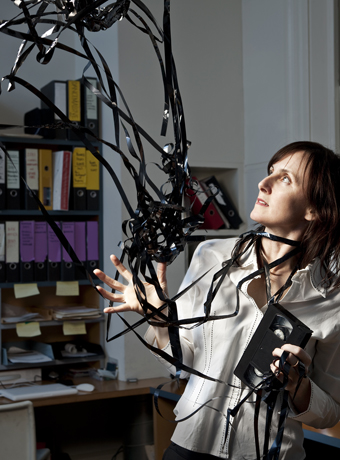
Sandra Parker, Document
photo Rachel Roberts
Sandra Parker, Document
MELBOURNE CHOREOGRAPHER SANDRA PARKER’S LATEST WORK DOCUMENT, “AN IN-DEPTH EXPLORATION OF THE WAY IN WHICH A ROOM RETAINS THE RESIDUE OF HUMAN OCCUPATION,” WILL PREMIERE IN JULY. THE WORK IS EMERGING FROM A 14-WEEK RESIDENCY AT DANCEHOUSE. PARKER WAS ARTISTIC DIRECTOR OF DANCE WORKS 1998-2006 MAKING DISTINCTIVE CROSS-ARTFORM CREATIONS. HER WORK HAS BEEN SHOWN INTERNATIONALLY, INCLUDING NEW YORK IN 2007 WITH THE VIEW FROM HERE, AND IN CHINA WITH PLAYHOUSE FOR THE GUANDONG MODERN DANCE COMPANY.
Will you physically create a room or use video and movement to do so?
I’m interested in trying to evoke a room, a rehearsal or performance space in image and light; and also through using language to describe the qualities of the space. I’m keen to play with the juxtaposition of the actual performance space with details about the space conjured up by using other media. This may or may not confirm what is actually there in the ‘real’ space, or might have been there at another point in time.
Who are the artists you’re working with and how will each contribute to your exploration?
Rhian Hinkley (projection designer; see p29), Jenny Hector and Rose Connors Dance (lighting designers), Steven Heather (composer) and Rebecca Jensen (dancer) will bring responses to the ideas and offer material. Our collaborative approach is to see where the correspondences, counterpoints and parallels lie between forms then try to find combinations that open up and suggest ways of experiencing the ideas at play within the performance. For example, I might make movement that I think feels one way but, when watched with certain sounds, radically alters the perception of the movement. I look for ways to use collaborative material as active in the performance and not just ‘accompaniment’ to the main action. I’ve also asked performers I have worked with before to contribute to the process of making the work.
Precisely how do you generate the material—do you have a particular methodology?
I began the project by asking dancers Deanne Butterworth, Carlee Mellow and Joanna Lloyd— with whom I have worked previously, but who won’t be directly involved as performers in this project—to come into the studio with me and respond to a series of questions through a ‘performed interview’ about work we have created together. In one case, this spanned back some 15 years. I am interested in not only what they remember of the movement and why, but also other things that are remembered about making work. Responses have ranged from things like describing the atmosphere of the space, how they felt about what they did, how they approached performance and personal things that were going on in their lives at the time.
I’ve also been interested in trying to describe movement. The gap between what we think movement is, what we say about it, how it appears and if it can ever be ‘perfectly’ documented in language, video or sound; and also the sometimes vastly different perception of process, choreography and performance that can exist between the choreographer, external to the work and the dancer internal to it.
I’m working with Rebecca Jensen for the first time. We met at VCA and again when I led the Learning Curve residency for recent graduates at Dancehouse in 2010. Earlier this year Rebecca also came and worked on secondment during a creative development for my new project, The Recording. She represents a new generation of young Melbourne-based dancers. I was interested to work with someone with whom I have little history, as opposed to the long-term relationships I have with Deanne, Carlee and Jo. I am interested to see how Rebecca works with material that is passed on to her through these dancers and how it changes. What detail is maintained, or left behind.
Elsewhere you’ve used ‘documents’ to describe what comes out of your process?
By documents, I mean creative material. I usually work by generating a lot of material and collect movement phrases, sound, text, video material, then start layering things. I look for tension between elements: a summation of parts. The collected material will range from drafts of choreographic material to ‘formed’ phrases that we have decided are finished. I want to try to use everything—even if it isn’t necessarily ‘finished’ material.
You’ve expressed “an interest in capturing the physical traces and after-effects of movement once it has passed,” saying, “ Document will chronicle the evidence of events that are seemingly over and complete, yet somehow remain.” Given the preoccupation with “the now” in the work of a number of contemporary practitioners it’s fascinating to see you addressing traces. How did you come to this preoccupation?
I think this interest harks back to some really early works, in absentia (1997) for example, a work with 16mm film that I made with Margie Medlin. The ephemeral nature of dance is so fundamental to working in the form that it poses a central problem that I have always found challenging and opens up many questions about how to approach dance making. I’m interested in the problem of trying to capture movement—actually ‘choreograph’ it, to set it down, if in fact that is ever really possible. The problem of trying to set movement and then return to it and re-perform it, could be seen as a futile exercise in trying to reclaim that which can never be recaptured; but for me it also offers a way to question assumptions about what you think is ‘there’ and to make it anew, to reinvent, to ask what else movement can do.
The fact that movement is ephemeral lets you give it up and move in new directions. So if traces exist in the work they are there as tools to show this difference—not simply as nostalgic recollections, but to say, this is what it might have been, but now this is what it could be.
You’ve written, “the process of creating Document will seek to investigate how choreography can be understood as a record of bodily memory and sensation.” What do you think the ramifications of this are for choreography?
A few years back I watched a documentary on the Ballet Russes that contained footage of company dancers re-enacting choreography. I was struck by how their bodies held very clear sensations of movement, even though they weren’t leaping through the air. I was intrigued by how this represented a dance experience because much of what we normally expect from dance was completely taken away, yet it felt so ‘full.’ I became interested in the ramifications of this for choreography, to move beyond representation or conceptualising movement to the co-presence of phenomena interior to the body as it moves. I’m interested in exploring the possibility of creating a poetic choreographic rendering that envelops and embeds a density of experiential phenomena under the surface of choreography, what French dance writer Laurence Louppe suggests is “the tracing of what the letter does not say, but where another text shows through, another reading of living substance.”
I think this is especially relevant given the current preoccupation in dance with needing to produce ‘product’ that has a sense of solidity about it. Or that appeals directly to particular tastes or markets or can be identifiable in certain terms. I am interested in trying to open up and question what is there before us on stage.
You’ll find reviews of Sandra Parker’s works in our extensive 1994-present
archive, RealTimeDance
Sandra Parker, Document, from Housemate VII Residency, Dancehouse, July 27-31; www.dancehouse.com.au
RealTime issue #103 June-July 2011 pg. 33
© Keith Gallasch; for permission to reproduce apply to realtime@realtimearts.net
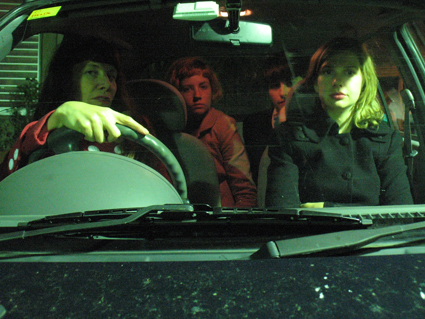
Spotlight Bunny, Julie Vulcan, Ashley Scott & Friends with Deficits
courtesy the artists
Spotlight Bunny, Julie Vulcan, Ashley Scott & Friends with Deficits
ONE OF THE MOST IMPORTANT DEVELOPMENTS FOR PERFORMANCE IN RECENT YEARS HAS BEEN THE EMERGENCE OF YOUNG INDEPENDENT PRODUCERS, FESTIVAL DIRECTORS AND CURATORS. MANY ARE WOMEN, OFTEN WORKING IN TEAMS AND PRODUCING EVENTS THAT PRESENT BUT ALSO NURTURE NEW WORK—DRAMATURGICALLY BUT ALSO IN TERMS OF MANAGEMENT, RISK AND TECHNICAL AWARENESS. IMOGEN SEMMLER IS ONE SUCH PRODUCER CREATING UNDERBELLY IN 2007, A FESTIVAL WHICH SUPPORTS INDIVIDUAL ARTISTS AND GROUPS, EMERGING AND ESTABLISHED, WORKING IN A VARIETY OF PRACTICES. THIS YEAR THE THREE-WEEK WORKSHOP AND PERFORMANCE DAY WILL BE STAGED ON SYDNEY’S COCKATOO ISLAND.
Underbelly in 2011 predictably includes a diverse range of projects. Here’s a few examples. The Sexy Tales Comedy Collective will develop a theatre and music work titled 100 Years Of Lizards. Neil Brandhorst’s Horizon will be an installation that “disrupts the sensory information required to make sense of the environment…revealing how previous experiences provide meaning in new situations, and result in the feelings and urges that become our behaviour.” Spotlight Bunny, a work conceived by Sydney performance maker Julie Vulcan working closely with sound maker Ashley Scott and emerging performance collective Friends with Deficits to “explore location, the influence of soundtrack and the slippery nature of context. Influenced by drive-in culture, it blends the past with today’s iPod culture in an intimate performance for four audience members at a time in a stationary car.”
In Inflate My Heart With 1000 Gushes Of Wind, Swanbrero will “insert a piece of Parramatta Road into the natural wonderland of Cockatoo Island. The work will experiment with large-scale interpretive choreography, costume and wind to create melancholic spectacle.” The group (Corey Crushcore Dreamlover and Lara Thoms) describe themselves as “faded, cheap, fraying and bending over so far that their heads are scraping the ground.”
Tell me about starting up Underbelly and why you did it?
I come from an events background, working on different festivals and putting on little events myself—sort of underground. I liked the idea of bringing a lot of artists together in a festival but also starting with the development of their projects. Having artists together you’d see them make great connections, but it was fleeting and then they were off. So I thought it would be good to bring development and presentation together under the one roof.
Secondly, I felt there was a lot of stuff happening in Sydney at the time that was perhaps a bit hard to access, say about five years ago. There were great underground spaces but you had to be in the know. This was pre-emailing list, pre-Facebook, so it was more text messages or word of mouth. I started talking to groups who I’d been working with or knew of and put together a group of local artists with projects.
The first year was very much curated. I came up with the concept and just did it with people I was interested in and staged it at CarriageWorks. The second year we did it there again but it was open to applications—a lot of people said, how can we get involved? So that process has continued, which has been great.
You’re still curating or is it more like a fringe festival model?
We have a curating committee—applications come in and we choose projects. We have certain loose criteria—to support emerging artists and artists experimenting with new forms or more established artists pushing themselves in new directions or wanting to do more research-based work.
Would you or your committee have seen much of the work?
Not necessarily. We focus on new work. Artists have to have a pretty good argument as to why their work should be included because the whole idea of the residency is to present something for the first time. Sometimes it’s a work in progress. Some projects develop just a few scenes or the beginning of an idea.
And audiences watch the development?
Yes. We’ve had shows that have gone on to become fully formed and feature at fringe festivals or Next Wave. It’s good to get projects at an early stage—they need the lab time.
So you’re providing a service for people to innovate. Do you charge artists for that?
No. This year we’ve developed a project fund. It’s not a huge amount of money but we want to resource projects. We don’t want artists to be out of pocket. If they come with an existing grant or other support, that’s great but we do try as best we can to facilitate their project; that includes technical support, publicity, marketing, the venue…And we provide a lot of mentoring. For a lot of the artists, this might be the first time they’ve been involved in a festival. We help them with producing, budgeting, maybe the technical side of producing and we ask them all to do risk assessments. They might not have done that before so we’re happy to hold their hands and take them through the process. But we’re not doing it for them—we make sure they learn. There’s a lot of contact. We have a producer who works directly with the artists. I did this in the first few years but now we’re expanding.
How many of you are there?
At the moment there’s Clare Holland, our executive director, and myself. In two weeks we’ll have our event producer Jenn Blake and then we’ll have a production manager, a technical co-ordinator and a marketing co-ordinator, a publicist and an artist co-ordinator, like a program co-ordinator who manages all the artists. So it’s a big team!
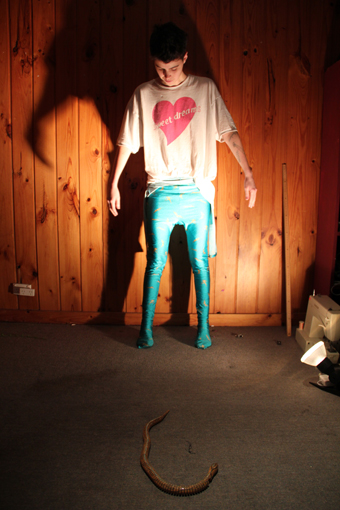
Corey Crushcore Dreamlover, Inflate My Heart With 1000 Gushes Of Wind, Swanbrero
courtesy the artists
Corey Crushcore Dreamlover, Inflate My Heart With 1000 Gushes Of Wind, Swanbrero
Does the income from box office keep the event afloat?
Box office is a very small part of our income, mainly because the lab is running for three weeks prior to the festival which is a one-day event—and we try to make the tickets quite cheap, around $15 to $20. It’s a bit like a music festival where you choose shows and wander round installations. You get to see the whole gamut of what’s on offer. We started out with very little money, but CarriageWorks was a great venue partner—they gave us a lot of in-kind support.
We set up as a not-for-profit organisation and grew gradually. We started getting support from the City of Sydney, set up more formally in 2009, and had a year off because I realised it wasn’t going to be sustainable if we just kept doing it on a shoestring.
We get Arts NSW funding and we’ve recently received first time Australia Council funding for this event through the ARI [Artist Run Initiative] fund. We’ve also found really interesting partnerships with foundations whose interests are aligned with ours, and we have an amazing board.
How do audiences engage with Underbelly?
During the lab, we run tours. We invite the audience to come and watch the projects in development. One of us will take you round and you’ll meet the artists. And what’s happening more and more, because of the audience component at the lab, is that artists are applying with projects that need the audience for development—maybe content generation or particular feedback or testing things or interactivity or even making or building things. So that allows the lab experience to be really fun for the audience and it’s also giving artists unique access to the public through a residency. So it’s not just a work in progress showing. It might be the I Can Draw You a Picture team—they made a printed publication last year with the audience generating the content during the lab.
We call this the Public Lab. People can come pretty much every day for 10 days of the three weeks. You can come out to the island and do a tour. Projects that really require audience participation might want two hours a day. So we’ll pop that in the lab calendar that from, say 1-3pm, head out to the island and you can take part in this project. There’ll be social experiments where the audience become active participants. A quarter of our projects would have that component but it’s often those that then go on to other festivals. There’s a real live art push and I think that term is constantly evolving where once it was performance art or contemporary performance. In this area huge boundaries are being blurred between audience and artists and participants.
What characterises the works that appear in Underbelly?
We have a lot of installation, works by visual artists and filmmakers. We’ve had a couple of dance films over the years—the dance pieces are created on site, filmed, edited and shown. A filmmaker last year made a 3D video where you looked through a little box. He did it with really cheap technology because he’d been working in really high-end production for big companies but he wanted to show people how you could do it really cheaply and easily using a few mirrors and an old monitor. We also have a lot of dance and theatre. We’ve had the classics—Pig Island and Eddie Sharp. Whale Chorus are back this year with a project. There a lot of emerging and experimental theatre people, a lot of hybrid stuff, a lot of blending and theatre work like Eddie Sharp’s Some Film Museums I Have Known (shown at the Old Fitzroy recently).
The word that was associated with Underbelly for a while was “underground.” Is that still a viable term?
I think it’s really moved on, particularly in Sydney. The “underground” as it was five years ago has really blossomed through different changes such as to the licensing laws, the support of FBi Radio, the inner west venues—different elements that have brought that culture out into the open. For years you heard that there wasn’t much going on in the arts unless you were in the know. Now people are saying, “oh wow there’s heaps of stuff happening.” You see it in events like Tiny Stadiums, Imperial Panda, new venues, Performance Space’s LiveWorks and their Clubhouse. A lot of it is because groups have come out of what was the underground five or 10 years ago.
Is Underbelly becoming more of a full-time job?
It’s becoming more full-time, which is great. Bringing Clare Holland our executive director in has been a huge part of that—the ability to work year-round and find the funding to do it. It’s not full-time but it’s definitely part-time most of the year. I do other independent producing work. I did the Statues Project for City of Sydney’s Art and About last year and I produce some theatre for other people. I do research for documentaries in my other life. It’s about juggling. I think making Underbelly sustainable has been a really big focus. .
You usually get a good turnout on the big day. How many are you anticipating this year?
We’ll expect maybe 1200-1500 if it’s a nice day. If it’s raining, it’s about who wants to get on the ferry. The thing is, people like going out to Cockatoo Island. Even though it’s winter. I think the Biennale has shown that everyone’s still pretty happy to go out there and its all under cover. You don’t have to worry about getting wet—you just don’t take your jacket off.
Underbelly Arts, Underbelly: Public Lab, July 3-12; Festival, Cockatoo Island, Sydney, July 16 , http://underbellyarts.com.au
RealTime issue #103 June-July 2011 pg. 34
© Keith Gallasch; for permission to reproduce apply to realtime@realtimearts.net
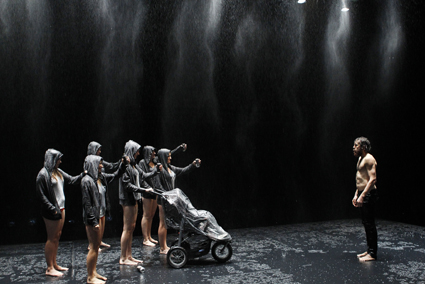
Baal, Malthouse & STC
photo Jeff Busby
Baal, Malthouse & STC
SIMON STONE CREATES HAUNTED THEATRE. NOT HAUNTING THEATRE (THOUGH IT CAN BE THAT). AND NOT THEATRE THAT HAS MUCH TRUCK WITH THE SUPERNATURAL, THOUGH I WOULDN’T GO SO FAR AS TO SAY THAT HIS IS A WHOLLY SECULAR OR MATERIALIST AESTHETIC, EITHER. BUT LIKE MANY OF HIS CONTEMPORARIES, HIS THEATRE IS SHADOWED BY RESTLESS SPIRITS AND THIS IS NOWHERE MORE EVIDENT THAN IN THE DIVIDED RESPONSES TO HIS RECENT PRODUCTION OF BERTOLT BRECHT’S FIRST FULL-LENGTH PLAY, BAAL.
The reactions to this production have canvassed the spectrum from rave to rubbish; on Alison Croggon’s Theatre Notes blog, the play produced one of the longest series of comments to date, with much passion displayed by respondents. It often came down to its writer: was there enough Brecht in here, or too much? And which Brecht? If this is the least ‘Brechtian’ of his writings, what can we do with it? Can we tackle Brecht from a post-Brechtian position, or is he inextricably embedded in the firmament of Western theatre?
It was Derrida who coined the term ‘hauntology’ and, while only a minor part of his critical theory, it’s a concept that has been picked up and developed in other areas, most notably musicology. For Derrida it was a notion used to explain the lingering presence of Marx in the post-Marxist era—an age which has seen the death of the Communist project, but which is still haunted by its echoes. The spectre of Marx is neither living nor dead; or, we may be done with the past, but the past isn’t done with us.
Brecht is dead. Long live Brecht. A canon-related demise, perhaps. If, as Nietzche argued, a being is only defined at the point of death, when the possibility of becoming something else is reduced to zero, then poor Bertolt is as stiff as a plank. It’s hard to think of anything new that the writer could become. We’ve picked at, held up and turned over every scrap of his corpus. At best, a new production can aspire to the level of autopsy.
The point here is that Stone should be able to do whatever he pleases with the body of Baal, but his liberal reworking of the original is troubled by the elusive spectre of its progenitor. It’s a problem that unsettles so many adaptations of modern classics—we know what this text has to mean, so why is the voice of its author just a faint distraction at the edge of hearing? You can do what you want with your source—it’s the postmodern age, after all—but make sure the “spirit” of the original is firmly contained. It’s a criticism that’s been levelled at Kantor, Andrews, Lutton: they’re dressing phantoms in fancy robes, only serving to remind us of the death of the authentic, original voice.
And so this Baal is haunted by what it’s not. Stone reimagines the barbarous, adulated poet at its centre as a misanthropic rock god celebrated by the very society against which he pits himself. In this vision his descent into squalid self-gratification becomes a retreat into narcissistic solipsism; everyone in his world becomes a fractured mirror on his own psyche. Theatrically, it’s a potent interpretation: Stone establishes a recognisable onstage world before flipping a switch and taking us into an utterly different mode of being, in which ‘character’ (already a loosely applied concept here) is not just destabilised but liquidated.
It should be effective stuff. But there’s that spectre that won’t be laid to rest: what about Brecht? Why should it matter? I don’t think the playwright’s original text is all that much chop (neither did he, in the end). So why should it matter where he exists in all of this? It’s a question that hovers around Beckett too, and Chekhov, and Ionesco. I don’t think it should, but I don’t know what to do about it. Call in an exorcist.
Real TV’s recent production of British playwright Debbie Tucker Green’s Random was anything but haunted—it’s as fresh a piece of theatre as I’ve seen in years performed with a vitality that exceeds containment, with an immediacy that’s bracing. It’s difficult to believe that the script wasn’t written specifically for sole performer Zahra Newman, at times seeming almost as if it’s being written at the moment of utterance. It might be the unfamiliarity of the material, which traces a tragic day in the life of a British-Jamaican family of four; it’s a corner of London life that I can’t recall having been represented on Australian stages. But credit should really go to Newman’s performance, which I found jaw-droppingly acute. Her command of four distinct voices seems measured down to the micro-tonal level; even the simplest of gestures here conjures both character and the world in which they exist. Director Leticia Caceres has honed the piece to a fine point: there are no slack moments or unnecessary embellishments.
Random was presented at Brisbane’s WTF (World Theatre Festival) this year before a season with Melbourne Theatre Company. I was intrigued to see the Melbourne season located within the MTC’s education program. Certainly, it’s a piece that will easily resonate with teens and, quite likely, inspire many to delve deeper into theatre. But it’s also a piece that deserves to be seen by a broader audience. I hope it’s allowed to live on.
Somewhere between these two productions is Laurence Strangio’s version of Pirandello’s Six Characters in Search of an Author. It should be a dead play—it’s been worked over by so many student productions and university syllabi that it’s taken on the air of a museum piece. But Strangio’s production was an unexpected delight, both carefully judged and imbued with its own irreverent spirit.
This Six Characters… was an event. For all its self-referential meta-theatricality, Pirandello’s original is still a play. Strangio adds further layers which both problematise and extend the work’s conceit: here we are witnessing two actors and a director prepare for a reading of Six Characters in Search of an Author, before they are interrupted by six actors playing the six characters. The production widens the frame of its ur-text to encompass the site of its staging (quite literally, as it seems every nook of La Mama holds a secret in this work). The performers themselves are integral to the production’s meaning—it’s hilarious to watch Natasha Jacobs complain that Caroline Lee is too old to play her, while casting playwright Adam Cass as the director eventually takes on extra significance when that role shifts towards the ‘author’ of the play’s title.
It’s the integration of the audience that probably invigorates this piece, however. There’s no limp ‘audience participation’—rather, there’s no erection of a fourth wall to begin with. On the night I attended audience members were happily talking to actors throughout, anticipating events, making in-jokes, praising bits of direction. There was still a play occurring somewhere in there, but by acknowledging the essential artifice of the whole shebang we were invited to investigate it from the inside, rather than dissect it as a preserved fossil of another era. Pirandello is dead, for sure, but for two hours here I quite simply forgot that he’d ever been alive.
Baal, writer Bertolt Brecht, translators Simon Stone, Tom Wright, director Simon Stone, performers Brigid Gallacher, Geraldine Hakewill, Luisa Hastings Edge, Shelly Lauman, Oscar Redding, Chris Ryan, Lotte St Clair, Katherine Tonkin, Thomas M Wright, set & lighting design Nick Schlieper, costumes Mel Page, composer & sound designer Stefan Gregory, presented by Malthouse Theatre and Sydney Theatre Company; Merlyn Theatre, CUB Malthouse, April 2 – 23; Random, writer Debbie Tucker Green, director Leticia Caceres, performer Zahra Newman, designer Tanja Beer, composer & sound designer Pete Goodwin, presented by Real TV, Melbourne Theatre Company; Lawler Studio, MTC, May 3 – 13; Six Characters In Search of an Author, based on the play by Luigi Pirandello, concept, direction, adaptation Laurence Strangio, performers Adam Cass, Dean Cartmel, Caroline Lee, Alicia Benn-Lawler, Clare Callow, David Pidd, Natasha Jacobs, Karen Berger, Gabriel Partington, Carmelina Di Guglielmo, Josie Eberhard, lighting design Bec Etchell, design consultant Dayna Morrissey, puppets by Johannes Scherpenhuizen; La Mama Theatre, May 11 – 29
RealTime issue #103 June-July 2011 pg. 35
© John Bailey; for permission to reproduce apply to realtime@realtimearts.net
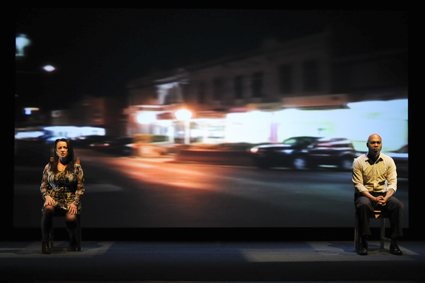
Yana Taylor, Irving Gregory, The Disappearances Project, version1.0
photo Heidrun Löhr
Yana Taylor, Irving Gregory, The Disappearances Project, version1.0
VERSION 1.0 HAS BEEN CREATING AMBITIOUS PERFORMANCE WORKS IN AUSTRALIA SINCE THE 1990S. THEIR LATEST, THE DISAPPEARANCES PROJECT, UNFURLS SLOWLY AND CAREFULLY AS IT INTERROGATES THE LOSS THAT REVERBERATES ACROSS SPACE AND TIME WHEN SOMEONE YOU LOVE DISAPPEARS. PERFORMERS IRVING GREGORY AND YANA TAYLOR TAKE THE AUDIENCE WITH THEM INTO THE TENSE AND SOMETIMES SHATTERING STATE OF MOURNING FOR THOSE WHO REMAIN UNCERTAINLY LOST.
In the company’s characteristic verbatim style, the performance includes excerpts from interviews conducted by version 1.0 with people who had experienced the loss of a loved one through disappearance. The performers share excerpts from stories they gleaned from these interviews, telling them as if they were their own. The authenticity of these narrative fragments in The Disappearances Project is both fascinating and painful to witness.
The first light of Yana Taylor and Sean Bacon’s video projection flickers across a large screen to Paul Prestipino’s emerging soundscape, laden with falling raindrops and trembling cascades of sound. The video, shot through the window of an endlessly, slow-moving vehicle, creates the sense of an exhaustive and inexorable search. Streetlights leak into a dawning cityscape to the incessant sound of dripping water. Rural and suburban streetscapes flitter onto the screen—their familiarity directly implicating viewers in the stories they will hear.
Yana Taylor and Irving Gregory’s miked voices emerge, disembodied—as if suspended in space—until their bodies are gradually illuminated by side lighting. For most of The Disappearances Project, the performers remain seated—upright, alert and tense on wooden chairs either side of the stage. Their near frozen stillness and the nervy soundscape charge the space with a sense of impending danger, tracing a plateau of quiet intensity which creeps to its peak when Taylor’s numbness begins to crack towards the end of the piece. The heaviness of the stories they tell visibly wears away at her, while Gregory maintains a veneer of relative calm.
The syncopated rhythm of the utterances is strung tightly across this ineffable space of mourning. Throughout, the performers’ alternating bursts of monologue bleed into each other’s stories, fragmenting them. Sometimes these stories enunciate glimmers of optimism, but always back-gridded by confusion and slowly building to existential explosions like, “It got to the point where I wanted to go missing, too.”
Taylor and Gregory do not perform fixed characters, but multiple embodiments from a range of experiences of loss. These float across the surfaces of the skin and the resonant timbres of their voices, a performative choice that neatly destabilises the potential for a linear performance structure and without leaning into didacticism. Sustained, disciplined stillness allows for this, as does the weaving of multiple stories into the performative fabric, without the performers embodying any singular identity. Perhaps Taylor and Irving explore a type of traumatised dis-embodiment, where they are rendered motionless due to the incomprehensible size and weight of such loss—a loss that always remains open, without closure.
The terrifying ambiguity of not-knowing displaces the missing persons’ loved ones. This nightmarish loss is always repeating itself in The Disappearances Project by perpetually asking, ‘What if?’ Taylor and Gregory articulate the varying registers of hope, denial, despair and anger that fill this non-place, for the most part with sensitivity and command.
The audience is encouraged to maintain a critical distance for the majority of the performance. At certain points, I wanted to be invited to ‘feel-with’ these stories of loss, rather than hover over them. This is the challenge of verbatim theatre that version 1.0 repeatedly faces with gusto: how can performance move an audience affectively, whilst also moving them to think critically about important social issues? The company managed this particularly well in The Bougainville Photoplay Project (2009-11).
Despite the successes of The Disappearances Project, I’m uncertain as to whether it met that challenge this time.
What The Disappearances Project highlights is a bureaucratic system predicated upon bodies that are fixed, stable and identifiable. The disappeared haunt the loved ones left behind who are punished further by bureaucracy’s inability to cope with the intricacies of human feeling. Where do loved ones of those who have disappeared go for help? Can our system accommodate and support complex human experiences? Whether or not verbatim theatre is an adequate mode for responding to such questions, at the heart of The Disappearances Project is an important plea to rethink the inadequacies of apparent democracy that fails when we need it most.
version 1.0, The Disappearances Project, concept, research, co-direction Yana Taylor, David Williams, devisers Irving Gregory, Paul Prestipino, Yana Taylor, David Williams, performers Irving Gregory, Yana Taylor, composer Paul Prestipino, lighting Frank Mainoo, film direction Yana Taylor, filmmaking collaborator Dan Jamieson, cinematographer, Sean Bacon, producer David Williams; Performance Space, CarriageWorks, Sydney, May 3-7
RealTime issue #103 June-July 2011 pg. 36
© Charlotte Farrell; for permission to reproduce apply to realtime@realtimearts.net
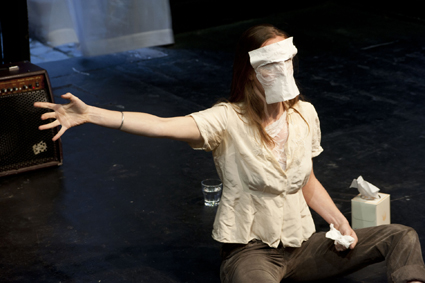
Brigid Jackson, This is—of the other
photo Nick Stephens
Brigid Jackson, This is—of the other
THIS IS—OF THE OTHER EXAMINES THE COLLABORATIVE RELATIONSHIP BETWEEN XX AND BRIGID JACKSON; THEIR FIREFLY-BRIGHT HOPES, SEPARATE SETBACKS AND THEIR ONSTAGE CHEMISTRY. AT ITS CORE IT IS A STUDY OF YOUNG ARTISTIC LIFE, OF THE DESIRE TO BE IN THE MENTAL AND PHYSICAL SPACE WHERE A CREATIVE SPARK IS IGNITED AND BURNS, THE ARTIST BECOMING A CONDUIT FOR SOMETHING ELECTRIC AND COMPELLING. WHAT TEARS PEOPLE AWAY FROM THIS PRODUCTIVE STATE IS THE STUFF THAT INFORMS ART—LIFE. DEATH LOOMS TOO, AS DO ILLNESS AND DISAPPOINTMENT.
X and Jackson have tackled autobiographical material using two complementary elements, touch and text. The words here range from prosaic to poetic, sometimes in the same monologue. Occasionally the performers seem to antagonise each other for real; spontaneous flashes of heat in their words raise questions about the proximity of real life to their art. Favouring performance based solely on movement, Jackson admits that hearing the first words come out of her mouth on stage is challenging.
The two young women who met at VCA in 2007 are tense and loose by turn, one earthy, one ethereal. The material in this performance, while broad in scope, has developed from their experiences of isolation. Jackson, the ethereal one, was at her mother’s side last year as she succumbed to cancer and then suffered a physical breakdown herself—”my scalp just let [my hair] go.”
Jackson’s grieving is conveyed powerfully and simply with a wet tissue placed over her face like a death mask then slowly inhaled into her mouth. On the floor, her ballerina-slim body raggedly convulses as it struggles to breathe through sobs. Remaining silent here, she avoids histrionics.
Bare-boned and intimate, the performance relies on few props—a radio, vacuum cleaner and tissue box—which relate to the shared living arrangement of the artists at one point. It was difficult not to feel a pang of empathy as Jackson expressed a desire for a baby to please her dying mother. X was in Paris at this time, directionless and lonely—reality in the city not living up to her artistic ambitions.
The stories overlap and run parallel to one another, the performers picking up loose pages from the floor, reading from their missives to each other unsystematically. X crawls close to the walls in the claustrophobic, blackened space at La Mama, scratching her arms against their surfaces in an act of frustration and restlessness. Unable to console each other adequately through written language, the dialogue turns to the platitudes that close their emails. Their unravelling is best conveyed physically. Jackson traces an operating vacuum cleaner nozzle across her skin in an act of seeming self-harm or procrastination.
Jackson and X push each other into new depths of their practice, both in the thoughts they share and their exploration of physical expression. There is a moody, ad lib quality to the piece as the duo builds a quiet, emotive landscape brick by brick, word by word.
This is—of the other, made & performed by XX and Brigid Jackson, La Mama, Melbourne, March 23-April 23
RealTime issue #103 June-July 2011 pg. 37
© Varia Karipoff; for permission to reproduce apply to realtime@realtimearts.net
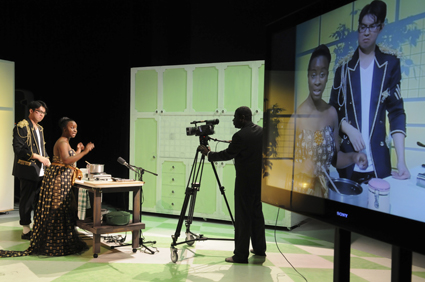
Alan Lao, Effie Nkrumah, Frank Mainoo, Ama and Chan, Urban Theatre Projects
photo Heidrun Löhr
Alan Lao, Effie Nkrumah, Frank Mainoo, Ama and Chan, Urban Theatre Projects
THAT “REALITY TELEVISION” IS AN OXYMORON IS FAIRLY COMMON KNOWLEDGE. FROM SURVIVOR AND BIG BROTHER TO MASTERCHEF AND THE AMAZING RACE, THE “REALITY” OF THE GENRE HAS ALWAYS TAKEN A BACKSEAT TO THE “TELEVISION” OF IT. THE TRUISM THAT OBSERVATION ALTERS THE THING OBSERVED IS TRUE ENOUGH OF CINEMA VERITE AND NATURE DOCUMENTARY, LET ALONE OF A PROGRAM THAT HOLES UP 16 OF SOCIETY’S MORE VACUOUS SPECIMENS IN A FORTRESS OF ARCHITECTURAL MODERNISM AND PLIES THEM WITH ALCOHOL FOR THREE MONTHS. IT IS DIFFICULT TO THINK OF RICHARD HATCH AS A MODERN DAY ROBINSON CRUSOE WHEN JEFF PROBST KEEPS ROCKING UP AT CAMP LOOKING LIKE THE ACTIVITIES MANAGER FROM A NEARBY SPA RESORT. AND EVERYONE KNOWS BY NOW THAT BY THE TIME THE JUDGES TASTE ANYTHING ON MASTERCHEF THE DISHES HAVE BEEN COLD FOR A GOOD 45 MINUTES AND THAT THE CONTESTANTS THEMSELVES RECEIVE SUB-PAR CATERING.
At least within this country, however, the least realistic thing about reality television is its colour: these programs have an insidious tendency to be a starchy, unrepresentative White. (To its credit, MasterChef has been somewhat more colourful than other programs—Chinese-Australian Adam Liaw won the competition in 2010, Malaysia-born Poh Ling Yeow came second the year before that, and Greek-Australian George Colambaris is one of the three judges—but even its line-up tends towards the starchy.) One can’t but recall Lee Lewis’s 2007 Platform Paper on cross-racial casting: “I had grown accustomed to New York’s mixed-race casts and was astonished that the ethnic diversity that was so apparent on the streets was not replicated on Sydney’s stages,” Lewis writes. Let’s hope she didn’t tune in to The Block or My Kitchen Rules.
It should come as no surprise that Urban Theatre Projects’ Ama and Chan takes this sorry state of affairs as its starting point. As Caroline Wake writes in her introduction to RealTime’s online archive of pieces on the company and its work: “Time and time again, Urban Theatre Projects has explored who becomes marginalised, how and why…Through their many productions we have come to know many modes of resilience: modest contingent, defiant, temporary, permanent and sometimes triumphant, but rarely in the way we expect.” Certainly, that is the case here. Where one might expect an angry, even militant, approach, Ama and Chan’s critique is instead subtle and good-humoured, worn on the sleeve of the production only lightly, as though it could, like lint, be brushed away without a second thought.
Indeed, if the production’s strategy could be summed up in a word, it would perhaps be “charm.” Performers Effie Nkrumah and Alan Lao have created, in the titular characters, two intensely and immediately likable protagonists. Ghanaian-Australian Ama and her bumbling Chinese-Australian husband Chan meet the audience in the foyer of the Bankstown Arts Centre prior to the show in a hilarious meet-and-greet that might be better described as an accost-and-berate. (Chan gives the vegetarians a particularly hard time.) They spurn political correctness. (Ama asks the row of Africans in the audience to smile. When she fails to see their teeth in the darkness, she frowns: “Hang on! That’s just a row of empty chairs!”) To a large extent, the characters hew pretty closely to stereotype. Chan’s Chinese-Australian accent is straight out of the fish markets and Ama’s entire persona reminiscent of blaxploitation’s sassy supermamas. When the piece reveals its interest in reality television, however, this reliance on types is revealed to have a very particular purpose: we quickly realise that these same types fall outside television’s prescribed and limited definition of social reality.
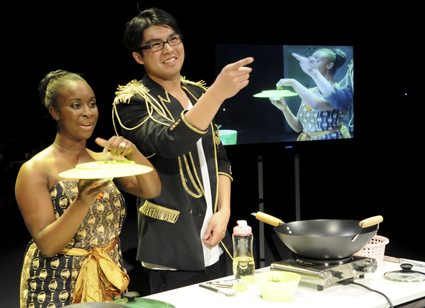
Effie Nkrumah, Alan Lao, Ama and Chan, Urban Theatre Projects
photo Heidrun Löhr
Effie Nkrumah, Alan Lao, Ama and Chan, Urban Theatre Projects
Drew Fairley’s production posits a unique solution to this problem: Ama and Chan take to the internet with a YouTube cooking show. (Within the context of the narrative, their reasons for doing so are less social than financial: the couple’s furniture has been lost by removalists on the day they are supposed to move into their new apartment. Chan hasn’t purchased insurance, one suspects characteristically.) Dedicated to “Ghanaian-Chinese fusion,” with the cuisines, like the character types themselves, given added depth and richness by their collision with one another, the couple’s show takes advantage of the digital sphere and its much-touted capacity for breaking down cultural barriers and opening up more inclusive and representative spaces.
A Catfish-esque montage of images from Google Maps, iPhone text messages and online airline booking sites opens the production, serving as its prologue and providing us with the characters’ back stories. The networked world also played an important role in the production’s marketing strategy, with audiences invited to befriend Ama and Chan on Facebook and follow the latter’s hilarious videoblog in the lead-up to the season.
With the Arab Spring still in full swing as this issue goes to press and with the importance, if not necessarily the centrality, of these same technologies to those struggles, the exploration of their capacity for creating new spaces here at home seems timely. Ama and Chan’s mode of resilience, too, is a digital one.
Urban Theatre Projects, Ama and Chan, director, writer Drew Fairley, devisors, performers, writers Effie Nkrumah, Alan Lao, dramaturg Alicia Talbot, musician, performer Reza Achman, Bankstown Arts Centre Theatre, Sydney, May 4-14
RealTime issue #103 June-July 2011 pg. 38
© Matthew Clayfield; for permission to reproduce apply to realtime@realtimearts.net
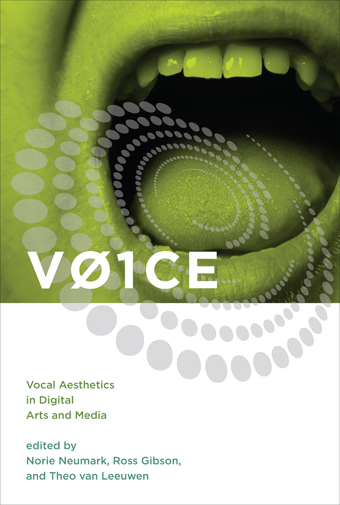
VOICE: vocal aesthetics in digital arts and media
IS IT SACRILEGIOUS TO ADMIT THAT I’M UNDERWHELMED BY ROLAND BARTHES’ CLASSIC ESSAY “THE GRAIN OF THE VOICE”? BEYOND THE TITULAR CONCEPT THAT THE VOICE CONTAINS THE ESSENCE OF ITS PRODUCING BODY, “THE GRAIN,” THE ESSAY REVEALS LITTLE ABOUT THE RAW VOICE ITSELF, CONCENTRATING MORE ON BARTHES’ OPINIONS ABOUT CLASSICAL MUSIC.
While Barthes’ “grain” is well-referenced in VOICE: vocal aesthetics in digital arts and media, edited by Norie Neumark, Ross Gibson and Theo van Leeuwen, the 19 essays gathered here prove much more satisfying. The book offers multiple analyses of the voice in concert with and beyond language, with a focus on the mediated voice and its relationship with technologies and modes of contemporary art production.
The book is divided into four areas that essentially lead us from the gadgets of the past to propositions for the future. The first section, “Capturing Voice,” explores technologies by which the voice has been synthesised, recorded, stored and transmitted. Theo van Leeuwen looks at instrumental emulations of the voice, starting with pipe organs and ending with the synthesised samples found on his Roland RD300-SX, discussed within the framework of authenticity and modality theory. Thomas Y Levin conducts a whirlwind tour of the history of voicemail revealing a range of fascinating early inventions and proposing that the recorded/transmitted voice is a form of writing.
Virginia Madsen and John Potts look at the extension of temporally dependent radio into the realm of on-demand voice casting, exploring amateurism and audio blogging along with Brecht’s idea of radio as a two-sided exchange. Martin Thomas’ chapter on archiving Aboriginal languages is particularly fascinating with its analysis of the use of language in Rolf de Heer’s Ten Canoes and the possibilities that digital technology offers for communities to archive themselves.
Part two, “Performing Voice,” groups together essays that explore the voice in action across a range of artworks that can loosely be defined as ‘performed.’ A particular highlight is Brandon LaBelle’s complex analysis of sound poetry perhaps because it most directly addresses the paradoxes inherent in vocalisation. LaBelle states that in “attempting to free orality from the constraints of linguistic meaning, sound poetry edges against tensions inherent in subjectivity…sound poetry yearns for language by rupturing the very coherence of it.” He also identifies the tension in sound poetry between the desire to embrace technology and the pursuit of a raw, primal voicing with examples from artists such as Henri Chopin, William Burroughs and François Dufrêne. He concludes with the proposition that as we now live in the realm of the digital, the modernist project involving the fragmentation of the subject has been replaced by a networked and “distributed sense of subjectivity.”
Amanda Stewart’s artist statement follows on aptly from LaBelle as she describes her explorations into “the materiality of language itself.” Tracing her trajectory from poet-on-the-page to performing vocal artist via radio production, Stewart offers an astute analysis of the role of technology in her practice, both analogue and digital. Meredith Morse’s exploration of the voice in the works of choreographers Yvonne Rainer and Simone Forti is also a fascinating read, exploring how their voices ruptured the perceived sacredness of the silent dancing body. While she suggests these artists’ explorations anticipated digital approaches, the overall analogue preoccupation of the chapter makes this essay feel slightly tangential to the overall framework of the book.
The third section, “Reanimating Voice,” offers the most practice-oriented chapters, focussing on many illuminating examples of the voice and its manipulation in screen media. The highlight here is the chapter on filmic voices by academic Helen Macallan and sound designer Andrew Plain. Plain’s real world perspective mixed with Macallan’s informed analysis offers many insights into the effect digital processes are having on voice in film, particularly regarding the hierarchy of voice to sounds within a score and the importance of spatialisation given the renewed excitement about 3D cinema.
Mark Ward and Axel Stockburger’s chapters on the voice in video and computer games cross over considerably. Stockburger offers a more academic overview with an emphasis on the role of the user’s voice in the game, while Ward presents an in-depth analysis of sound design in the game BioShock. As with Macallan and Plain’s chapter, it is particularly insightful due to its inclusion of detailed statements by the game’s Audio Lead (head sound designer) Emily Ridgway.
The concluding section, “At the Human Limits of Voice,” starts with a poetic exploration by anthropologist Michael Taussig addressing the spiritual nature of humming, using examples ranging from Winnie the Pooh to the Iroquois people and ending with an excerpt from the Chicago 7 trial involving Allen Ginsberg. The thrust of his argument is that “humming is central to language, as a base state of the voice, humming being neither conscious nor unconscious, neither singing nor saying, but rather sound where the moving mind meets the moving body.”
Nermin Saybasili continues the spiritual exploration in her analysis of a range of media artworks addressing migrant experience in Europe, arguing that the displaced and disembodied migrant voice is essentially a haunting, occupying a liminal space which is in fact inseparable “from the social body.”
The book concludes with a chapter by Philip Brophy exploring how “the human voice readily becomes its other through vocalisation,” using examples of songs by popular artists including Michael Jackson, Cornelius, Yoko Ono and Scott Walker, as well as Luciano Berio. Interestingly this and another chapter by Ross Gibson on the pre-digital nature of King Tubby’s dub, including a quick summary of modern vocal production techniques, are the only chapters that deal with music as such. This ensures that the book is not swamped by multifarious discourses on popular music, allowing alternative voices about voice to be heard.
It is this range of approaches and the presence of multiple stylistic voices that makes this book so enjoyable. I particularly appreciated the inclusion of more personal writing from the likes of Amanda Stewart and Theresa M Senft. The latter’s autobiographical account of her adventures—with telephone sex chat lines, self-help cancer tapes, computer voice recognition and Alvin Lucier’s I am sitting in a room—is both informative and moving. The whirlwind smash-and-grab poetics of Mark Amerika also makes for a provocative read.
Norie Neumark frames VOICE: vocal aesthetics in digital arts and media with an introduction offering a range of theoretical approaches to the paradox of vocality which many of the individual chapters expand upon, providing the book with a strong academic underpinning. However for me it is inclusion of real life applications and statements from practising artists interwoven with theoretical analysis and provocation that make this book a pleasurable, accessible and edifying read.
VOICE: vocal aesthetics in digital arts and media, editors Norie Neumark, Ross Gibson and Theo van Leeuwen, MIT Press, Cambridge Massachusetts, London, 2010
RealTime issue #103 June-July 2011 pg. 39
© Gail Priest; for permission to reproduce apply to realtime@realtimearts.net
“PEACOCKS ARE VAIN AND STUPID,” CONDUCTOR SIMON CHARLES EXPLAINED. “AT MONTSALVAT ONE KEPT ON COMING INTO THE GREAT HALL AND STARING AT HIMSELF IN THE MIRROR.” THE RECENT PERFORMANCE, FEATURING FOUR PIECES COMPOSED DURING CHARLES’ RESIDENCY AT THE VICTORIAN ARTIST COLONY, WAS UNDERSCORED BY A LESSON FROM THE PEACOCK: YOU CAN MAKE SERIOUS MUSIC, BUT YOU ALSO HAVE TO MAKE FUN OF YOURSELF. THIS DID NOT MEAN THAT THE ENSEMBLE, FEATURING AVIVA ENDEAN ON CLARINETS, MATTHEW HORSLEY ON PERCUSSION, KIM TAN ON FLUTES AND RYAN WILLIAMS ON RECORDERS, SHIED AWAY FROM FULL-BLOODED ‘SERIOUS’ MUSIC, TO WHICH THE FIRST HALF OF THE CONCERT WAS DEDICATED.
Tan opened the concert by sending Toru Takemitsu’s “Air” darting about the lofty spaces of Richmond Uniting Church. The solo flute meditation on air in and outside the body requires the performer to turn breath into wind, imitating a gust one minute and a gale the next. Maintaining intonation and rhythmic precision amidst the composition’s swelling melodic zephyrs, Tan delivered the impossibility of controlled abandon.
“Air” set the impressionist tone for the rest of the first half, sitting comfortably alongside the light tone colour of Charles’ “White Simplex” for bass recorder, bass clarinet and percussion. The overblown, underblown and plosive attacks on the deep instruments sounded as though you were wandering past a drain pipe and heard, far below, some peculiar machines having a secret conversation.
The machines were brought to light for Charles’ percussion piece “Matcham’s Junk.” Charles carves, or threads, a delicate miniature from the barely perceptible sounds of springs, tiny stones and grating pipes, fittingly sourced from the backyard collection of the late jeweller, sculptor and former resident of Montsalvat, Matcham Skipper.
Open ocean provided the program for Liza Lim’s solo clarinet work “Sonorous Body” inspired by the text from her opera The Navigator: “Horizon and water/ Could never be lovers/ Horizon adores only distance/ Sonorous water/ Searching for its sonorous body.”
Lim paints a horizon of undulating microtonal lines, broken only by key clatter and pops and slaps like water on the side of a boat. Endean on clarinet gave expression to the horizon’s infinite desire for distance through her fearsome dynamic range, from the piece’s ear-splitting climax to the barely audible, bubbling double trills at its conclusion.
The second half of the program featured theatrical works that tested the peacock’s composure with both humour and challenging political themes. Matthew Horsely’s “Murdering Creek Rd” was inspired by the composer’s night time visit to the scene of a premeditated massacre of Indigenous Gubbi Gubbi people by white cattlemen in the 1860s. In the first movement the performers call forth chaotic screams from their instruments before breaking into fragments of Australian folk song. Manically waving a lagerphone, Horsely may be conjuring a lawless, unstable, early colonial Australia. He may also be making a humbling parody of contemporary music in the face of an issue that it can only address with difficulty. The second movement asks, “whether the ghosts can be appeased and the land made whole again.” This time, Horsely draws from the Pentecostal musical tradition of New York saxophonist Albert Ayler, with a nod to an account of the massacre that suggests it occurred immediately after a church service. The work does not attempt to answer conflicts arising from its engagement with the historical moment, with Horsely conceding that, “the only answer we receive is the percussive equivocation of the pobblebonk frogs.”
Horsley’s rendition of Greek born French composer Georges Aperghis’ “Le Corps à Corps” saw the solo percussionist careening around the church on an office chair. Horsley played a commentator, narrating the car-cum-chariot race at breakneck speed while accompanying himself on a Persian zarb.
The concert concluded with Charles’ “LOL On My Face,” featuring the disturbing juxtaposition of a dirge-like canon exercise played on alto flute, bass recorder, clarinet and crotales and a vocalist retching and croaking “Shut up, Shut the fuck up!” Humorous, yes, but also strangely beautiful. Providing experiences from sublime to ridiculous, Plight of the Peacock both strutted and laughed with pride.
Plight of the Peacock, conductor Simon Charles, clarinets Aviva Endean, percussion Matthew Horsley, flutes Kim Tan, recorders Ryan Williams, Richmond Uniting Church, Melbourne, May 6
RealTime issue #103 June-July 2011 pg. 39
© Matthew Lorenzon; for permission to reproduce apply to realtime@realtimearts.net
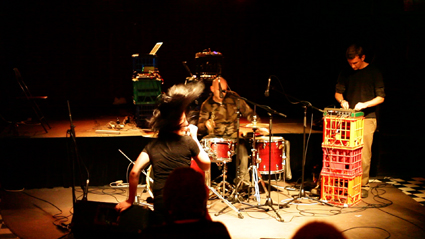
Kusum Normoyle, Sean Baxter, Peter Blamey, High Reflections
video still courtesy Kusum Normoyle
Kusum Normoyle, Sean Baxter, Peter Blamey, High Reflections
THE BEGINNING OF THE MILLENNIUM WAS A GOOD TIME FOR EXPERIMENTAL MUSIC AND AUDIO ARTS IN SYDNEY WITH SEVERAL REGULAR EVENTS SUCH AS IMPERMANENT.AUDIO, DISORIENTATION, IF YOU LIKE IMPROVISED MUSIC WE LIKE YOU (AKA THE NOW NOW), ¼ INCH AND SOUNDNOSOUND TAKING PLACE IN A RANGE OF INTRIGUING ARTIST-RUN (ILLEGAL) VENUES LIKE SPACE 3, LAN FRANCHI’S MEMORIAL DISCOTHEQUE AND HIBERNIAN HOUSE. THERE WAS A REAL SENSE OF COMMUNITY AND MOMENTUM GUIDED BY SOME EMERGING CURATORS AND FUELLED BY YOUNGER ARTISTS COMING THROUGH TERTIARY INSTITUTIONS SUCH AS THE UNIVERSITY OF WESTERN SYDNEY AND UTS.
By around 2006 things were dying down: venues were scarce, event organisers became tired and/or got real jobs and the media arts bubble burst, taking with it the more audio focused university courses. But maybe this was the pause that refreshes because in 2011, along with a few of the older events that continue, there is another batch of regular gigs with new performers and new audiences. Over the next editions I will survey some of these, exploring their particular flavours (and flaws) and discovering ways in which artists are currently reshaping our expectations of music.
the silent hour
The Silent Hour is the latest addition to the experimental music scene, starting in January 2011. It is run through The General Store Gallery, William Street in Kings Cross, under the guidance of Ben Galvin with occasional guest curators. The shows are irregular but can occur up to twice a month and the programming so far shops across a range of styles from improv, audiovisual, pop inflected electronica and a hint of noisier stuff, with no sense of a rigid agenda.
A small but loving audience attended Session IV featuring three acts. Hinterlandt (Jochen Gutsch, from Germany now residing in Sydney) presented a jam-packed set on keyboard, trumpet, guitar, samples and vocals. He moves effortlessly through a lot of material and after 30 minutes it begins to feel overloaded, but it’s well-produced electro pop with complicated structures and warped edges. Scissor Lock (Marcus Whale) is a man about town, performing regularly at many of these series. His luscious rafts of sound made from layers of static and mangled voice form into sweet and abrasive crescendos that seem at once familiar yet unique.
Visiting German artist Max Neupert closed the night with a live data and video link up with THE! —Tommy Neuwirth, Clemens Wegener—in different locations in Germany. Writing only code they played a collaborative piece of shifting beats and bleeps that was complex and playful, making the most of the limited midi sound palette. In the following weeks Neupert also presented Satellite Zodiac, a gallery installation mapping the realtime data of satellites across our night skies with moving laser pointers. This forms part of an intriguing body of work concerned with modern astronomy.
While the rhetoric around The Silent Hour is somewhat overwrought and the title curious given the events are neither silent nor an hour in length, the intimate space, openness of curation and the enthusiasm of Ben Galvin make this series worth investigating.
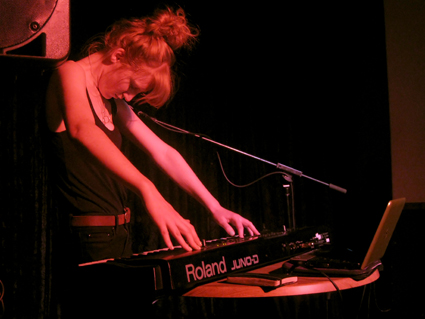
Daisy Buchanan, Ladyz in Noyze, Adelaide
photo Spoz
Daisy Buchanan, Ladyz in Noyze, Adelaide
ladyz in noyz
Predominantly a Melbourne activity run by Lara Soulio, this was a tour to promote the CD compilation of the same name, with gigs in Melbourne, Sydney, Adelaide and Newcastle (Soulio is extending the work of Marlo Eggplant’s US compilations through Corpus Callosum). While there has been reluctance in the past few years (in Sydney at least) to create separate women’s sound events, it feels as though Ladyz in Noyz has a celebratory, non-righteous agenda that releases it from concerns about ghettoisation. The ladyz vibe was nicely reinforced by the venue, The Red Rattler in Marrickville, a fully legal artist-run theatre established by a collective of women in 2009, which has been a godsend to the alternative performing arts.
Refreshingly, there were four acts from out of town that I hadn’t heard before. Rites Wild (Adelaide) presented a set of songs made from big dirty synth sounds, pared back drumming (by a male) and distorted war chant vocals creating a Nico-esque dirge. Daisy Buchanan (Melbourne) on keyboard offered blizzards of shredded descending tones and dark, folky vocals, heavy on apocalyptic atmosphere. I particularly enjoyed Oranj Punjabi (Melbourne) who used a tabletop full of pedals and electrical boxes, setting up drones by singing into an electro-hacked tin can, her metallic thumps and big delays reminiscent of early industrial music. Finally Festive Jackals (Lismore/Melbourne) sculpted vocal utterances into thick layers of buzzy fuzz, their delayed shouts escalating into a nightmare soundscape that might have pleased Dante.
While each of these artists had their own methodologies, there were strong similarities in their dirty fuzz, bassy drones, submerged vocals and sudden stops. Onnie Art (Melbourne) offered a slightly different approach working with voice, electronics and objects (a tape measure flicked savagely) creating a more chaotic, comic performance. Kusum Normoyle (Sydney) gave us the most physical and brutal set, her screaming and feedback assault deftly crafted to form a thick but detailed noisescape. Normoyle aside (her signature is brevity), I was surprised that all sets barely topped 15 minutes. While particularly sensitive to artists overstaying their welcome I couldn’t shake the feeling that these ladyz should boldly demand more of our time.
While not yet a regular Sydney event, Ladyz in Noyz is certainly an interesting addition to the sound landscape. Lara Soulio has plans to make it happen here again, hopefully with more local involvement.
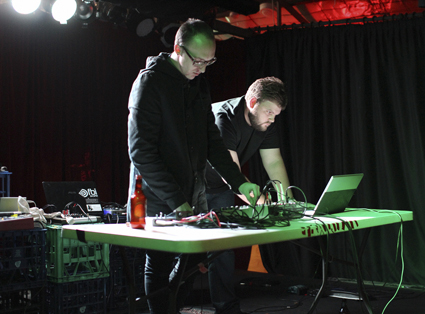
Machine Death
photo Paul Marshall
Machine Death
high reflections
It could be argued that High Reflections kicked off the resurgence of sound activity in 2009. Caleb Kelly, curator of previous activities such as the seminal impermanent.audio and Pelt Gallery teamed up with Alex White who moved straight from running Electrofringe (2007-08) to take on Serial Space, the venue originally founded by Tameka Carter and Louise Dibben in 2008 that can also be credited with keeping the lights on through the dark times. Taking place monthly on a Saturday night it offered a more upbeat but no less edgy side of experimental music, drawing in elements from more alt-pop genres like metal, no-wave, freak-folk and psychedelia.
I use the past tense as the curators have decided to wrap it up with the final two nights taking place at The Red Rattler: a mini-festival presenting 17 artists, many in new combinations. One particularly successful pairing featured Jon Hunter and Nonemusic (Nic de Jong from Naked on the Vague) playing a sustained guitar epiphany. For the majority of the piece Nonemusic focused on a detuned arpeggio loaded with delay to create an ever-evolving sea of notes. Hunter exacted astounding sounds from his guitar—bubbling water, banshee howling and a truly bone-chilling wooden creaking like a ship in the process of breaking up. The cohesion between the two loosened as it morphed into a kind of broken pop song, but overall we witnessed a dynamic meeting of minds and guitars.
The second evening offered some magic sets. Long time favourites who perform rarely, Machine Death work with dirty minimalist pulses that build by infinitesimal layers, like intricate Japanese lacquer work, to enormous noise. If they’d pushed the volume just a little more in the latter tracks, we just might have reached that higher plain.
Sean Baxter on drums, Kusum Normoyle on voice and Peter Blamey on electronic emissions offered some hardcore extreme clamour. Normoyle prowls the stage, howling and triggering feedback that wraps around Blamey’s deep, electronic eructations, with all the spaces filled by Baxter’s metal pipes clattering over his drumkit: loud, dense and bracing.
However the real highlight was the psychological terror induced by Thembi Soddell’s performance. With the lights turned off and a request for quiet (even the rattling fridges were silenced), Soddell, hidden from view, created an amazingly evocative soundscape of unspecified but terrifying dread coming towards us slowly from a distance. An intensifying rumble augmented by half-human, half-animal shrieks reaches its zenith and then sucks back down, vacuum-like, to a ringing almost-silence, only to begin again. With a fine balance between augmented field recording and machine noise Soddell perfectly controls this exhilarating journey into her unconscious—or is it our own?
The final night of High Reflections was a fitting roundup of two years of diverse and adventurous programming and it is sad to see the end of another era. But as this current resurgence of gigs evidences, it’s all part of a greater cycle—there’s more to come.
Next up I’ll report on visits to Sound Series and 1/4 inch.
The Silent Hour, curator Ben Galvin, The General Store, March 31, www.the-generalstore.net/The_SIlent_Hour.html; Ladyz in Noyz —Sydney, curator Lara Soulio, The Red Rattler, April 10; High Reflections, curators Caleb Kelly, Alex White, The Red Rattler, Sydney, May 25-26, www.highreflections.org/
RealTime issue #103 June-July 2011 pg. 40
© Gail Priest; for permission to reproduce apply to realtime@realtimearts.net
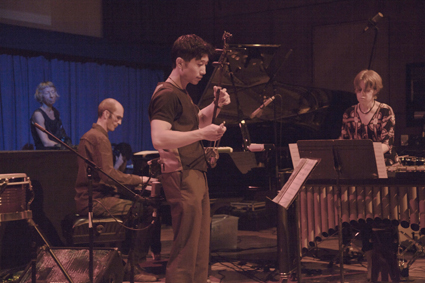
Janet Baker-Finch, Erik Griswold, Nicholas Ng, Vanessa Tomlinson
photo Sharka Bosakova
Janet Baker-Finch, Erik Griswold, Nicholas Ng, Vanessa Tomlinson
IT’S CLOCKED OUT DUO’S SEASON OPENER AT QLD CON’S RECITAL HALL. NICE SIZED CROWD, NICE PRE CONCERT BUZZ. STAGE SET-UP IS A COUPLE OF PIANOS, PERCUSSION, VIBES, BIG DRUMS. UP THE BACK, HIGH OVER A TALLISH THIN PLATFORM, HANGS A WIRE BASKET AND A LARGE CIRCULAR CONE, POINTY SIDE DOWN. ERIK GRISWOLD INTROS THE PROGRAM (SEVEN PIECES IN 60 MINS), THANKS THE GUESTS, USES THE ‘EXPERIMENTAL’ WORD. TELLS US THE WIRE BASKET AT THE BACK HOLDS ICE THAT WE WILL HEAR MELTING ONTO STUFF LATER—I MUST ADMIT I DID NOT NOTICE IT AGAIN OTHER THAN TO WONDER FROM TIME TO TIME IF I SHOULD BE NOTICING IT.
Clocks tick away (tonight’s theme) and the concert starts with Wake Up!—a sort of programmatic journey across the sleep cycle. Percussive tic-tocs and prepared piano chimes move into fast rolls on skins, then a long middle section of hits on wood like a bunch of clocks ticking to their own individual time frames. Tube cut metal bells tinkle out a lullaby against sparse piano before waking to a strangely funkless swamp groove.
Now that everyone is awake it’s onto breakfast with two guests—Lawrence English and Janet Baker-Finch—and Tomlinson playing what could be cereal bowls. Tomlinson is doing percussion-as-Foley and even though it is really nice to hear the different sounds and consider the transitions from beats to clicks to noise to tones as one clicks and taps and scrunches ever faster, things get a bit formless. I invoke audience privilege and blame the performers for my wandering attention rather than thinking it is my fault for not understanding what is going on. But…in come some seagull sounds via English’s field recordings and that gives the whole thing a bit of retrospective sense. The dynamics of the previous section anticipated the seagulls. They have taken the formless and unpredictable and retrospectively predicated it on familiar nature. This is a great touch as so much of listening is about forward prediction and this piece reverses that default. Instead of modulating prediction to give meaning through elements of musical surprise and familiarity we get storytelling and memory to make sense of the past. Then again, as Griswold starts rolling a ping pong ball on the strings of a zither and yet another instrument gets its time in the sun, I wonder if perhaps I’m reading a bit too much into it. Then the seagulls disappear and cycles of soft ocean waves fade in to gently underpin the form with another scale of repetition.
A few shorter pieces follow. Griswold sings what sounds like a Chinese street vendor’s call to Nicholas Ng’s accompaniment on erhu. Fast atonal bits and pieces come in on percussion and piano then it all syncs together through a majestic chordal sequence before more traditional tune, riffy piano and vibes. Like an update to mid 70s jazz fusion a la Jean-Luc Ponty.
The guest spot with Joel Stern introduces old school electronic FX—squealy pig snorts, booming bass drums. The interplay between the performers is excellent; they seem to be really listening and adapting to each other. Switching on and off, back and forth, bursts of noise then a quick stop tight with the drums–like stadium rock gods trading ever-harder solos as a contest in status updates.
The final piece is Spill Redux with Baker-Finch, a re-working of the earlier Spill [www.clockedout.org/projects/dsfpercussion.html]. Here we discover the purpose of the hollow inverted cone suspended at the back. It is filled with rice and swung as a pendulum, rice slowly leaking from the bottom. The rice spills onto a variety of surfaces, such as bowls and paper, to make gentle bursts of percussive noise. Using a leaking pendulum to drive a rhythmic pulse is a beautiful idea, as the period of a pendulum’s swing remains constant even as the arc of the swing gets shorter. Another link to clocks.
Baker Finch moves in and out of the arc of the pendulum’s swing. She wears a garbage bag dress, outsized castanets on her fingers, metal kitchenware on her limbs. She drags her foot through the spilled rice to make sound, slow and hypnotic, then reaches into the falling stream of rice, making washes of sound that hint back to the earlier field recordings of ocean waves. The rice runs out and the evening finishes on church bells and a call to prayer. The weekly rituals. Awake and asleep. Waves and the ocean tides.
Wake Up! Clocked Out Duo (Erik Griswold, Vanessa Tomlinson) with Janet Baker-Finch, Lawrence English, Nicholas Ng, Joel Stern, Queensland Conservatorium, Brisbane, March 23
RealTime issue #103 June-July 2011 pg. 41
© Greg Hooper; for permission to reproduce apply to realtime@realtimearts.net
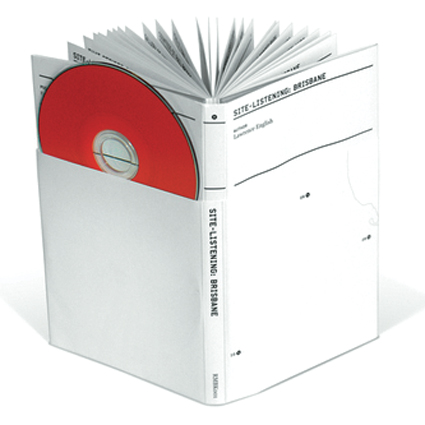
ite-Listening: Brisbane, Guidebook and 3” CD, Room 40
LAWRENCE ENGLISH WANTS US TO EXPAND OUR PERCEPTION. HE DOESN’T JUST WANT US TO PAY MORE ATTENTION TO SOUND, BUT TO PREFERENCE OUR EARS IN OUR SENSORY ENGAGEMENT WITH PLACE. THIS IS HARDER THAN IT SOUNDS. FOR ONE, OURS IS INCREASINGLY A VISUAL WORLD, FORMED, LIVED AND KNOWN THROUGH TEXT AND IMAGE. SECONDLY, OUR EARS HEAR CEASELESSLY, BUT OUR BRAINS ARE TRAINED TO PROTECT US, APPLYING ‘NEUROLOGICAL COTTON WOOL’ THAT FILTERS AND PROTECTS US FROM THE SHEER MASS OF AUDITORY INFORMATION WE ENCOUNTER IN EVERYDAY LIFE.
This idea is not a new one, as audiophiles know—the concepts of acoustic ecology and the human mediation of the environment through sound have been around for 50 years or more. English himself has extensively promoted the idea of careful listening to spaces to cultivate a sense of sonic aesthetics through phonography in some of the world’s wildest places. His latest intervention is in many ways the natural next step for the project he terms site-listening—a handbook to guide the listener to experience and apprehend the sounds of various locations in and around South-East Queensland.
Site Listening: Brisbane invites us to offset our ordinary ocular-centrism in a guided tour of some 17 natural and manmade sites within the Greater Brisbane region. The book includes discussions of the act of listening in Brisbane, opening with a short essay by English outlining the project and closing with essays by Nick Earls and David Toop. The quintessential Brisbanite, Earls emphasises sound’s snapshot function, pointing out how some of the most familiar and pervasive sounds in our day-to-day life—the beep of a reversing truck or the click of a resident gecko (“40 to a house on average”)—haven’t always been here but rather, over the last two decades or so, have insinuated themselves into the normal sound of living here. Though he also considers sound’s transience, Toop provides an insight on the “bizarre, totally unfamiliar sounds” the city serves up to an outsider. One of his most memorable descriptions is of the evening roost of squabbling flying foxes, “hung messily from the trees as if a cargo of broken black umbrellas had been dumped from a plane flying overhead” and sounding like “a large man wallowing in a bathtub filled with squeaky rubber ducks.”
The sites we are guided to in the book are precisely noted with a colour image, map and GPS co-ordinates and a short description of the possible sounds the listener may hear unfolding at different times of day. The guide covers the city’s orifices: its airport, port, marina, railway and other major organs, like the football stadium and Gallery of Modern Art. The city’s lungs are also included in the form of inner- and outer-city parklands, matchless wetlands and state forests. Throughout the book, English’s highly attuned sonic sensibilities—both legacy and matrix of his field recording practice—result in fine-grained textual description of the sound-making structures and bioacoustics in each site. While the guide’s locations, and numerous others, are listed on the project’s website—part of English’s ongoing and expanding mission to psycho-acoustically map Queensland—this little book is an important publication. An attractive object, its cover cleverly folding out to display an A4-sized map of the locations, it is only just bigger than an audiotape, making it the perfect size for a pocket when not being consulted on location.
Some Brisbanites may feel a little conflicted about the choice of locations. On the one hand, there is a particular thrill in revisiting a familiar location, such as the heritage-listed Highgate Hill lookout on the knoll of Dornoch Terrace, a popular spot during visually spectacular events such as fireworks and eclipses. The site-listening approach suggests “recommended time: late night.” On the other hand, natural locations are incontrovertibly special sites, such as the Tinchi Tamba tidal wetlands teeming with life-giving mangroves. Many, if not most, are (largely) protected by state legislation, or at least widely acknowledged for their cultural and environmental value. In a fast-growing region there are other sites around this city that, though not yet recognised or protected, are just as important—”spaces where life occurs,” to use Christian Norberg-Schultz’s famous phrase.
While it’s great to see mention of local, unofficial landmarks such as the Griffin Park bat colony, there is a rare opportunity here for advocacy on behalf of numerous other significant sites threatened by the city’s insatiable hunger for space. Inner-city bushland, dwindling koala habitats and historic architecture critically endangered by ‘sustainable development’ in a rapidly disappearing Brisbane come to mind. Their non-inclusion means that the book centres on mainly known locations, and has longevity—it will still be relevant long after endangered places are developed. Then again, being mentioned in a book like this could prove very pertinent to ongoing efforts to preserve and retain these spaces. Considering the locations that are included, it’s worth remembering that legislation can always be changed, and that even those places currently designated as reserves are only a planning decision away from permanent disappearance.
English mentions this constant flux, and in many ways this book’s quiet insistence that we spend our time not just passing through or looking at, but paying real attention to ‘place’ acts as an implicit assertion of the public value of these and other shared landscapes. To visit the geographies mapped in this guide is to realise how readily the process of privileging sound reveals details the eye can overlook, and how much the ‘spirit’ of a place emerges from interactions between the environment and the human sensorium. The quiet act of dwelling intentionally in these locations generates an awareness of the small and meaningful within the infinite and the everyday. As Toop puts it, when we really listen to sites, what we hear, when we realise we are “just one moving point in a distinctive web of resonances, atmospheres, pressure waves, echoes, signals and silence,” is our place within them. This may be the most valuable guidance of all: that landscape is not just something we behold with our senses, but something to which we are also beholden.
Lawrence English, Site-Listening: Brisbane, Guidebook and 3” CD, publisher Room40, catalogue no. RMBK001, design ORDNER, Ralph Steinbrüchel, sponsor Queensland Music Festival; http://sitelistening.com/; http://room40.org/store/lawrence-english-site-listening
RealTime issue #103 June-July 2011 pg. 42
© Danni Zuvela; for permission to reproduce apply to realtime@realtimearts.net
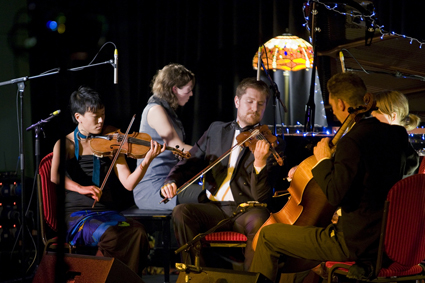
Sunwrae String Quintet
photo courtesy of the artists
Sunwrae String Quintet
THERE WAS THE SMELL OF PEPPER CHAI AND DAMP JACKETS AT COLBOURNE AVENUE FOR SUNWRAE’S SYDNEY LEG OF THE EAVESDROPPING TOUR. COSY SOFAS AND RED WINE MADE US AT HOME WHILE ICONIC WONKY LAMPS LIT THE PLAYERS OF SUNWRAE QUINTET. USUALLY A NINE-PIECE, SUNWRAE ENSEMBLE IS A PREMIER NU-CHAMBER GROUP THAT BLENDS MELODIC PHRASES AND INTERWEAVING RHYTHMS, CREATING FLOWING MUSIC WITH FAR REACHING APPEAL. ARTISTIC DIRECTOR AND TRIPLE-THREAT PIANIST, PERCUSSIONIST AND COMPOSER RAE HOWELL LEADS THE GROUP FROM THE PIANO WITH PASSION.
Howell’s compositions are explorations of texture, where melodies arise from group-created shapes. Even when a solo tune is clear it’s the harmony that’s in focus. Howell’s music is often described as cinematic and is charged with emotion and potential for imagery. Her sound flaunts a complex understanding of classical music but is delivered with the natural simplicity of popular music. If her lilting ostinati don’t hypnotise you at first, her engrossed head bobbings will.
Minus an alto flute, vibraphone, harp, double bass and percussion, Sunwrae Quintet was destined for reduced sound, but the Sydney performance suffered from other factors. Playing their guts out, the musicians’ energy was greater than the sound they impelled. The great little venue in Glebe did not do any acoustic favours for the non-amplified group. Fuzzy, directionless sound forced intimacy as the slouchy-couched audience leaned in to hear, but left a strange feeling of communal deafness. Is it possible for a room to suck so much sound away?
The most characterful piece of the night, “Mmm, Good Question,” let Sunwrae fool around with vaudevillian snippets lifted from every cliché you’ve known and loved. Creepy clown, scratches from the grave, a gate that needs oiling, those screeching trills near the bridge of a violin that elicit a physical reaction: your skin crawls with the memory of that pesky kid from school who clawed the chalkboard. The quintet’s answer to the fairground zombie vampire apocalypse craze is yet a spacious music that makes a listener hear the sounds of the room. It breeds hyper-awareness as it slinks into a warped corpse-bride’s tango, then deflates as the strings put on the shifty eyes—left right, left right—removing any doubt that this music is comedy, before returning to the fair.
Two world premieres were received well but didn’t jump out of the program. The best performances were of tried and tested hits like “Autumn Never Fall,” where Sculthorpe seagulls flew by (a technique on cello popularised by Peter Sculthorpe where harmonics in close succession sound like flying sea rats). We were given further license to imagine with “Far Away Castle” (soundtrack to a children’s film) as its Chinese-fantasy-esque love theme emerged. Rachel Kim on first violin realised key themes while second violinist Zac Johnston danced in his chair. The stoic bass section, viola player Phoebe Green and cellist Tim Blake, gave nuanced performances that made up for occasional blips in the upper parts. The most exciting offering of the evening was “The Machine,” a favourite piece that might have had a love affair with a Tenori-On, or this digital version at http://mandaflewaway.tumblr.com/post/2057242738
Chugging, cogs chipping, driving pistons, “The Machine” grinds away. Spurts of sound are left behind as the music reproduces conditions for further outputs. This machine seems to borrow its climaxes from the choral works of Stanford or Herbert Howells, only to disjoint them, cut them short, move on. Containing many complete musical ideas, like a mash up of distinct quotations, the work’s cogs really shouldn’t engage with such cohesion, but do. “The Machine” manufactures landscapes for the listener, ones that pan in and out, at stages zooming so far out of the wheeled workings that the contraption’s business is made invisible and insignificant with distance. This piece has been part of Sunwrae’s repertoire for a few years and has conjured similar images for others including Tom Fraser, whose animation of turning wheels, dripping taps and racing scenery now illustrates the track’s video clip.
Howell’s relaxed between-song chat heightened the family vibe in the crowd, but reinforced the sense that this gig in the tour was like a dress rehearsal: that show where the bumps are ironed out before the more important overseas appearances. On their way to Ho Chi Minh City Opera House, we forgave them. The crowd loved the performance and applauded for an encore that the freshly formed quintet could not provide, saying apologetically, “We don’t have anything else prepared.” They’d given us everything they had. Finishing off with a repeat of “Rainlessness” written by Howell during a cold stay in Canada, they created a new moment from material we’d already heard. It’s perhaps this quality of ‘being’ that makes Sunwrae’s performances so memorable: they play each piece as though for the first impassioned time.
Sunwrae String Quintet, Eavesdropping Tour, Colbourne Ave, Glebe, Sydney, May 5,www.sunwrae.com
RealTime issue #103 June-July 2011 pg. 43
© Felicity Clark; for permission to reproduce apply to realtime@realtimearts.net
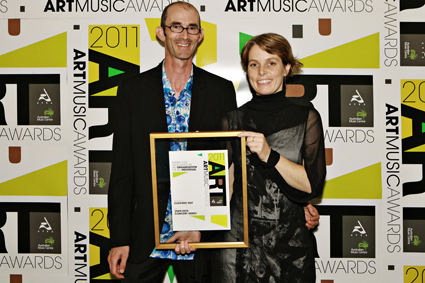
Erik Griswold, Vanessa Tomlinson, Clocked Out
photo Prue Upton
Erik Griswold, Vanessa Tomlinson, Clocked Out
THE AUSTRALASIAN PERFORMING RIGHT ASSOCIATION (APRA) AND THE AUSTRALIAN MUSIC CENTRE (AMC) HAVE ANNOUNCED THE 2011 WINNERS OF THE INAUGURAL ART MUSIC AWARDS IN THE GENRES OF CONTEMPORARY ART MUSIC, JAZZ AND EXPERIMENTAL MUSIC IN A SLEEKLY ENTERTAINING CEREMONY AT SYDNEY THEATRE DROLLY HOSTED BY JULIAN MORROW, PEPPERED WITH SOME FINE LIVE PERFORMANCES AND FRAMED BY DIGITAL IMAGERY THAT KEPT US IN TOUCH WITH CATEGORIES AND PRECISELY WHO WAS WHO.
It was gratifying for the RealTime Editors to see Queensland’s Clocked Out (Erik Griswold, Vanessa Tomlinson) and Western Australia’s Cat Hope honoured with awards. These are artists whose work we have long admired and featured.
Clocked Out won the Award for Excellence by an Organisation or Individual for their annual programs, in this case their 2009-2010 program which premiered 15 new compositions, included three international tours, plus community projects in regional Australia. They also won the Queensland State Award. The inaugural Award for Excellence in Experimental Music was taken out by Cat Hope artistic director of Decibel which in 2009-10 undertook 11 commissions for new Australian work, 10 performances, toured interstate and had four live broadcasts for ABC Radio. Hope also received the West Australian State Award for Decibel in the category of Excellence in Experimental Music
The Performance of the Year Award went to soprano Jane Sheldon and the ever inventive Ensemble Offspring conducted by Roland Peelman for their collaborative project, The Origin Cycle. Sydney-based composer Paul Stanhope won Instrumental Work of the Year for his String Quartet No 2 and Vocal/Choral Work of the Year for Deserts of Exile from his Exile Lamentations choral cycle performed by the Choir of Trinity College. Orchestral Work of the Year was awarded to James Ledger’s Chronicles performed by the West Australian Symphony Orchestra conducted by Paul Daniel.
The WA winning streak was confirmed by Johannes Luebbers who received the award for Jazz Work of the Year for his big band work Ashes to Ashes, performed by the Johannes Luebbers Dectet.
Other award winners included Michael Kieran Harvey who received the Tasmanian State Award for his homage to Frank Zappa, 48 Fugues for Frank, and recorder virtuoso Genevieve Lacey who took out the Victorian State Award for Performance of the Year for her multimedia creation, En Masse.
The Award for Distinguished Services to Australian Music was shared between Patrick Thomas and John Hopkins. Thomas recalled a long career, commencing as 3rd flute at 14 years of age, looked back fondly to the Modern Music forum he established in Brisbane with Tony Gould and going on to conduct some 110 works by Australian composers, quipping “nor just first performances!” As a young concert-goer in Adelaide. I was always impressed with Thomas’ commitment and the calibre of his conducting. Unfortunately, he was a casualty of the reforms of the mid-1980s when the ABC was divested of its orchestras. Some compensation comes with the imminent release of an eight-CD collection of his performances as conductor. John Hopkins was also appreciative of the best years of the ABC in the era of conductors Joseph Post and Bernard Heinze (whom I recall gently lecturing a restive Adelaide Symphony Orchestra audience about the meaning and sounds of Peter Sculthorpe’s Sun Music). Thomas remembered the pleasure of conducting the music of Sculthorpe, Penberthy, Brumby and others, while Hopkins treasured the particular memory of Richard Meale conducting Nigel Butterley’s Laudes and Butterley conducting Meale’s Floridas in an exciting time for Australian music. As the Art Music Awards indicate, now is another such time.
APRA and AMC, Art Music Awards, Sydney Theatre, Walsh Bay, May 3
For the full list of awards see www.australianmusiccentre.com.au/awards/
RealTime issue #103 June-July 2011 pg. 43
© Keith Gallasch; for permission to reproduce apply to realtime@realtimearts.net
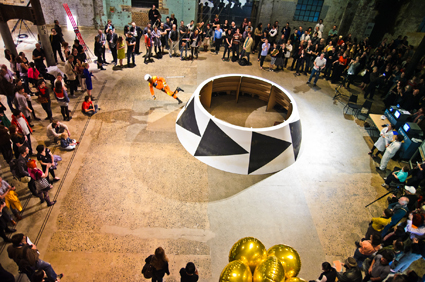
Adam Norton, Mars Gravity Simulator, 2011, Awfully Wonderful
photo Lucy Parakhina
Adam Norton, Mars Gravity Simulator, 2011, Awfully Wonderful
CONTEMPORARY ART OFTEN APPEARS SCIENCE-FICTIONAL, AS IT EMPLOYS THE LATEST VISUAL TECHNOLOGIES AND ADAPTS SCIENTIFIC IDEAS FOR ITS OWN ENDS. EXHIBITIONS OF SCIENCE FICTION (SF) IN ART ARE HOWEVER A MOSTLY RECENT PHENOMENON. IN THE RICH ANTHOLOGY OF WRITING THAT MAKES UP THE CATALOGUE FOR AWFULLY WONDERFUL, SWISS CURATOR PATRICK GYGER LISTS RECENT SHOWS ON SF AT THE INSTITUTE OF CONTEMPORARY ARTS (ICA) IN LONDON, THE POMPIDOU IN PARIS AND ELSEWHERE. YET THESE EXHIBITIONS FALL SHORT OF BEING ABOUT SF, INSTEAD HAVING SF-INSPIRED THEMES. THE ICA USES ALIENS AS A METAPHOR FOR MULTICULTURALISM (ALIEN NATION, 2006), WHILE THE POMPIDOU JOINS THE RAFT OF CONTEMPORARY SHOWS ABOUT UTOPIA (LA NUAGE MAGELLAN, 2007).
The Awfully Wonderful exhibition is more explicit as it tackles the relationship between SF and contemporary art. In doing so, it makes the striking conclusion that new technologies and cutting edge sciences in fact have little to do with the SF genre. Curators Bec Dean and Lizzie Muller instead populate Performance Space with low-tech works that speculate on such archaisms as travel through time and outer space. Two architectural dioramas by David Lawrey and Jaki Middleton recall dusty museum exhibits while portending an apocalyptic future, their miniature city overtaken by disaster. Sam Smith’s Time Travel (2009) also hinges upon the past’s future, alluding to a philosophy of travelling through time while compelling our gaze with its scenes of cinema and television. Deborah Kelly’s collages of oceanic creatures and 1960s pornography also appear out of time, their tangles of limbs and tentacles recalling the erotics of surrealism. The paradoxes of these old media works in wood, video and paper build a picture of SF as the retro-futurism of today.
This appears to be bad news for SF—that it is no longer the cutting edge genre of technology and prediction in a world that has come to look like the future itself. Like contemporary art, the world is science-fictional, leaving the actual genre stranded in a time out of time. Video works by Ian Haig and Philip Brophy push this retroactive logic to the extreme by making pastiches out of SF images, evoking clichés of gender war and alien visitation. A near naked Hayden Fowler also plunges us into a muddle of time, as he inhabits his installation of futuristic domes and grass in the CarriageWorks foyer only to evoke images of life in prehistory. Fowler imagines himself to have returned humanity to nature but this is a cleanly engineered nature with lawn and laboratory rats. There is something perversely troubling about a live performer in a set that might have been dropped from a cheap 1970s SF film. Such a meticulous realisation of the most lurid SF scenography is both compelling and discomforting in our technological age, which has long rendered such pastoral visions the stuff of fantasy.
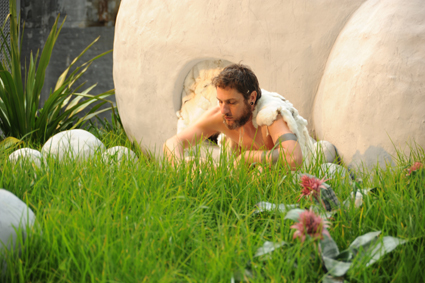
Hayden Fowler, Anthropocene, 2011, Awfully Wonderful
photo Garth Knight
Hayden Fowler, Anthropocene, 2011, Awfully Wonderful
If Fowler is a visionary, ready to move into the greater laboratory of a bioengineered world, Adam Norton is ready to move to Mars. By hanging a body harness above a room-sized running track (also in the vast CarriageWorks’ foyer), the space-suited Norton simulates the planet’s gravity, as well as NASA’s own training regimes. The sight of Norton bouncing around his track is spectacular, his sincerity and enthusiasm backed by the authenticity of his research. Norton’s work is among several in the show that shape-shift from art installation to actual science. Haines and Hinterding’s pair of cloudbusters—orgone energy machines after the plans of Wilhelm Reich—also stand at the slipping point between creative fabrication and scientific actuality. It is only a shame that there are no demonstrations of their potential to seed clouds, whip up a storm or even a tornado. What greater legacy for an exhibition like this than a great whirly-whirly lifting the tin from Darlington terraces, art’s possibilities spinning out of control in a science-fictional world?
A collection of obsolete technologies from the Powerhouse Museum also simulates the simultaneity of science and art. Safely encased in perspex, these technological artefacts are displayed in low light as if they might suddenly collapse back into their own times. One is a circumferentor, a low cost surveying instrument from the 1800s decorated with vegetal designs, appearing as if from some alternative steampunk timeline. Another, a 1K microcomputer from 1980, the Sinclair ZX80, has all the appearance of a dinosaur with its garishly large keys. These technological relics bring a scientistic sincerity to the show, casting a serious light on the allusions to arcane SF that might otherwise be comic.
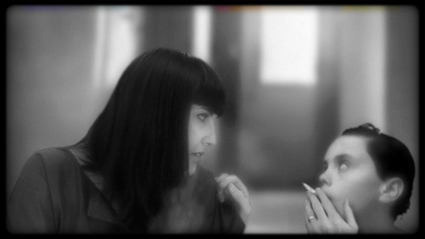
Frame Drag 1988 / 2009 / 2024, Ms&Mr
courtesy the artists
Frame Drag 1988 / 2009 / 2024, Ms&Mr
These devices are in neat contrast to one of the more metaphysical works installed beside them. A magnificent pair of video portraits by Ms&Mr alludes to some ambient, transgendered future. Two simple loops present enigmatic figures that seem to be lost in some nebulous eternity. On one screen a man’s arm disappears into a forest of stars, while on the other the artists, in footage from different times in their lives, are smoothly juxtaposed so they appear to share smoke from a cigarette. She inhales his exhale and exhales in turn in a triangulation of sensual, ambient whiteness.
The feeling that Awfully Wonderful occupies a fold in time, as it plays upon the paradoxes of an art about the future that is nonetheless a future imagined by the past, tells us as much about contemporary art as science fiction. In rushing to capture the present, attracted by this or that technological or cognitive widget, contemporary art often wilfully forgets its own past. This show casts a more complex light upon the meaning of the contemporary, insofar as its technological and political conditions have been constructed by past imaginings. If contemporary art is the dominant genre of a global, networked present, Awfully Wonderful gestures to the romanticism that produced this contemporaneity, the fantasies that brought it into being.
The success of the show also lies in the absence of the kind of grandiose work that makes contemporary art so emasculated. Instead, the artists here work in the spirit of what SF scholars call the tinkerer, the handyman who fiddles with the details of lamps and lunch trays in a quest for everyday happiness. This is in contrast to the grandeur of new media and its ambitions to rewrite the history of art, and to the new genres of technological art, such as bio-art and nano-art that are so closely tied to the politics of their industries.
Instead, Awfully Wonderful is driven by a pragmatic and retro utopianism. Simon Yates’ hilarious Metropolis Robot is symptomatic of humble hope, as he creates a walking version of Fritz Lang’s cinema icon. In a single stroke Yates solves one of the most expensive problems in robotics, this being the bionics of walking, as he suspends the robot with cheap helium balloons and propels its legs with two AA batteries. Such is the genius of the tinkerer, who shows us that the future, or even the present, is not as complex or difficult as we might have imagined it to be.
Awfully Wonderful: Science Fiction in Contemporary Art, curators Bec Dean and Lizzie Muller, Performance Space, Sydney, April 15-May 14; www.performancespace.com.au
RealTime issue #103 June-July 2011 pg. 44
© Darren Jorgensen; for permission to reproduce apply to realtime@realtimearts.net
{$slideshow} IN HIS VIDEO WORK FIVE PRODUCTION COMPANY LOGOS IN 3D, EMILE ZILE STANDS AROUND LOOKING SLIGHTLY BORED IN JEANS AND A HOODIE IN AN EMPTY SPACE THAT COULD BE A GALLERY, EXCEPT THAT IT’S LIT BY OFFICE-STYLE SETS OF CEILING FLUOROS. INCONGRUOUSLY, WE HEAR A DESCENDING WALL OF SOUND MIMICKING PERFECTLY THE IMPRESSIVE ZOOMS AND SWEEPS OF CINEMA COMPANY PROMOS—AND FROM HIP HEIGHT WE WATCH ZILE GIVE US THE ACCOMPANYING ‘3D GRAPHICS’ IN A SERIES OF SMALL-FRAME HAND MOVEMENTS. THE GESTURES ARE BOTH RIDICULOUS AND ORDINARY. IN A DIFFERENT CONTEXT THEY MIGHT READ AS EXPLANATORY OR, ODDLY, AS A MIX OF ‘SHOWING’ AND ‘GIVING.’
When the ‘music’ zooms in, out, up or down, so do the hands. One by one, Zile works his way through five short aural ‘signature’ tracks over two and a half minutes, never appearing to take any more interest in what his hands are doing than he might if he were at home watching a series of TV ads. It looks vacuous, but no less so than the brightly coloured starbursts and rotating logos of corporate motion graphics. Which I guess is, at least in part, the point.
Amsterdam and Melbourne-based Emile Zile’s work ranges from solo performances to VJ-ing, gallery installations and video. Five Production Company Logos in 3D fits into a stream of Zile’s thinking that concerns itself with “an ever-accelerating culture of image consumption and distribution.” A couple of (much) earlier works put the new work into context for me, one of them being 6pm Personality (1999). TV newsreaders’ heads are fairly crudely disjoined from their words, bobbing and mouthing in reversed black and white. Almost too simple, their de-contextualisation exposes the coded patterns to which our perception so easily adapts, highlighting gestures that otherwise lock unnoticed onto our media ‘receptors’ like dubious nutrient onto enzyme.
And then there is Larry Emdur’s Suit (2002 see RT57, and RT84). Zile is chosen as a contestant on The Price is Right. He comes-on-down, gliding and shuffling. He shrugs, waves his hands, twitches and finishes up on stage, generating a series of movements that range in possible interpretation from ‘right on’ to ‘wow’ and then well beyond meaning. Host Larry Emdur can’t talk, he can only meet gesture with gesture, synching into Zile’s dance with a set of his own random movements—his ‘receptors’ forced to instantly accept Zile’s ‘language’ by TV’s imperative to keep moving seamlessly. Both works illustrate a fascination with body movement transformed for media consumption.
Philip Brophy, in his catalogue essay for Five Production Company Logos in 3D, sees Emile Zile’s groin-level gesturing aptly as a ‘spoof’ on masturbatory corporate excess. It strikes me also as a kind of post-mass-media shadow-puppetry, almost as though Zile might be telling us a story around the campfire, his flickering hands casting the shape of mythical battles or god-heroes onto thin air. The banal human presence is complicated by the artist’s transformation of gesture into looped-back, empty artifice. Throughout the video the glimpses of his shoulders and face, the way he wanders back into start-position between ‘takes,’ suggest boredom. There’s also something of the Archibald Packer’s Prize about it, the appearance of a moment where the common man steps out and has his say—or has a lend of us.
At face value Emile Zile spoofs the smoke and mirrors of the corporate-logo-in-extremis, but in the end, of course, his movements depend as much on our ability to read signs as the logo itself does. What separates it from a dumb joke is perhaps—or of course—only the gallery. It’s like air guitar, or a kind of 21st century Rolf Harris painting—a whipped-up cliché on a wall, elevated in status by the perfect, synthesised pomposity of Adam Milburn’s spot-on soundtrack. Married to Zile’s movements, Milburn’s swooping synths no longer signal the magnificence of big business and CGI graphics. Instead the audio pans out sideways to encompass the ego of the artist, even as the artist himself stands around in scuffed shoes ineffectually waving his hands.
The human body can only be in ‘3D,’ can’t it? And yet it’s obvious that what comes out of the graphics studio is as human—the product of clicks and drags—as a pair of hands, thumbs hooked together casting a bat shadow on the wall behind it. In the 2.5 minutes it takes for Zile’s Five Production Company Logos in 3D to loop around and begin again, his hands approach, recede, make clunky little chops in the air, respond to 60-Minutes-like ticking and Val Morgan-like aural morphings and take a rest at the end with briefly folded arms. In the CGI studio there’s a keystroke to ‘cut’ that monumental ending. Emile Zile simply clicks his fingers.
Five Production Company Logos in 3D, (single-channel video, 2010) artist Emile Zile, audio Adam Milburn, Dianne Tanzer Gallery, Melbourne April 2–23
RealTime issue #103 June-July 2011 pg. 46
© Urszula Dawkins; for permission to reproduce apply to realtime@realtimearts.net
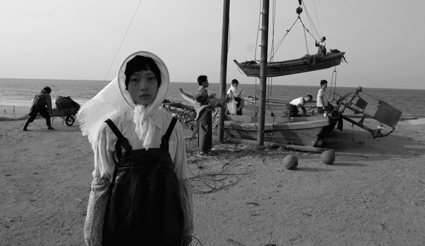
Seven Intellectuals in Bamboo Forest–Part IV, 2006, Yang Fudong
courtesy the artist, ShanghART Gallery, Shanghai and Marian Goodman Gallery, New York and Paris
Seven Intellectuals in Bamboo Forest–Part IV, 2006, Yang Fudong
STEPPING FROM PADDINGTON’S GOODHOPE STREET INTO YANG FUDONG’S NO SNOW ON THE BROKEN BRIDGE (2006) AT THE SHERMAN CONTEMPORARY ART FOUNDATION, YOU FIND YOURSELF PLUNGED INTO DARKNESS. EIGHT SILVER SCREENS FLICKER TO YOUR RIGHT, ASSISTING YOUR EYES TO ADJUST, WHILE CLUMPS OF BEANBAGS TAKE SHAPE SLOWLY IN THE SHADOWS TO YOUR LEFT. A FINE THREAD OF MUSIC BECOMES DISCERNIBLE—SMATTERINGS OF PIANO AND VIOLIN EMERGING FROM SOMEWHERE BEHIND THE SCREENS. YOU SINK INTO A SEAT AND ALLOW THE ARC OF BLACK AND WHITE IMAGES TO ENGULF YOU.
Your first thought on entering this work is where to place your attention. Each black and white image is gorgeous, yet none lasts more than a few languid seconds and the screens all compete for interest. For a moment your eye rests upon a woman in a silk cheongsam and fur stole, laughing as she crosses a bridge with her friend. Then you’re distracted by a man approaching in long, traditional Chinese robes, or another in a suit and bowler hat. Exquisite shots of plum blossoms and Chinese pavilions, of young lovers and girls in dapper drag, begin and are then replaced, until you relinquish expectations of narrative and give over to a dreamlike state.
Like much of Yang Fudong’s work, No Snow on the Broken Bridge draws on classical Chinese aesthetics, early 20th century fashion and the trope of the young romantic to create a feeling of disconnectedness from the world. Set amidst the scenery of Hangzhou’s famous West Lake, the film has a sense of both floating and ennui, its cast of preened young characters indolent to the point of camp. There are moments when people disappear behind boulders, or lie in the sun with great portent, feeling almost like Picnic at Hanging Rock: young people in their finery experiencing the power of nature and beauty. Running at 11 minutes, with no real beginning or end, the installation is a playful mosaic—an impressionistic dreamscape pregnant with unexplained mystery and meaning.
Downstairs in the gallery’s annexe, Yang’s film Seven Intellectuals in Bamboo Forest (2003-07) continues these themes and visual references—again, in Yang’s signature monochromatic style. An epic work, it consists of five parts, each running between about 30 to 70 minutes and totalling almost five hours in all. The film is loosely based on a story of seven Taoist sages from the Wei Dynasty (220-265BC) who rejected public life in favour of one of seclusion in the forest. Choosing not to belong to the bureaucratic elite, they devoted their lives instead to conversation, poetry and music and the pleasures of food and wine.
As with Broken Bridge, Seven Intellectuals evokes a sensation of drifting, its young and debonair protagonists seemingly lost in their search for meaning. The film also samples imagery from traditional Chinese poetry and painting, mixing this with fashions from 1930s Shanghai to create an urbane and otherworldly feel. Despite this ambience, however, Seven Intellectuals is set in current times, its characters contemporary in their existential dilemmas, their environment a half-demolished, half-built China. Moving from the famous scenery of Huangshan Mountain (the ‘sea of clouds’) to life in a modern apartment, to a farm, to an island and back to the rubble of a modern Chinese city, the film’s five parts present aspects of contemporary life framed by an aesthete’s imagination.
There is something of De Sica’s The Garden of the Finzi-Continis (1970) in Seven Intellectuals. These suave and privileged young people are seductive, but cold, their lassitude faintly disconcerting. The film’s melancholy is reminiscent too of Visconti’s Death in Venice and there are moments in the first part of Seven Intellectuals in particular, when youths languishing on rocks or staring off mountain tops echo the young Tadzio pointing to the sky. Yang is working within a number of cinema traditions and has cited both European and Chinese filmmakers as influences on his work.
It is perhaps the combination of these two cultures and their fascination for one another that makes Yang Fudong’s films so alluring, particularly for a Western audience—the plaid suits and mountain mists, the chinoiserie. It’s easy to linger under the spell of these installations, their strangeness providing just the right amount of intrigue (while their familiarity consoles). Yang has stated his attraction to the traditional aesthetic of yihui, or sensation, and this exhibition works on you in this way. Making few demands, these works lull you to a point where it becomes easier to surrender to their beauty than to try to piece together their meaning.
Yang Fudong, No Snow on the Broken Bridge, Seven Intellectuals in Bamboo Forest; Sherman Contemporary Art Foundation (SCAF), Sydney, March 18-June 4, www.sherman-scaf.org.au/exhibitions
RealTime issue #103 June-July 2011 pg. 46
© Christen Cornell; for permission to reproduce apply to realtime@realtimearts.net
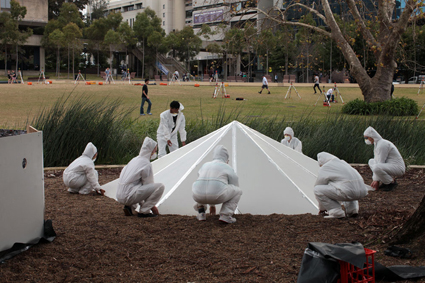
DISASTR Hotel, 2011, DV Rogers, The Right to the City
photo courtesy the artist
DISASTR Hotel, 2011, DV Rogers, The Right to the City
“SHE’S FOR SANDAL-WEARING, MUESLI-CHEWING, BIKE-RIDING PEDESTRIANS.” THIS WAS PAUL KEATING’S EXTRAORDINARILY ARROGANT DISMISSAL OF MAYOR CLOVER MOORE’S PRESENTATION TO NSW PARLIAMENT OF A PETITION WITH 11,000 NAMES PROTESTING THE CURRENT DESIGN PLANS FOR THE BARANGAROO URBAN WATERFRONT DEVELOPMENT, WHICH LED TO HIS REACTIONARY RESIGNATION FROM THE PROJECT.
Tucked within the more sedate enclave of Sydney University’s Architecture Department, far from the combative squabbling of ex and current politicians, the Tin Sheds Gallery in April hosted The Right To The City, a multifaceted exhibition, symposium and publishing project that, while not directly concerned with this particular urban conflict, echoed its tensions by seeking open-ended responses to the spatial politics of the city.
Here, interdisciplinary artists cultivated the gallery space and beyond with sculptural objects, installations, video, photomedia and speculative works that circumvented the top down approach to urban planning, testing what might emerge in the interstices of public, creative and professional dialogue.
This was by no means unfamiliar territory for co-curator Zanny Begg, who two years earlier helped create an impressive exhibition for Performance Space, There Goes the Neighbourhood, which explored the regeneration of Redfern (RT92, p52). At Tin Sheds, where she is Director, Begg worked in tandem with University of Sydney Senior Lecturer Lee Stickells to present an exhibition more general in reach, taking as its starting point a 2008 article by British geographer David Harvey, “The Right to the City,” although his are concerns that have been percolating for some time. They are questions of access, whether we build for people or for profit, how public and disused space might be used more creatively and what power, if any, citizens have to influence the development of the city. Despite the timely and prescient nature of these concerns Sydney is notoriously a city driven by consumerism, which means that urban activism is often met with apathy. Yet the continuities between works presented in this exhibition reveal how, as life increasingly falls into an earn/buy cycle, certain symbols that resonate as alternatives are at least gaining greater visibility.
Among the most prevalent is the communal garden. As an embodiment of sustainability, collectivity and self-reliance it’s understandable that it figured in a number of works presented. The most striking treatment was arguably a multi-channel video installation by the France-based architects Constantin Petcou and Doina Petrescu, At the Ground Level of the City (2001-2005). This was an unconventional account of their ECObox project, a series of nomadic self-managed community gardens installed in urban wasteland sites in the suburbs of Northern Paris. Drawing upon 99 hours of archive footage of the gardens gathered over five years using a “participative camera” that passed through multiple hands to record everyday life at the sites, a dynamic and non-linear documentary approach successfully conveyed the fluid and evolving nature of these reclaimed spaces. Played in fast succession and spliced across seven screens, the footage was set to a soundtrack mixing industrial noise, world music and snippets of conversation, injecting vitality into the ‘quotidian’ while avoiding romanticism in the subtle acknowledgment of the inevitable development of the sites.
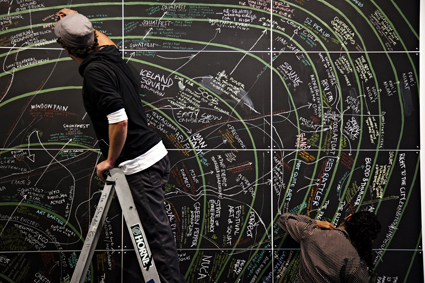
SquatSpace Mapping Project, The Right to the City
photo Zanny Begg
SquatSpace Mapping Project, The Right to the City
In a nearby corner, Sydney’s SquatSpace responded to the challenge of recording the collective’s transient history by using chalk to plot their 10 year legacy of urban activism on panels of blackboards in an ebbing and flowing ephemeral timeline, Network Map (2011). The sprawling and indefinite history was complemented by a short documentary film by Justin Hewitson, Squat the Lot (2000-2003), which recounted the turbulent period when artists occupying vacant council-owned buildings on Broadway were evicted prior to the Sydney Olympics. The video was perhaps the most outspoken work in the gallery, as others appeared more concerned with subtler, less anarchic modifications of urban space. Chicago’s Temporary Services surveyed with a forensic eye milk crates refashioned into basketball hoops and roadside memorials in their series of photographs, Public Phenomena (2008-2010), while urban redevelopment took a lo-fi turn in Milkcrate Urbanism’s The North Eveleigh Propositional (2011). After a mobile feedback box was dispatched to various locations around Redfern inviting alternative development proposals for the former railyards site, the feedback was incorporated into a newspaper style publication and pinned to the wall although, with only three suggestions on display, this particular speculative project felt a little incomplete.
When the force of nature unexpectedly asserts itself, the task of remaking the city becomes a more urgent dilemma. Hunkered down in an outdoor refuge campsite a short walk from the gallery, DV Rogers presented the 14-day endurance performance installation DISASTR Hotel (2011), which saw the artist build two hexayurt shelters following an open source design by Vinay Gupta and then invite visitors to stay overnight to judge the efficacy of the shelters and to consider their own preparedness for a disastrous event. Some Ballardian style signage spelling out DISASTR in large letters studded with brightly coloured light bulbs created a performative setting, however this was not a work of science fiction. On the contrary, Rogers was concerned with enacting “a symbolic field test,” demonstrating how DIY open hardware structures already exist as viable transitional responses that could be set up in present day disaster zones. The question is, what is holding us back from implementing them?
With a tagline citing Buckminster Fuller’s provocation “we are called on to be the architects of the future, not its victims,” the exhibition’s earnestness was counterbalanced with some playful, tongue-in-cheek works. The Holmes stereoscopic viewer received an anthropological twist in Tessa Zettel and Karl Khoe’s primitive masks jerry-rigged with plastic ephemera and clapped-out gauges. Another collaborative duo, Claire Healy and Sean Cordeiro, accosted visitors with Sound Barrier 2011, a giant wooden catapult sporting a slingshot stockpiled with fluorescent orange earplugs. Flung target practice style at a blank white board, the spray of compact foam bullets on the wall resembled a minimalist colour field painting meets urban-noise-pollution-dart-board, a witty indictment of how the gentrification process demands not only land but also sensory homogenisation.
Stepping outside the gallery and into the courtyard, where students and lecturers were breaking between classes, reinforced how critical the site was to the effectiveness of this exhibition. Some of the less polished, work-in-progress installations might not have withstood the tougher aesthetic scrutiny of an austere white cube space. But in an environment where art, design and education naturally cross-fertilise, such works became key components in what was essentially an art forum. While we may lack a centralised method to surmount the circle of government, developers and purchasers who largely determine the evolution of our cities, by giving expression to the humbler gestures and desires of the everyday, this exhibition highlighted the alternatives that can burst through the cracks when necessity, inspiration or sheer dogged perseverance take hold.
The Right to the City, curators Zanny Begg, Lee Stickells, artists Claire Healy & Sean Cordeiro, atelier d’architecture autogeree, DV Rogers, Temporary Services, SquatSpace, Milkcrate Urbanism [Sophie Warren, Jonathan Mosley, Marjetica Potrc, Tessa Zettel, Karl Khoe], Bababa International, Tin Sheds Gallery, University of Sydney, April 8-30
RealTime issue #103 June-July 2011 pg. 47
© Ella Mudie; for permission to reproduce apply to realtime@realtimearts.net
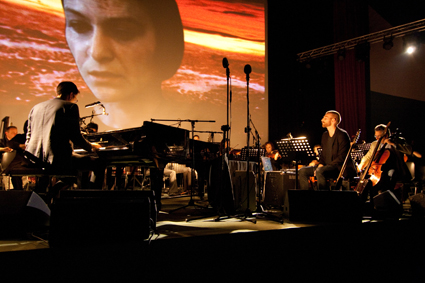
Daníel Bjarnason, Ben Frost, Sinfonietta Cracovia, “We don’t need other worlds. We need mirrors.” Music for Solaris; Unsound Krakow
photo Anna Spysz
Daníel Bjarnason, Ben Frost, Sinfonietta Cracovia, “We don’t need other worlds. We need mirrors.” Music for Solaris; Unsound Krakow
COMPOSER AND MUSICIAN BEN FROST’S BOLD DECISION TO RELOCATE FROM MELBOURNE TO ICELAND IN 2005 SEEMS TO HAVE PAID OFF. IN 2006 HE TEAMED UP WITH ICELANDIC PRODUCER VALGEIR SIGURÕSSON AND US COMPOSER NICO MUHLY TO FORM THE BEDROOM COMMUNITY LABEL PRODUCING TO MUCH ACCLAIM THEIR OWN RELEASES AND THOSE OF OTHER GENUINELY INTRIGUING ARTISTS.
In between touring schedules around Europe’s key music festivals Frost has written sound scores for the Icelandic Dance Company and the UK’s Random Dance as well as Chunky Move’s Mortal Engine. In 2011 Frost is the Rolex Music Protégé under the mentorship of Brian Eno. Coincidentally he has been collaborating with Icelandic composer Daníel Bjarnason, the Sinfonietta Cracovia and Eno on a commission from the Unsound Festival to re-interpret the soundtrack of Andrei Tarkovsky’s mesmerising epic Solaris (1972).
messing with a masterpiece
Frost is happy to admit that he came up with the idea behind Music for Solaris because of his dissatisfaction with Eduard Artemyev’s sound score for the original film. “I don’t dislike the music, I think it’s really beautiful, but it’s a science fiction score. It’s music that’s made to [give you] this feeling that you are in outer space, which in my view is not at all what the actual story is about. The space setting is merely a vehicle to get across a much bigger, more human concept—something that’s much more about inner space.”
Frost feels that Stanislav Lem, author of the novel Solaris, was not completely aware of the humanistic depths of his book, and that it was Tarkovsky’s interpretation that revealed these aspects. He says, “I think that [Tarkovsky] took it to a far more spiritual place. It’s become evident that Lem was pretty dissatisfied with the Tarkovsky version.” It is this element of interpretation or misinterpretation that he feels is the key to his project. “One person can take something from an idea that the person who [instigated it] didn’t actually see themselves and from that you can create all these variations on a theme.”
It’s a deft conceit that frees Frost somewhat from criticism for tinkering with Tarkovsky’s masterpiece. I admire Artemyev’s score for maintaining and heightening the psychological tension while not employing ‘dramatic’ filmic techniques. If Frost’s creation makes it to Australia I’m looking forward to comparing the relationship between the original and its re-interpretation.
finding the language
Frost had been waiting for an opportunity to work with Daníel Bjarnason since they first met in 2002. Bjarnason is a classically trained composer, while Frost has emerged more from the popular electronic end of the music spectrum. Frost describes Bjarnason’s music: “He has a very hardened, quite unromantic aspect to his work that I really appreciate. The thing that I love about his music is the visceral brutality of it. He really stabs you with things. It becomes quite oppressive [but] really dynamic as well.” It has taken until now for the pair to discover a shared language to enable a meaningful collaboration.
The core of that shared language turned out to be improvisation with the basis of the final composition arising from sessions recorded while watching the film, with Bjarnason on heavily prepared piano and Frost on heavily prepared guitars. Frost describes the process: “We did this a few times. There were a lot of moments where we were just sitting in this room watching the film together, but every now and then we’d find things in it, find angles on it and go off into weird little slow jams, ending up with all this material [that] became the basis for the score.”
They then fed the audio files into a computer to generate MIDI data resulting “in all kinds of errors and misinterpretations of that material, which in turn created a whole new set of ideas that were wrong.” However the errors were what Frost was looking for: “I was really interested in the idea of translation and transformation through misinterpretation of information. For me, [this] is what Solaris is about—this idea of missing information. This woman [Hari, who is] being projected back to [Kris Kelvin] is essentially his memory of her. It’s not her in the true sense. So I really liked the idea of working musically that way.”
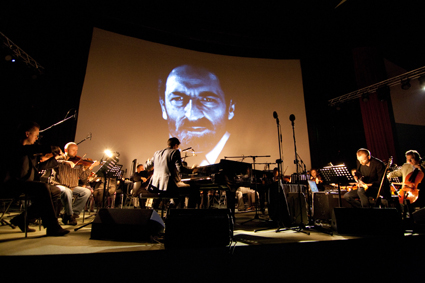
Daníel Bjarnason, Ben Frost, Sinfonietta Cracovia, “We don’t need other worlds. We need mirrors.” Music for Solaris; Unsound Krakow
establishing equilibrium
The process didn’t end there. Bjarnason and Frost then took this machine translation and retranslated it back into a form humans could play, scoring it for the 30-piece Sinfonietta Cracovia. The reasoning for this third level of interpretation was also inspired by the themes in Solaris. Frost explains, “It’s not so much about the presentation of this being in front of you…it’s what do you do with that information that becomes interesting? That’s the drama of that story: Kris trying to kill Hari three times, eventually giving up and finding some new level of existence through that. Some sort of spiritual equilibrium comes through that process.”
Interestingly, equilibrium has also been reached in the creative partnership of Frost and Bjarnason. Both artists are renowned for their epic compositions but Frost says that Music for Solaris has turned out to be “a very subtle piece of music…It’s almost like phase cancellation—you take two gigantic forces and put them together and you get something that’s not the sum of its parts but actually the negative space that’s created by the two of them.”
mirror images
After this process of re-interpretation, Frost found that he was not so interested in performing the score to Tarkovsky’s original film, so for the visual element of the 50-minute composition he turned to his Rolex mentor Brian Eno (the pair had actually been working on the project prior to the official commencement of the mentorship). Eno, in collaboration with Nick Robertson, chose to mirror the music-making process in some ways. Taking individual frames from the film, they used morphing software to create long, extruded transitions, thus creating new, machine-made material. Frost admits to being rather hands-off on the visual element: “I’ve always struggled with the relationship of video, particularly live video, to music. From my point of view the video is Brian’s thing. I’m really very happy [that there is this] other entity who is approaching the same ideas and material with the same intent but who is essentially oblivious to what I’m doing. We’ve performed it three times now and I don’t get to see the screen a lot, but it’s really quite remarkable how often things happen [together]—the synaesthetic synch of everything is really quite profound.”
“We don’t need other worlds. We need mirrors.” Music for Solaris premiered in October 2010 at the Unsound Festival Krakow, with subsequent performances at Unsound New York, The Donau Festival in Austria (of which Frost was also a curator) and most recently in the Reykjavik Festival. With each performance developing it further, Frost admits that the work is “divisive” and requires a lot of its audience due to its slow, quiet intensity.
emotional extremes
Extrapolating from the process of Music for Solaris and his previous albums Steel Wound (Room40), Theory of Machines and By The Throat (Bedroom Community) along with his longstanding ‘band name’ School of Emotional Engineering, I suggest to Frost that he appears preoccupied with the coldness of machines and the quest for deep emotion. He replies, “I think it’s a fascination with extremes: the fascination with dynamics. I want the best of both worlds. My work in the greater sense is increasingly about finding ways to create space between those two things. I think the void is far more interesting than the edges of it. I think that’s probably what drives a lot of these ideas. But then again I’m still working it out.” And, as Ben Frost has only just cleared his 20s, there’ll be plenty of time and opportunities for him to keep chipping away at it. The results so far have certainly been impressive.
Ben Frost has also composed the soundscore for Australian writer-director Julia Leigh’s film debut Sleeping Beauty, premiering at Cannes 2011 and screening at the 2011 Sydney Film Festival. www.sff.org.au/
“We don’t need other worlds. We need mirrors.” Music for Solaris, composers, performers Ben Frost, Daníel Bjarnason with Sinfonietta Cracovia, video Brian Eno, Nick Robertson; Unsound Festival Krakow, Poland, Oct 24, 2010; Unsound Festival New York, US, April 6; Donau Festival, Austria, April 29; Reykjavik Arts Festival, Iceland, June 4; www.bedroomcommunity.net/artists/ben_frost
RealTime issue #103 June-July 2011 pg.
© Gail Priest; for permission to reproduce apply to realtime@realtimearts.net
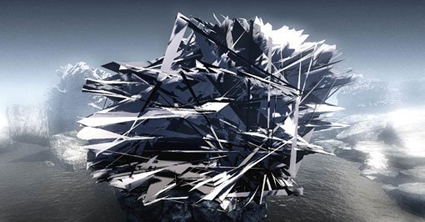
David Haines & Joyce Hinterding, The Outlands, 2011, production still; Anne Landa Award
courtesy of the artists and BREENSPACE
David Haines & Joyce Hinterding, The Outlands, 2011, production still; Anne Landa Award
haines & hinterding win anne landa award
The Art Gallery of New South Wales has announced that David Haines and Joyce Hinterding have won the $25,000 acquisitive Anne Landa Award for video and new media arts. Their large-scale screen work The outlands invites you to manipulate alone or together two twigs that trigger massive environmental changes to refracting, crystalline worlds light years from video game violence and scenic literalism. The award exhibition, Unguided tours, curated by Justin Paton (art critic, author and senior curator at Christchurch Art Gallery, New Zealand) is well worth a look with each of the works discretely housed. Other engaging works are by Rachel Khedoori (Australia/USA), Jae Hoon Lee (Korea/New Zealand), Arlo Mountford (Australia), Charlie Sofo (Australia) and Ian Burns (Australia/USA). Unguided tours: Anne Landa Award for video and new media arts 2011, Art Gallery of New South Wales, Sydney, to July 10
politics & the wild western at acmi
German artist Julian Rosefeldt’s American Night is a five-channel installation that “embraces the conventions of the Western film genre, deconstruct(ing) the myths surrounding the foundation of America and offer(ing) a scathing commentary on recent US foreign policy. Using settings that are commonly associated with Westerns—a communal campfire, the local saloon, a log cabin where a woman waits alone, a deserted main street and a lone rider travelling across a rugged landscape—American Night offers an alternative view of freedom, one where satire and the unexpected are never far away. Filmed in southern Spain and the Canary Islands on an original Sergio Leone film set, the title of the installation refers to the filmmaking technique of shooting ‘day-for-night’, also known as ‘American night’, a practice that was commonly employed during the making of Westerns. On one channel, a group of cowboys huddle around a campfire discussing freedom and their right to carry a gun, with their conversation consisting entirely of quotations lifted from pop-culture figures such as film director Jean-Luc Godard, rapper 50 Cent, and former actor and National Rifle Association President, Charlton Heston. On another channel, George Bush and Barack Obama appear as the characters in a puppet show being played out in a saloon” (ACMI press release).
Rosefeldt’s work has been shown at the Bienal de São Paolo, Athens Biennial, PS1 (New York), British Film Institute (London), Museo Reina Sofia (Madrid), Centre Pompidou (Paris), and the Hishhorn Museum and Sculpture Garden (Washington). In 2007, he was awarded the Filmstiftung NRW Award at the KunstFilmBiennale Köln for his film work, Lonely Planet, and won the Vattenfall Contemporary 2010, assigned in cooperation with the Berlinische Galerie, Berlin. He currently resides in Berlin. Julian Rosefeldt, American Night, Gallery 2, ACMI, Melbourne, June 21-July 31
tanja liedtke documentary at sydney film festival
Much admired at its premiere at the Adelaide Film Festival, Life in Movement, an 80-minute tribute to the late choreographer Tanja Liedtke by writer-director-producers Sophie Hyde and Bryan Mason, will be screened in competition at the 2011 Sydney Film Festival. The FOXTEL Australian Documentary Prize is open to factual films of any length with a cash prize of
$10,000 to be presented at SFF’s Closing Night ceremony June 19. Life in Movement traces the journey of Liedtke’s collaborators 18 months after her accidental death in 2007 as they internationally tour her award-winning productions with footage of performances and archival material of the artist at work. Life in Movement, Sydney Film Festival, June 18, 6.15pm, http://sff.org.au/
RealTime issue #103 June-July 2011 pg. 22
© RealTime ; for permission to reproduce apply to realtime@realtimearts.net
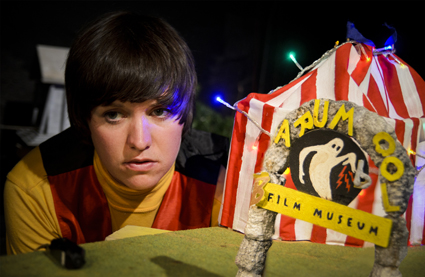
Natalie Randall, Rhubarb Rhubarb, Some Film Museums I Have Known
photo Lucy Parakhina
Natalie Randall, Rhubarb Rhubarb, Some Film Museums I Have Known
LIKE ALICE DOWN THE RABBIT HOLE, I HAVE TUMBLED DOWN THE STEPS OF GOODGOD DANCETERIA (ONE OF THE SMALL BARS NOW POPULATING SYDNEY SINCE THE CHANGE IN LICENSING LAWS) AND FOUND MYSELF IN AN ALTERNATE UNIVERSE OR, RATHER, A KIND OF ‘META-VERSE.’ YOU KNOW THE SORT—A WORLD WHERE THE BOOKS ARE ABOUT BOOKS, THE FILMS ABOUT FILM AND, IN THE CASE OF THE IMPERIAL PANDA FESTIVAL, THE PERFORMANCES ABOUT PERFORMANCE.
rhubarb rhubarb
Rhubarb Rhubarb’s Some Film Museums I Have Known is an extended riff on the relationship between technologies of magic (holograms, dioramas, toy trains, tiny cameras, live feeds, films etc) and the magic of storytelling (see a snippet on YouTube). It starts with a pitch for a film which is part adventure, part action, part fiction, part science fiction, part comedy, part tragedy, part romance and of course completely clichéd. Our heroine’s (Natalie Randall) obsession with film is such that not only is she pitching scripts but also a plan to establish a film museum at Barumpool. Hovering above her, and interjecting at will, are the holographic Lumiere brothers (Nick Coyle), who might be in her mind or an installation in the coming museum, but are probably both. The script (Eddie Sharp and Kenzie Larsen) risks collapsing under the weight of so many citations, but Will Mansfield’s imaginative set and Randall’s endearing performance ensure that it holds strong. There is much more to say about how screens and screen culture have changed stories and our ability to tell them, but by placing Some Film Museums I Have Known on stage (as opposed to say in an interactive installation), Rhubarb Rhubarb suggests that performance might be the most magical technology of all.
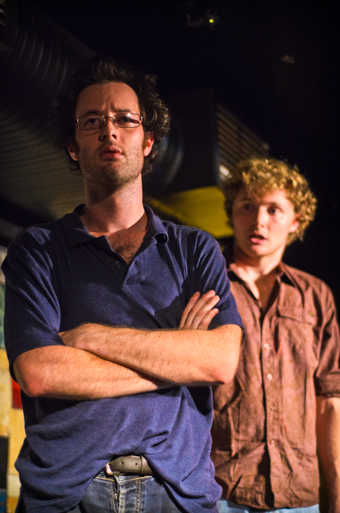
Gareth Davies and Charlie Garber, Masterclass
photo Lucy Parakhina
Gareth Davies and Charlie Garber, Masterclass
gareth davies, charlie garber
Masterclass is a show about the elusive art of acting. Born to a mother who worked in the chorus of Les Miserables, Gareth (Gareth Davies) has spent his entire life on stage. In the absence of any actual part in the musical, he has invented the character Charlie Garber (Charlie Garber), who becomes so life-like, scene-stealing and all-consuming that eventually he/they is/are fired. This sends Gareth into something of a funk and the rest of the show is about Charlie’s efforts to cheer, cajole and encourage him back onto the stage. This involves flashbacks, montages, mimed games of basketball and trips to the “dream forge.” In other words, the show is less a masterclass in acting and more a surreal mapping of an actor’s subconscious. In this sense, Masterclass reminds me of Spike Jonze’s Being John Malkovich, especially since the subterranean disco at GoodGod could easily pass for floor seven-and-a-half. There are few things more fun than watching good actors do bad acting, and Masterclass is eccentric, charming and clever.
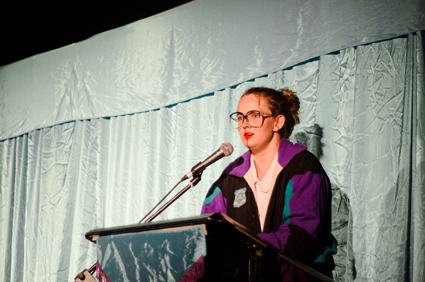
Zoe Coombs Marr, And That Was The Summer That Changed My Life
photo Lucy Parakhina
Zoe Coombs Marr, And That Was The Summer That Changed My Life
zoe coombs marr
Zoe Coombs Marr’s solo show And That Was The Summer That Changed My Life (see also RT98) references a musical, West Side Story, via the flute solo she played in a medley at her high school band camp. Wearing goofy glasses and a purple, green and black nylon track top, Coombs Marr grips the sides of the lectern, breathes heavily into the microphone and starts her presentation with laborious definitions from the dictionary. From here, she segues into a more general reminiscence of her only-slightly-misspent youth, in which she taped Xena, hoped to become a lesbian, wondered about kissing, worried about flute playing and distracted herself from her worry by thinking about kissing again. Towards the end of the show, Coombs Marr confesses that she has since found out there is no flute solo in West Side Story; her febrile teenage mind simply magnified the importance of playing the regular flute line. Does it matter? Probably not, she concludes—such moments of grace are rare and can’t be recreated. Or can they? In relating her stories of lust, loss and dinosaurs, Coombs Marr creates a show that is both cringe-worthy and cool.
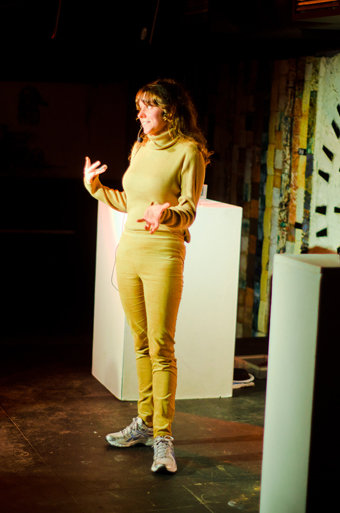
Claudia O’Doherty, What Is Soil Erosion?
photo Lucy Parakhina
Claudia O’Doherty, What Is Soil Erosion?
claudia o’doherty
If Marr’s is a show about a show that never was, then Claudia O’Doherty’s What Is Soil Erosion? is about a show that cannot be—primarily because television producers refuse to commission her 26-part series on the basis that it is “formless.” The same cannot be said of her beige pants, however, which are as tight as her top is loose. Dressed as a dorky scientist, O’Doherty proceeds to plough her way through every single episode, combining corny presentational poses, crappy graphics and a series of ridiculous surveys. Interspersed among the facts about soil erosion (yes, really), are asides about her cold sores and accidental abortion as well as some free shopping vouchers. It’s occasionally too long, but with some judicious editing, this will be a tight, punchy comedy.
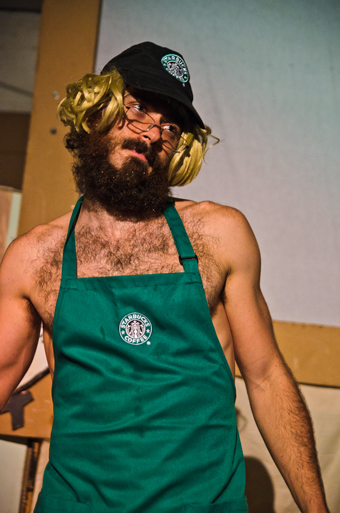
Dr Brown, Because
photo Lucy Parakhina
Dr Brown, Because
dr brown
During O’Doherty’s show I share a joke with the man standing beside me, who turns out to be the comedian Dr Brown. His show Because is hard to describe, but “silent stand-up” or “post-clown” comes close. In the opening sections, he brings an audience member onto the stage, gets a second member to help hoist the first onto their shoulders and then asks the other spectators to cheer. This, of course, requires another round of applause, so a third spectator is brought onto the stage to lift the second etc. In another section, a baby doll cries so he wraps it in a nappy, spraying the audience in the process, and carries it upstairs—we see nothing but hear a stomp and an ominous silence. In the final scene, he strips down to a Starbucks apron, performs an elaborate dance that involves manipulating the apron strings with his buttocks, and then sits down, lifts up his apron and pours water on his groin, shouting accusingly, “What do you want from me?!” He stalks up the stairs, leaving the audience thinking this the funniest and weirdest thing they’ve seen in ages.
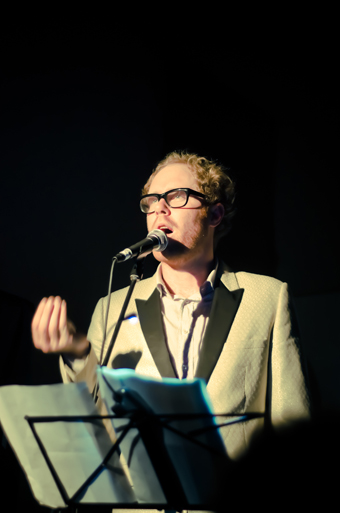
Miles O’Neil, Miles O’Neil’s World Around Us
photo Lucy Parakhina
Miles O’Neil, Miles O’Neil’s World Around Us
miles o’neil
The same venue also hosts Miles O’Neil’s World Around Us. O’Neil manages to conjure several worlds: with some found Super 8 footage, which is projected onto a bed sheet, he evokes the 1970s; with stories of discovering pornography with his friends, he calls to mind the 1980s; and with stories he’s borrowed from a taxi driver and a homeless man, among others, he manages to evoke our contemporary world. In between these found images and stories, he also plays a few songs and the combination makes for a simple, subtle and unassuming show.
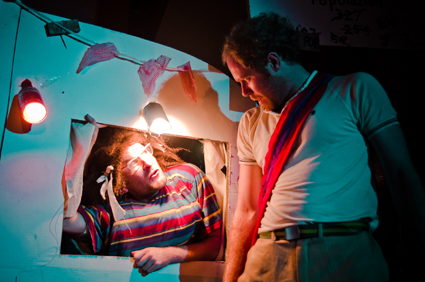
The Suitcase Royale, The Suitcase Royale’s Test Flight#1
photo Lucy Parakhina
The Suitcase Royale, The Suitcase Royale’s Test Flight#1
the suitcase royale
O’Neil also appears in The Suitcase Royale Test Flight#1, which is slightly less subtle, with its endless fart jokes and cross-dressing. Set in a town that is being attacked by zombats (zombie wombats), the show follows the travails of the last survivors as they pursue the creatures across the country, into caravan parks and eventually into a cave. It feels unfair to review something that is so obviously still in development, so suffice to say that Test Flight#1 is stylish (in the sense that it is recognisably Royale) but not especially substantial, and will need a few more sorties before it can soar.
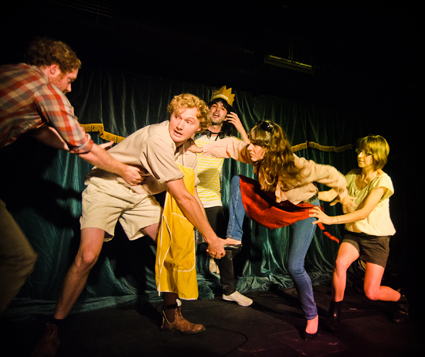
Pig Island, Cab Sav
photo Lucy Parakhina
Pig Island, Cab Sav
cab sav
The festival concludes with Cab Sav, a sort of contemporary performance variety night. Lara Thoms opens proceedings by standing centre-stage in a watermelon-coloured leotard; her arms flop and she occasionally bends at the waist. It’s not clear who or what she is until a motor starts and an inflatable man, of the kind you find in car yards and beer ads, bursts into life and across the stage. Matt Prest appears sans pants, which is all the more disturbing because he is wearing a very dorky, chunky knit cream sweater on top. Post (Coombs Marr, Mish Grigor and a man who is standing in for the very pregnant Natalie Rose) presents an excerpt from their forthcoming show (Who’s the Best?) alongside a segment from an old one (the bounceathon from Shamelessly Glitzy Work, RT98).
Brown Council stand shame-faced as an audience member is summoned to read out a terrible review of their performance A Comedy—slightly amusing but somewhat disingenuous since the show has, for the most part, had a very favourable reception (see RT98, RT101, RT101).
Then the members of Pig Island (Nick Coyle, Charlie Garber and Claudia O’Doherty), who have appeared separately throughout the festival, reunite for a short skit in which they have to save Imperial Panda—one last show about a show. Finally, Panther contrives an exercise whereby we move our chairs, stand in pairs and shout “my darling, I love you” at each other. Then the music cuts in and we find that we have cleared ourselves a dance floor.
This final night serves as a microcosm for the festival as a whole, in the sense that it looks deceptively casual but is in fact carefully produced. Though there’s no explicit festival theme, the work presented at Imperial Panda nevertheless shares a sensibility—relentlessly intertextual and often intermedial, but just as often determinedly lo-fi and DIY. There is also a resolute refusal to appear too serious about or within the work, despite the fact that it takes serious ambition to produce each show and the festival as a whole. Beyond this, what stays with me is the event’s infectious sense of fun. Perhaps it’s about nothing more and nothing less than the pleasures of performance or, more accurately, meta-performance.
Rhubarb Rhubarb, Some Film Museums I Have Known, performers Natalie Randall, Nick Coyle, writers Eddie Sharp, Kenzie Larsen with Natalie Randall, Nick Coyle, set design, holograms Will Mansfield, director Eddie Sharp, Old Fitzroy Theatre, Feb 18-March 12; Masterclass, writer-performers Gareth Davies, Charlie Garber, GoodGod Danceteria, March 4-12; And That Was The Summer That Changed My Life, writer-performer Zoe Coombs Marr, Redfern Town Hall, March 11-13; What Is Soil Erosion?, writer-performer Claudia O’Doherty, GoodGod Danceteria, March 17-19; Dr Brown, Because, writer-performer Philip Burgers, March 18-19; Miles O’Neil’s World Around Us, writer-performer Miles O’Neil, Helen Rose Schausberger Labortorium, March 15; The Suitcase Royale, The Suitcase Royale Test Flight #1, writer-performers Joseph O’Farrell, Miles O’Neil, Glen Walton, Helen Rose Schausberger Laboratorium, March 17-19; Imperial Panda Festival, Sydney, March 4-20; www.theimperialpanda.com
RealTime issue #102 April-May 2011 pg. web
© Caroline Wake; for permission to reproduce apply to realtime@realtimearts.net
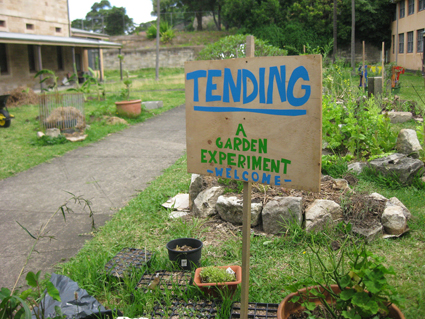
Tending: A Garden Experiment
photo courtesy of the artists
Tending: A Garden Experiment
ENCASED BY OLD SYDNEY SANDSTONE, COVERED IN ANCIENT SPONGY KIKUYU AND FASHIONED INTO QUARTERS BY QUAINT HEXAGONAL SHAPED CEMENT FOOTPATHS, A ONCE OVERLOOKED COURTYARD AT SYDNEY COLLEGE OF THE ARTS (SCA) HAS BEEN GIVEN SOME EXTRA TENDER LOVING OF LATE.
how does your garden grow?
Since mid-2010 Lucas Ihlein and Diego Bonetto’s project Tending has gently moved in and things have started to grow, both in the garden and online via their blog. Tending is a kind of artists’ garden experiment that engages with the biological, social, aesthetic and institutional fabric of a small, but not altogether insignificant, place.
The project was conceived in collaboration with Ross Gibson (Professor of Contemporary Arts, SCA) as a potential research focus for staff and students that would work towards materialising the garden theme of the college’s Callan Park location. For Gibson, the significance of the project lies in the way that gardens are “like comprehensible and pleasurable versions of the messy contemporary world—interactive, delicate, hard work, generative, social, beautiful, requiring constant care and co-operation.”
The initial plan, explains Ihlein, was to occupy a piece of land at the entrance of the college and have the garden function as a de facto go-between for the two worlds of “art school” and “rest of the world.” However, bureaucratic and institutional complexities made this difficult and Tending was made to adapt and cooperate with its current, more internal, location in the courtyard next to the SCA library. It is within this context that Ihlein and Bonetto have described Tending as a process that “intervenes, lightly.” Like a newly emergent eco-system Tending has fractured as much as it has fused through soft day to day interventions and co-operation(s)—that have gently pushed at what is possible artistically, institutionally, biologically and socially.
Located in Kirkbride Park, on the historic grounds of Callan Park, in the former-psychiatric-hospital-cum-contemporary-art-school, Tending’s relationship to place is decisive. Callan Park is an environment where the contemporary politics of arts education, mental health and urban land development are forever simmering below the surface of the rolling parklands and iconic architecture that fill 61 hectares of contested real estate on the shores of Sydney Harbour. Quietly, yet ever present, older Indigenous and settler histories embedded in the local area also linger.
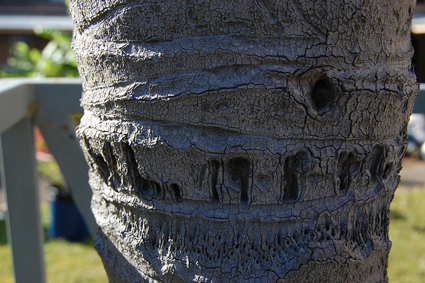
W.L. 19-8-44, Tending
photo courtesy of the artists
W.L. 19-8-44, Tending
The wider environment that SCA inhabits is dense, rich and also massively under explored. Having moved from Balmain into the Kirkbride Block in the early 1990s the college is still in the process of finding and settling into the full potential of its relationship to place. The fact that Ihlein and Bonetto describe their weekly digging and planting sojourns as a “mental health day” is illustrative of the delicate and subtle connections to place that have come into operation through this art project. Fragments of people’s lives—names and dates etched long ago into the trunks of over-looked palm trees—come to the fore through the process of Tending. On the blog the artists ask: “Who were W.L. and D.W.?…and what was going on for them in these decades, during and after the war?”
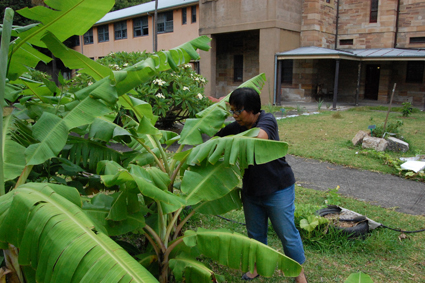
Betty harvesting some banana leaf, Tending
photo courtesy of the artists
Betty harvesting some banana leaf, Tending
process and products
There is a genuine warmth and unpretentiousness that characterises the project both in person (on site) and via the blog (online). Characters emerge in the unfolding narrative of Tending—characters that can just as easily be plants as people. The blog’s quaint attention to detail begins to feel like a slow meditative reality TV show, whose production team would be carrying around copies of Michel de Certeau’s The Practice of Everyday Life alongside their shovel. Some characters stay longer than others, such as Tending’s switched on VIP Betty whose knowledge has gone deep into that soil, but they all contribute to an interesting balance of contention and co-operation, order and unruliness that sits at the core of Tending as an artwork in process.
But Tending is not an artistic process without products. Indeed, gardens themselves provide ideal places to explore the dynamic between process and product. As Ihlein explains, “one would quickly tire of digging the soil if, season after season, there were no yields.” Some products Ihlein and Bonetto have seen emerging from the collective labours of Tending include: physical pleasure; a clear mind; some lettuces, cucumbers, pumpkins and lots of basil; knowledge about what to plant at different times of the year; new friendships; heated discussions about the definition of art; some small wages; a series of guest lectures; an open-air studio; an improvement in soil quality; a restful place on campus…
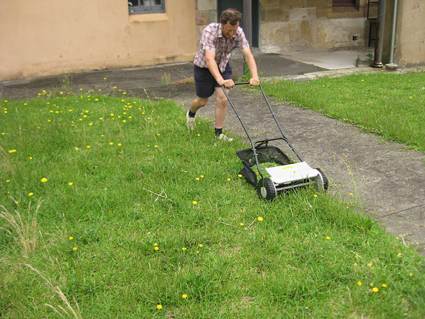
Grass, Tending
photo courtesy of the artists
Grass, Tending
tending the future
The future of Tending is uncertain. The artists are looking into ways of enabling the garden at SCA to continue indefinitely, mapping out a kind of “management hand-over” to students and staff at the college, which the artists have jokingly likened to the process of America pulling out of Iraq. There are also pending grant applications that could potentially see the project extend over to the main campus of Sydney University as part of a new Diabetes and Obesity research facility, whereby gardening-as-art will be put to practical use beyond its current context. In the process we might just see the estrangement that all too often exists between disciplines further collapse.
In his essay, The Emancipated Spectator, Jacques Rancière argues that emancipation is not so much about “activation” over a “passivity” that is perceived to be inherent in spectatorship, but rather about breaking down the very oppositions that inform this kind of hierarchical understanding of things. Rancière concedes that an emancipated community is in fact a community of storytellers and translators. In this sense Tending is producing a community of gardeners that bring worms to the surface of the soil and sprout edible fruits from seeds as much as they uncover over-looked histories, confront artistic norms and forge new relationships with people and place.
Lucas Ihlein and Diego Bonetto, Tending, Sydney College of the Arts, www.tending.net.au
This article was first published in our May 24 e-dition.
RealTime issue #103 June-July 2011 pg. 4
© Alana Hunt; for permission to reproduce apply to realtime@realtimearts.net
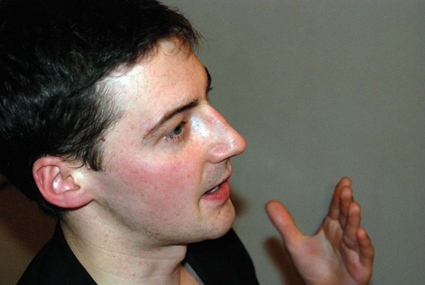
Matthew Lorenzon
photo courtesy of the author
Matthew Lorenzon
Bio
I was turned on to music at the age of 14 when I heard the Prelude to the first Bach cello suite on Neon Genesis Evangelion. I had moved from the Blue Mountains to suburban Adelaide when I was young and perhaps the cello made me remember something about the mountains. Two years later I played the piece to get into a special interest music school and started playing cello in bands, string quartets and orchestras, before starting a music degree at the Elder Conservatorium of Music. I quickly developed RSI and turned to studying musicology, English, philosophy and cultural studies at Adelaide University and Melbourne University, with a little stay at McGill University in Montreal. I am currently completing a PhD in musicology at ANU on the rapport of music and philosophy in the works of the philosopher Alain Badiou and the composer François Nicolas. Apart from writing I like to compose for theatre and art installations. I still like the mountains but don’t get to them very often.
Exposé
I write because I want to know how ideas are relevant to music and vice versa. Getting the right match is very difficult, but a discursive approach to a work, not just a performance or a composer, can be really enriching for listeners. To this end RealTime is Australia’s most important and proactive source of writing on contemporary music. You can make that extra discursive leap and don’t have to be afraid of it being edited out before the final print.
The Astra Chamber Music Society is another long-standing and praiseworthy institution, not least because I get to sing with them every week. Where else can you premiere a new Australian work one moment, then sing some obscure baroque requiem mass or early 20th century atonal number the next, alongside much better singers so you feel like you’re in the best karaoke bar ever? It’s Astra’s 60th birthday this year. Happy birthday Astra. I love you.
I am also developing a vested interest in disability access in the arts, having been quite immobilised by ankylosing spondylitis this past year. Perhaps mentioning my ank. spond. blog here (www.ismethotrexatekillingme.blogspot.com) will inspire me to post more on it.
We should keep on talking in the face of music. We will be shamed by the music, but that is necessary to learn to listen again.
Recent articles for RealTime
RT102 new music theatre in utero: carnegie 18, full tilt
RT102 new music: challenge as fun: mona foma, hobart
RT101 bringing chamber opera home: chamber made opera, living room opera
RT100 an unbelievable urge: the itch, chamber made opera
RT98 opera for ipad: helen gifford’s exile
Update 2013: Matthew also now runs the blog Partial Durations in association with RealTime: http://partialdurations.wordpress.com
RealTime issue #103 June-July 2011 pg. web
© Matthew Lorenzon; for permission to reproduce apply to realtime@realtimearts.net
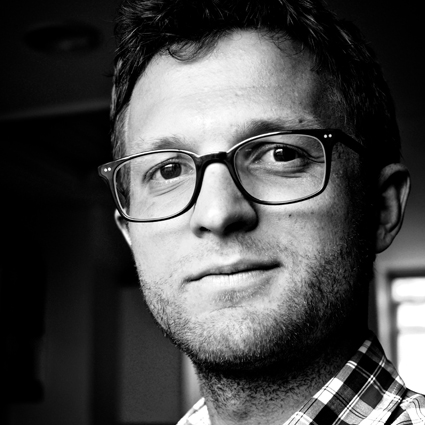
Carl Nilsson-Polias
photo courtesy of the author
Carl Nilsson-Polias
Bio
I grew up in Adelaide and Göteborg as a bilingual Greco-Swedish-Australian kid who wanted to play soccer for AC Milan. Then, a role in a French company’s production at the 1996 Adelaide Festival gave me a deludedly halcyon image of what it was to be involved in the arts. I hold Barrie Kosky personally responsible for curating this corruption of innocence. So, I went to the Victorian College of the Arts as an acting student and now I am an actor, an Artistic Associate with The Hayloft Project, a member of the Green Room panel for Independent Theatre and an out-of-form soccer player.
Exposé
I began writing on theatre, film, music and dance while studying at VCA. In a curriculum that focused entirely on kinaesthetic learning there was no outlet for the written word, very little space for intellectual discourse or the communication of ideas beyond the sheltering walls of the studio. In response, I founded a student blog, wangled review tickets from theatres, cinemas and festivals, encouraged my friends to join me and suddenly became an editor and critic. Today, my writing about the arts coexists with my own artistic practice—I see both fundamentally as means to communicate and interrogate.
Recent articles for RealTime
dance massive feature kinetics: sculpted & danced: connected, chunky move
dance massive feature turning the tables, working the audience: branch nebula, sweat
dance massive feature erupting from the archive: balletlab, amplification
RT99 from screenplay to stage: ivo van hove, director, cassavetes opening night
RT90 the mask speaks: hong kong arts festival: the wooster group, akram khan & juliette binoche
Other writing
see my blog www.carlnp.com.au
RealTime issue #103 June-July 2011 pg. web
© Carl Nilsson-Polias; for permission to reproduce apply to realtime@realtimearts.net
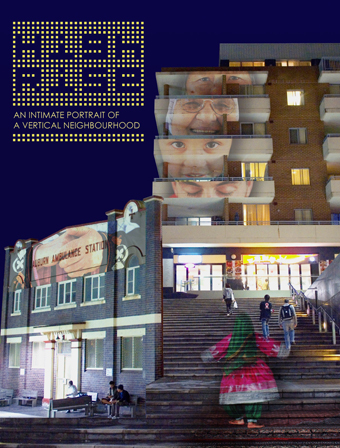
HighRise: An Intimate Portrait of a Vertical Neighbourhood
photo Joanne Saad, design ragingyoghurt.org
HighRise: An Intimate Portrait of a Vertical Neighbourhood
an intimate portrait of a vertical neighbourhood
In the wake of the MCA’s The Begin-Again in Hurstville (see RT103), comes the HighRise project in Auburn. Like The Begin-Again, HighRise is a large-scale public sound and video installation work that has been developed over several months through the collaboration of community residents and artists. The artists include award-winning photographer Joanne Saad, visual artist and producer Khaled Sabsabi (RT98, 2010 Helen Lempriere Travelling Arts Scholarship recipient) and producer Lina Kastoumis (previously at Urban Theatre Projects); the residents are from the Auburn Central high rise complex. The result is a work that includes nearly 100 individual videos, which will be projected in an open-air setting in the courtyard and on the buildings of Auburn Central. HighRise begins on Thursday May 26 and runs over three nights, with two 30-minute screenings per night. HighRise: An Intimate Portrait of a Vertical Neighbourhood, Auburn, May 26-28; find them on facebook
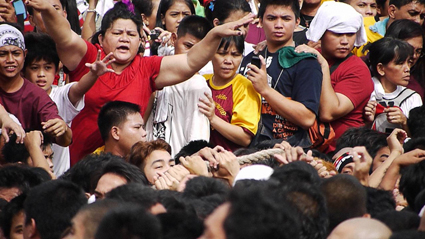
Within and Without
photo Datu Arellano
Within and Without
anino again
If you saw The Folding Wife (RT79), then you will already know the alchemy that happens when Deborah Pollard, Paschal Daantos Berry, Valerie Berry and Manila-based multi-media artists Anino Shadowplay Collective collaborate. This time they are working on a project called Within and Without, which is billed as “a contemporary performance and event that explores the city of Manila, through representation of its landscape, history and culture” (press release). Blurring the lines between theatre and visual arts, this project will take over both the gallery and performance spaces of Blacktown Arts Centre. Bookings essential. Deborah Pollard, Valerie Berry, Paschal Daantos Berry and Anino Shadowplay Collective, Within and Without, Blacktown Arts Centre, June 22-July 2, www.artscentre.blacktown.nsw.gov.au
tiny revolutions & deviations from the norm
In another exciting collaboration, Perth-based pvi collective (RT44, RT95, RT99) are working with Vitalstatistix in Port Adelaide at the Waterside Workers Hall for three weeks. On May 27, they host tiny revolutions, a show-and-tell where they discuss “the role intervention plays in their practice and their latest body of work as well as subtle (and not so subtle) strategies for mis-behaviour in public spaces and their philosophy of instigating tiny revolutions through art” (website). Then in mid-June, they present transumer: deviate from the norm, which was commissioned for the 17th Biennale of Sydney in 2010, and has been made in the ‘awaiting development’ landscape of Port Adelaide with a team of local artists. The show is billed as “darkly playful site-based intervention, inviting audiences to undertake tiny acts of resistance against their built environment” (website). pvi collective at vitalstatistix, tiny revolutions, May 27; transumer: deviate from the norm, June 10-12, Port Adelaide; www.vitalstatistixtheatrecompany.blogspot.com
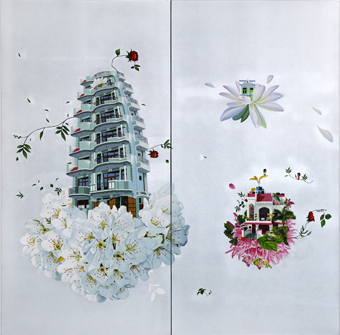
Thukral and Tagra, Dominus Aerius elegance – 6, 2008, acrylic and oil on canvas
image courtesy the artists and Gallery Barry Keldoulis, Sydney
Thukral and Tagra, Dominus Aerius elegance – 6, 2008, acrylic and oil on canvas
cosmo-popular cultures
La Trobe University Museum of Art (LUMA) is showcasing selected works by leading artists from Australia, India and the Philippines in the exhibition Vernacular Cultures and Contemporary Art. The exhibition features “contemporary artists whose work incorporates expressions of indigenous and/or locally specific popular cultures” and examines such themes as “surf culture, karaoke, religious iconography, street advertising and popular architecture” (press release). The artists include Raqs Media Collective (RT43), Thukral and Tagra, Fiona Foley (RT94, RT94), Scott Redford (RT55), Sangeeta Sandrasegar (RT77), Maria Cruz, Mark Salvatus, TV Moore (RT57), Hoang Tran Nguyen, and Ken Botnick and Diana Guerrero-Maciá. The exhibition program also features a public lecture by the renowned Indian artist Pushpamala N (RT65) on June 9 and a performance by the Australian art rock band The Histrionics on June 10. Vernacular Cultures and Contemporary Art from Australia, India and the Philippines, curator Ryan Johnston, LUMA La Trobe University Museum of Art, May 5-June 15, www.latrobe.edu.au/luma
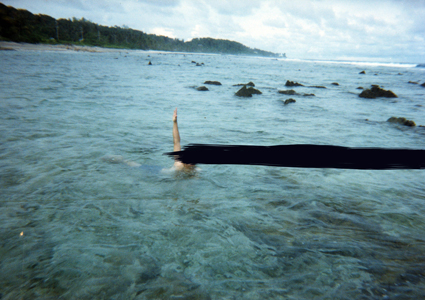
Carl Warner and Ross Gibson
protection (2011, detail)
c-type photographs and blackboard paint
image courtesy of the artists and UQ Art Museum, source material courtesy of Fryer Library, the University of Queensland
Carl Warner and Ross Gibson
protection (2011, detail)
c-type photographs and blackboard paint
art and refuge
The University of Queensland Art Museum is hosting three related exhibitions from June 11 to August 7. The first is Waiting for Asylum: Figures From an Archive. Working with the Fryer library archive of refugee ephemera, collaborating artists Ross Gibson (RT54, RT91), and Carl Warner interpret the precarious position of the asylum seeker past and present. The second is Collaborative Witness: Artists Responding to the Plight of the Refugee, in which artists “challenge one-dimensional portrayals and become not only witnesses, but also collaborators on the complex story of those seeking asylum” (press release). The show includes works by Benjamin Armstrong, Lyndell Brown and Charles Green, Jon Cattapan, Tim Johnson and Karma Phuntsok, Rosemary Laing (RT58, RT85, David Ray, Judy Watson (RT69) , and Guan Wei (RT81). The third show is John Young: Safety Zone, which responds to the hidden history of the ‘Rape of Nanjing’, when a group of 21 foreigners saved the lives of 300,000 Chinese by sheltering them in the city’s international ‘safety zone.’ Caroline Wake, author of our Archive Highlight Art & Asylum: Politics, Ethics, Aesthetics, will be reviewing the shows in RealTime 104. Waiting for Asylum: Figures From an Archive, curators Prue Ahrens and Michele Helmrich, project researcher Gillian Whitlock; Collaborative Witness: Artists Responding to the Plight of the Refugee, curators Prue Ahrens and Michele Helmrich, John Young: Safety Zone, University of Queensland Art Museum, June 11-Aug 7; www.artmuseum.uq.edu.au

Joe Lawlor from Desperate Optimists on the set of Tiong Bahru in Singapore 2010
photo courtesy of the artists
Joe Lawlor from Desperate Optimists on the set of Tiong Bahru in Singapore 2010
desperate optimists: community on screen
The Dublin-born, UK-based performers and filmmakers Desperate Optimists are visiting Australia to screen Tiong Bahru, the unique outcome of their engagement with a Singaporean community. Made by Joe Lawlor and Christine Molloy and co-produced by Singapore-based Dan Prichard, it’s part of an innovative series titled Civic Life. It screened at Rotterdam and Dublin film festivals earlier this year, at the Festival of Ideas in Bristol and IndieLisboa in May. There’s an interview with the makers in Sight and Sound. The Civic Life blog includes a trailer for Tiong Bahru, photographs and another interview. The wide screen cinematography, seamless continuity and the cumulative evocation of social life around a small district are seductive, focusing on small pleasures and low-key dramas. Community members perform with ease and conviction. Desperate Optimists’ extensive Australian program includes screenings, talks and workshops at ACMI, Footscray Community Arts Centre; Metro Screen, AFTRS, Performance Space and ICE, and as part of the Sydney Film Festival at the Art Gallery of NSW. See the websites of the above organisations for dates
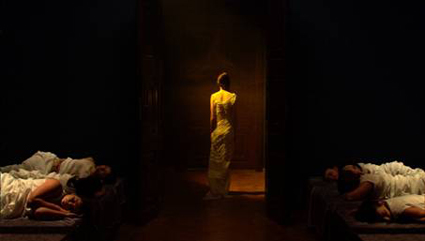
Penelopa
the patience of penelope
The award-winning writer-director Ben Ferris’s art film Penelopa is finally being released, screening at the Art Gallery of NSW and the Nicholson Museum, University of Sydney. Penelopa is the first Australian-Croatian co-production and is adapted from Homer’s tale of Penelope, depicting her psychological struggle as she waits 20 years for her husband to return from the Trojan War. The film “draws on the long-take filmmaking style of art film directors such as Andrei Tarkovsky (The Mirror), Akira Kurosawa (Seven Samurai) and Bela Tarr (The Man from London)” (press release). Penelopa, Nicholson Museum, University of Sydney, June 15, Art Gallery of NSW, June 25; www.penelopa.com.au
RealTime issue #102 April-May 2011 pg. web
© RealTime ; for permission to reproduce apply to realtime@realtimearts.net
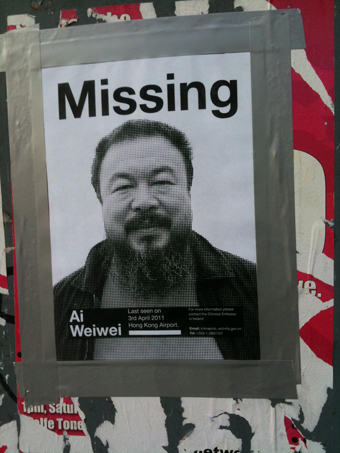
Ai Weiwei missing poster
photo stunned
Ai Weiwei missing poster
“IF IT CARRIES ON LIKE THIS IT WILL BECOME LIKE THE CULTURAL REVOLUTION.” THAT WAS THE ASSESSMENT EXPRESSED TO ME RECENTLY BY A WELL-KNOWN CHINESE CREATIVE FIGURE REGARDING THE CURRENT SITUATION IN THE PEOPLE’S REPUBLIC. IF THAT SOUNDS LIKE HYPERBOLE, THE FACT THAT THESE WORDS ARE BEING UTTERED BY SOMEONE OLD ENOUGH TO REMEMBER WHAT THE MAOIST ERA WAS ACTUALLY LIKE IS INDICATIVE OF THE PREVAILING MOOD AMONGST THE NATION’S ACTIVIST AND CREATIVE COMMUNITIES.
On Sunday April 3 China’s best known contemporary artist Ai Weiwei was taken from Beijing airport as he attempted to board a flight for Hong Kong. He has not been heard from since. Ai, who is also a prolific filmmaker, architect and designer, has long been an outspoken critic of the Chinese government. His domestic and international profile, however, led many to believe he was unlikely to suffer the harsh treatment dealt out to many lesser-known opponents of the regime. In the words of The Guardian’s Jonathan Jones on April 4, his arrest is being interpreted as an attempt to “stamp out the idea that any individual is greater than the law of the state.”
The “law of the state” in this case—as in many others—is proving very flexible, since Ai Weiwei has not been formally charged and none of his friends or family, including his wife and mother, is aware of his current whereabouts. Various other members of Ai’s circle have also been arbitrarily detained for varying periods, and his associates Wen Tao, Zhang Jinsong, Hu Mingfen and Liu Zhenggang are all still missing at the time of writing.
Unfortunately Ai Weiwei’s case is just the tip of the iceberg. After anonymous calls for a Chinese “Jasmine Revolution” emulating recent uprisings in North Africa and the Middle East circulated online in mid-February, the Chinese authorities moved swiftly to neutralise the perceived threat. Initially political activists were targeted, including lawyers and well-known bloggers. In March, they also began exerting pressure on parts of China’s creative community.
The China Human Rights Defender website claims, “The Chinese government has criminally detained a total of 39 individuals since mid-February.” Seventeen of these are still in detention, nine have been charged and are awaiting trial and three have already been sent to camps for “re-education through labour.” The claims are supported by a map detailing the names and locations of those detained (see chrdnet.org). Earlier this month the same organisation reported around 200 others have been placed under other various forms of “soft detention”—in other words, house arrest.
In addition, an unknown number of people across China have been subject to a ramping up of intrusive surveillance, harassment and interference in their daily lives. On March 18 for example, I visited the academic and documentary filmmaker Ai Xiaoming (no relation to Ai Weiwei) at Sun Yat-Sen University in Guangzhou. Ai has made numerous low budget documentaries focusing on controversial issues such as the spread of AIDS in rural China through unregulated blood collections.
After a translator and I met Ai on campus, we headed to her nearby apartment. As we approached her residential block around five minutes later we were intercepted by a man—presumably a plain-clothed security officer—who addressed Ai Xiaoming by name and asked what we were doing. Our questioner was joined a few moments later by another man and a woman, while two other men stood watching a few metres away. None of the group was uniformed or offered any form of identification. The first man informed Ai Xiaoming that we needed to accompany him to the campus security office (Bao wei chu), while the woman asked my translator and I our names, occupations and places of origin.
Ai Xiaoming agreed to accompany the ‘officers’ if they let my translator and I go. As my companion and I made a hurried exit we were followed by other plain-clothed personnel into the subway station next to the campus.
Ai Xiaoming later contacted me and stated she suspects her phone is tapped and her email account has been hacked. Our experience shows her apartment is certainly under surveillance, although she says she was unaware of this until the incident on March 18.
Although certain filmmakers and artists have long been under surveillance and subject to phone taps, since the 1980s it has been rare for Chinese authorities to physically prevent artists meeting with foreigners. It is a disturbing development that the kinds of restrictions that more radical political activists have long endured are now being extended to established creative figures.
In more bad news for China’s film community, on April 18 organisers announced the cancellation of the Eighth Documentary Film Festival China, an event staged annually since 2004 in the far-flung Beijing suburb of Tongzhou. The festival is one of a handful of regular events in China showcasing films made outside the country’s state-controlled approval system. The 2011 edition had been planned for the first week of May. Artistic Director Zhu Rikun was quoted in the English-language edition of Chinese newspaper The Global Times as saying, “We cancelled it ourselves. The overall situation was tense, and we had received a lot of pressure.” The report did not elaborate on the nature of the pressure or its source.
In the current environment, Chinese-born foreign nationals have found that holding a foreign passport does not necessarily protect them, as the Australian novelist and blogger Yang Hengjun discovered when he disappeared in the city of Guangzhou on March 27. He resurfaced the following weekend and was allowed to return to Australia via Hong Kong, but he declined to elaborate on his experience, telling The Age, “I can’t keep having media attention and continue my pursuit of democracy in China…The more questions I answer outside China, then the less I can do inside.”
It remains to be seen whether the present crackdown represents a longer-term hardening in the government’s attitude or simply a panicked, typically heavy-handed response to events overseas. Either way, it’s a sobering reminder of the immense arbitrary power wielded by China’s ruling party and how quickly cultural liberalisation can be wound back when the state feels threatened. Even if all the detained figures are released tomorrow, the atmosphere of fear will linger, intensifying the already pervasive self-censorship that exists in China’s media and cultural spheres. This is, of course, precisely the intention. The message from the authorities is clear—the right to creative expression in China is on always on notice.
RealTime issue #102 April-May 2011 pg. web
© Dan Edwards; for permission to reproduce apply to realtime@realtimearts.net
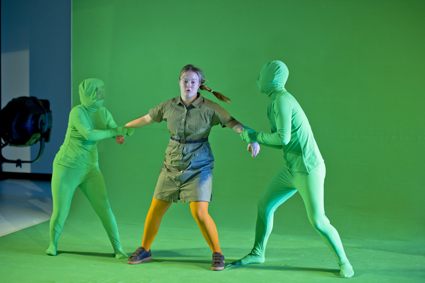
Katherine Evans (centre), Jianna Georgiou and Ciaran Woods, Take Me There
photo Chris Herzfeld
Katherine Evans (centre), Jianna Georgiou and Ciaran Woods, Take Me There
I AM NOT YOUNG ENOUGH TO HAVE GROWN UP WITH MY MEMORIES PLAYING BACK ON HOME VIDEO. WHILE OTHER FAMILIES IN THE SUBURBAN 1970s HAD SUPER 8, MY FAMILY HAD SLIDE SHOWS ON A BED SHEET AND PHOTOGRAPHS STUCK IN ALBUMS. MY MEMORIES OF OTHER TIMES AND PLACES ARE ORDERED, THEREFORE, BY THE SHOOT-AND-SNAP OF PHOTOGRAPHY, NOT BY THE ZOOM-AND-FLOW OF HANDHELD VIDEO. I SEE THE IMAGE BUT I DON’T REMEMBER. OR IF I DO, THEN I CAN ONLY RECALL THE FREEZE-FRAME OF THE SINGLE SHOT.
In Take Me There from Restless Dance, performer Alice Kearvell recounts her birthday memories. She begins remarkably with birthday number one: “lots of cuddles with my family and had a BBQ and dessert and I got shy.” By her second: “I was screaming and my brother put his hands over his ears. And I remember my sister was there and we had party food and dessert.” And for her third: “I think we went out for tea, no lunch, that’s right, at the cafe. And I remember had party food and dessert.”
Alice mediates these memories on stage from a green expanse of chroma-key, while live video of her performing is composited with home videos of her birthday celebrations. The resulting memory-flow is streamed to seven screens strapped-up around the stage. Other performers enter singing “Happy Birthday” and carrying gas-filled party balloons. But this is not a re-enactment. It is more a tribute to the displacements of home video, flowing into memory formations of the self elsewhere—at other times, in other places.
Beside the green expanse and video screens, the 12 performers in this work occupy a space—designed by Gaelle Mellis—which is as empty as a waiting room with its row of plastic chairs and a single potted plant. Where else do they want to go?
Dana hangs out with some friends in an abandoned house. Matt wants to be anywhere, stretched out and relaxed, lying on the grass. But Jennie can’t get anywhere, wherever that may be. Kathryn wants to go downtown to the rough-and-tumble of the inner city. Lorcan wants to go to Ireland. Courts goes swimming in the pool and Dana remembers snow falling in Romania.
The video magic of chroma-key makes these escapes of memory and imagination possible on stage and screens—or so it seems. When Lorcan flies to Ireland, he takes his seat in the aeroplane as the ensemble joins him from the side. Together they dance the gestures of the flight attendants’ safety routine. Once in Ireland, Lorcan—Leprechaun-like—makes another performer disappear from the screen by draping her in green.
When Kathryn goes downtown, she is moved and bumped around by two performers dressed in green. Against a backdrop of city lights and traffic, she jumps and twists and screams unheard. On the screens, of course, her manipulators have disappeared; she is tossed and turned by the unseen forces of the city.
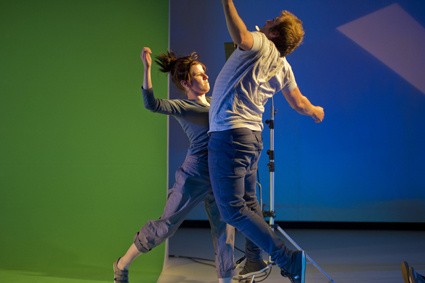
Courts White and Jesse Rochow, Take Me There
photo Chris Herzfeld
Courts White and Jesse Rochow, Take Me There
The work itself bears the traces of its making. Director Daniel Koerner asks the audience in the program—as he may have asked the performers in rehearsal—“If you had the chance to go anywhere, do anything, where would you go? What would you do there?” Technological conceits of appearance and actuality are exposed in the performance with humour, tracing the cruelty of those liberal injunctions to “be who you want to be” and “go where you want to go.”
Aspirations to overcome the constraints of time, place and physical capacity are mediated by memories and technologies. But the gap between individual aspirations and the uniformity of ensemble behaviour is not so thoroughly explored. Individual imperatives to “take me there” are met with collective actions in response that set limits and refusals. The performance only tolerates one aspirant at a time, who must return to the ensemble if they are to grant freedom to another.
There is even something slightly petulant about the work’s imperative. “Take me there” sounds like an unruly child speaking to a reluctant parent, or a traveller of privilege issuing instruction to a driver—as if the speaker is incapable of getting there without the generosity of our contribution.
Between the individual and the ensemble there is also scope for mid-scale interactions less explored in this work. In choreographies of twos and threes and fours, performers say to us and others, not “take me there,” but “we’re getting out of here!”
Come Out Festival, Restless Dance Theatre, Take Me There, director Daniel Koerner, assistant director Philip Channells, designer Gaelle Mellis, lighting designer David Gadsen, composer Ian Moorhead, Adelaide Festival Centre, March 25-April 2; www.restlessdance.org
This article was first published as part of the May 10 e-dition.
See also RealTime’s Archive Highlight on Arts & Disability, with an introduction by Anna Hickey-Moody
RealTime issue #103 June-July 2011 pg. 38
© Jonathan Bollen; for permission to reproduce apply to realtime@realtimearts.net
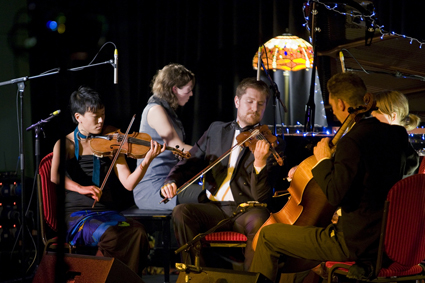
Sunwrae String Quartet
photo courtesy of the artists
Sunwrae String Quartet
new music to your ears
There’s a busy two months ahead for new music lovers. First, Mike Majkowski (Earbash and RT97) and Decibel (RT94, RT97) join forces for concerts in Canberra and Sydney. Decibel will also be performing at PICA in the second of three concerts there with new works by ensemble members Lindsay Vickery and Cat Hope as well as by Chris de Groot, Thomas Meadowcroft and John Cage as well as an arrangement of Scott Walker’s Benito’s Dream (you can hear some of Decibel’s work in our Sound Capsule and keep an eye out for Chris Reid’s review of their CD in our next e-dition). The Sunwrae String Quartet is also on tour (and will be reviewed in RT103), with concerts in each capital city, a guest appearance at the Camden Heaven Music Festival in Port Macquarie and a trip to Vietnam. Finally, Canberra is again hosting its adventurous International Music Festival (see our 2010 review). Decibel and Mike Majkowski, Canberra, May 14, www.thestreet.org.au and Sydney, May 15, www.cityrecitalhall.com; Decibel, Concert 2, PICA, June 20, www.decibel.waapamusic.com; Sunwrae String Quartet, Eavesdropping Tour, May 5-June 9, www.sunwrae.com; Canberra International Music Festival, May 11-22, www.cimf.org.au
music theatre at home
Chambermade Opera continues its series of intensely intimate operas (The Itch, Another Lament and Target, with Dwelling Structure, subtitled “An Opera in 8 Time Use Episodes.” Citing poet Emily Dickinson, CMO suggests “you will dwell in possibility, a doorless house??,” in what promises to be a highly unusual work created by sound artists Madeleine Flynn and Tim Humphrey with writer Cynthia Troup and “visual assemblage by Neil Thomas, and neighbourly interruptions by The Suitcase Royale.” Chambermade Opera, Dwelling Structure, May 26-28, www.chambermadeopera.com
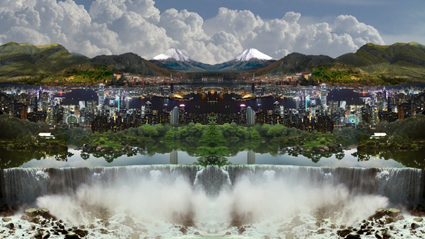
Kit Wise, Xanadu 2009, HD video installation, silent 6:00, mirrored glass, Digital production Darin Bendall, an Experimenta Commission
image courtesy of the artist
Kit Wise, Xanadu 2009, HD video installation, silent 6:00, mirrored glass, Digital production Darin Bendall, an Experimenta Commission
old new media
From new music to new media…if you missed it in Melbourne last year, you can catch Experimenta: Utopia Now on tour at the Mornington Peninsula Regional Gallery. The show features the work of Patrick Bernatchez (Canada), Michael Burton (UK), Cao Fei (China), Christopher Fulham (Australia), Christian Jankowski (Germany), Laurent Mignonneau & Christa Sommerer (France/Austria), Scenocosme (France), Kit Wise (Australia) and dynamic Melbourne duo, Van Sowerwine & Isobel Knowles, all of whom investigate the double meaning of utopia as the “good place” and/or “no place.” In her RealTime review last year, Saige Walton said the “selected works ranged from joyous and humourous to desolate and unnerving” (RT96). There’s more media art to be seen at the Brisbane’s Gallery of Modern Art. Drawing from its collection, the gallery’s latest exhibition, Physical Video, explores the use of the body in video art, featuring work from the early 1970s through to the present day. Artists include Bruce Nauman (US), Jun Nguyen-Hatsushiba (Japan/US/Vietnam, RT46, RT50), Dennis Oppenheim (US), James Oram (New Zealand) and Mike Parr (Australia, RT102) among others. Experimenta: Utopia Now, Mornington Peninsula Regional Gallery, May 12-June 19; www.experimenta.org; Physical Video, GoMA, Brisbane, May 14-Sept 4 2011; www.qag.qld.gov.au
the winner: douglas sirk box set
Our thanks to all the entrants in our competition who informed us how the Madman Douglas Sirk box set would improve their lives. The winner was Melbourne choreographer Phillip Adams, who wrote:
“For those of you who know me, I am strictly a 50s man. From Featherston chairs to Palm Springs chic and my car—a 1959 Merc. The delights and the details in the designs of Sirk’s films in the box set would keep me enthralled hour after hour. The inspiration from the set decorations alone would be like a home magazine filled with retro gems: styles, suits, gloves, backdrops, kitsch all rolled into one. Well, I might even go as far as having Written on Wind playing nonstop as my bedhead artwork. Sirk is a man after my own heart.”
The 9-DVD box set of the great films of the 1950s master of aesthetically and socially incisive Hollywood melodramas, Douglas Sirk, was generously provided by Madman Entertainment.
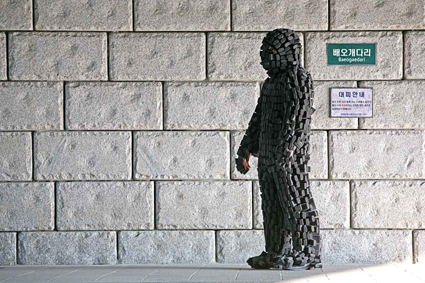
Ash Keating, Label Land (2009), Human Rights Arts and Film Festival
photo courtesy of the artist
Ash Keating, Label Land (2009), Human Rights Arts and Film Festival
the politics and poetics of human rights
It’s 50 years since the United Nations Refugee Convention was established, which makes the Human Rights Arts and Film Festival particularly relevant this year. The festival starts in Melbourne with a program that includes film, visual art, poetry, theatre and public forums. The films will be shown at ACMI in a week-long program of documentaries, animations and shorts. The Asylum Seeker Resource Centre is presenting Not Only My Story, a play in which refugees collaborate with artists such as Yumi Umiumare (RT39, RT71, RT94). There is also artwork by Ash Keating (RT77, RT86, RT91). Smaller versions of the film program will tour Canberra, Alice Springs, Brisbane, Sydney, Byron Bay, Adelaide and Perth. Human Rights Arts and Film Festival, Melbourne May 12-22, national tour May 26-June 12, www.hraff.org.au
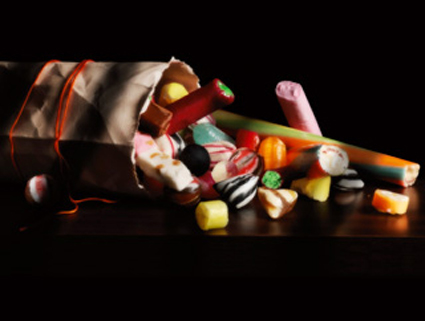
Robyn Stacey, Tall Tales and True, Stills Gallery
photo courtesy of the artist
Robyn Stacey, Tall Tales and True, Stills Gallery
head out to head on
Head On Photography Festival is now in its second year. There are over 130 indoor and outdoor exhibitions, events, seminars and workshops across Sydney over seven days. Of particular interest is Robyn Stacey’s show Tall Tails and True at Stills Gallery, Paddington, as well as the group exhibition at Roslyn Oxley9 featuring Destiny Deacon (RT66), Bill Henson, Tracey Moffatt (RT102), Julie Rrap, Patricia Piccinini (RT43), TV Moore (RT57), Isaac Julien (RT42, RT97) and Anne Zahalka. There are also two interesting tours on offer: one to a camera obscura in Centennial Park and another of the Powerhouse Museum’s basement, which houses a considerable collection of 19th century cameras and photographs. Head On Photo Festival, May 5-June 11, www.headon.com.au
RealTime issue #102 April-May 2011 pg.
© RealTime ; for permission to reproduce apply to realtime@realtimearts.net









![[Xuan] Spring, Ngoc Nguyen](https://www.realtime.org.au/wp-content/uploads/art/48/4854_priest_spring.gif)









































































































































![Nicola Leahey, Jessica Jefferies, [sic], Dancenorth](https://www.realtime.org.au/wp-content/uploads/art/46/4690_ashley_dancenorth_sic.jpg)
























































